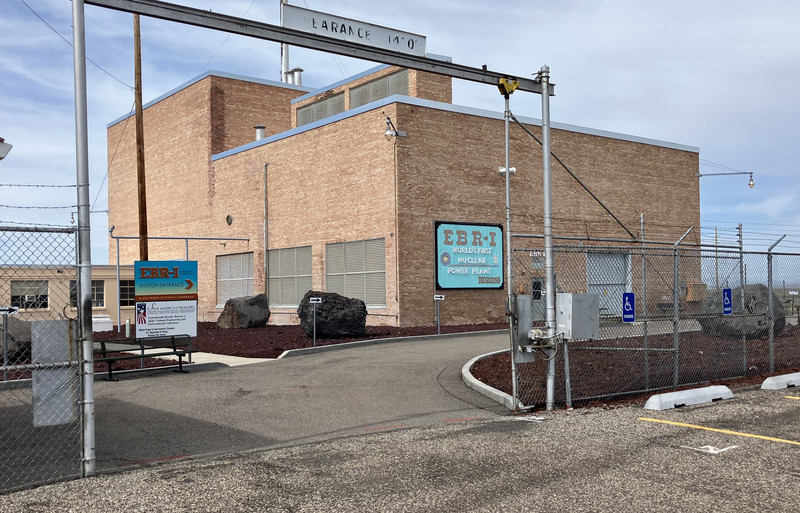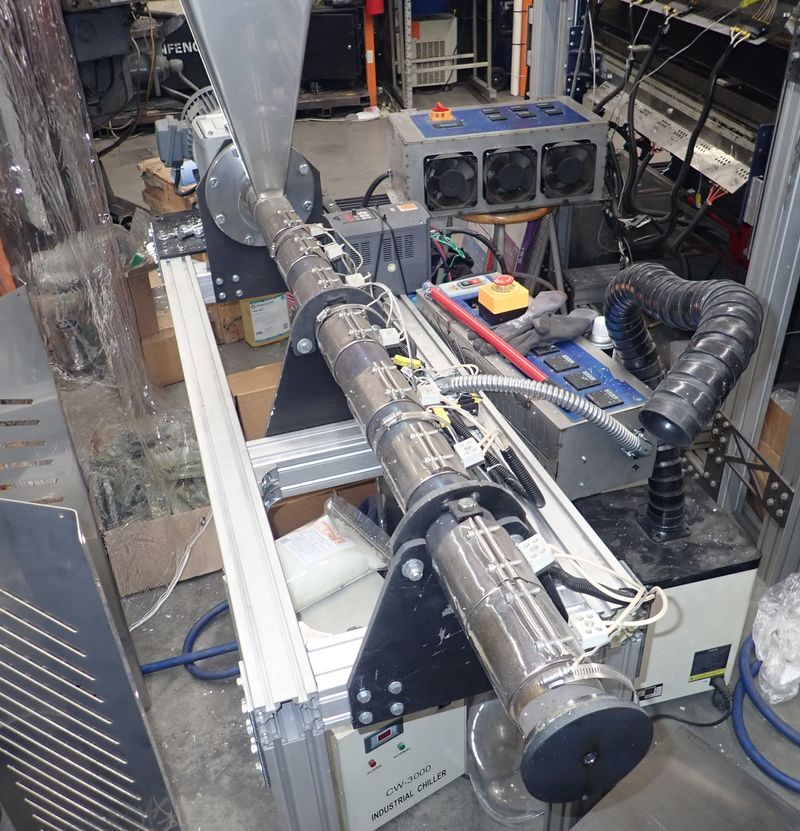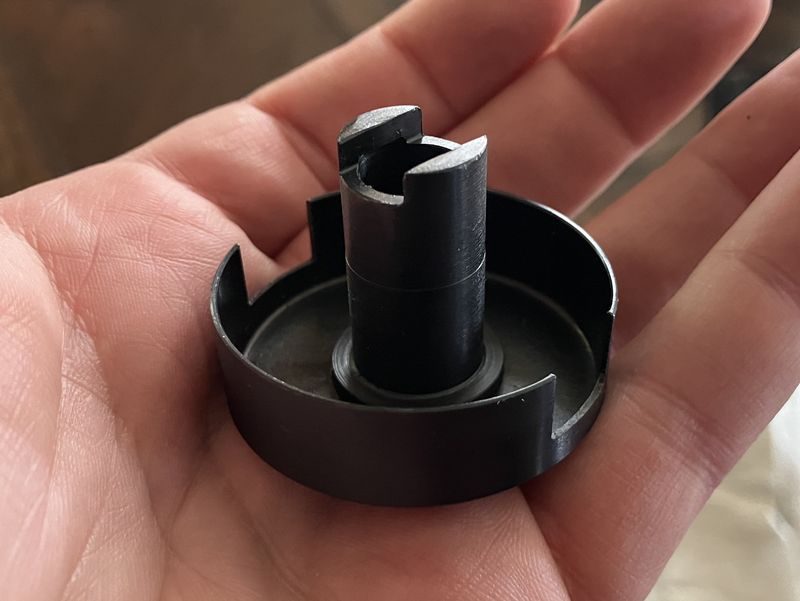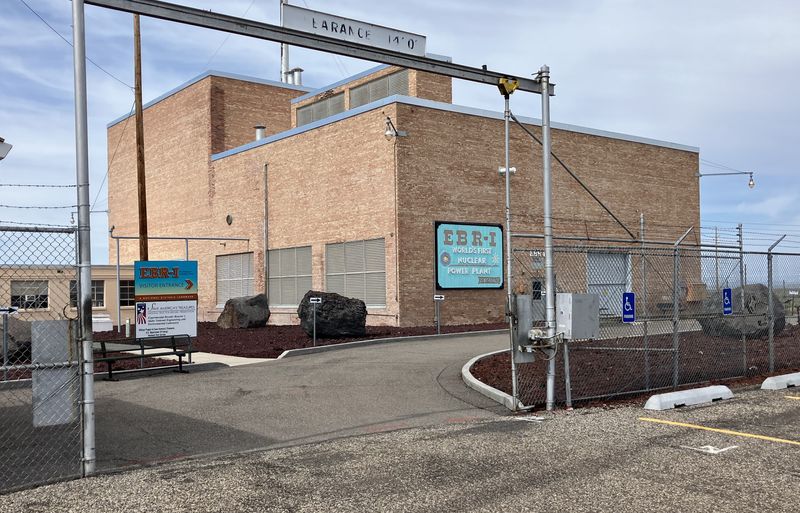On Friday, I had a free day, and my preferred airplane was free, so I flew out to Idaho Falls, rented a car, and spend an amazing few hours at the EBR-I museum over in Idaho National Labs. The weather was… windy, and so I also had a particularly interesting flight back.
This post is rather long and may indicate a weird geeky obsession with 1950s nuclear technology, among other things. I would normally make this a series of posts, but for reasons I’ll cover at the end, I’m not, and I apologize for nothing!
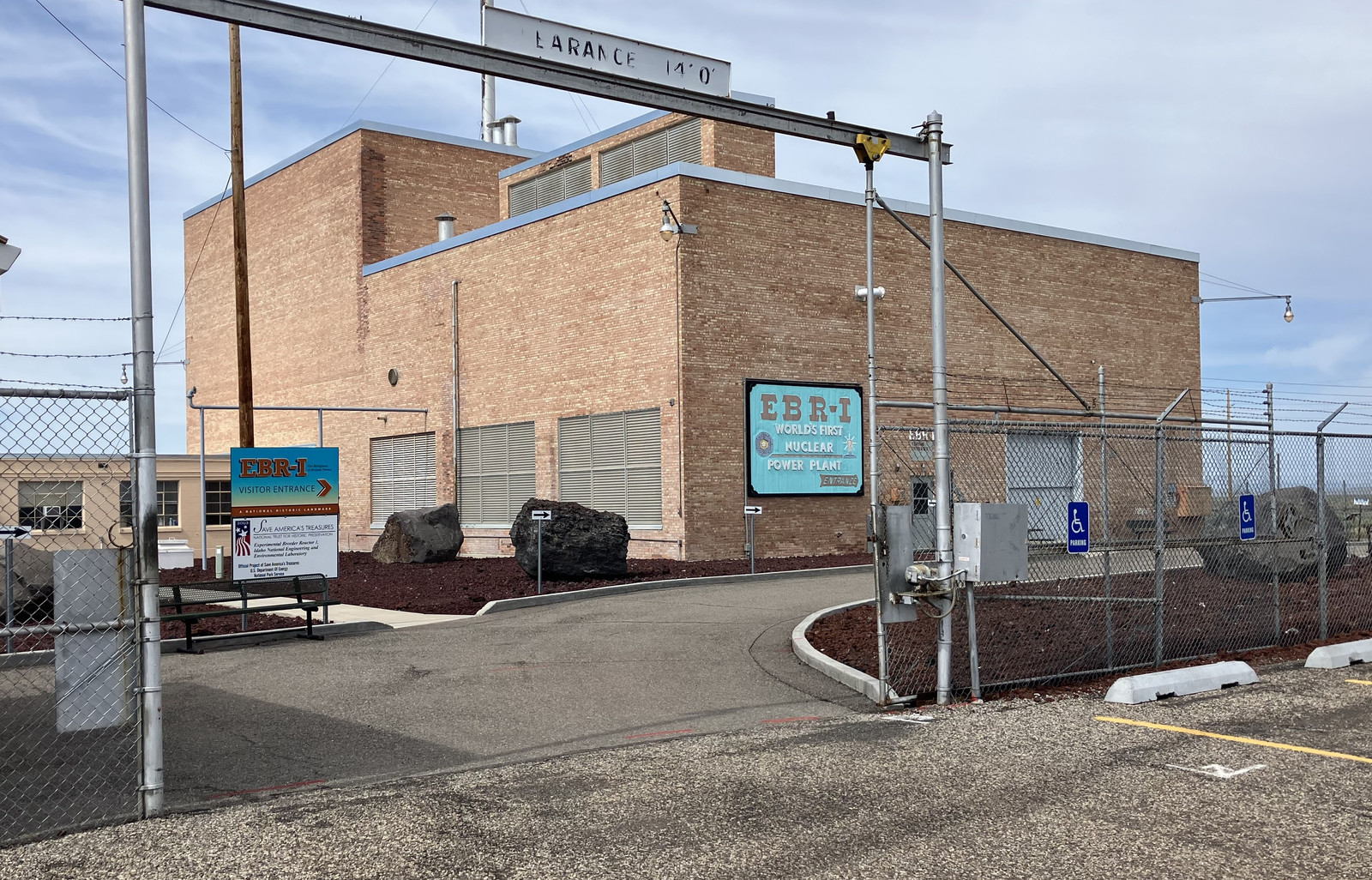
Flying Out
In Idaho, in the summer, the best time to fly is the morning. The winds tend calmer, and the ground hasn’t heated up enough to create heavy thermals. The glider folks may disagree, but I’m a big fan of “just after sunrise” sort of flights. I reserved 93F for the day, filled the tanks (I love the 180HP conversion, it climbs great and cruises well, but it does mean you should be on the ground after about three hours to get fuel). I’ve been loving 93F lately - in addition to the nice GPS and comm panel upgrades, an autopilot showed up some while ago, and I have thoughts on automation later! But, suffice it to say, I do very much like an autopilot for long distance cruising.
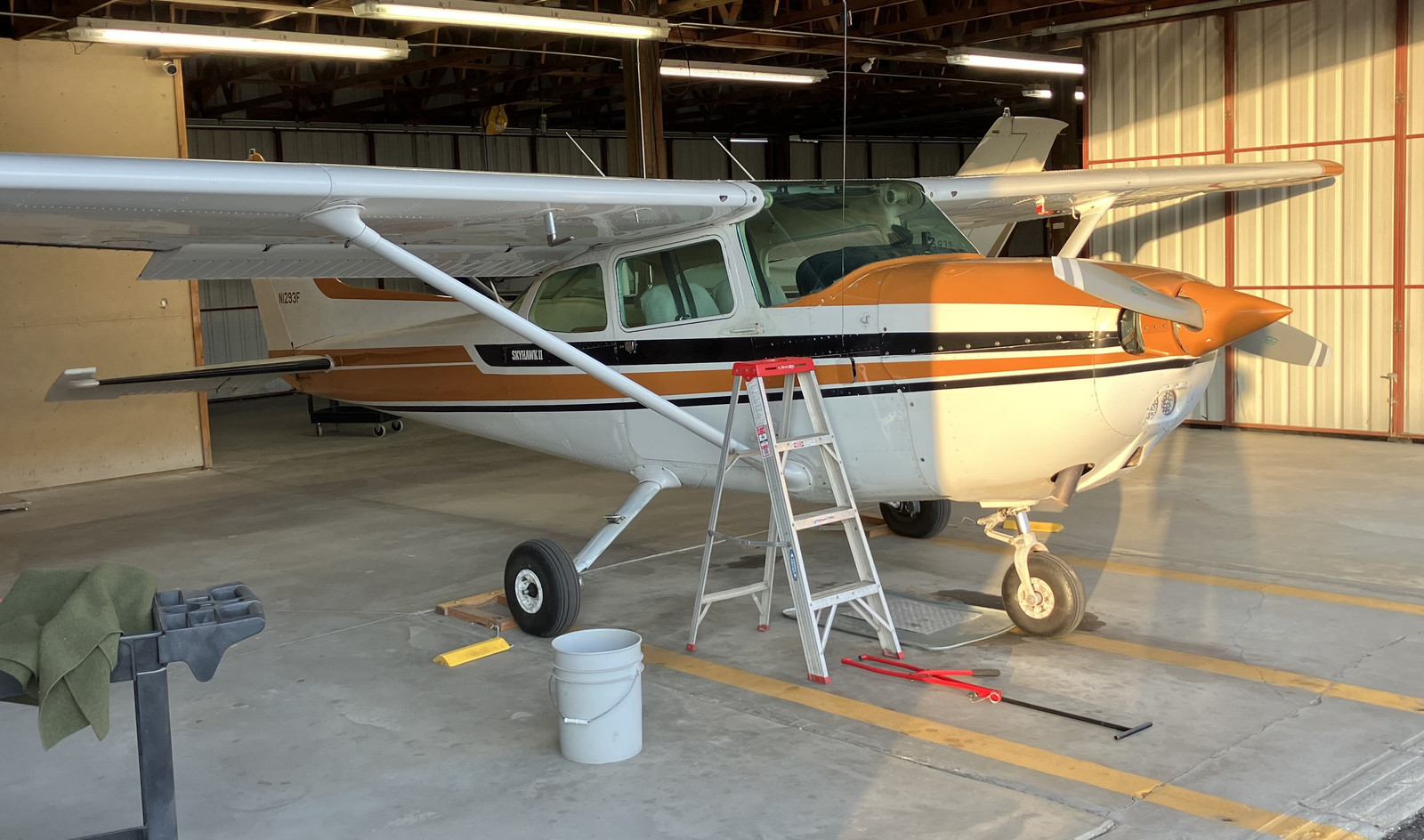
Airports happen to be great places to see airplanes, and even weird things in which the wings are going faster than the fuselage. N86KT is a, in my opinion, very good looking Sikorsky UH-60L. I expect it’s getting ready for fire season - the heavy lift helicopters get good use when forests get lit on fire.
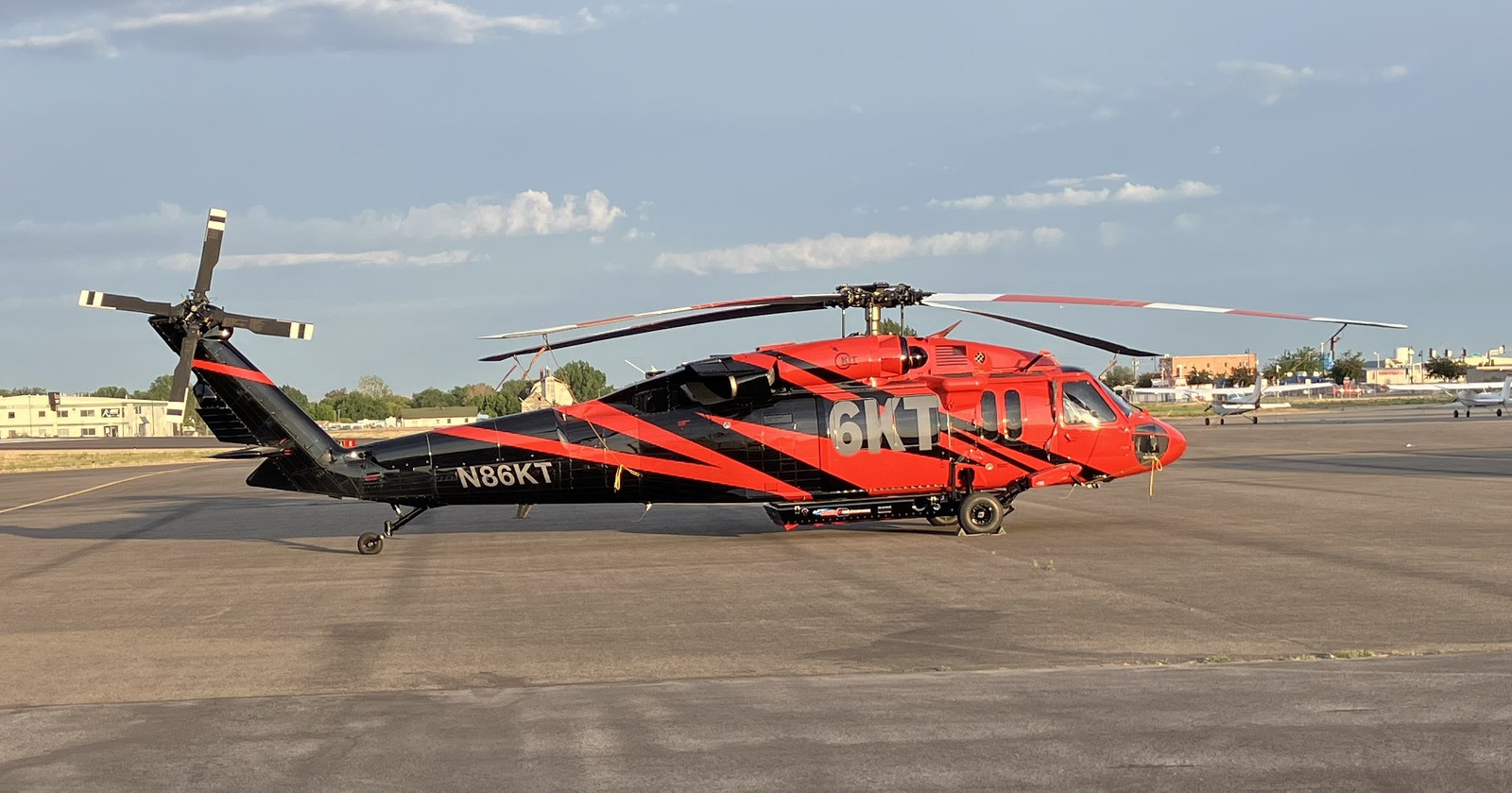
Take off into the wind, head east, and cruise. The straight line path between Nampa and Idaho Falls goes over more mountains than I prefer to fly over with a single engine, so I detoured a bit to the south and cruised along the edge of the foothills. There are plenty of good landing spots if you stay over the flats, and given the winds today, it wouldn’t be much of a ground roll, either.

I don’t mind views like this off my wing. I’d just rather not have to figure out how to put an airplane down, ideally in one piece, in that sort of terrain. There are simply no good answers - so, without adding many miles to the flight, it’s worth detouring over having to make that sort of decision if something goes wrong. That said, the T-Craft fleet is remarkably well behaved as far as the engines go - the planes are flown regularly, which is the single best thing you can do to an engine. We’ve also added good block and cylinder heaters to the planes with a remote app to turn them on. I’m not generally a fan of “smart plugs,” but this is a perfect use case. I can turn on an engine heater remotely at 3AM (or schedule it, if I feel like it), and by 6AM, the engine is warm enough that the oil temperature is in the green on startup! This matters more in the winter, but given how hard cold starts on are engines, and how mind-bogglingly expensive aircraft engine rebuilds are, it’s a good idea year round.

I’ve not flown over Craters of the Moon before. It’s an incredibly hostile lavascape in eastern Idaho, and it lives up to its name. You’re going along, and all of a sudden the ground turns into a lava spread. However, my understanding is that the basalt does some very good things to soil fertility, so you see farms right up to the edge of it!
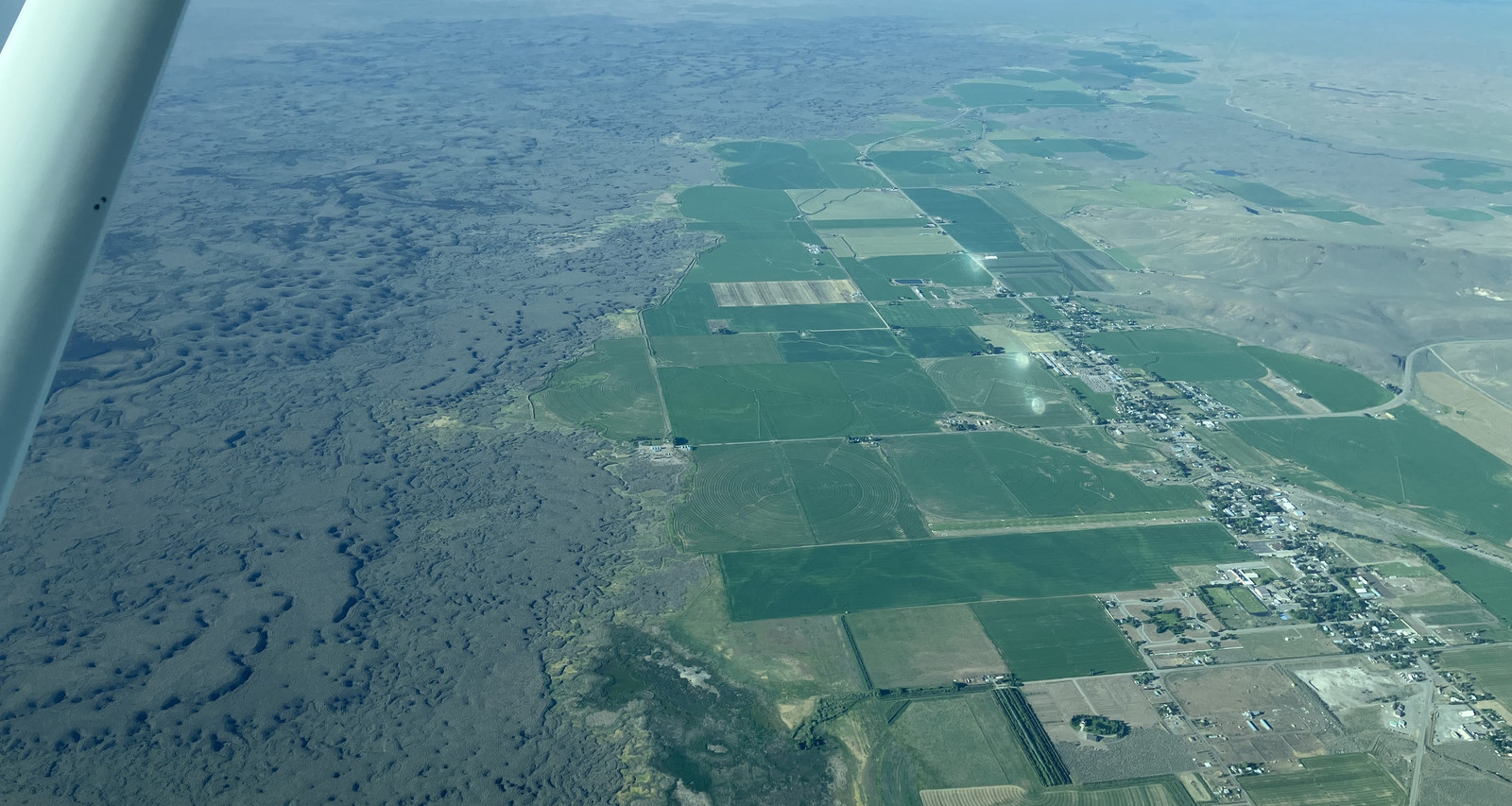
If you didn’t see the Cessna-bits in the photo, this could be something out of Kerbal Space Program. Cracked, torn lava fields, and Jeb contemplating the shattered remains of his lander that wasn’t quite right…

Did I mention the tailwind? Descending into Idaho falls, I set what I believe is my new ground speed record - 161kt (or 185mph) for “vehicles I am in control of.” This is a good 30mph faster than I’ve been on a motorcycle! Of course, a tailwind one way is a headwind the other way… but I’ll get there later.
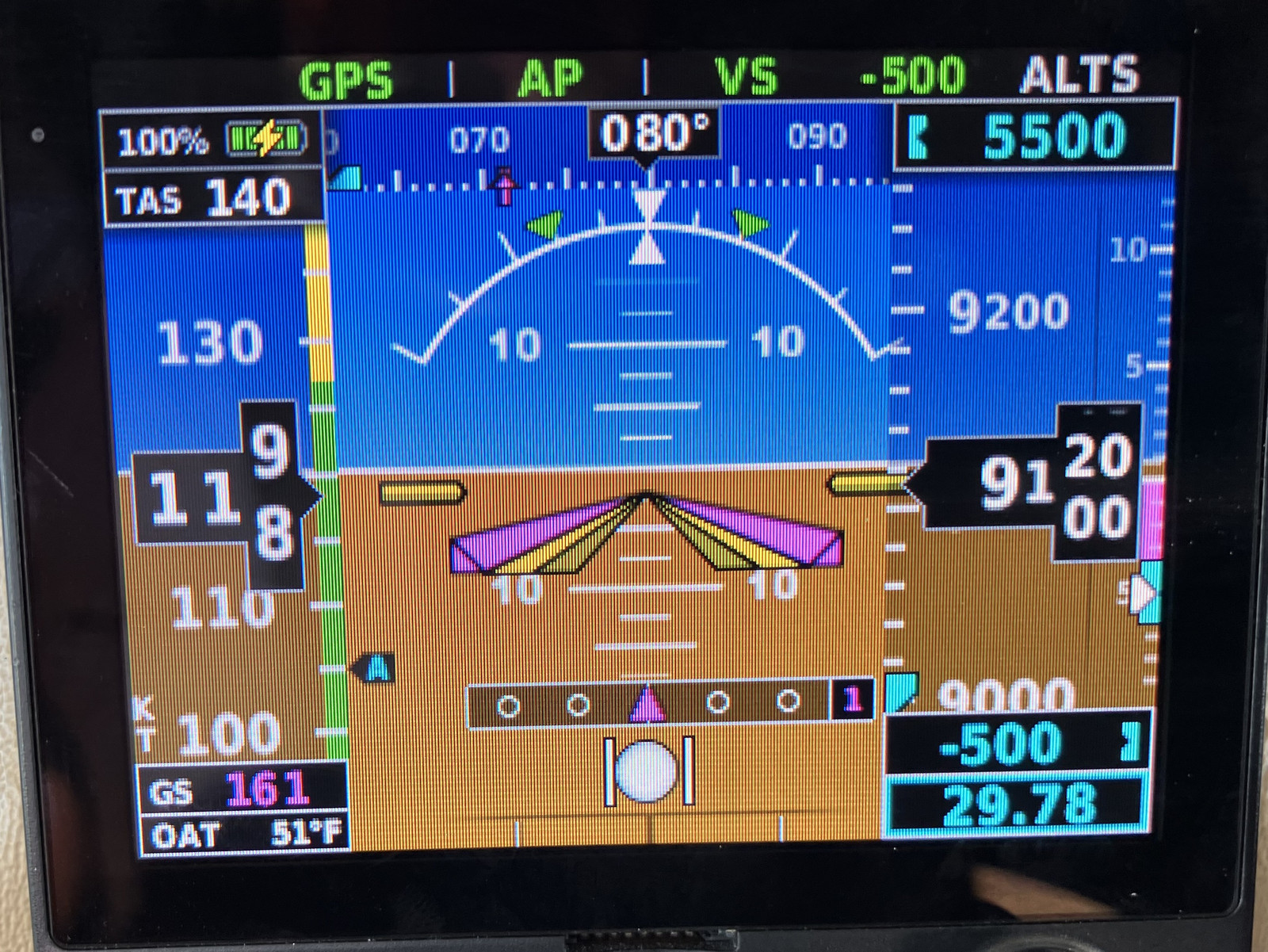
Why Idaho Falls? Because they had rental cars. I was going to fly into Blackfoot, but they didn’t have anything available that day. Idaho Falls is a fun little airport. it’s towered, and has commercial flights in and out, but it’s only Class D airspace, and the controllers are really laid back. I personally prefer to fly in and out of uncontrolled fields, but I’ve no problems flying into Class C or Class D airports if I have to, and they’re kind of fun! My approach today was basically, “Well, it’s a direct crosswind, so… which runway would you like?” I picked to land on 03 (for the straight in approach), and the instructions were, “Set up for the straight in, let me know when you’re 5 miles out.” I’ve not done a straight in approach for some while, but with 9000 feet of runway, it’s pretty hard to screw up in a Cessna. Even if you only have 30 degrees of flaps… If you’re switching between planes with 30 and 40 degrees, make sure you remember what you’re in, because if you try to fly a “flaps 40” approach (in which you can be about 500’ high on short final and touch down on the numbers) with only 30 degrees, you’ll float a good ways. Fortunately, I’ve been flying 93F enough that I’m used to the somewhat less draggy approaches now.
Even at a commercial airport, general aviation is really casual. Go find a spot, shut down, wander to the FBO and, in my case, ask them to fill things up. I knew I was going to have a headwind coming back, though I had no idea what I was actually in for…
Small Airports and Rental Cars
I walked over to the terminal, past the check-in counters. I don’t know how many flights a day Twin Falls handles, but it can’t be very many… Still, it’s way more fun to show up in a Cessna. The front left seat is the coolest seat in the plane!

I got a VW… Jetta, maybe? Car. Drives. Has interesting features I’ll talk about later.

This is the fanciest thing I’ve driven in a very long while. The Ural being my daily driver leads to a certain set of expectations about vehicles that this did not meet… like having to use both sides of my body to drive. On the Ural, the right side is throttle and brakes, the left side is the clutch and transmission. In a car? There’s nothing for the left side of my body to do…

Towards The EBR!
Wind aside, it was a properly beautiful day to roll down Highway 20. I don’t really have “working GPS on the ground,” so I verified I was on 20, and figured I’d see signs eventually.

And, indeed, you do eventually find signs! Exciting!

A turn or two later, well marked, there’s a thing in the distance. A brick building on the right, and a couple low blobs on the left! That’s what I’m looking for - and, in particular, I’m really excited about those blobs to the left.
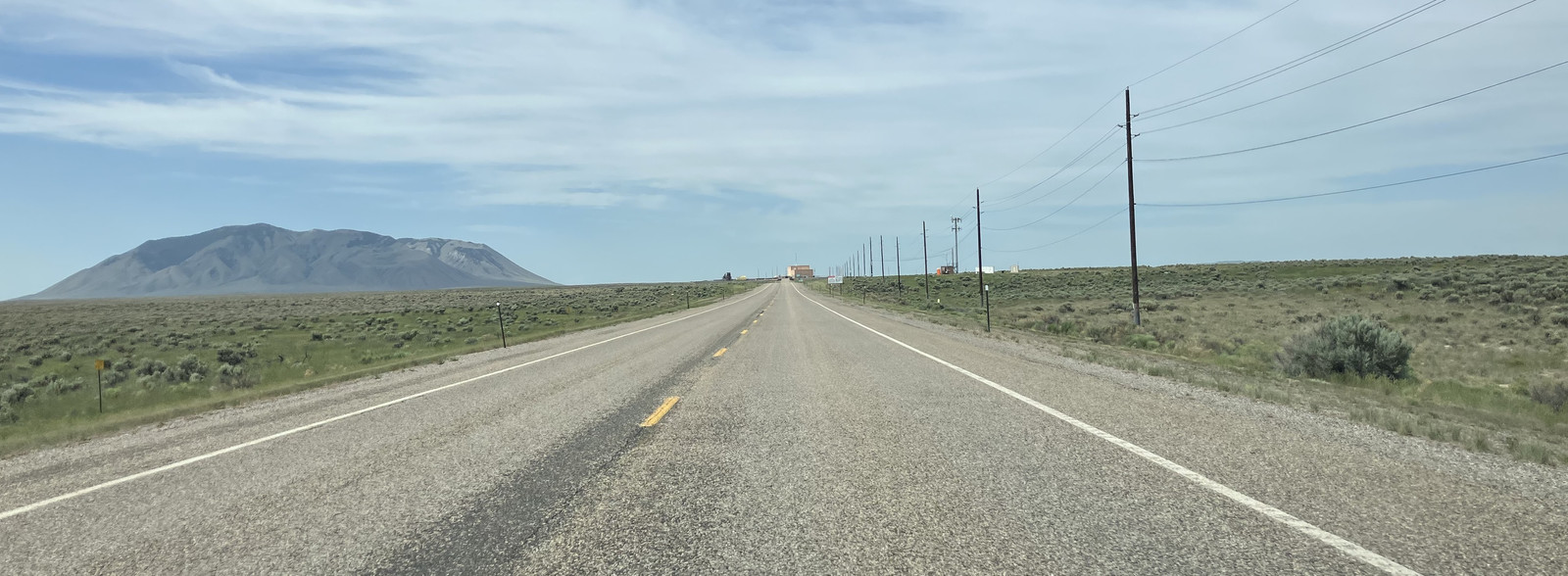
As you arrive, the building is as gloriously 1950s National Lab as I could possibly imagine - and the inside only gets better! But, before going in, there is one of the more absurd moments in US aviation research history to explore.

Nuclear Jet Engines!
Back before ICBMs, cruise missiles, and orbital weaponry (that totally doesn’t exist…), the bomber was the main long range weapon that we had (same goes for the Soviets, I just don’t know as much about their developments). Bombers are great, but the earth is rather large. As with most things in life, there are tradeoffs, and for bombers, “range” and “speed” are somewhat opposed to each other. You can go a really long distance if you’re willing to travel slowly, or you can go really fast, if you don’t care to go terribly far. This is just the limits of fuel capacity - going fast takes more energy than going slow. Refueling solved some of this problem, though it creates others (refueling tankers tend to be “easy to hit targets”, in a hot war).
At the time, “nuclear reactors” seemed a good solution to a lot of problems, and so it didn’t take long before someone reasonably enough asked, “What if we made a nuclear powered aircraft?” You wouldn’t have the range limits of having to carry jet fuel around, and you could, in theory, go as fast as you wanted, as long as you wanted (or for whatever the thermal limits of your airframe dictate).
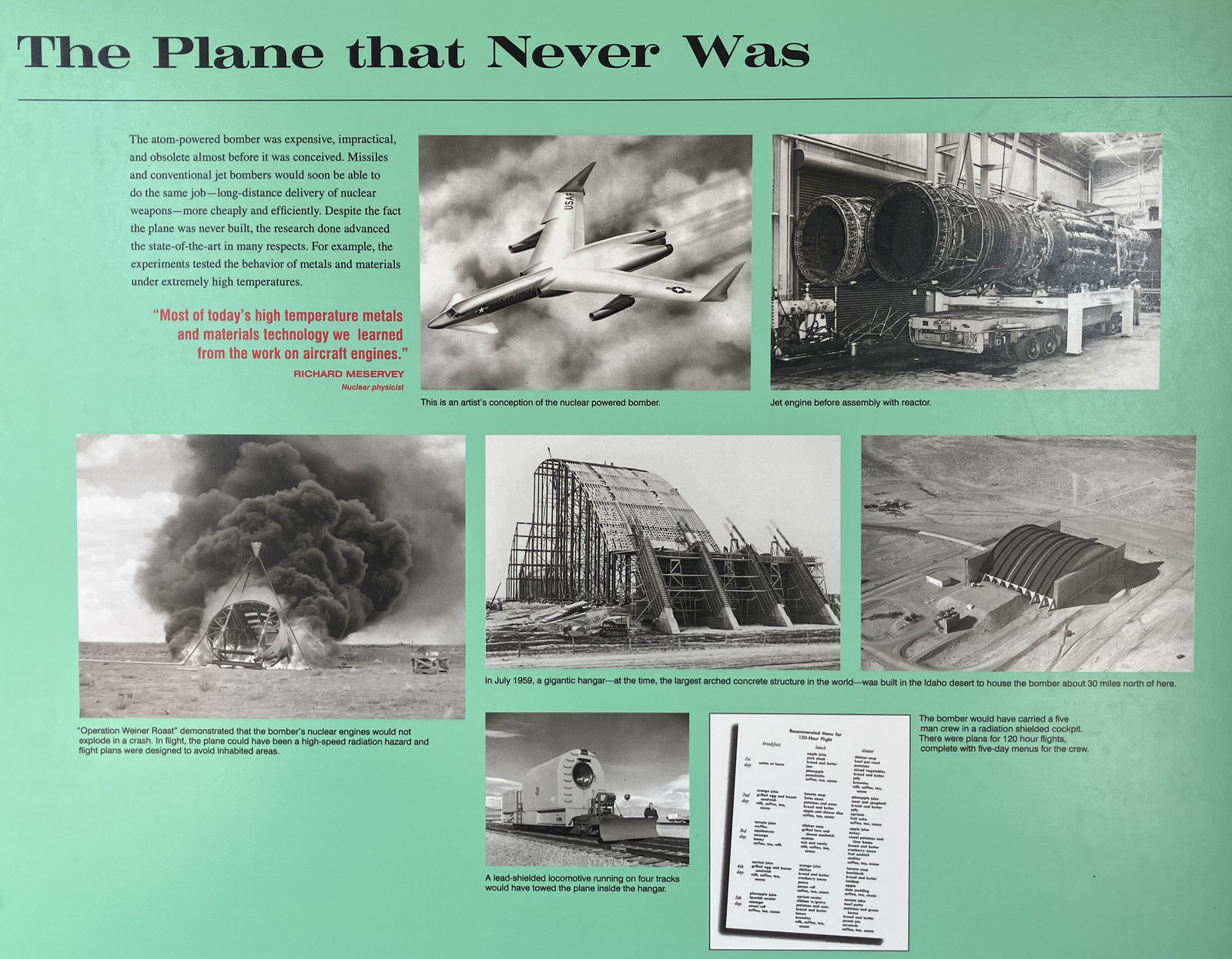
Fundamentally, a jet engine is a very simple concept. You have a compressor section at the front that sucks in air and compresses it. You apply heat in the center of the engine, expanding the compressed air. This then rushes out through the turbine section, which recovers enough power to keep the compressors spinning, and the remainder departs as exhaust gases, leaving you with a net thrust. We normally do this by burning some sort of dense hydrocarbon in the middle section (kerosene is typical because it’s energy dense and well behaved, but a turbine engine will run on anything that burns - natural gas, oil, gasoline, coal dust… they’re genuinely not picky). As long as you can heat the air in the center section, somehow, a jet engine will work fine. You could put a massive resistor coil in there and run it on electricity, if you wanted.
Or, you could pipe the compressed air through an air cooled nuclear reactor, and heat it that way! It sounded good enough on paper that several test rigs were built, and they’re sitting in the parking lot of the EBR-I museum!
The Heat Transfer Research Experiments
Most images of the HTREs you’ll find online only show the two bits of actual machinery. On the right is HTRE-1, which was later turned into HTRE-2 (for high temperature materials research). On the left is HTRE-3, which is still in the “nuclear powered jet engine” configuration. Or so the signs say. But I’m actually somewhat convinced the signs are wrong, that HTRE-1 is on the left (with the jet engines still attached), and HTRE-3 is on the right, with the jet engines missing. I’ve found too much documentation that contradicts the signs on the fences while trying to better understand these bits of machinery, and the descriptions of the cores just don’t match, so I say HTRE-1/2 is on the left, and HTRE-3 is on the right - which is also what some of the other signs say.

What I didn’t realize until I got there is that there is also another experimental artifact on the left - a lead locomotive that was used to move these experiments around (and, per a sign, intended to be used to move nuclear powered bombers in and out of the hanger - though it seems more likely to me that it was just used to move assorted test rigs around INL).

It appears that they’ve taken some variety of locomotive, stripped the bodywork off, and built a special, radiation-shielded body for it. There are two small round windows at the front and back, and I can’t imagine visibility was very good, because those will be the sort of thick, radiation-proof windows you’ll be seeing more of later in those post. The early nuclear age was weird. But you can start getting a sense of the style you’ve seen in some video games set in that era.
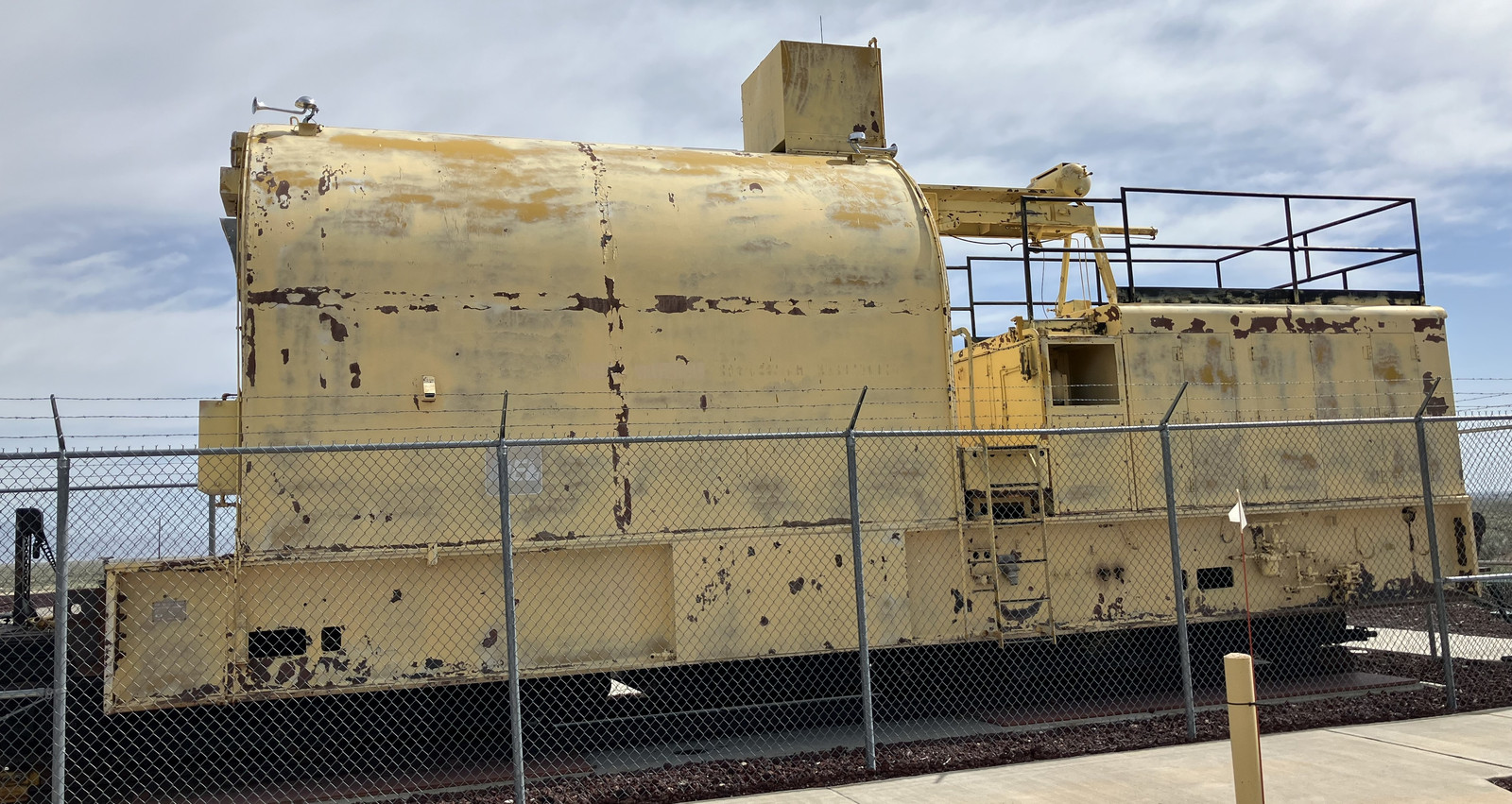
This is a General Electric Diesel-Electric Locomotive, Class AIA-AIA-225/430-4GE733-56 1/2 GA, if you happen to be able to decode that. Number 32027, manufactured in June 1954.
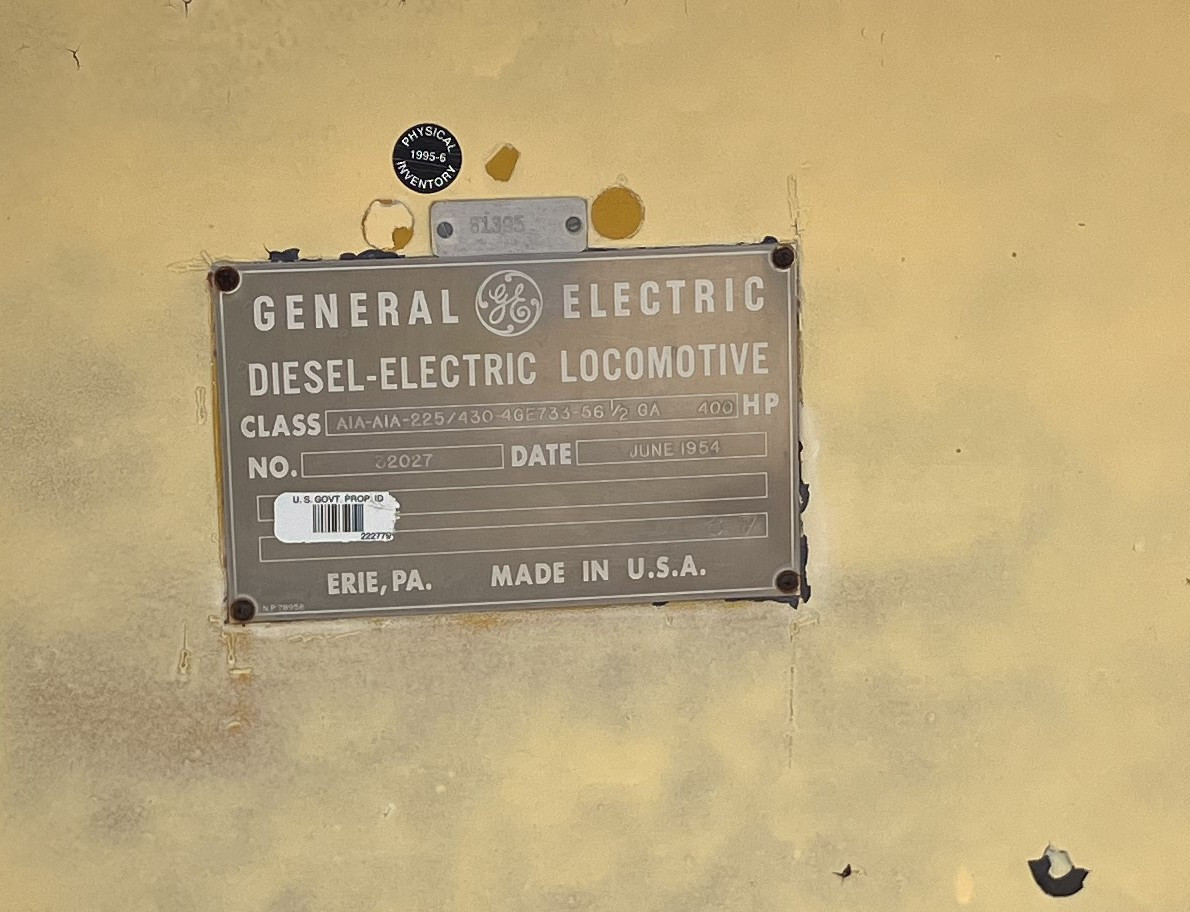
HTRE-1 & HTRE-2
HTRE-1 was the first experimental nuclear jet engine, and it proved, in January 1956, that the concept works. I’m faintly surprised that these weren’t featured in any Bond movies, but I suppose they are still somewhat radioactive. I didn’t bring a Geiger counter with me, but they’re fenced and marked with the “radioactive zone, don’t go in here without knowing what you’re doing…” sort of signs.
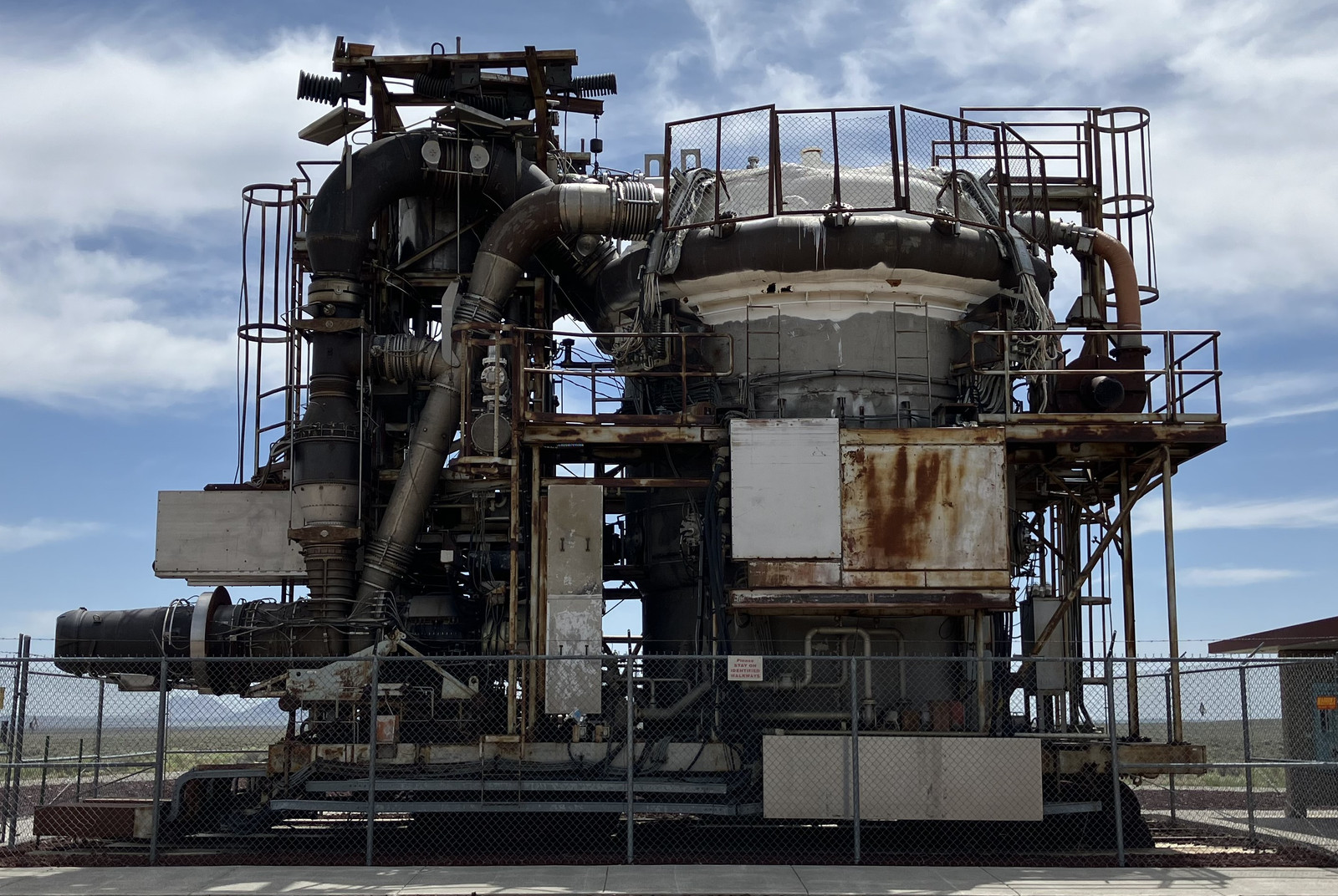
This was the first version, and used a vertical reactor, since that’s what tended to be in common use at the time. Air gets compressed, run through the reactor, and expanded out the turbine section. For a proof of concept sort of device, mass doesn’t matter, though I do wonder if they ever let the rail car run some distance on its own power for fun.
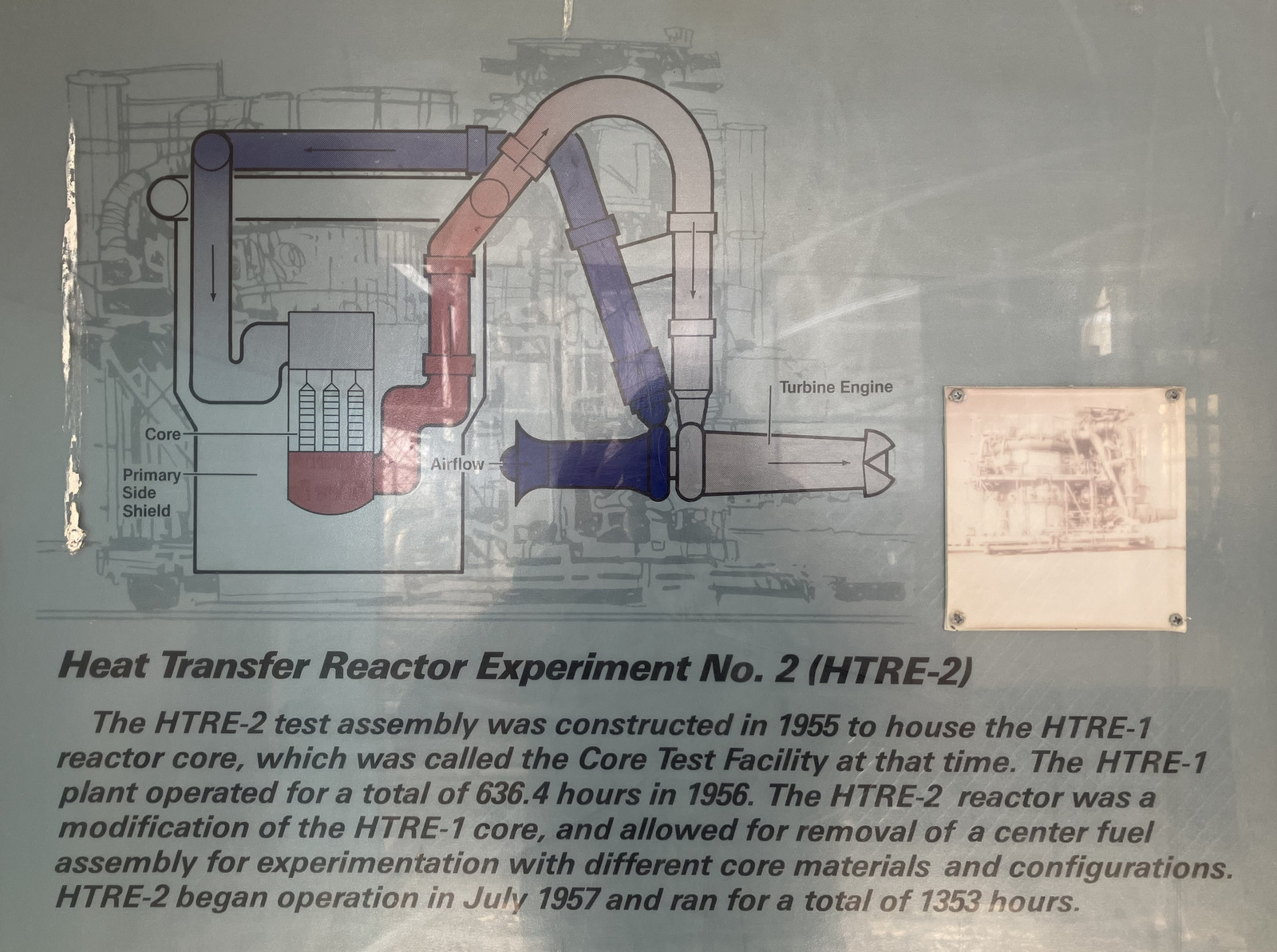
It has a very “dystopian industrial ruin” sort of look to it. What’s this? Oh, this is the leader’s nuclear powered rail car they use to get around the wasteland, on the oddly still functional rail tracks.
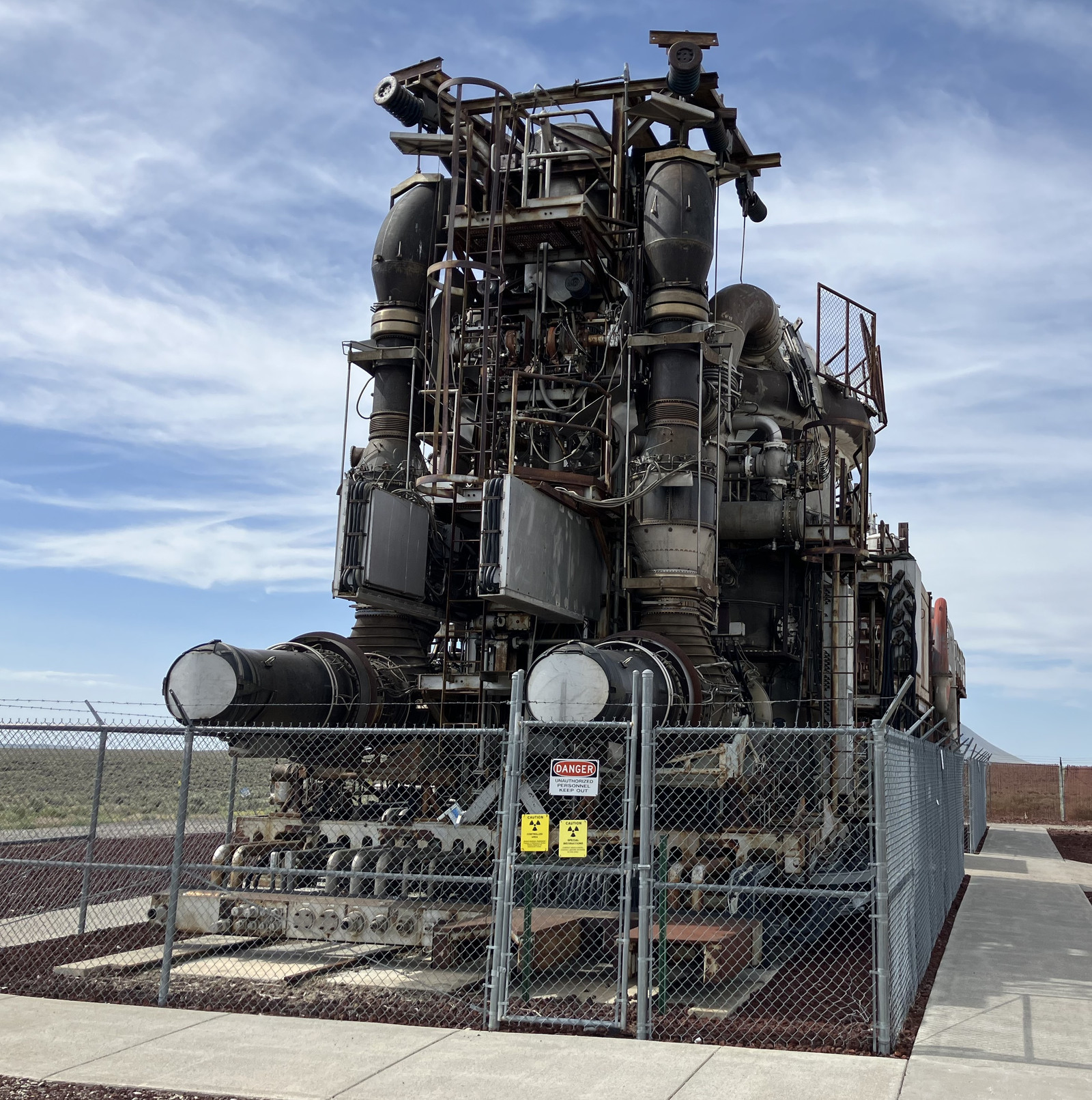
The air intake for the jet engine is on the left, stuffed into the rest of the structure, followed by the compressor section. Instead of heading into the normal combustion chamber, the compressed air heads up the grey pipe to the left, into the reactor. After being heated, it comes back down the black vertical pipe on the right into the turbine section of the engine, where it dumps enough energy into the turbines to keep the compressor turning before heading out the tailpipe. There are two of these, one on each side.
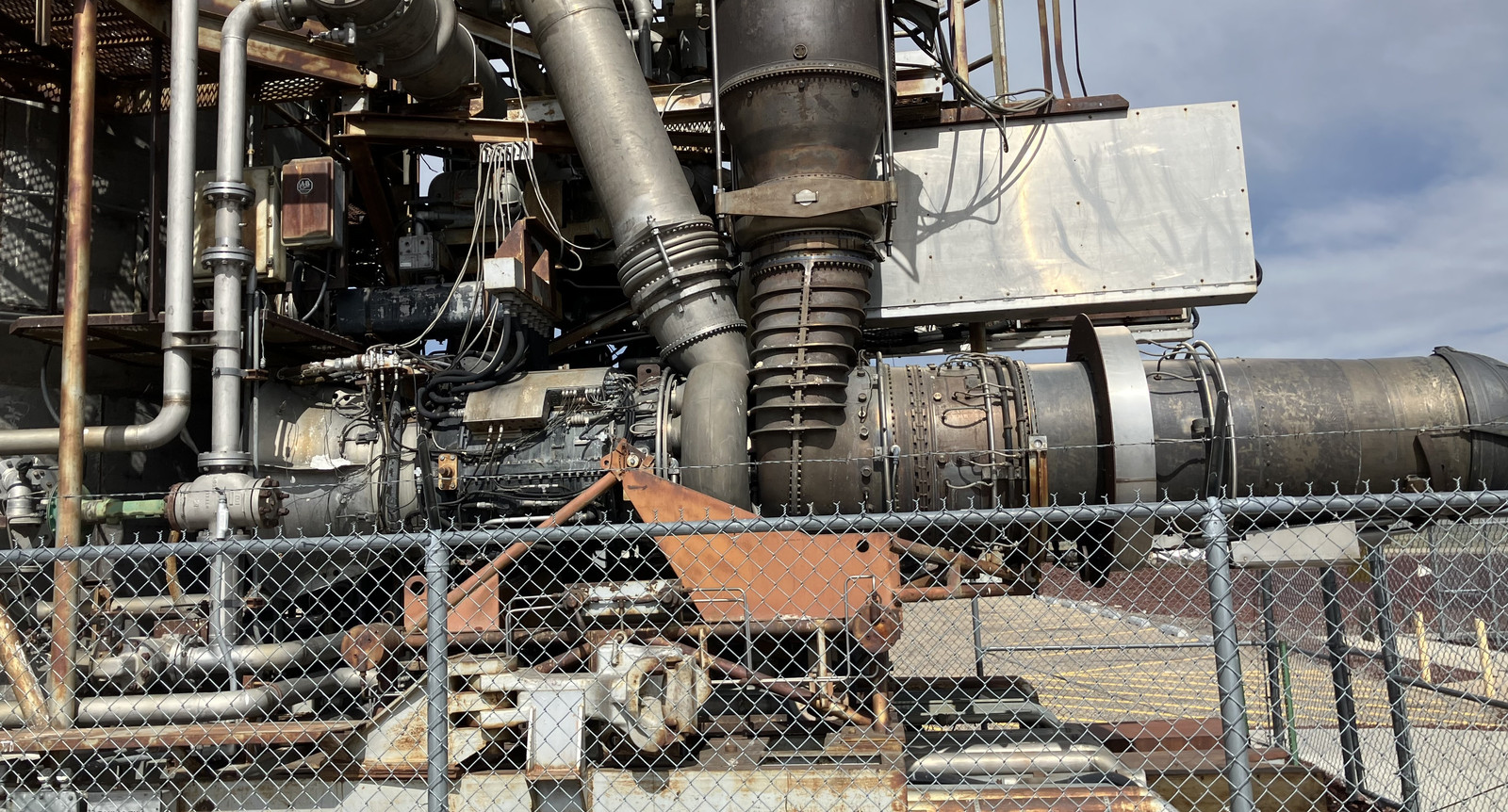
The pipes enter the round containment chamber, and I just like how this shot turned out with the sun behind the clouds, behind a bit of absurd machinery with some off kilter fencing. It would be perfectly at home in a lot of video games. There might even be secrets inside, though don’t stay too long or you start taking damage!
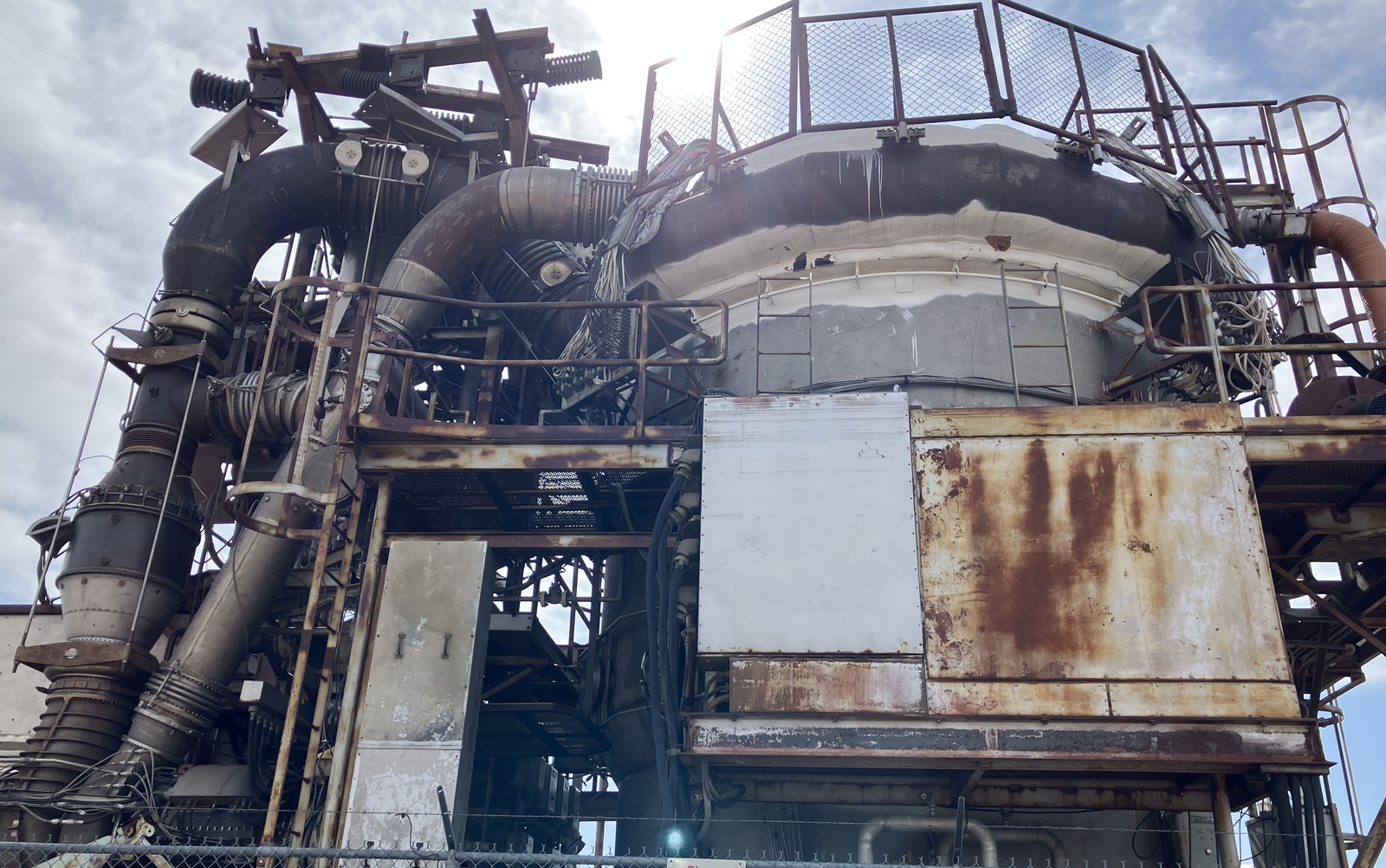
All of the connections and pipes have bellows in them to handle thermal expansion and contraction, which is reasonable when you’re moving very hot air around. There’s also what appears to be a bypass - the horizontal bellows about halfway up the photo. I expect the lever on the right hand pipe is connected some sort of flapper inside that controls if the compressed air flows into the reactor, or flows back to the turbine section, with the lever on the black “T” doing roughly the same. Per some documentation I found, the large can at the bottom is the combustion chamber that was used to start the engine on jet fuel before cutting over to nuclear power, and may simply be the combustion chamber they pulled from the engine, rotated and replumbed. In any case, this is a wonderful bit of absurd industrial piping project!
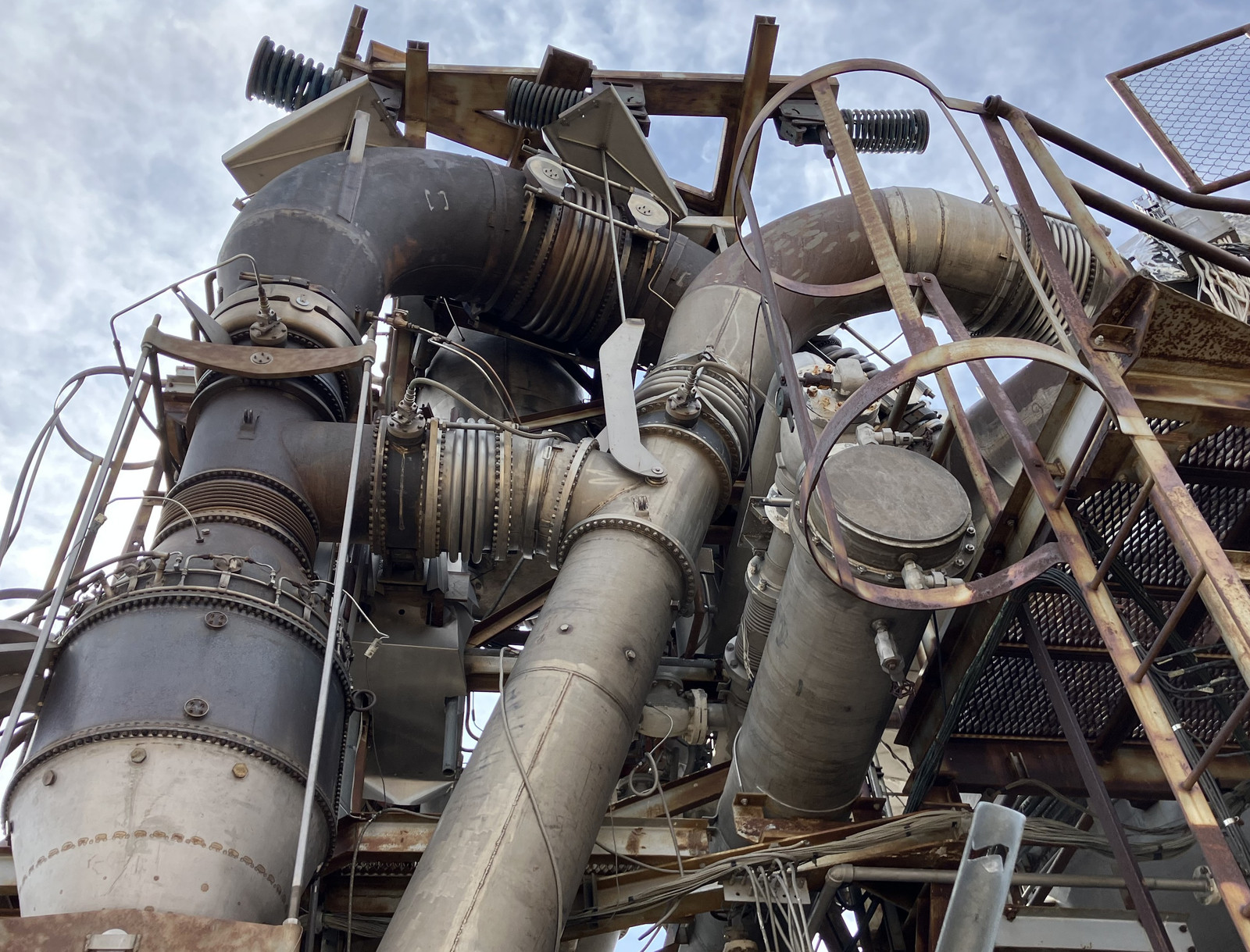
Like any reasonable military jet engine, they have a variable cross section outlet nozzle. I don’t fully understand the details behind it, but changing the cross sectional area of the outlet matters for efficient engine operation across a range of powers.
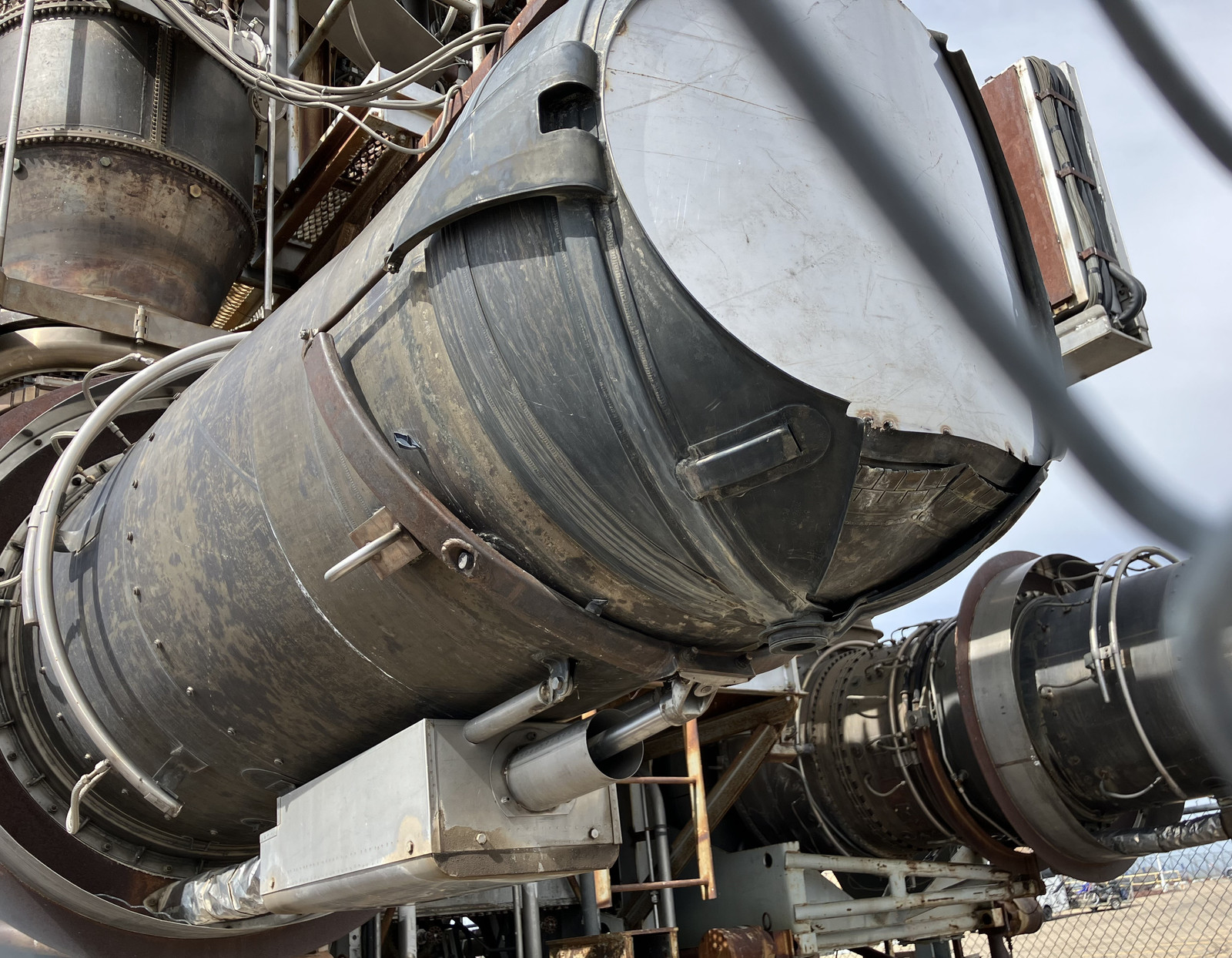
Nuclear. Jet. Engines. SO COOL!
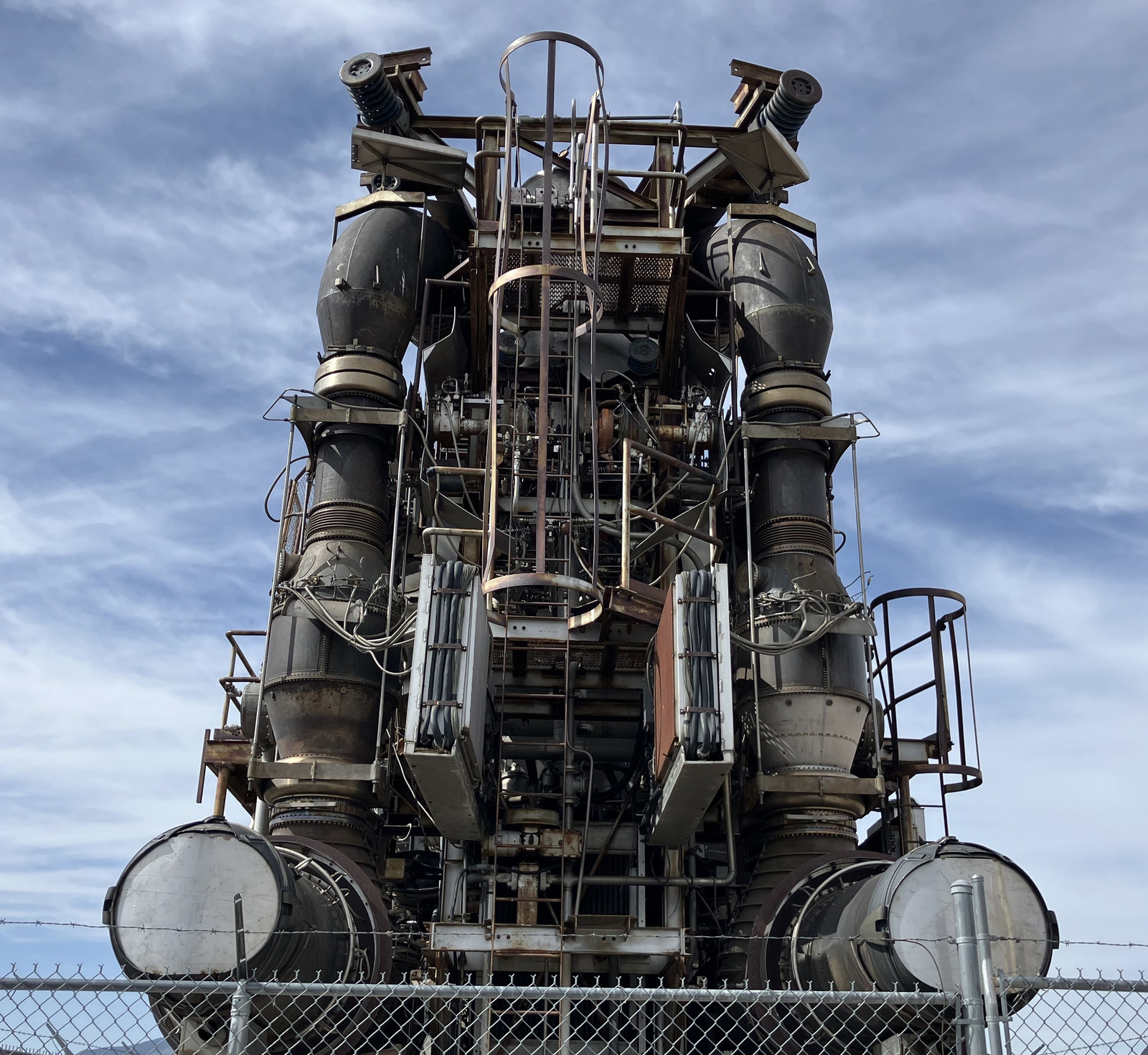
HTRE-3
The second test rig, HTRE-3, is was designed to test something that would more closely resemble an aircraft installation, with horizontal airflow and control rods. This is a different configuration than most reactors are, and the goal was to learn about a horizontal air cooled reactor, and presumably to test some things that had been learned and refined in the previous unit.

It’s hard to get good photos of some of the signs in the sun, but you can see the concept they used here - air is compressed, run through a long series of tubes to the reactor core, heated, and blasted out the turbine section of the jet engine. The jet section seems to be missing, though.
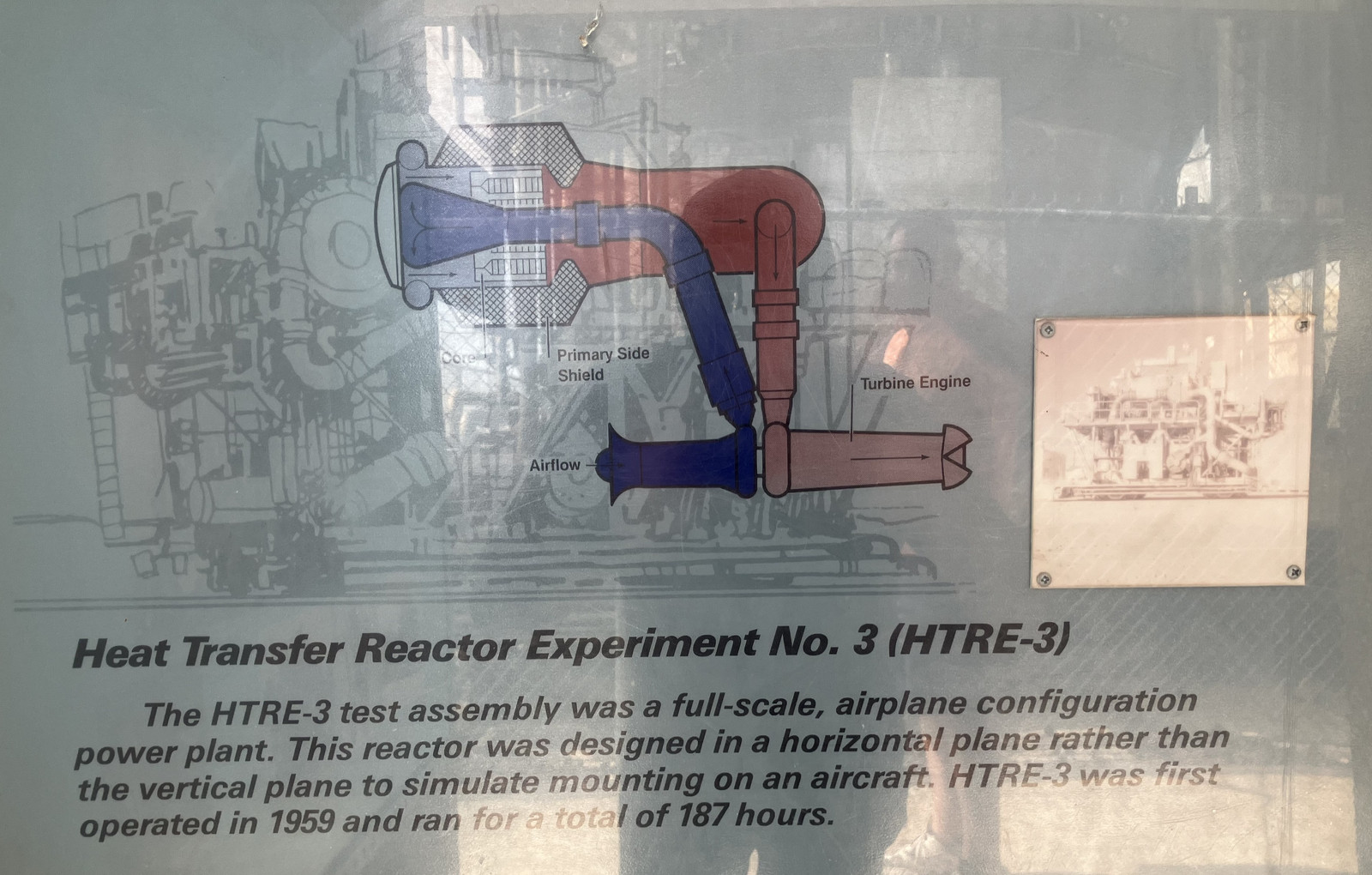
It is a glorious bit of well-aged 1950s industrial tech, and I expect it to last long enough to really confuse some future historians.
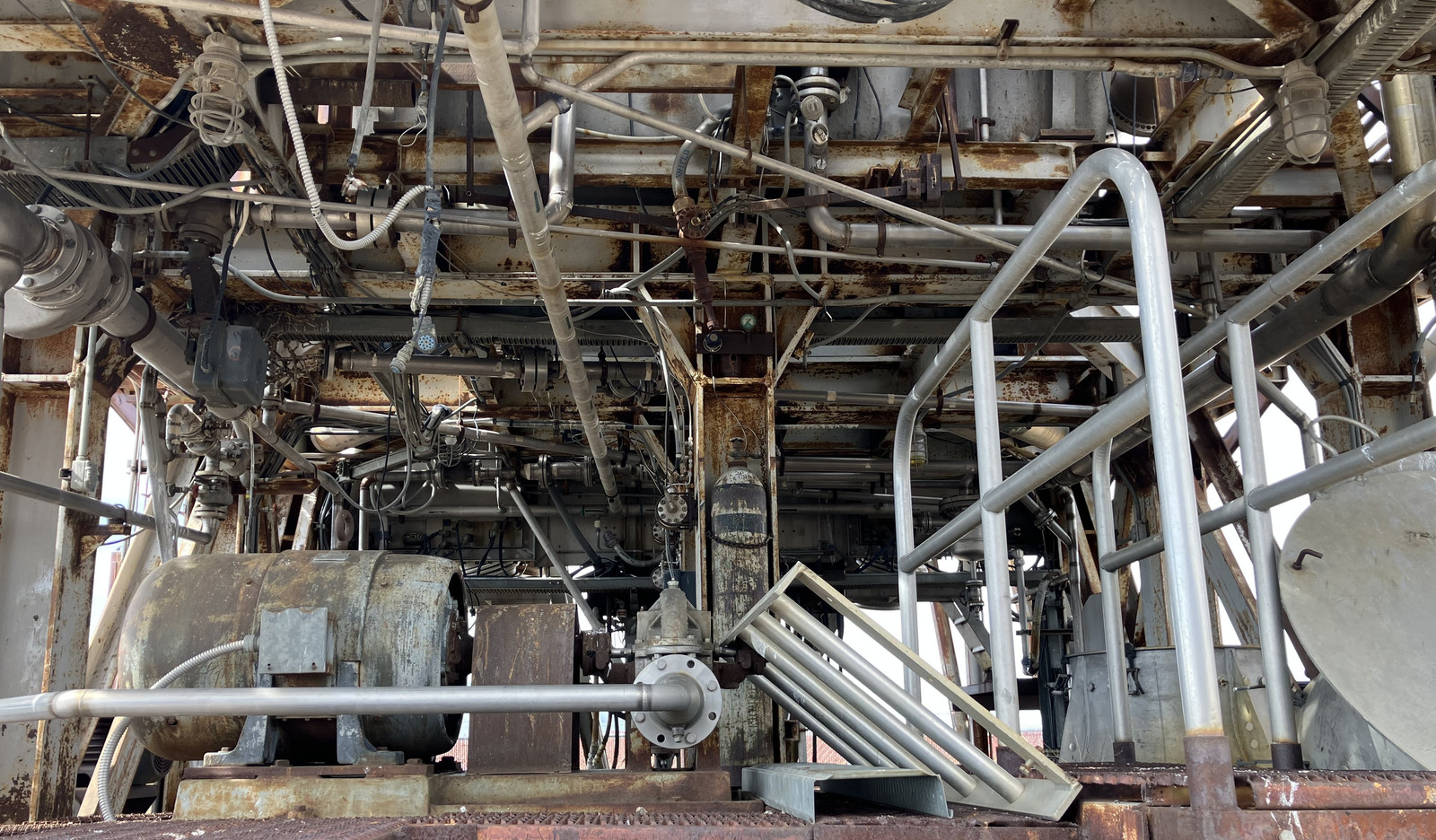
Blowers, ducting, flex couplings, it’s got everything you’d imagine a 1950s nuclear powered jet engine test rig would have!
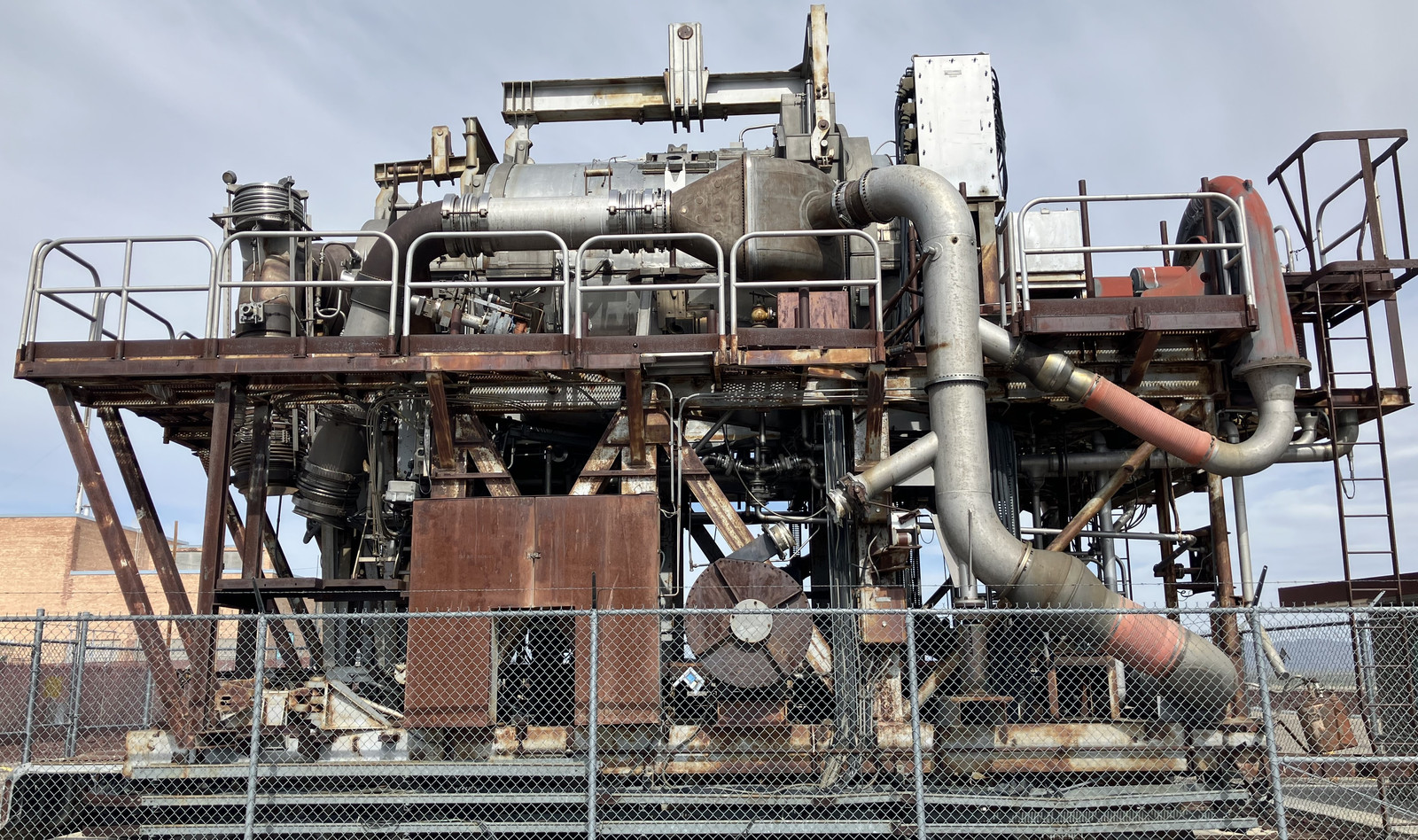
The capped off bellows are where the jet sections would have connected, and capping the openings seems wise. I don’t think the world needs more nuclear birds.
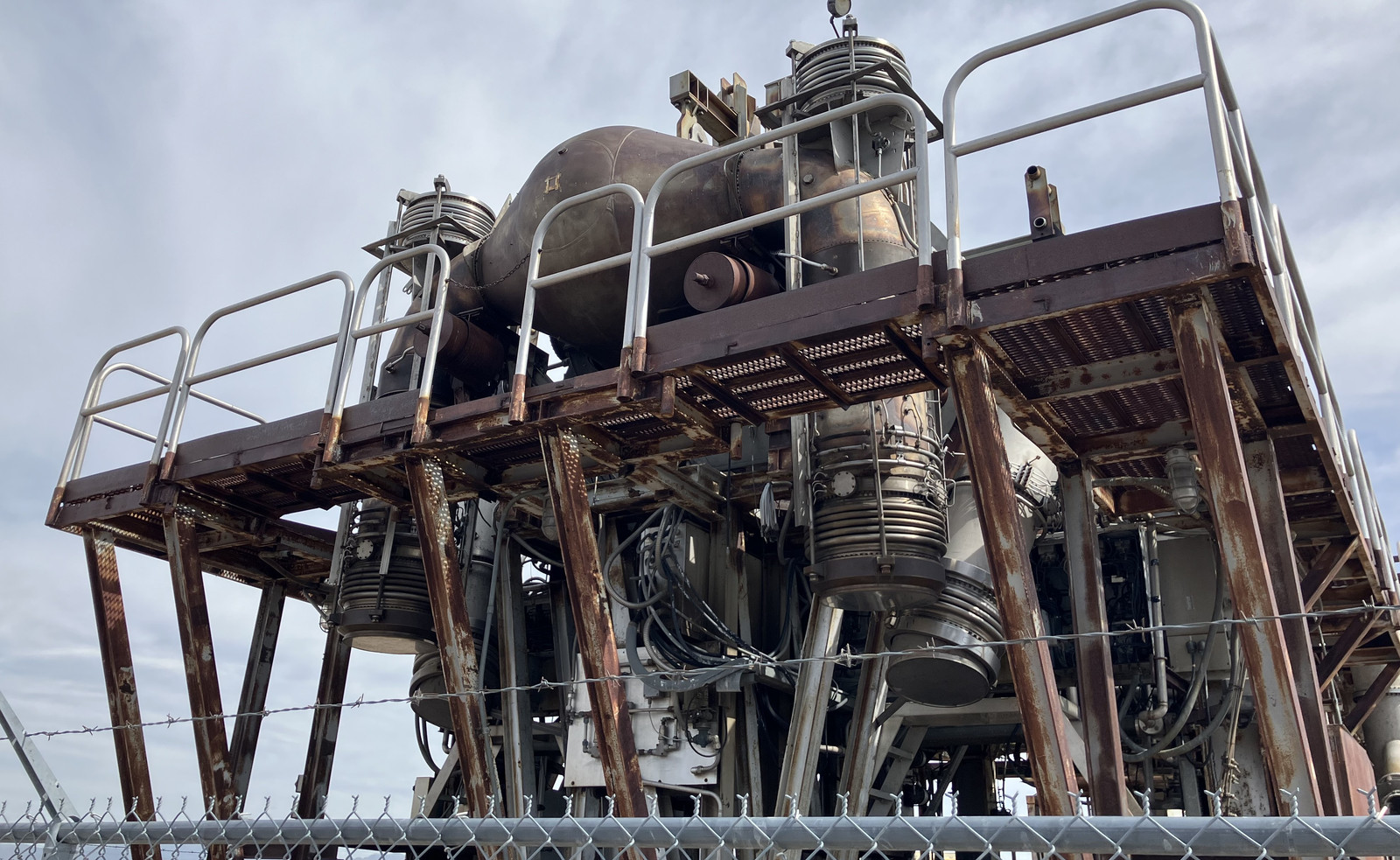
The controls were attached to a board on the side of it. Lots of toggles, adjustments, knobs. Yes, they just stood right by an operating nuclear jet engine to control it! There are fuel gauges down on the right, and my understanding is that the system was originally started on jet fuel, though later on they were able to start HTRE-3 on nuclear energy only.

One of the signs is clearly showing HTRE-1 labeled as such, with the general design of HTRE-3 visible in a smaller image below. I just think the signs on the fence are wrong.
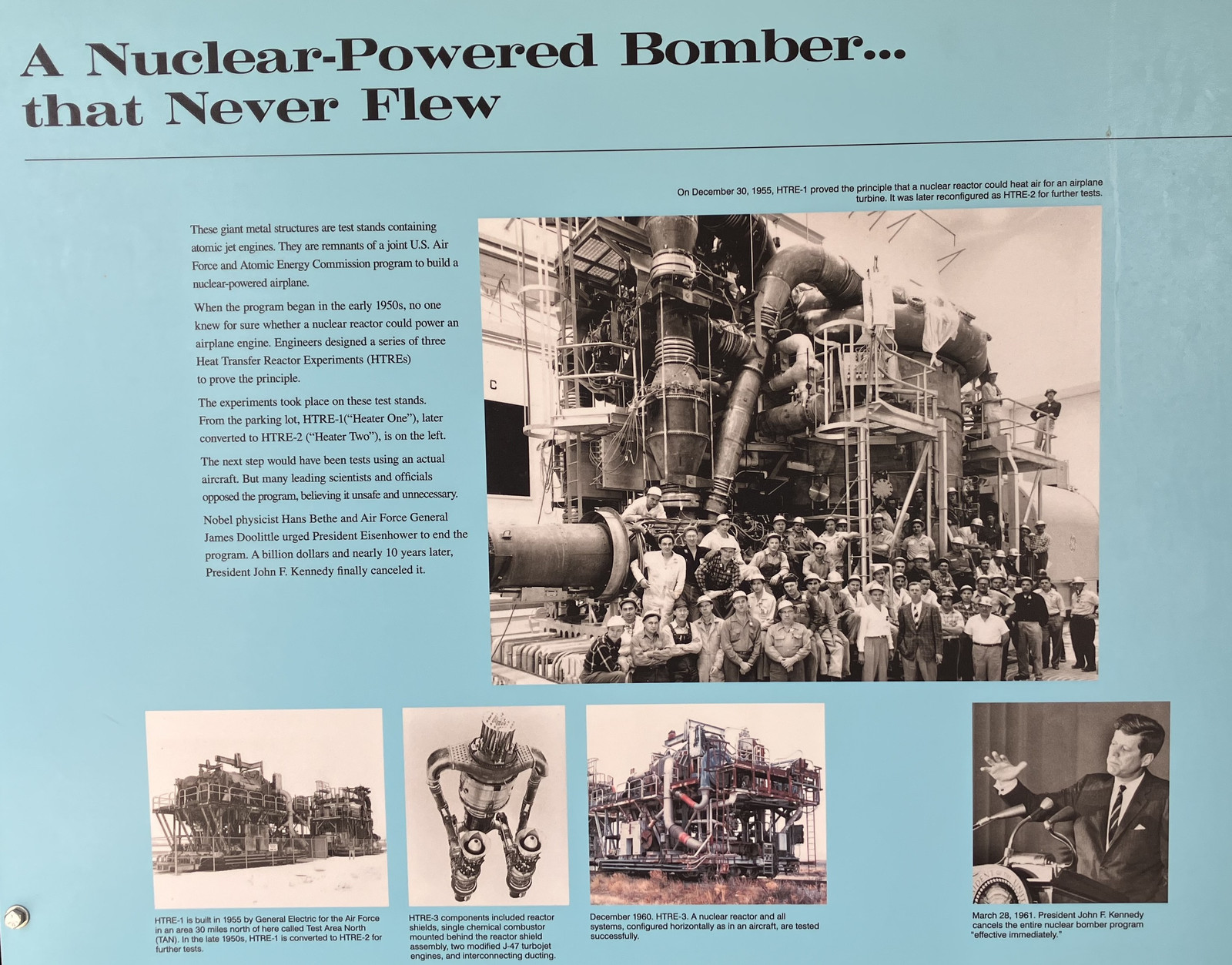
The EBR-I Museum
After (finally) getting past the parking lot, I was finally able to get into the museum proper, which is a familiar sort of building to me. I’ve worked, in the past, in labs in some very similar structures, of very similar age, though lacking the nuclear reactor aspects. They’ve done a really nice job of cleaning it up for tours and labeling everything, but it’s all worked around the very much core structural aspects of “running a nuclear reactor.”
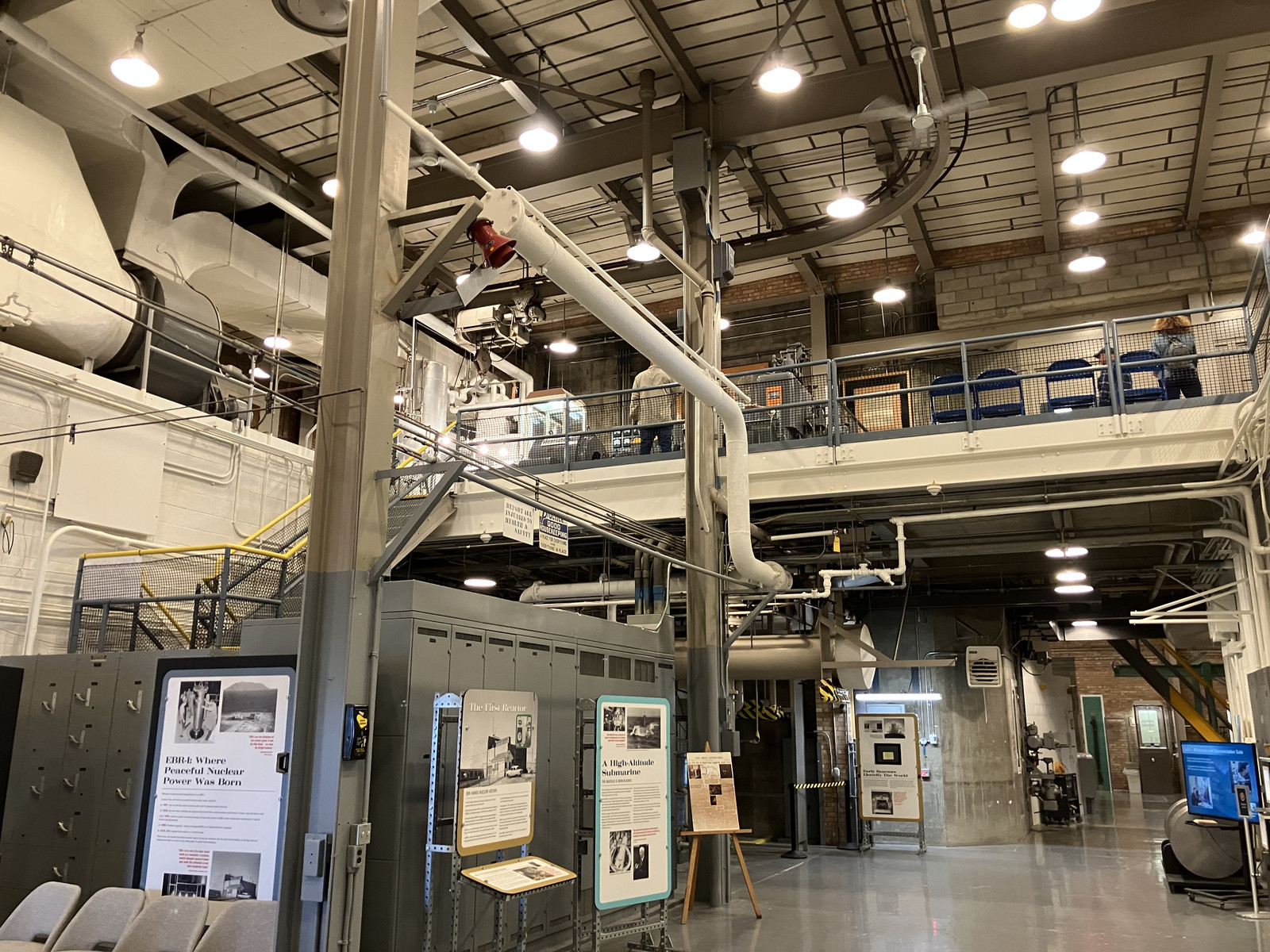
The view out the bathroom window gives a good clue as to why the US did reactor development out here - there’s not a lot to bother. At some point in the past, the Navy had done artillery research out here for their guns. Also, because of the Snake River Aquifer, there’s plenty of water available underground to use for cooling the reactors as needed. Water cooling, in a dry desert environment, works very well!
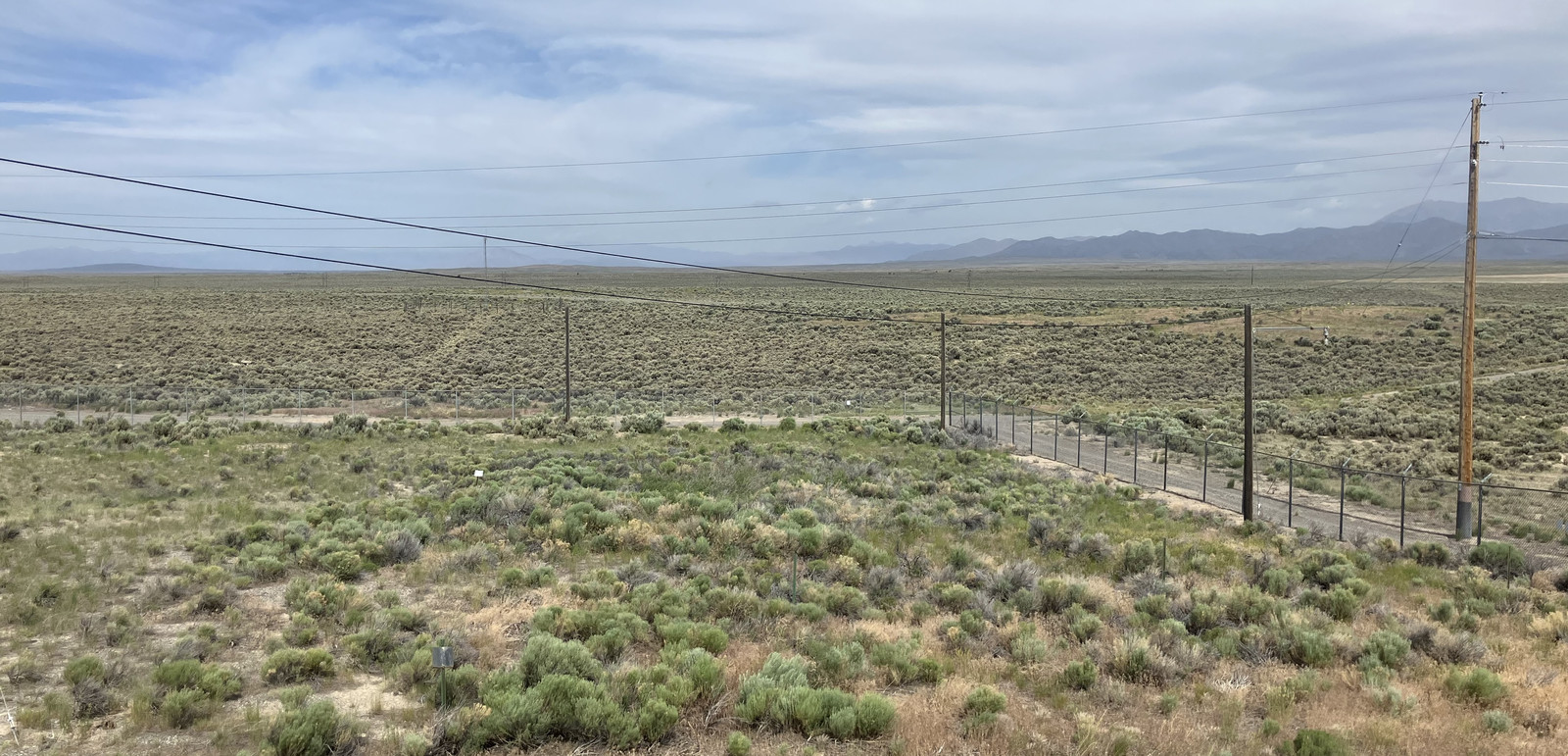
Idaho National Labs is where a ton of early nuclear reactor research happened in the United States, and it’s a spread out sort of facility, with a few tech areas scattered around a large empty space. There is a long history of reactor designs they’ve built and, often enough, “discovered interesting new corners of nuclear physics” from. The early days of nuclear reactors involved a lot of unknown unknowns, and they worked through many of them, quite systematically, out here. This bit of land started as the National Reactor Testing Station (NRTS), back in 1949.
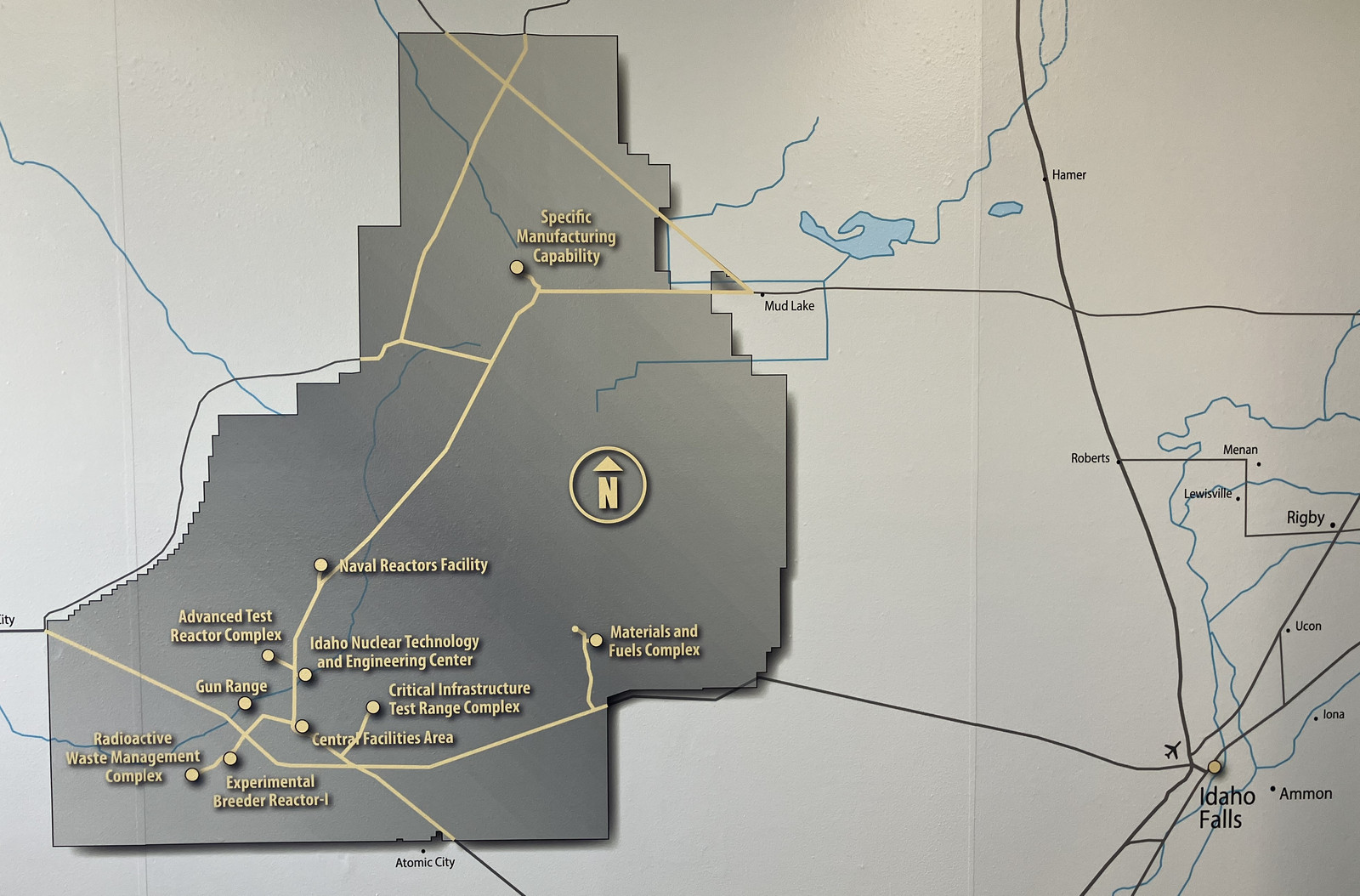
Some Quick Background on Nuclear Reactors
Scattered around the tour were random blackboards with some amazingly done explanations of radiation, nuclear chain reactions, and other aspects of relevance to understanding this museum. They have been done, as far as I could tell, in chalk, by someone with very good handwriting. Something immediately obvious in this building and the structures within is the sheer mass of them. The walls are thick. The windows are thick. The sliding doors are thick. All of them have to be this way to keep the radiation coming from the reactor where it belongs. Alpha and beta radiation aren’t terribly difficult to deal with, but gamma radiation, or neutrons, just require mass. This is something to keep in mind when people talk about long term space travel - there’s a lot of gamma radiation in space.
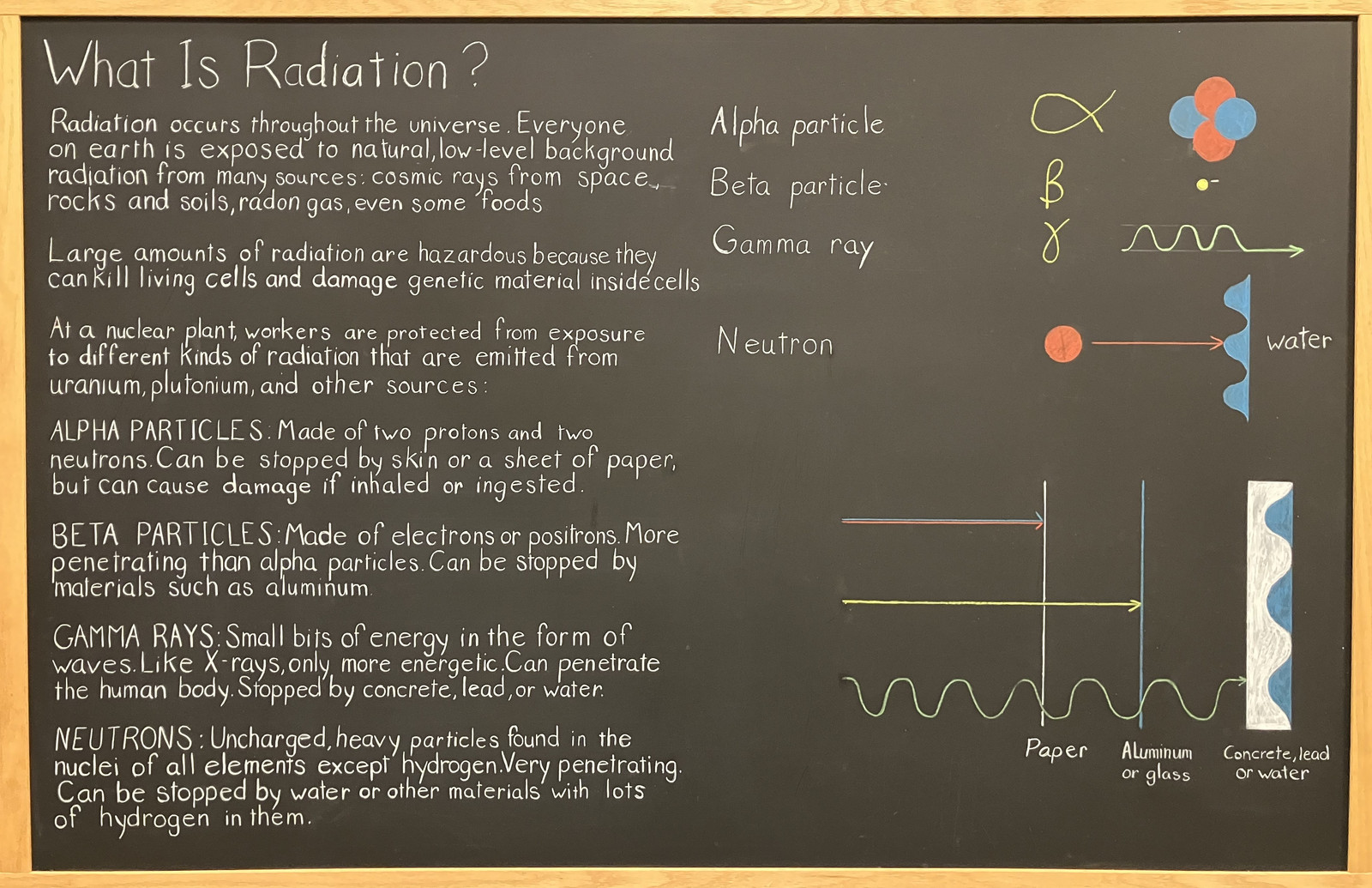
Nuclear reactions are the simple and elegant process of shattering atoms with neutrons! Most atoms are stable and like to stay as they are, though some (the radioactive sort) are rather less stable and would rather be something else - which they can either do spontaneously, or, more usefully, on demand when they get hit by a neutron. Since one neutron coming in will often generate more than one going out, you can get an expanding chain reaction that sustains until you run out of fuel (in the form of radioactive materials to split). It is, in a very real sense, “splitting atoms.”

The details of how nuclear reactions are controlled is the subject of PhDs in nuclear physics, but, suffice it to say, we’ve got a pretty good handle on the process. Much of that knowledge was being newly developed in the 1950s, though. Much as our modern commercial airliners are quite safe as a result of a lot of the crashes in the 1930s-1970s coming from “… well, huh, we didn’t think that could happen…” sort of crashes, we have a pretty good handle on the details of nuclear reactions now, and can generally design reactors to do what we want, without too many surprise corner cases. Of course, sometimes other considerations get factored in, and you get the RBMK reactor designs that make modern nuclear engineers shudder around campfires (… but the design had a positive void coefficient!).
What’s a Breeder Reactor?
The name of this reactor is the “Experimental Breeder Reactor.” It’s a nuclear reactor, obviously, designed to experiment with breeding fuel! Naturally mined uranium is mostly (about 99.3%) the U-238 isotope, which isn’t useful as a reactor fuel. The useful part for nuclear reactions is the U-235, which is a marginally lighter isotope that makes up around 0.7% of the raw uranium. Historically, these were split out via a range of methods, though centrifuges seem to be the easiest modern method (Iran’s centrifuge chains have been the subject of much international concern and meddling, from Stuxnet to MOBs, and may or may not exist as more than scrap metal right now).
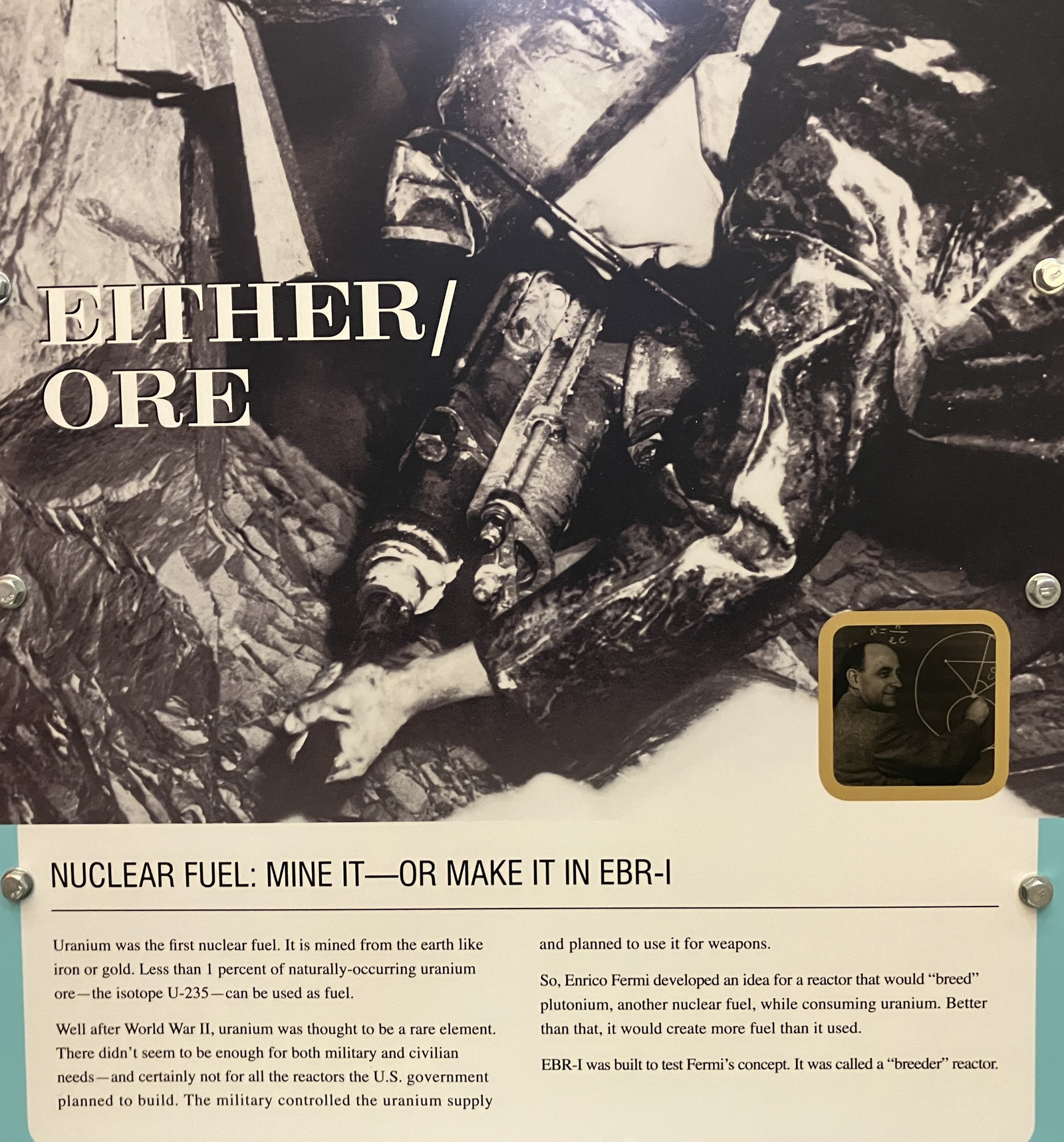
After you’ve extracted the useful U-235, you still have most of the material left, as U-238. Through the weird magic of nuclear physics, if you add a neutron to to U-238, you eventually end up with plutonium - Pu-239, which is fissionable in “useful ways.” Yes, you add a neutron and end up with more protons, and the details of that are deeper than my understanding of nuclear physics goes. But it’s been known for a while that you can bombard U-238 with neutrons and get Pu-239. The question that EBR-I was built to answer is, “Can you breed more fuel than you use?” If you react a pound of U-235 in the reactor and end up with a few grams of Pu-239, this is useful for weapons production, but not useful for “making more fuel.” Theory said that you should be able to make more Pu-239 than you actually need to run the reactor - so after your first fueling, you are able to run your reactor on “useless” U-238 (after turning it into Pu-239), and spin off an excess of Pu-239 for other reactors to run on (or to build weapons, as is often the goal). EBR-I set out to answer this question, and it turns out that it was quite successful at breeding more fuel than it used for over a decade! In addition, it was able to create some substantial amounts of usable electricity in the process.
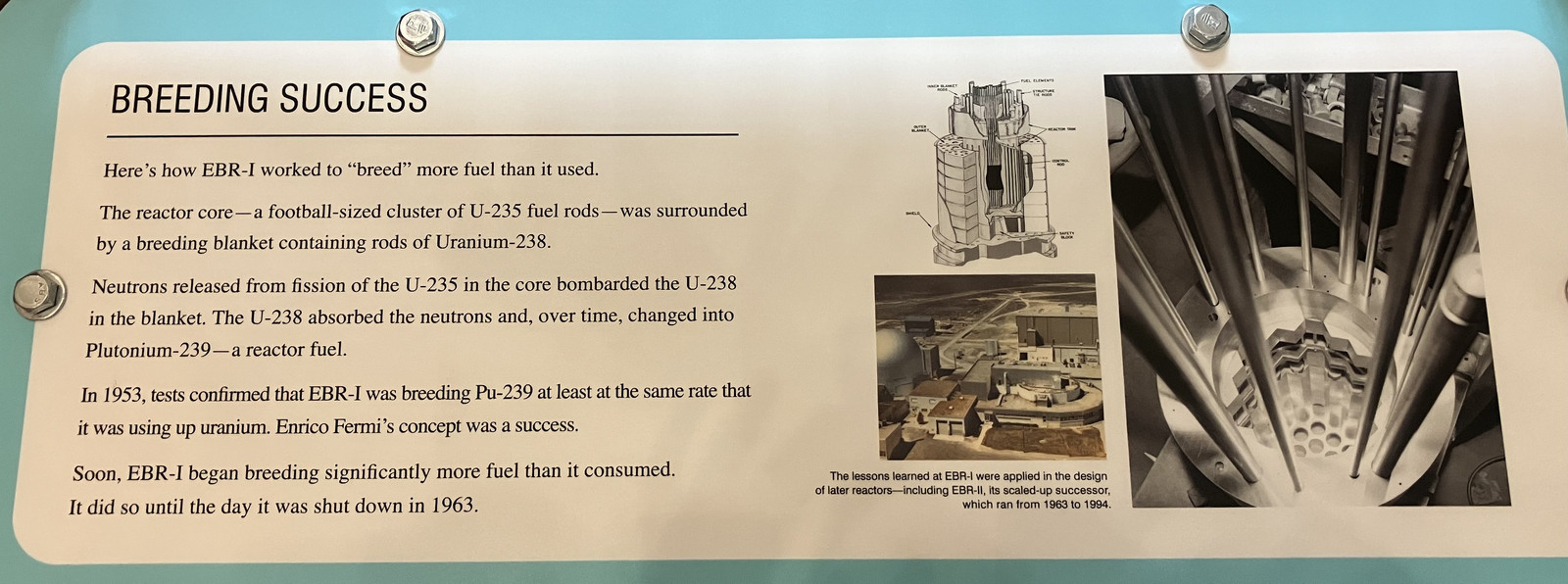
The EBR-I Design
There are two options for tours: Self guided, or with a group. I took the self guided option, as I’m happy to spend a lot of time poking and prodding my way through a place like this, though the guided tour was quite good from what I heard (as a group caught up and passed me). There are many good signs and diagrams throughout the place, so there’s no need to take the guided tour, though if you’re not as familiar with nuclear power plants, it’s probably a good way to go through, then explore by yourself for a while.
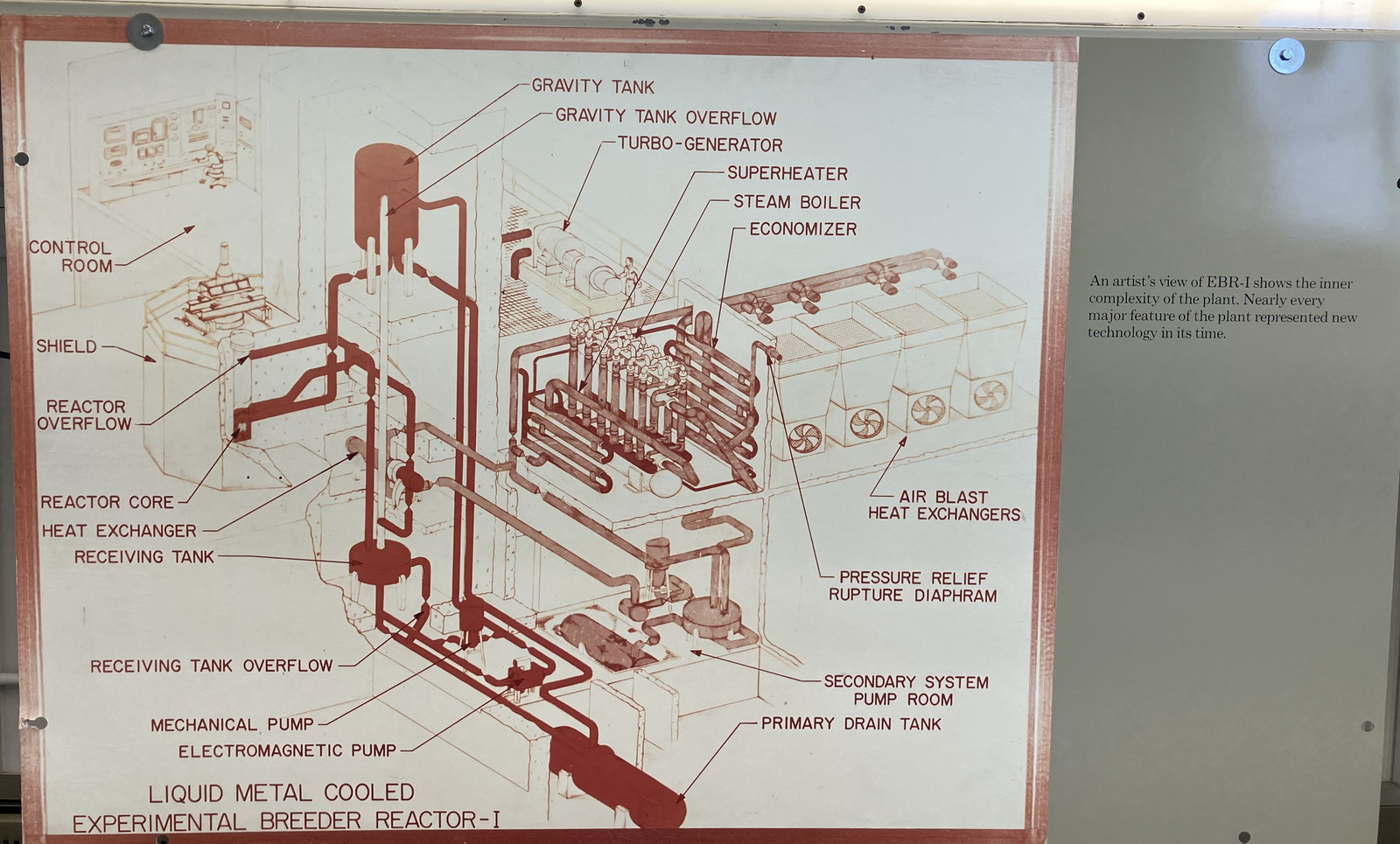
EBR-I was, in every way, experimental. It was a “fast reactor” (running on fast neutrons, not slowed/moderated thermal neutrons as most designs do), and used a quite reactive liquid metal coolant (water absorbs and slows neutrons, which isn’t compatible with fast reactor operation). They had to design new methods of pumping for it (electromagnetic pumps), various new techniques to handle the coolant on the fuel rods, and by every account did a great job of it! Liquid metal reactors have historically been touchy to deal with, but EBR-I was able to use a coolant that remains liquid at room temperature, avoiding some of the challenges of needing external heaters for maintenance. While they didn’t need to have two NaK coolant circuits, the coolant in the primary circuit ends up radioactive, and I believe the goal of the two liquid metal circuits was to ensure a very low risk of any contamination of the water/steam circuit if the heat exchangers leaked.
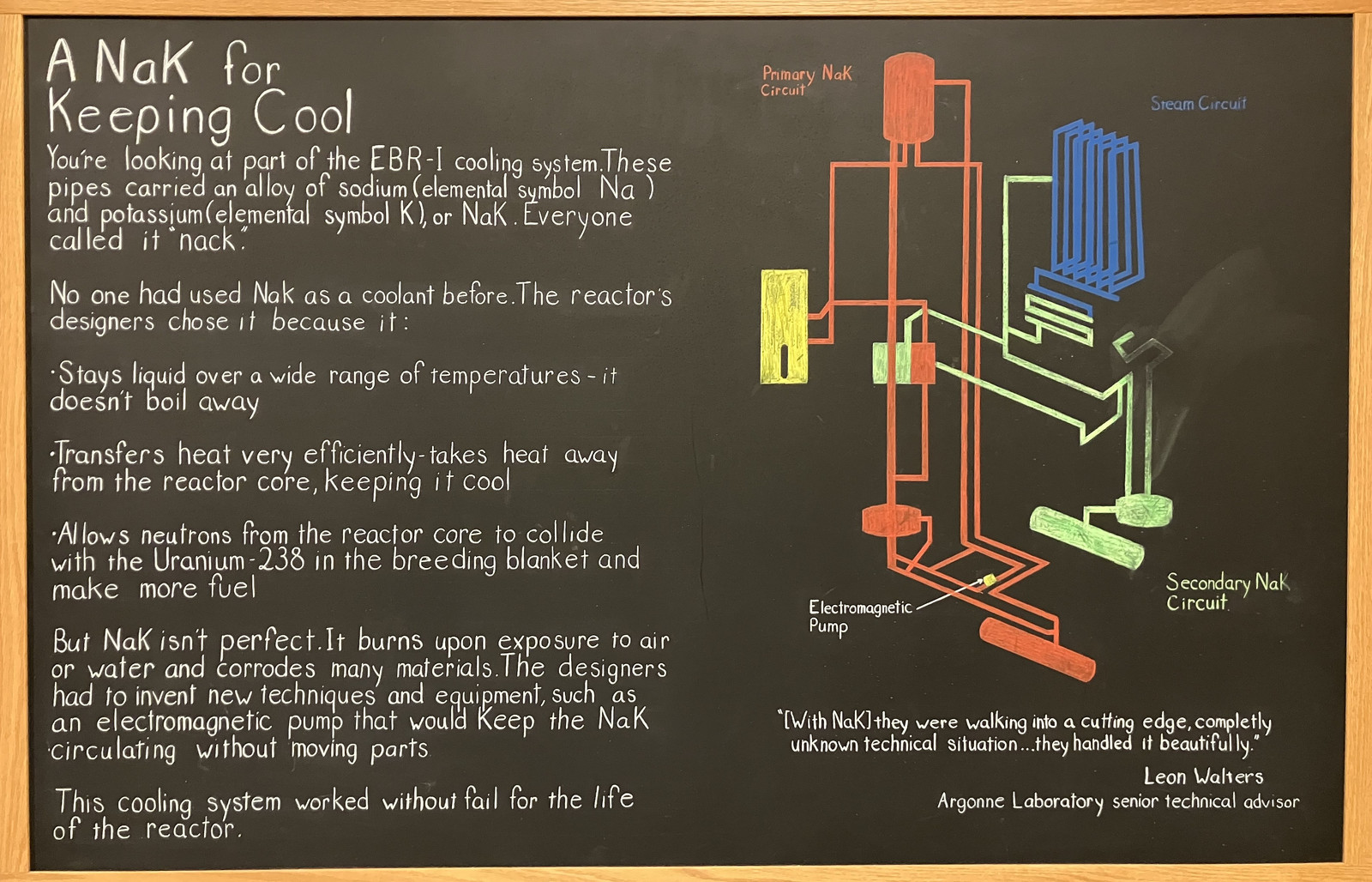
While some argue that EBR-I wasn’t the first reactor to make electricity (seemingly correctly), it was the first to make substantial amounts of power and to run its own operation with the generated power. As much as we consider “meltdowns” in the context of nuclear reactors a bad thing (and they are), they were pretty much just part of early experimental reactor designs, working out the sharp edges of a yet unknown physics. Failure, with zero consequences to people, and lessons learned, are good things - we see SpaceX attempting that sort of iteration on rockets with some impressive results, and some impressive slow motion videos.
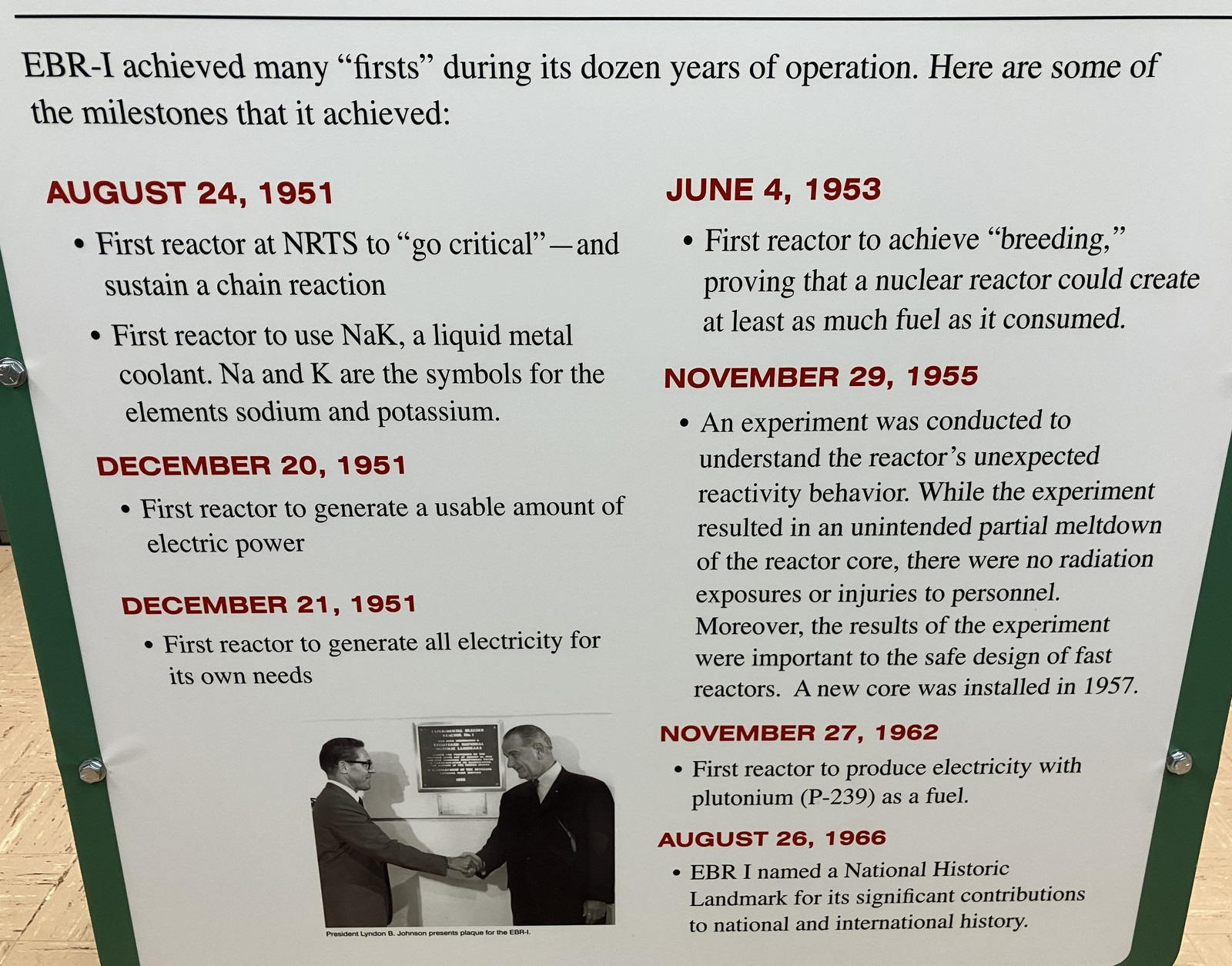
While it’s lit constantly now, this neon sign on the wall was hooked to the generator output such that it was lit up when the facility was generating power. I do like neon, and if you’re ever in The Dalles, OR, the National Neon Sign Museum is worth a visit.
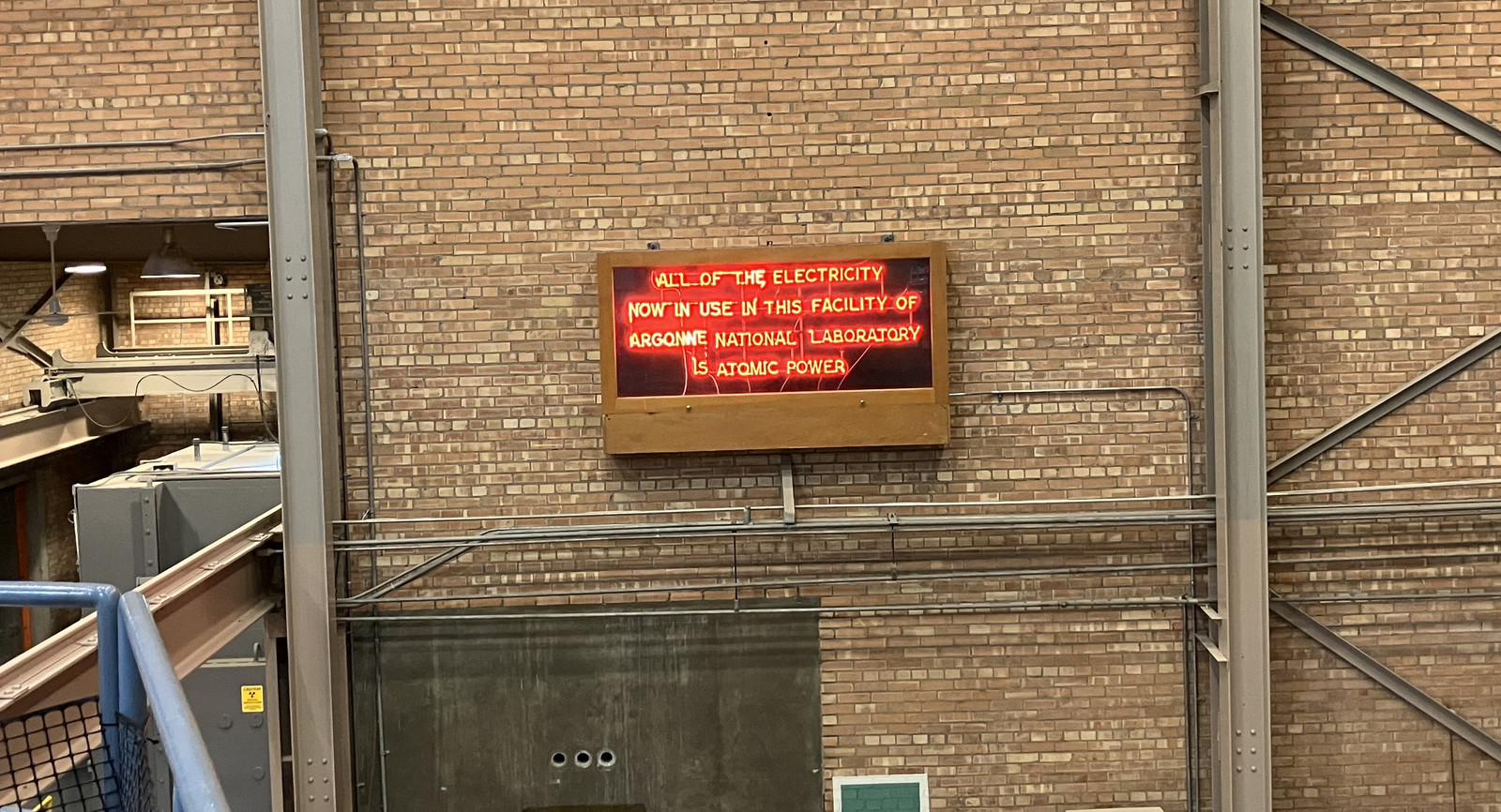
The Control Room
If you’ve played Portal 2, Half Life, or a range of any other games set in this sort of environment, the control room should look very familiar. Lots of large gauges, lots of chunky buttons and indicators scattered around. The plant was typically run (per a book they had) by two operators, and they ran it on a 9-5 sort of basis - they simply shut everything down at night, and started it back up the next morning. It wasn’t a 24/7 sort of operation - perks of being “experimental!”
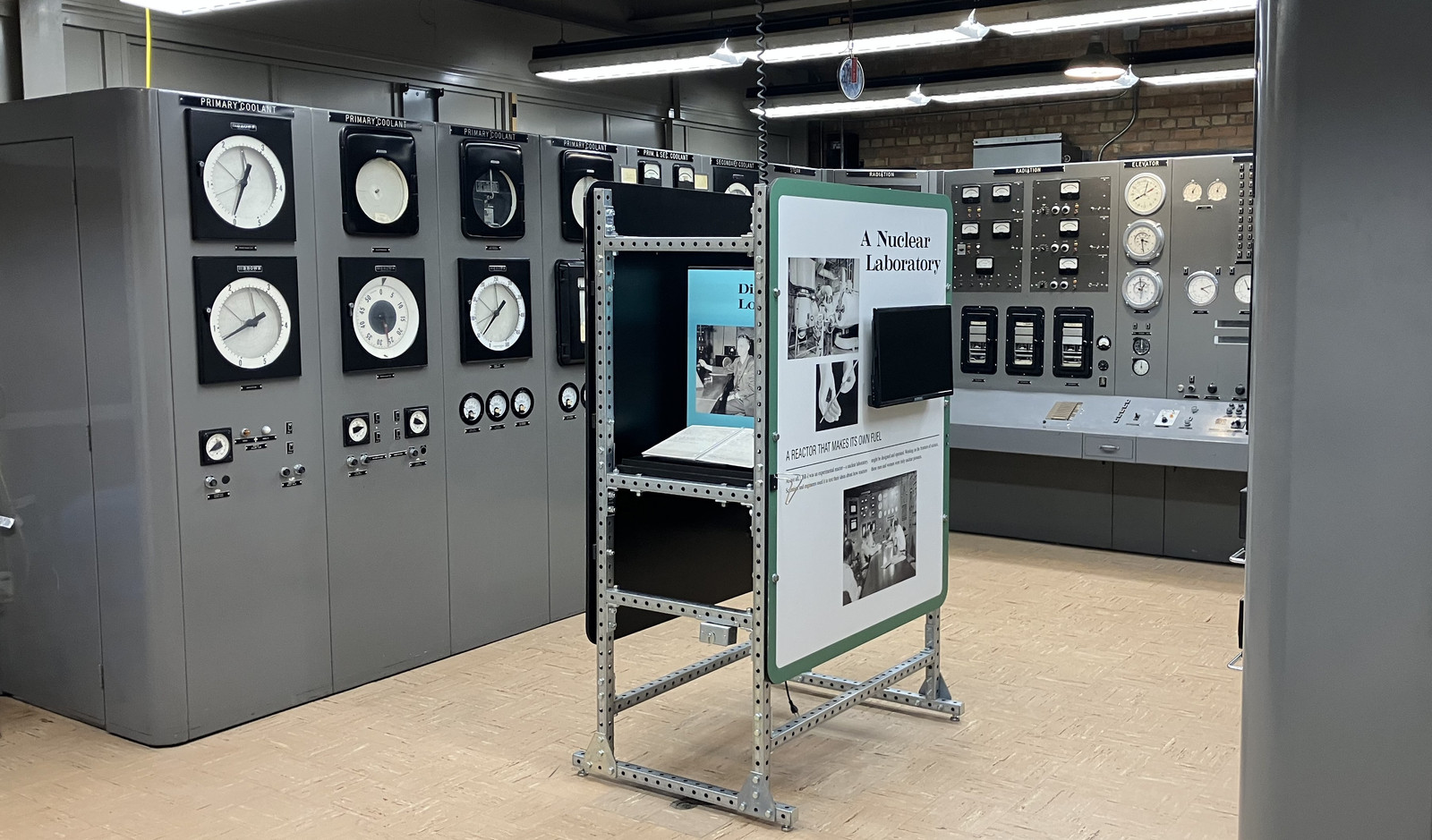
Most of the consoles look largely like this. Switches, indicator lights, gauges, sometimes larger control wheels or knobs. I would, at some point, love to see what’s inside them as far as wiring goes. I expect it’s standard 1950s, “You don’t need the schematic, the wiring is tidier and clearer than the schematic would be.”
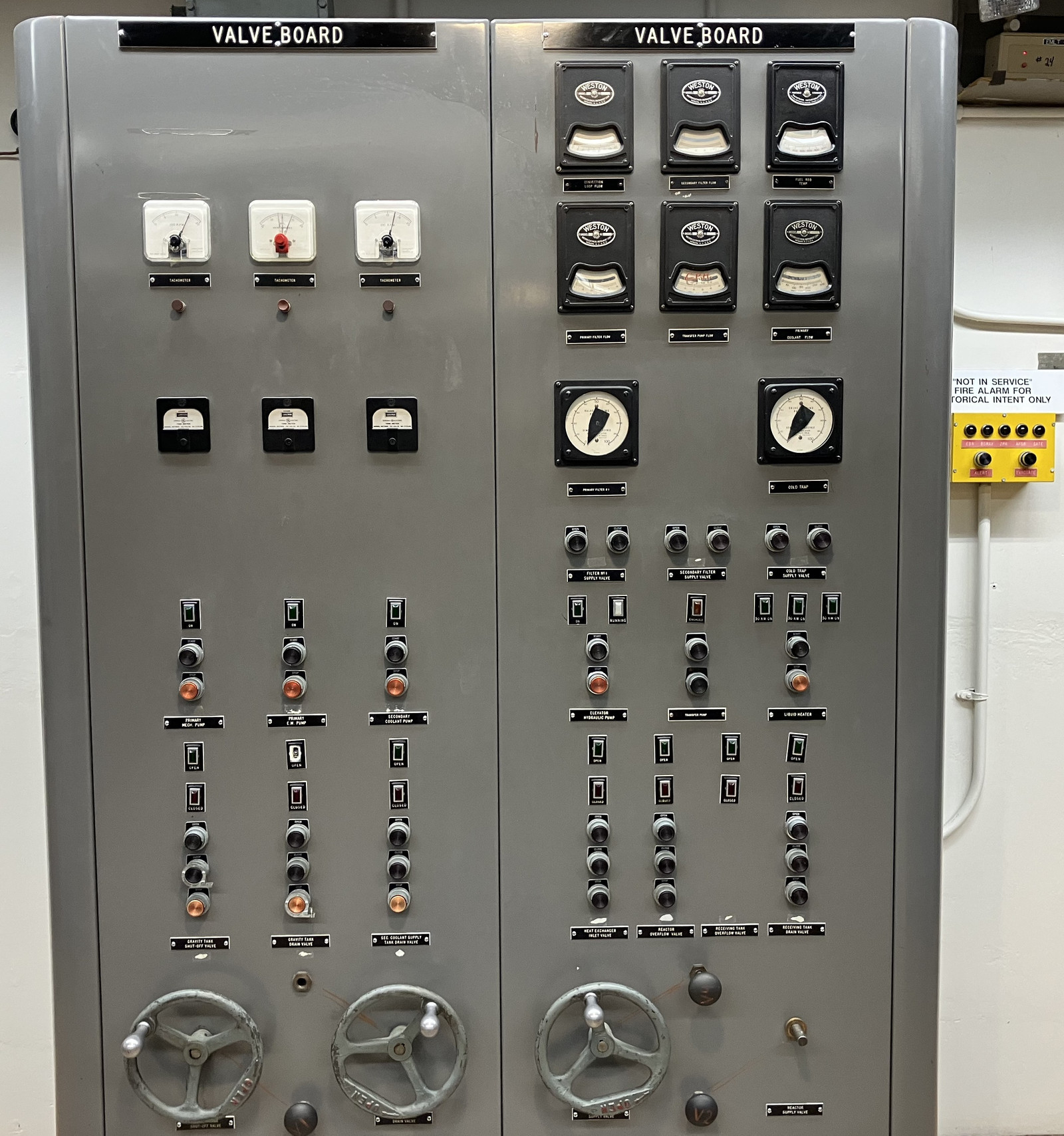
Being the 1950s, just about everything was manually controlled. I have no idea how much “running around the room pushing buttons” was involved in operating the reactor, but I imagine there was a decent enough process to follow for common operations.
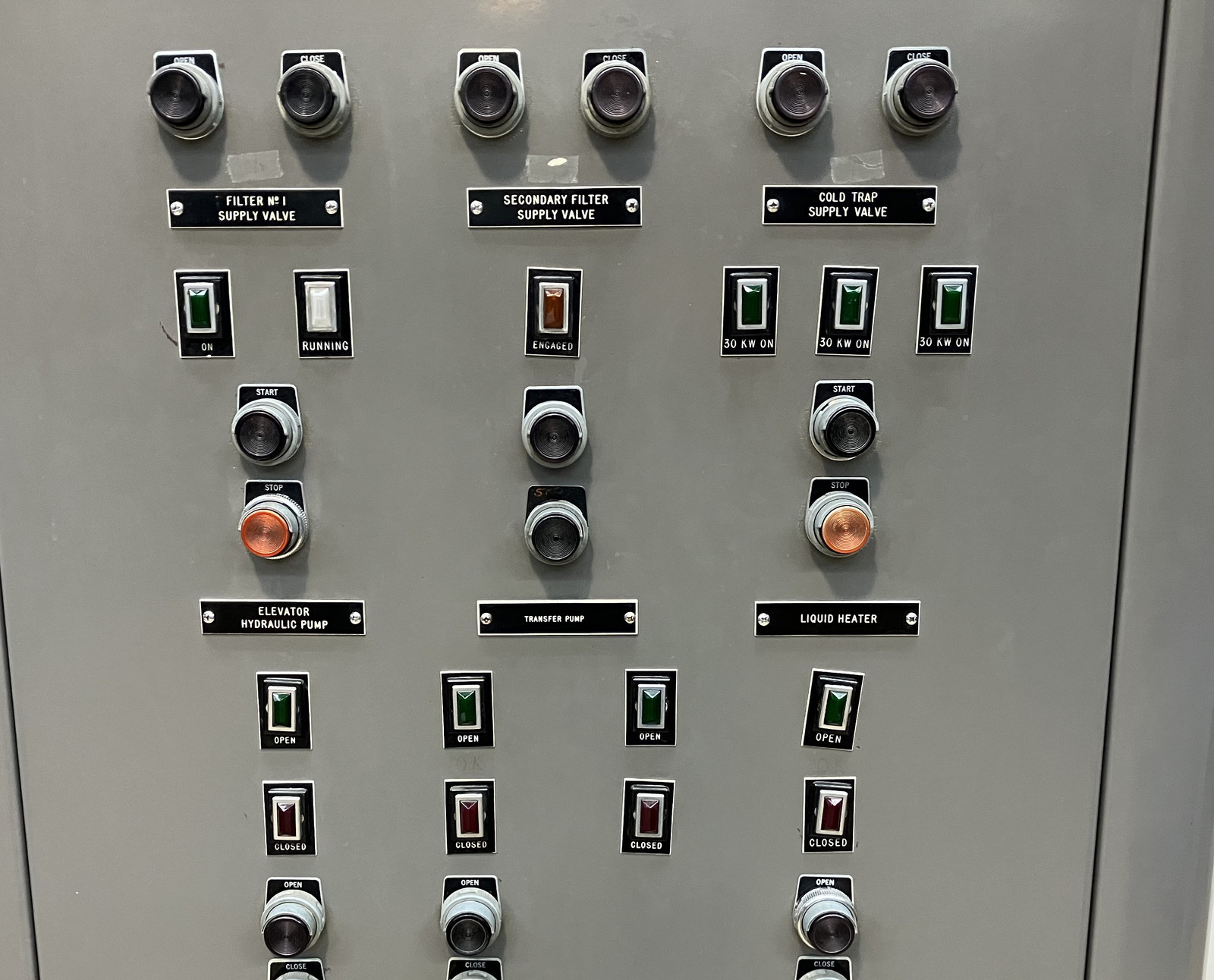
I believe, by the names of the lights, this is a “site wide alarm” system. EBR would refer to the EBR-I. BORAX refers to another set of reactors installed at the NRTS. ZPR, which I talk about briefly later, was a “Zero Power Reactor” in another building. AFSR would be the Argonne Fast Source Reactor. And “Gate” would be the guard gate.
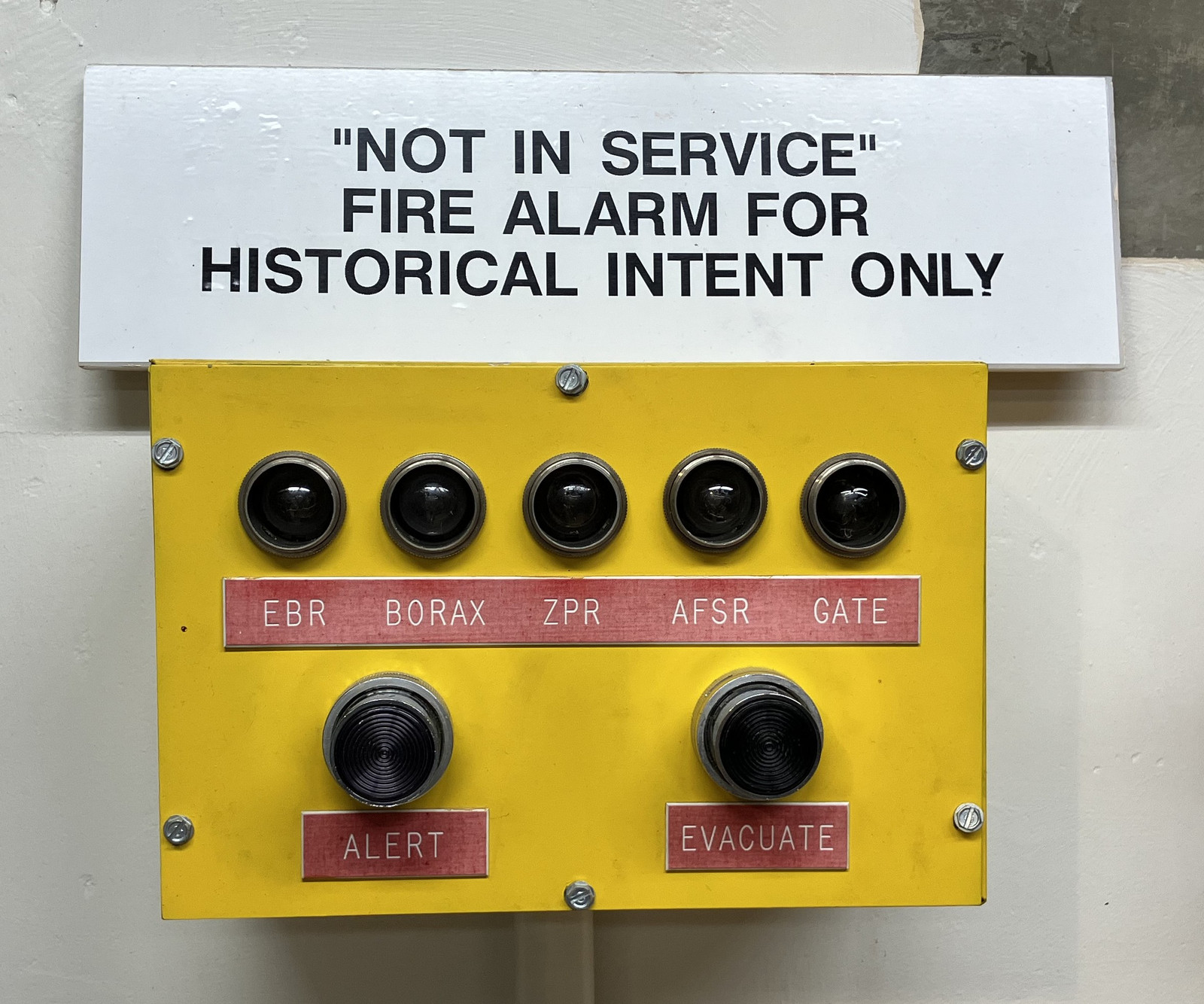
The control room has a range of plotters to log various parameters over time. I enjoy that this one is 6 orders of magnitude, though it wasn’t clear what exactly it was logging - probably output power.
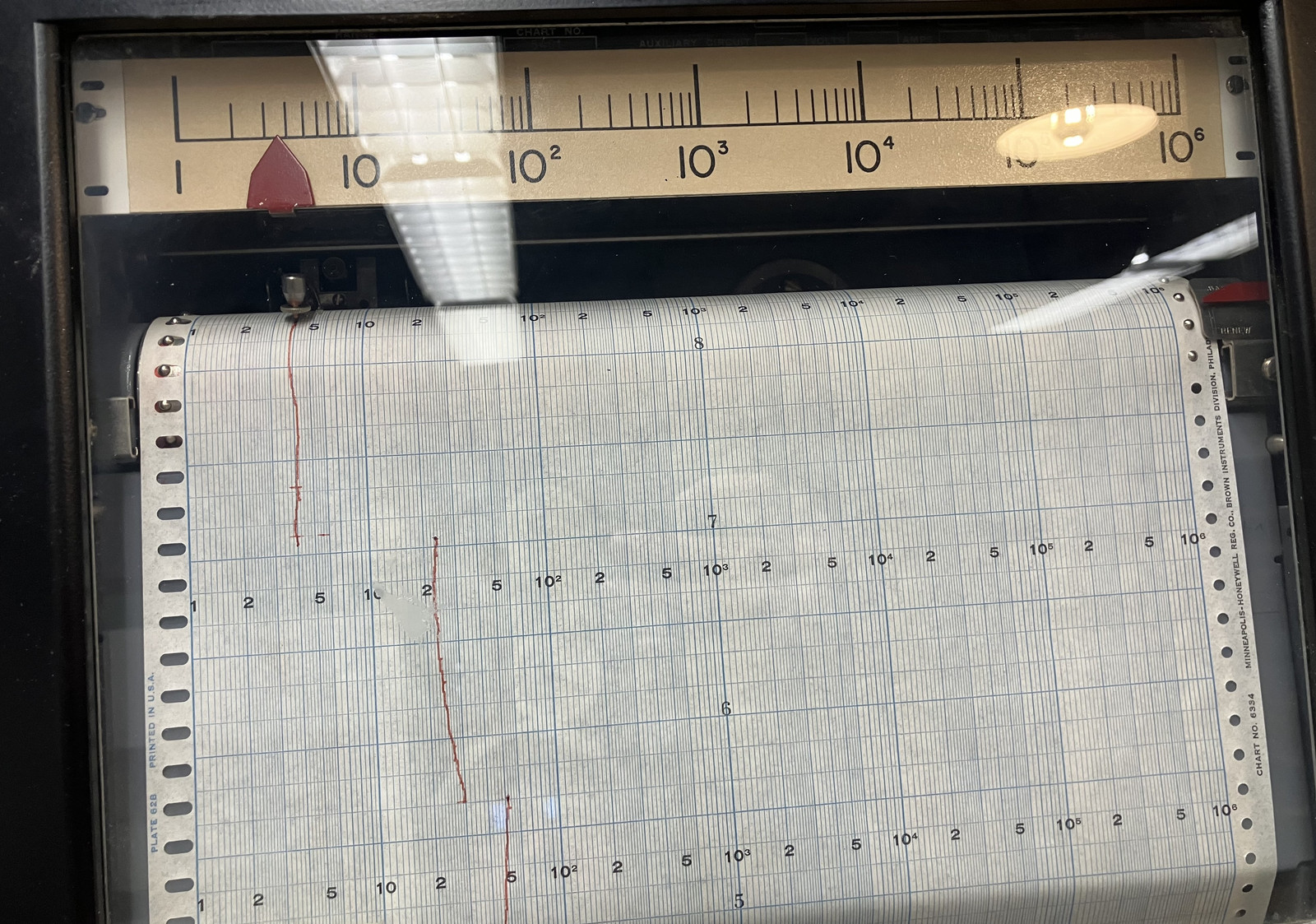
This particular panel is monitoring the radiation levels of exhaust air, based on the labels. It’s a very reasonable way to monitor for radiation leaks in a facility. If the air going out is clicking your detectors, you’ve probably got a problem. It appears that the limits can be set, and the red lights will glow if the level is exceeded. The smoke detector having its own monitoring probably indicates a sort of aspirating smoke detector system that pulls air from a range of places and looks for smoke in the collected air samples. This was common for quite a while before individual detectors got cheap enough to scatter around facilities.
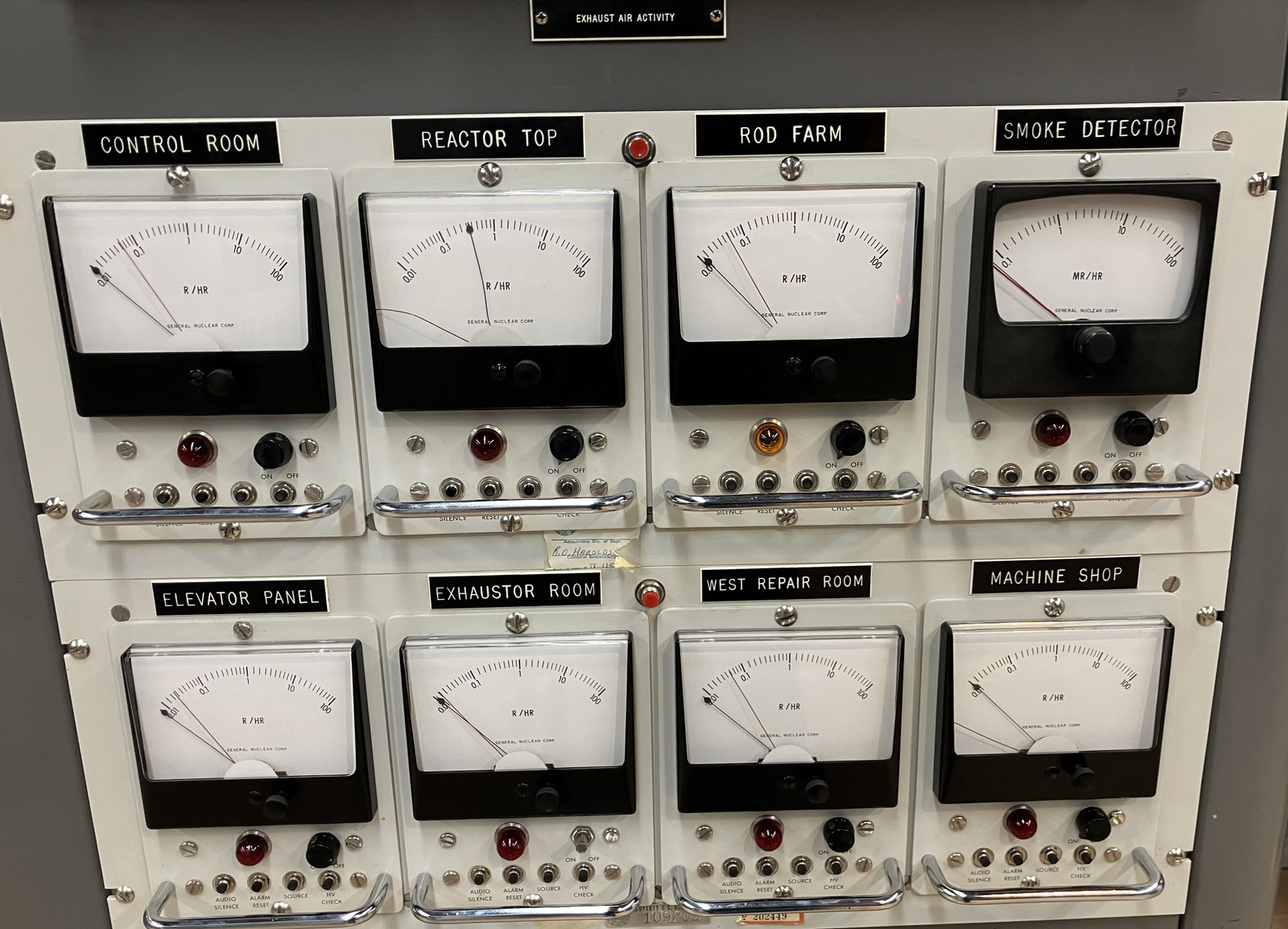
We need more gauges like this in modern life. This panel monitors the electrical behavior of various feeds, though they weren’t labeled. The synchroscope in the center is a clue, though. This sort of device indicates the phase and frequency difference between two power systems, and is needed if you intend to connect two systems together - such as connecting a steam turbine generator to an existing power grid, which this reactor did quite regularly. If you connect things when they’re not at identical frequency and in phase, the smaller system will be violently forced into alignment with the larger system. For a vivid demonstration of what “connecting out of phase” looks like, Idaho National Labs did a demonstration back in 2007 - the Aurora Generator Test. They demonstrated, clearly and convincingly, that you can cause physical damage (destroying a generator) with nothing but the “cyber” realm. You really don’t want to do that, so you need a synchroscope.
Another interesting clue is that along the bottom, the kW max of the gauges is different. On the left, the gauge peaks at 500kW. The center stack peaks at 800kW, and the right hand stack peaks at 300kW. I know from a later inspection of the generator that it’s a 300kW (375kVA - yes, power factor matters!) unit. My guess is that the left side indicates the parameters from the reactor’s generator, the far right is the external grid connection, and the center stack is the “combined plant use,” or something of that sort (since it could, if wired suitably, be pulling ~300kW from the grid and ~400kW from the generator). I don’t see how this would indicate if you’re net exporting, which EBR-I certainly did, but if you’re generating 300kW and only using 50kW, it’s reasonable enough to expect you’re exporting 250kW (and the right hand consumption gauge would probably be zeroed - or if it’s symmetrical, it might show 250kW - hard to say without talking to someone who ran the plant).
That said, it’s also entirely possible that the grid is on the left, and the turbine is on the far right. Either way would work, though I wouldn’t expect a 300kW gauge for a generator nominally capable of 300kW, since you’d have a hard time seeing any overload.
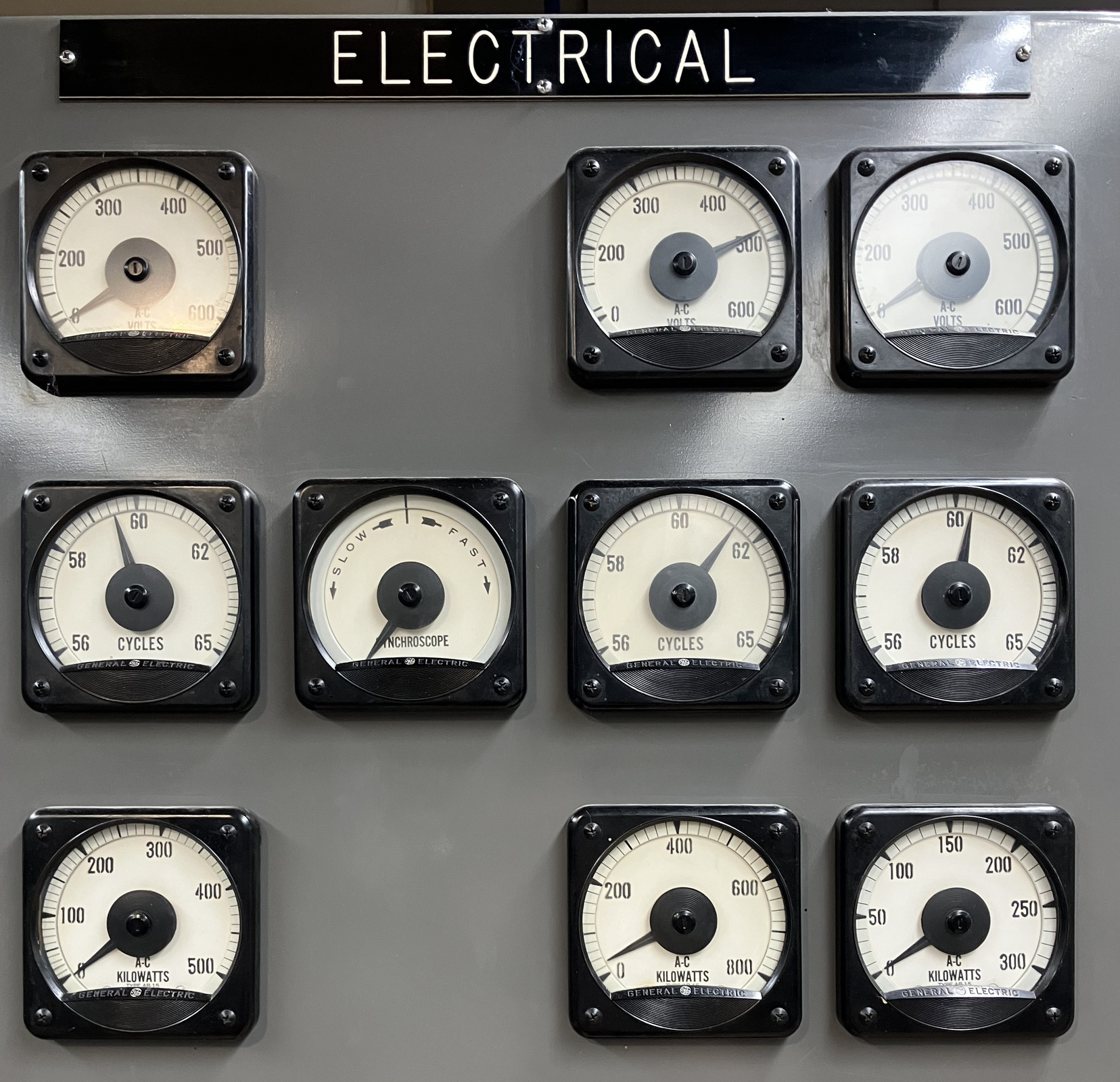
For loading up the generator without exporting to the grid, EBR-I has a load dissipator, though I’d use the term “load bank.” This is just a big set of fan cooled resistors somewhere that can dump generated power. Instead of having one indicator for every probe, they have a rotary switch in the center that connects the single gauge to each of the assorted measurement points for intake and exhaust temperature. The bottom switch appears to toggle the load bank between the turbo-generator bus and the external bus, if you want to test the load bank on grid power.
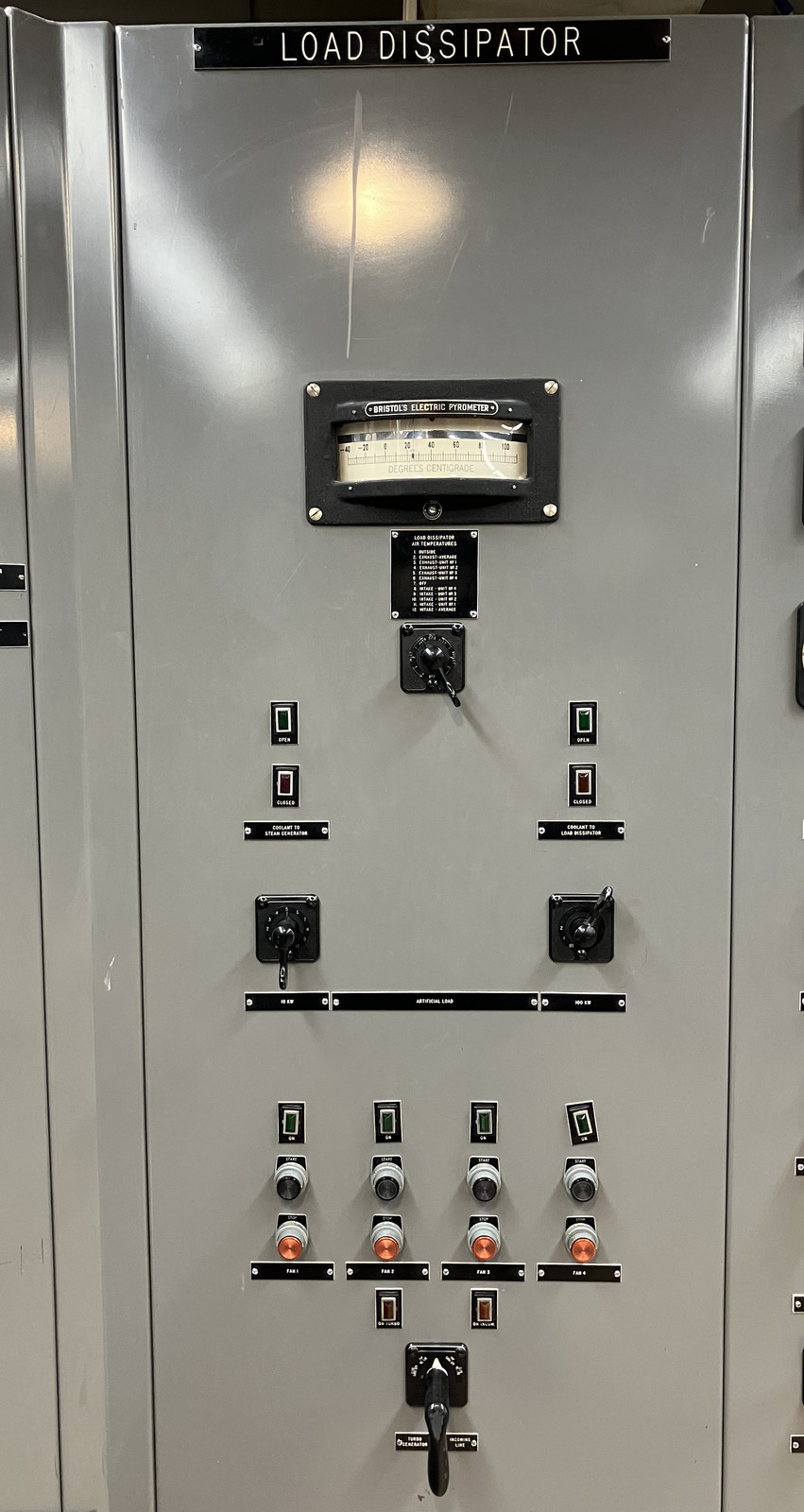
And, finally, how much load would you like? This is a nice little dial-a-yield bank in 10kW increments, from 0-300kW. With the turbine and generator spinning right outside the control room, I bet these switches can make an awful lot of noise when handled!
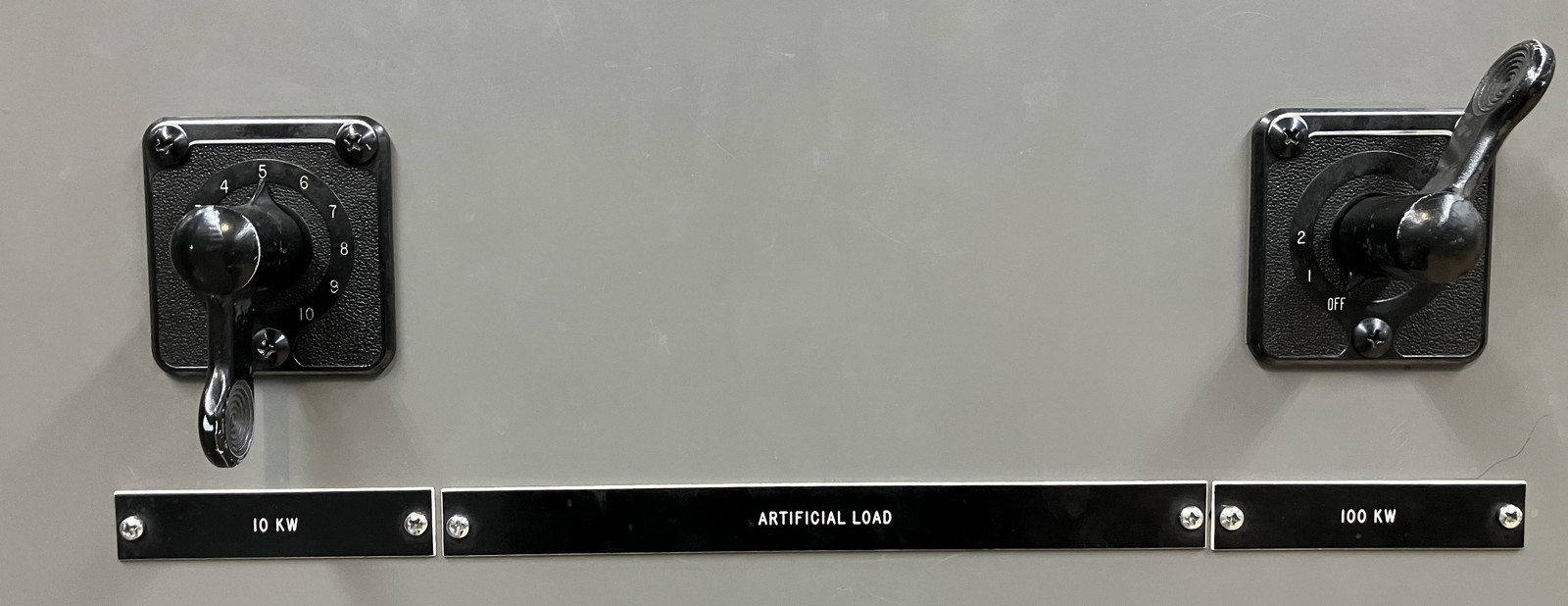
I’ve no particular reason to expect the time meter has been messed with, so 11261 is probably the correct number of hours on the reactor. EBR-I was in operation for around 12 years, so this works out to about 940 hours a year. Given that the plant ran 8 hour days, and there are about 2000 hours of “typical working hours” in a year, this passes the sniff test - it was certainly down for maintenance, upgrades, tests, repairs, etc, though was also a fairly reliable plant. It didn’t operate at all from late 1955 to 1957 after the core suffered a partial meltdown. But I’m inclined to take this gauge at face value and say that EBR-I, in its years of operation, had 11261 (almost 11262!) hours of reactor run time.
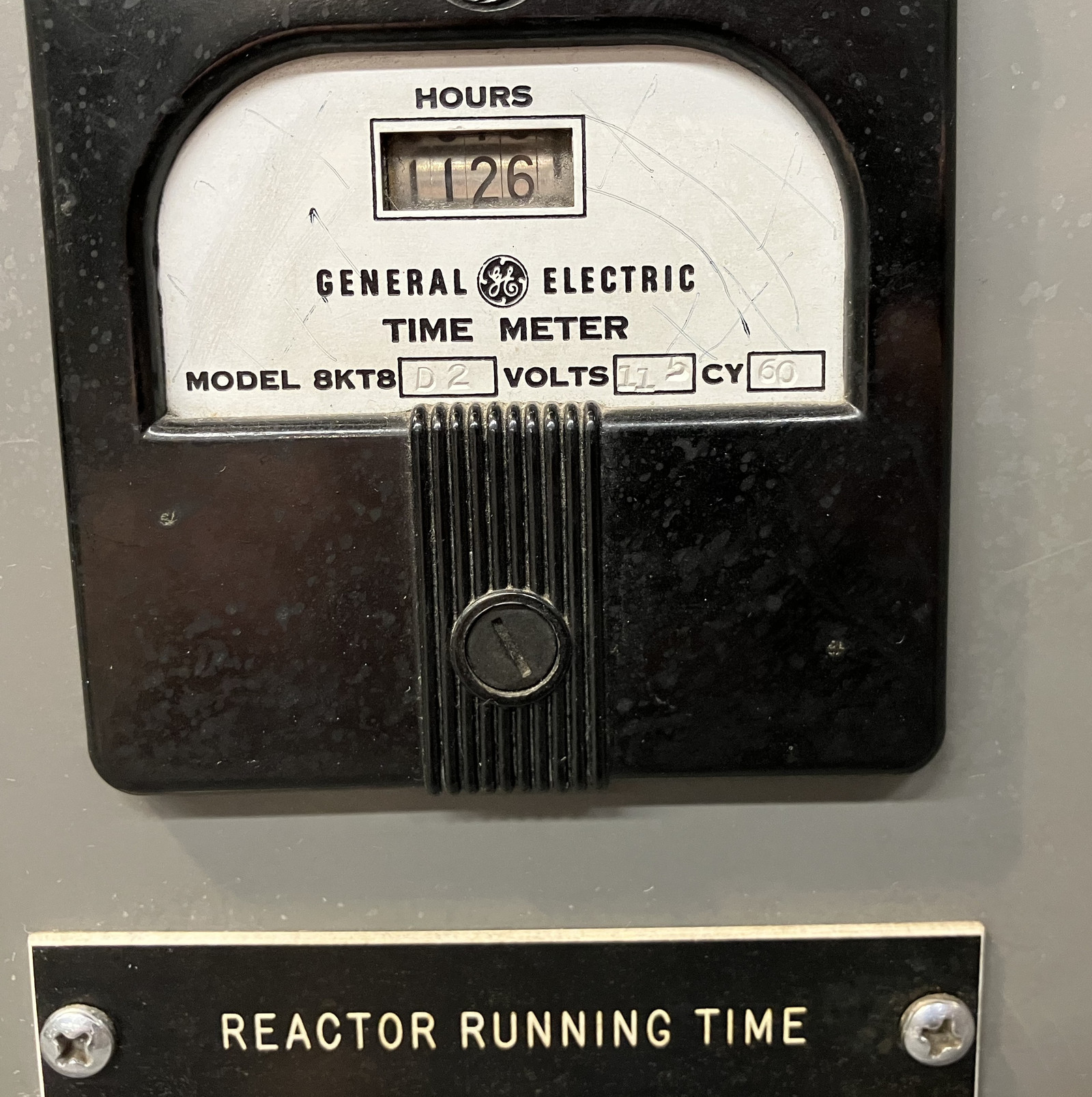
Finally, this panel shows the “control rod status” of the reactor. The lights indicate the position of the external safety rods, the lower “clocks” indicate the control rod positions, and the upper gauges indicate the “jack position” - which may be related to the outer breeding blanket position - I’m not actually sure.
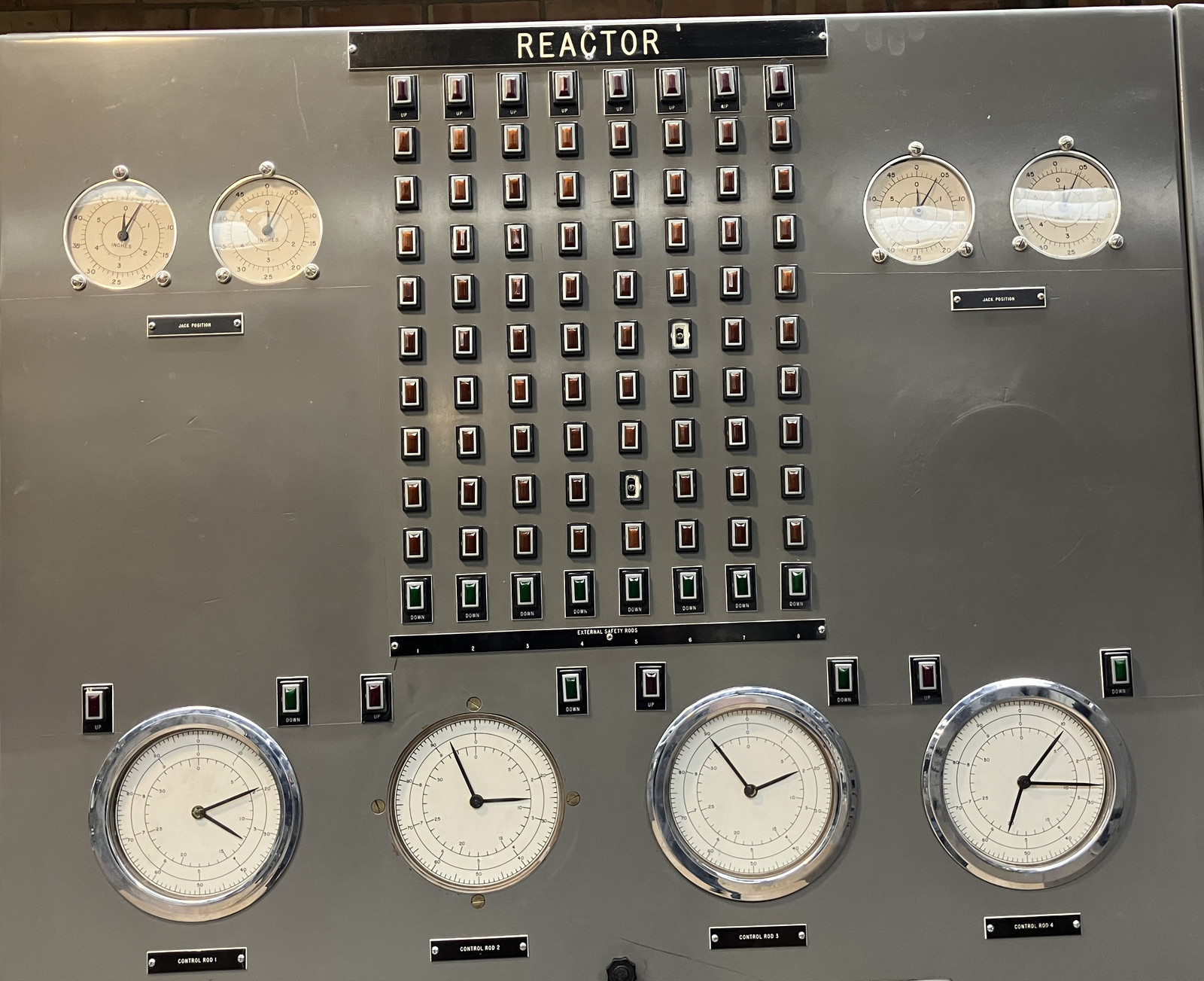
Oh, and, of course, the Big Red Button: The SCRAM control. This, when pressed, would very rapidly lower the external breeding blanket that served as a neutron reflector (I’ll talk about this a bit more below), and shut down the reactor. Yes, it’s a satisfying button to press!
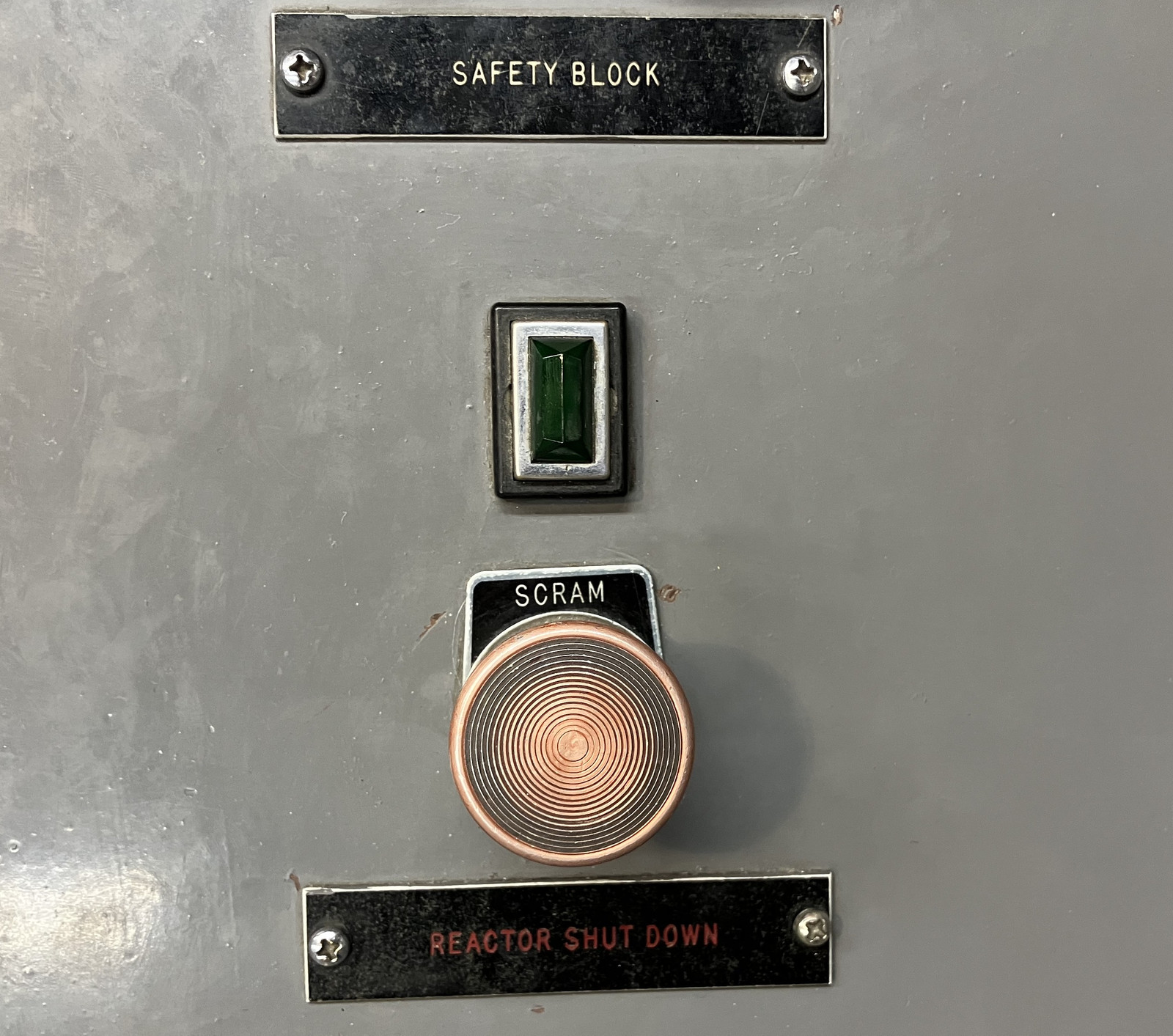
I’m not sure if I believe the commonly told story about the origins of the SCRAM label, but it’s certainly a frequently told story! I lean a bit more towards “Hit the button and get out of there” as origins, but… you’ll hear the story on just about any nuclear tour. Wikipedia has some useful history on the term.
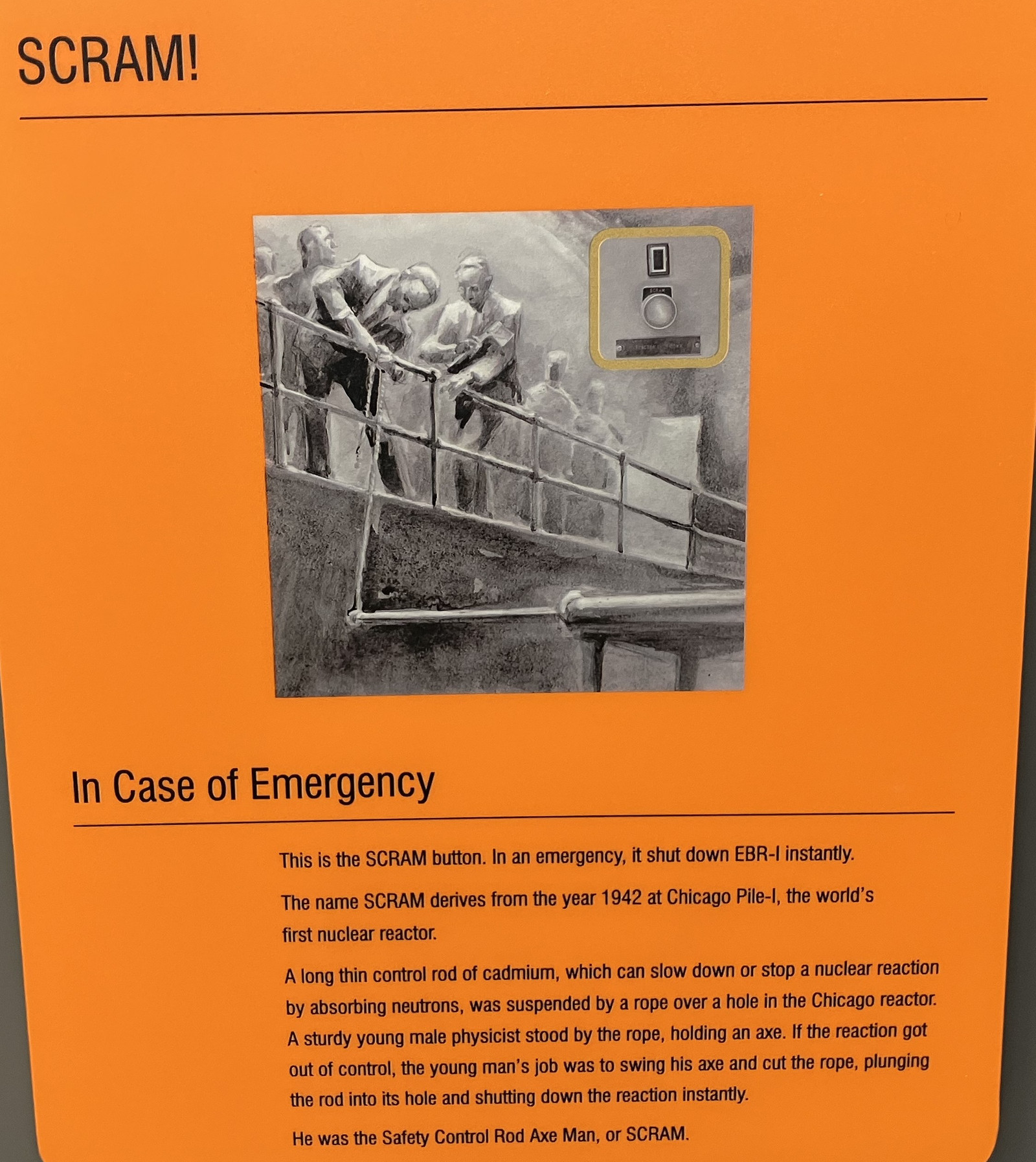
The Reactor Vessel
Where else can you go to stand on the lid of a nuclear reactor? In operation, the center had a lead plug in it, but they’ve replaced it with some layers of plexiglass (or lead glass… something mostly clear!) so you can see down to the top of the actual reactor. This area has some displays of fuel rods and the breeding blanket as well. If it looks like there isn’t a massive pile of bolts securing the lid down, remember that a liquid metal reactor isn’t a pressurized water reactor - the coolant doesn’t operate under pressure, so you don’t have hundreds of psi to hold back. The lid shouldn’t go anywhere, but you’re not maintaining high pressure water in liquid form.
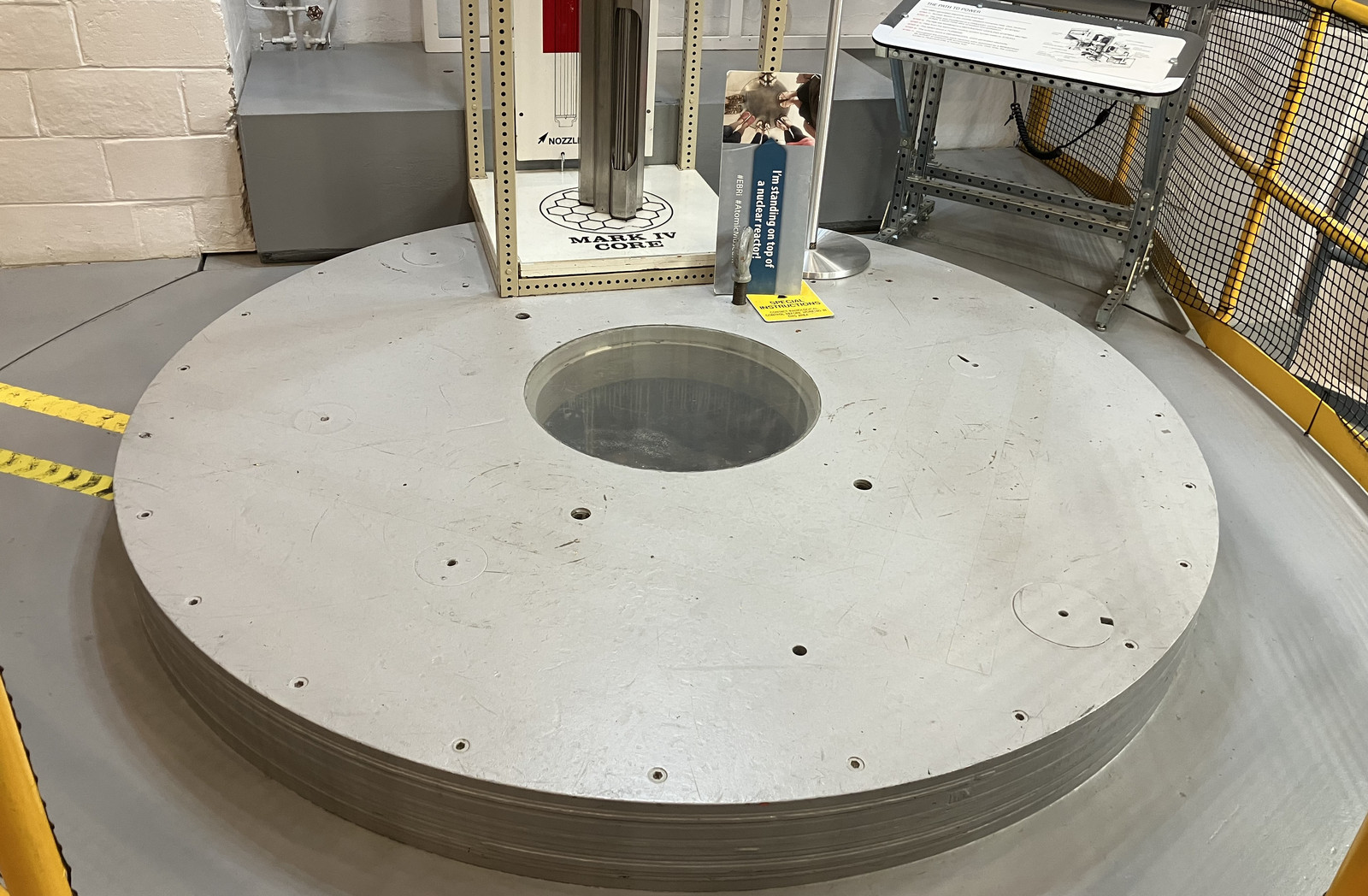
Reactor bits! There’s not a great explanation of what exactly you’re seeing down there, though.
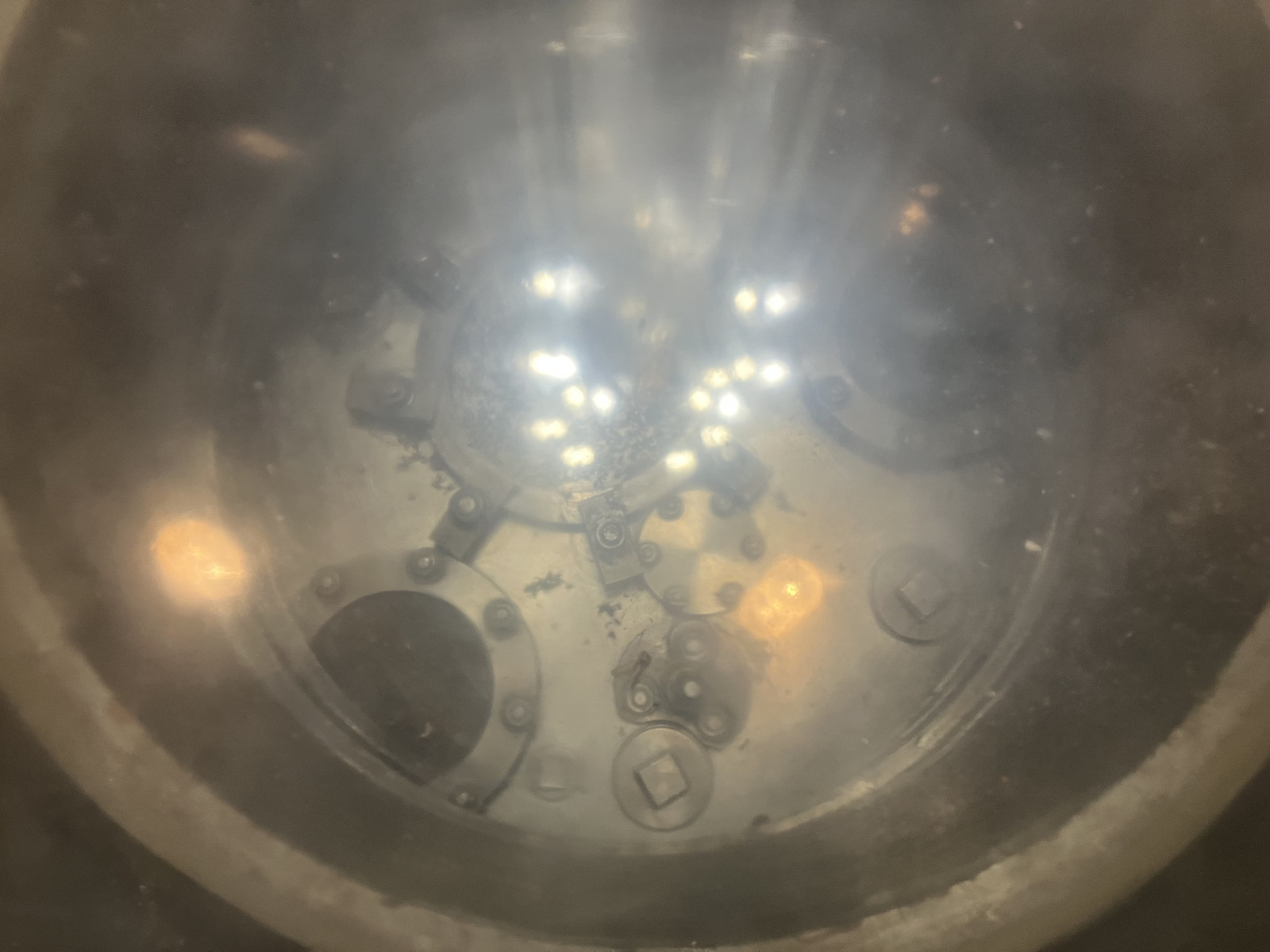
A full scale cluster of fuel rods is sitting around too, with a helpful guide behind them. They’re quite tall, despite not containing much in the way of “actual fuel.” Being familiar with coal piles outside power plants, the tiny amount of fuel that nuclear reactors use is just amazing.
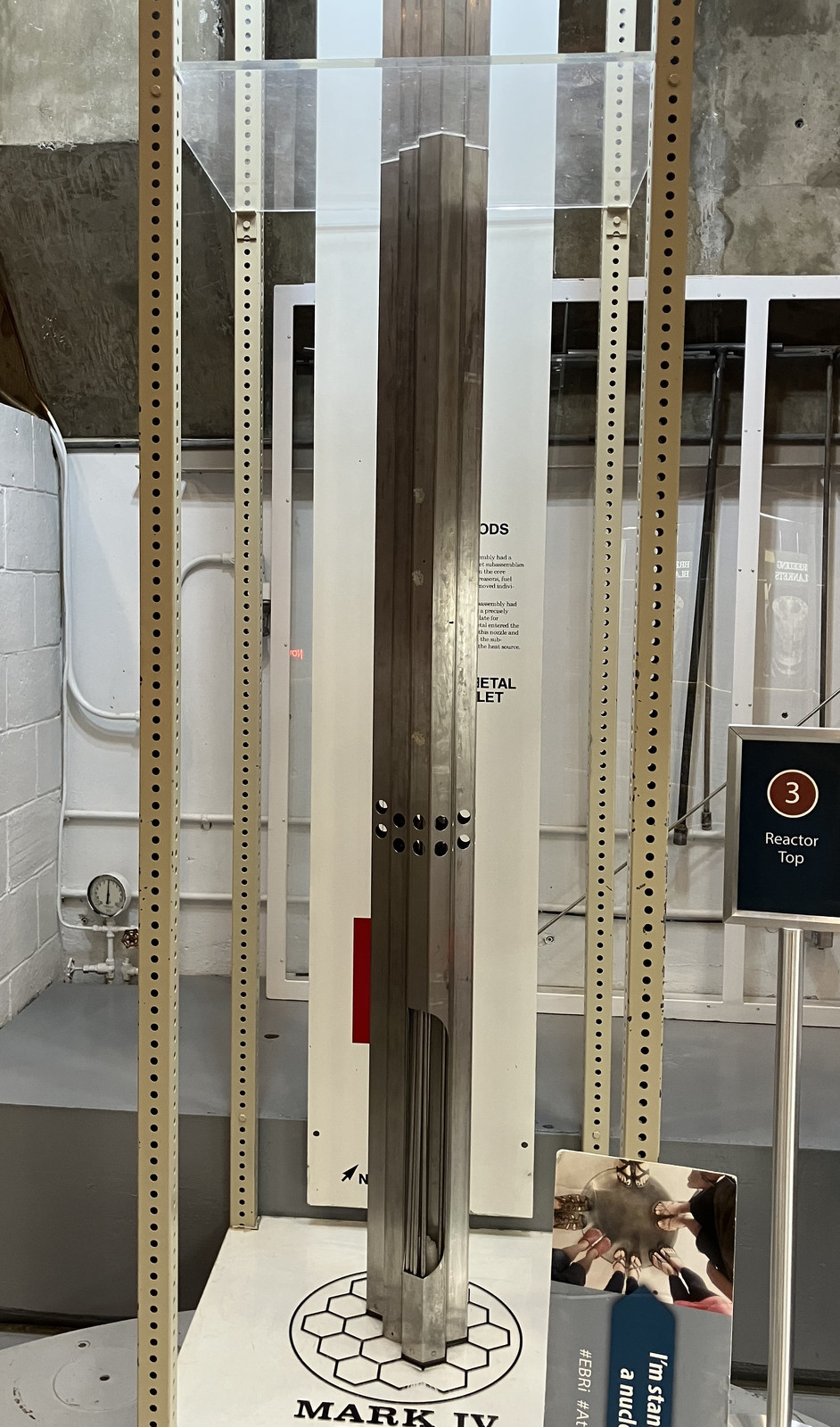
Liquid metal flows in the bottom, gets really hot over the fuel elements, and out the holes to travel to the heat exchangers.
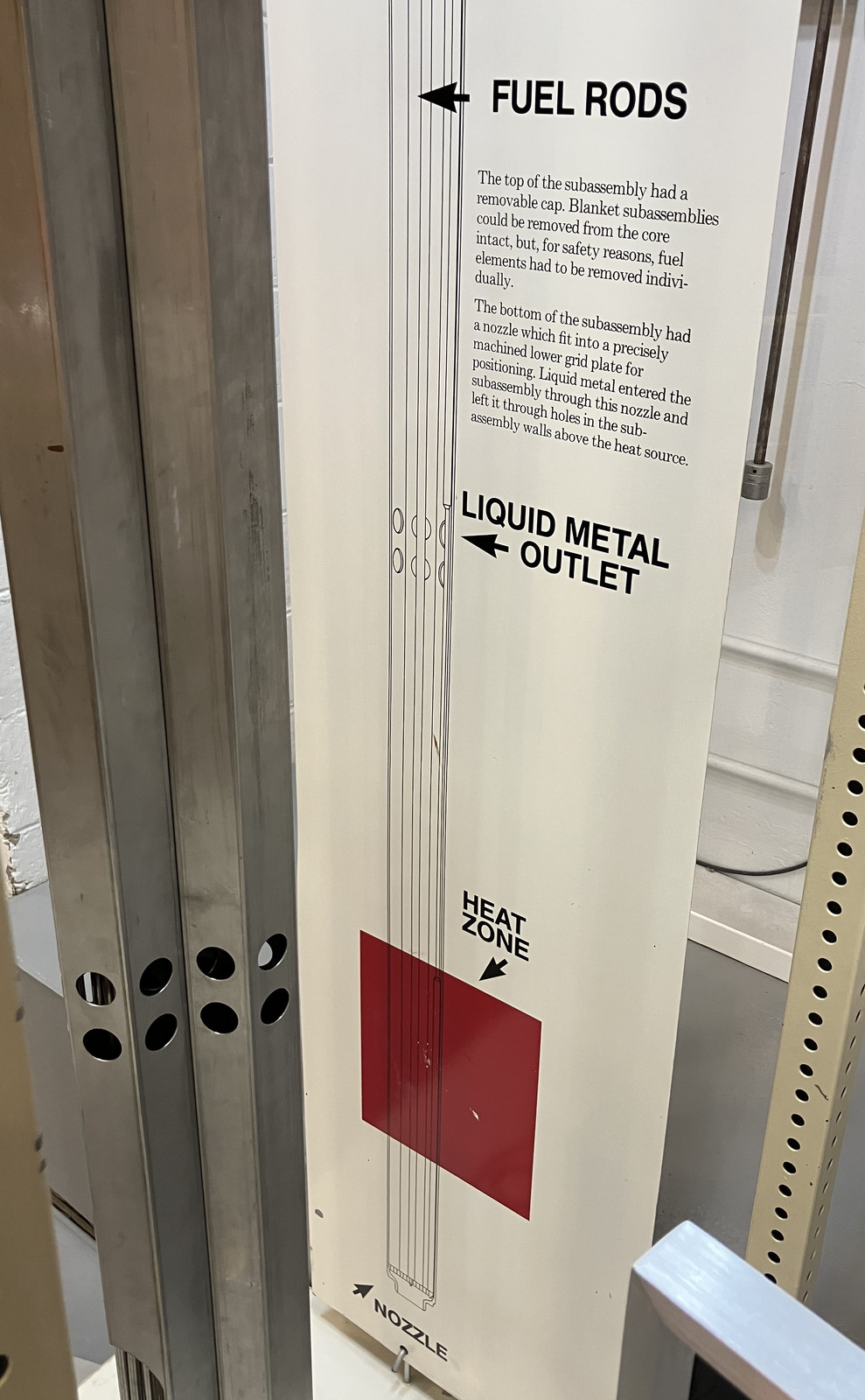
The reactor core layout is based around the concept of breeding fuel. The inner core of 7 hexagonal clusters contains the radioactive fuel being used (originally uranium, later plutonium). Surrounding this is another 12 clusters of the fuel being bred - U-238, well positioned to catch unused neutrons. Finally, wrapped around this entire core assembly is the “breeding blanket.”
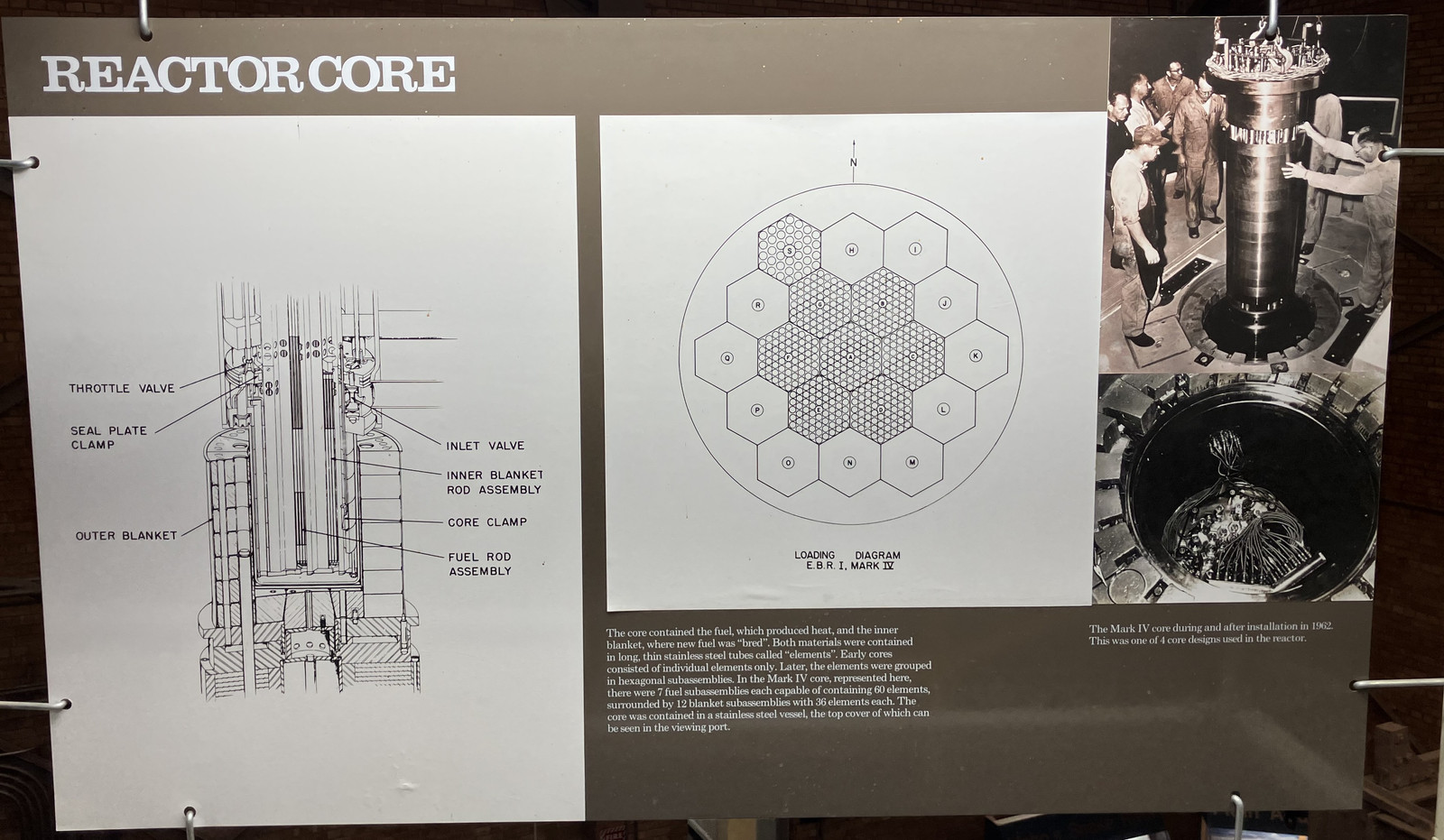
The breeding blanket is a thick metal shell of U-238 that serves two purposes: Reflecting neutrons back into the core to keep the reaction going, and capturing some of the extra neutrons that escaped the core. This blanket was installed on an elevator, and served as the main on/off switch for the core. When this was lifted into position around the core, it could be brought into a critical configuration and start operating. When it dropped away, the lack of reflection meant that too many neutrons leaked out to be able to sustain a chain reaction. The SCRAM button drops this blanket very quickly (in about a second), which I imagine is hard to miss no matter where you are in the building. Keep this assembly in mind - there are rooms in the basement that are used to replace the individual elements if they’re damaged, or for reprocessing (separating the remaining U-238 from any generated plutonium).
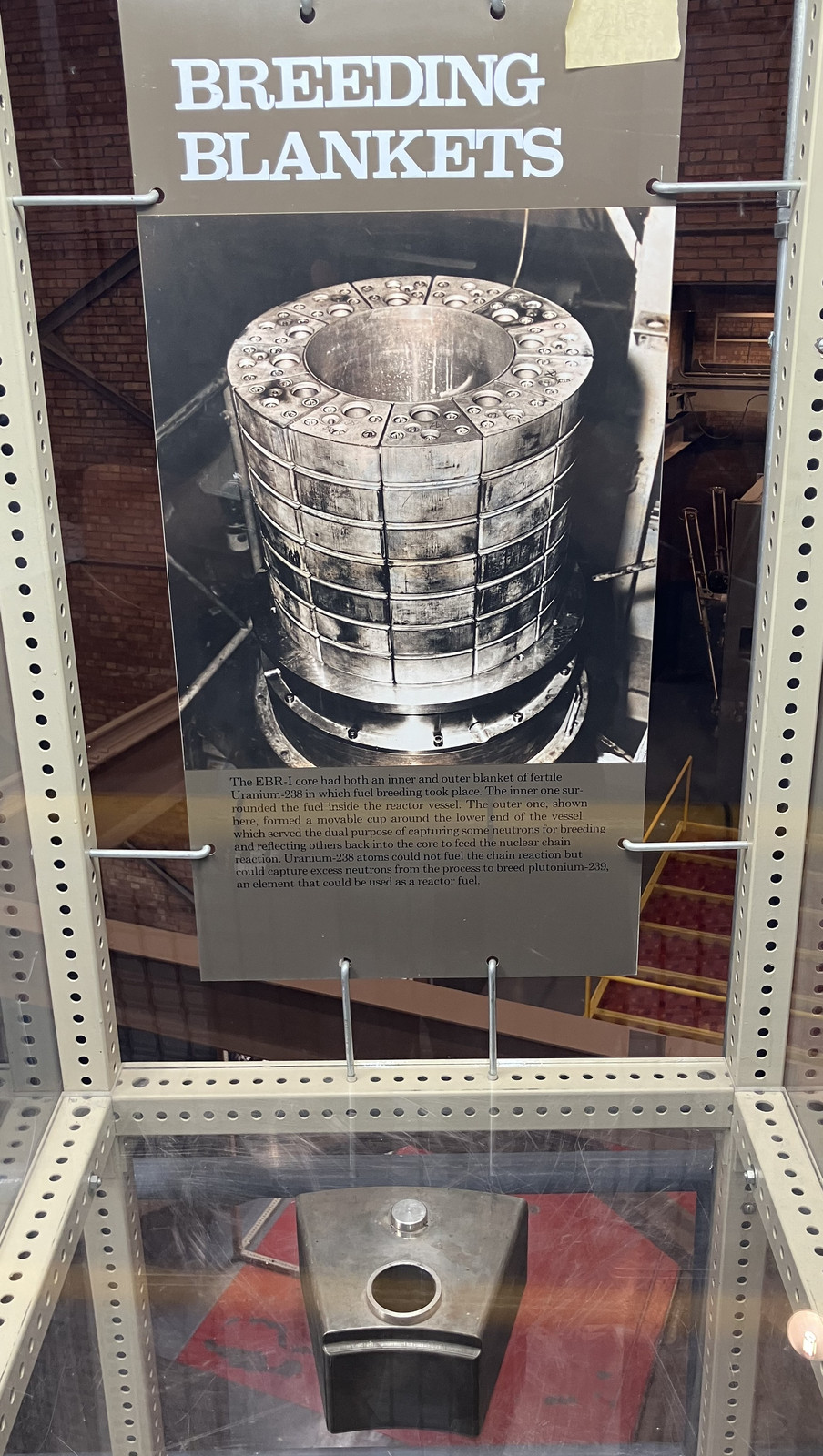
The Turbo-Generator
Outside the control room, on the second floor, is a rather cute steam turbo-generator. I’d say massive, but… really, it’s not that large. This is a 375kVA unit, which just isn’t that big as far as generators go. it works out to about 500 horsepower. On the far end, you can see a string of four light bulbs, as EBR-I is rather famous for. Why four bulbs? The generator puts out 480VAC - and so, 4 120V bulbs in series works happily on 480V!
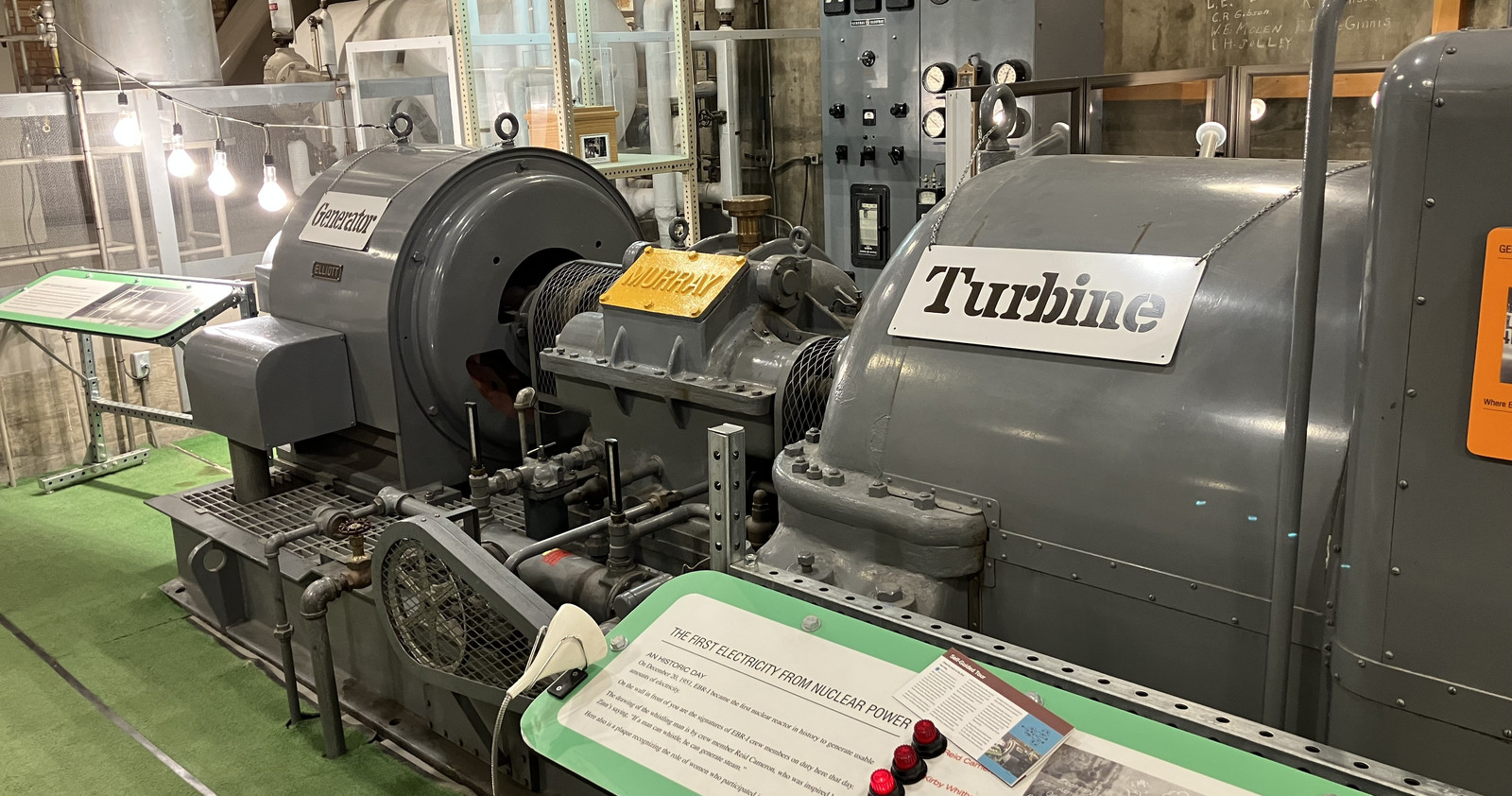
Yes, the 200W bulbs they’re burning now are incandescents! I haz a happy!

Take a look at the surface texture on the turbine’s cast end - and then go play Portal 2. Valve has done a wonderful job of capturing some of the nuances of 1950s tech in their levels, to the point that I expect some of them have toured this building. It really does feel like a Portal 2 level in some ways. The center here, between the turbine and the generator, is a large reduction gearbox. Turbines like to spin fast, generators prefer to spin rather slower, and so the problem is solved by reduction gears. It’s nice to see the couplings guarded - those are quite hazardous when spinning quickly.

The generator is a large, air cooled unit by Elliott, out of Ridgway, PA.
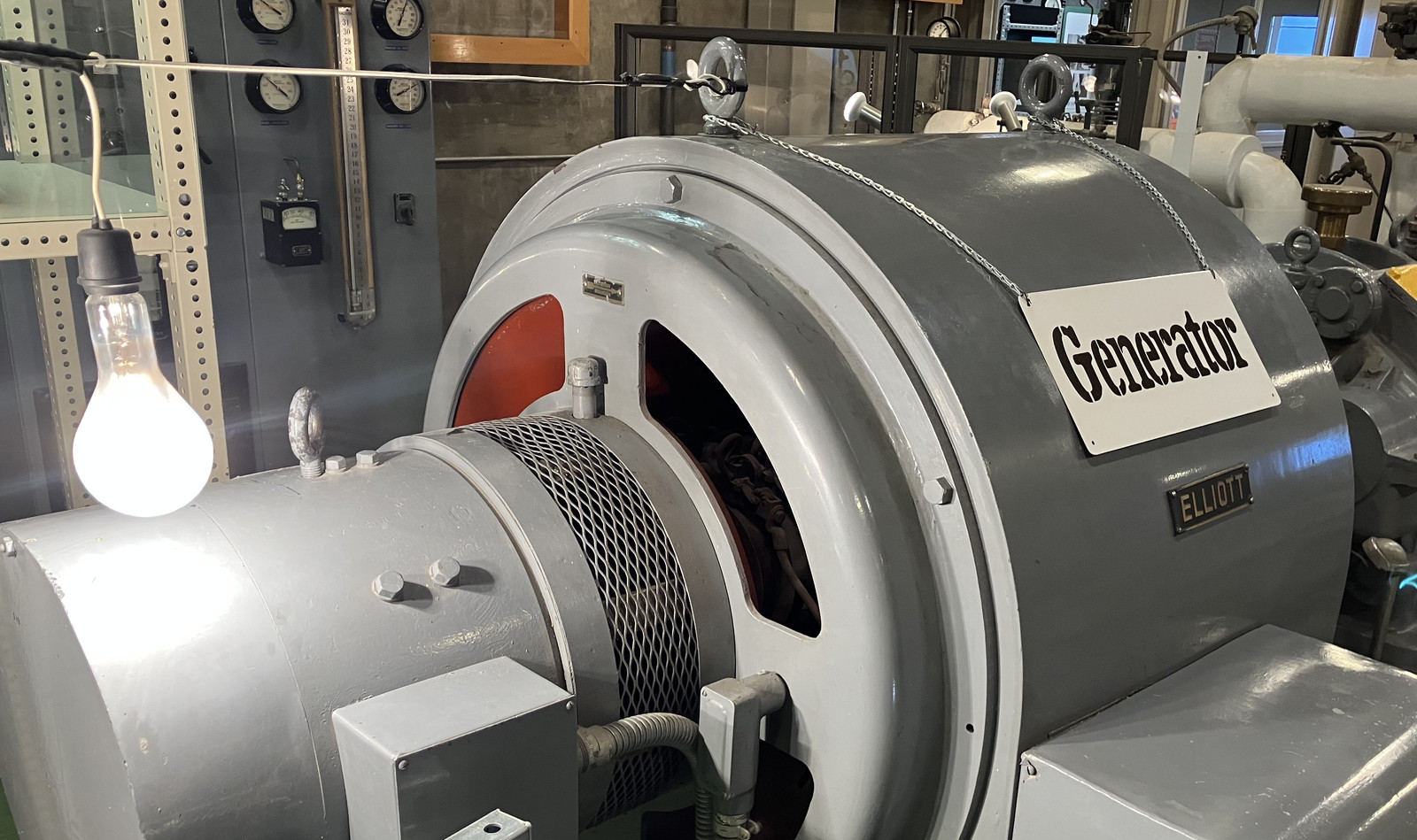
I love finding the old data tags on equipment like this. The generator is an Elliott 8375, serial number 1S8575. It’s a three phase 480V generator, and the exciter needs 25.5A at 125V to provide the field the rest of the unit works against to make power. And, it looks like you should keep the rotor temperature rise under 60C, and the stator rise under 50C. I don’t for a second believe that decimal point is anything but a random spot…
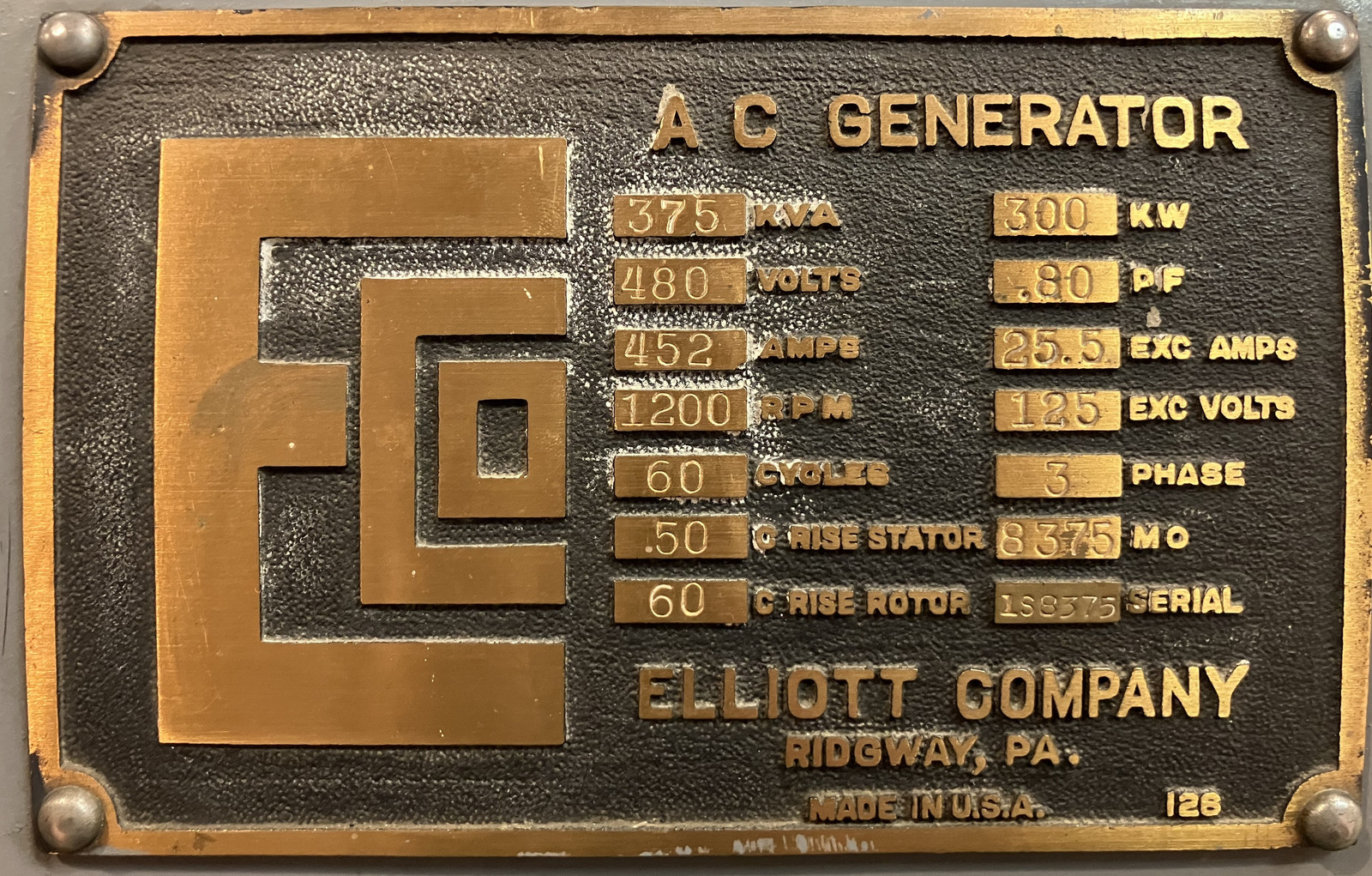
There’s a control board for the turbogenerator on the wall behind them, with just about everything you’d want to know about this setup during operation. On the left, you’ve got AC amps, AC kilowatts, and AC volts. Below that, you have power factor, DC amps (this is almost certainly for the exciter windings, based on the range), and output frequency. The rest of the controls are to connect with the grid, modify the governor settings, and generally control the electrical behavior. Plus, a pen logger for generated kW.
On the right, there’s everything relevant about your steam turbine. The tall gauge in the center is a vacuum gauge, and as steam turbines are almost always designed to exhaust into a vacuum, that will matter a lot for system performance - if the vacuum is falling, it means the condensor side of things isn’t keeping up, and you should back off. Again, this is an experimental system, not a production power plant, but they’d still want to know what was going on. I’ve no idea what the “steam seal pressure” gauge on the upper right is for, though.
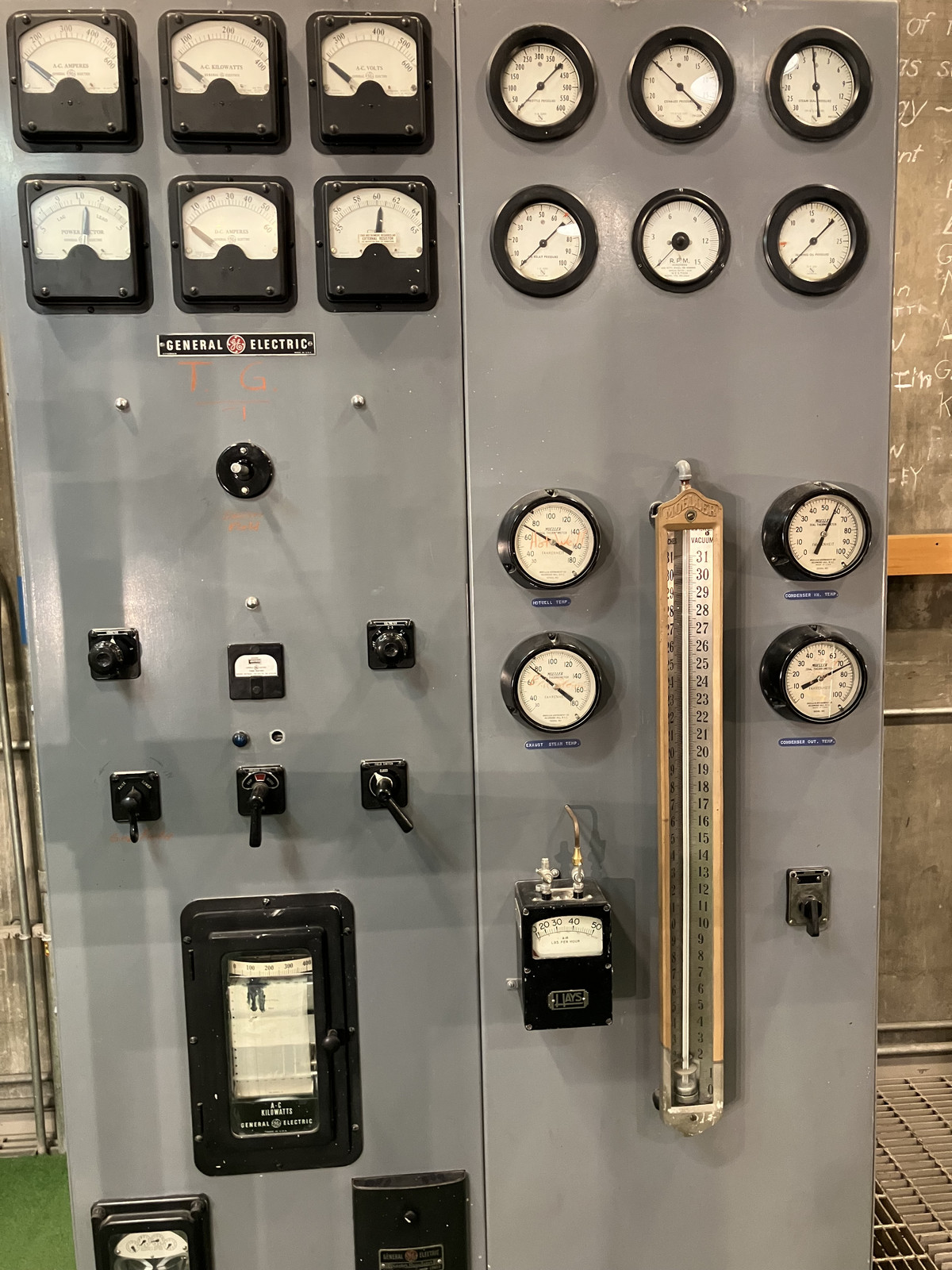
The Famous Lightbulbs
EBR-I is probably most famous for the string of four lights lit up on nuclear power (800W of load). What I didn’t know before, and what I appreciate so much about the people involved, is that they didn’t think anything of it at the time! They did the test, and then put the bulbs back in the supply closet, requiring dusting for fingerprints to try and identify the “original” bulbs used to present to various people (including the President).
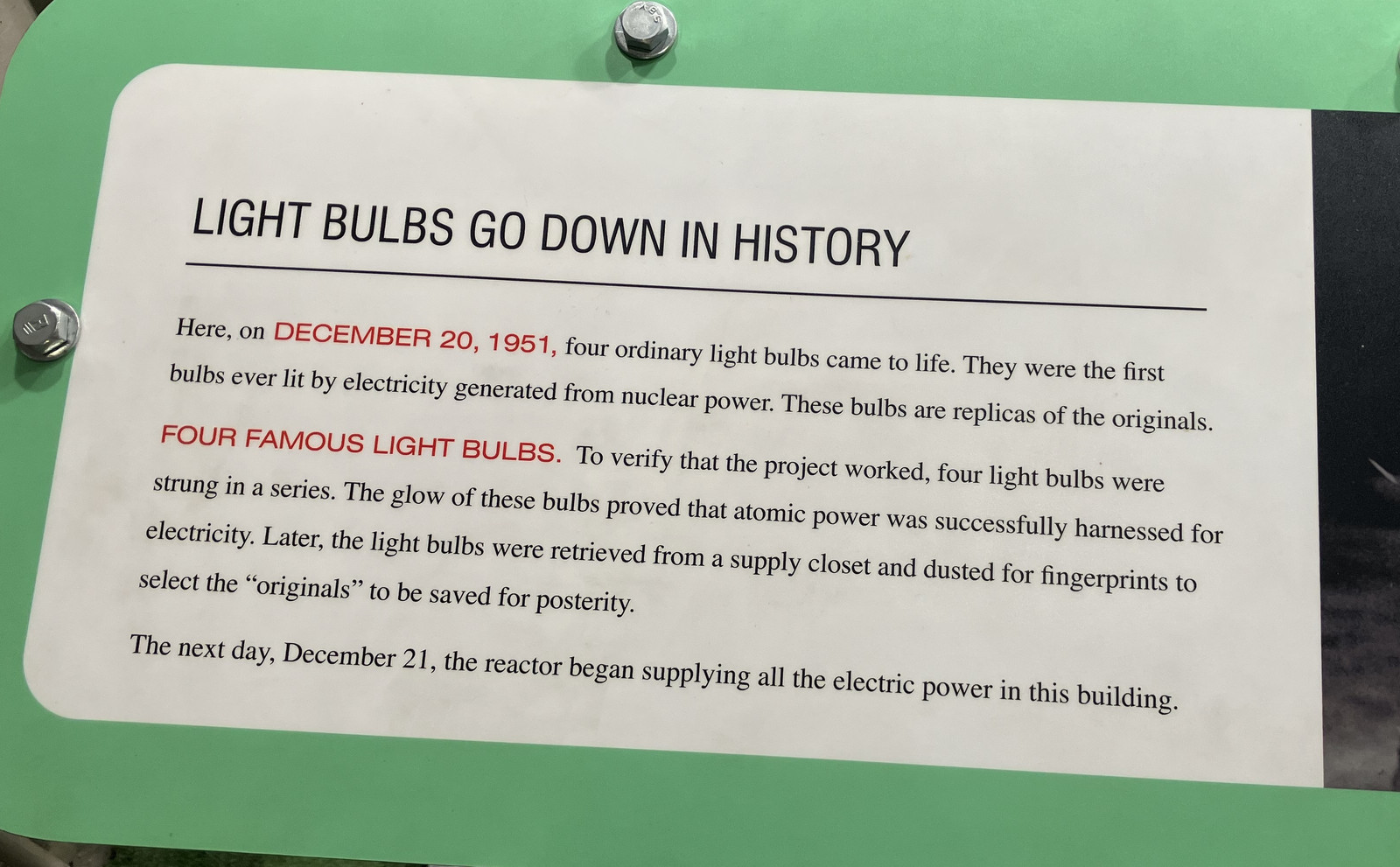
They do still have one of the original four here, and I expect they were somewhat more careful about the bulbs they used when they ran on purely plutonium (it’s not stated if that was bred here, but I would expect it likely!).
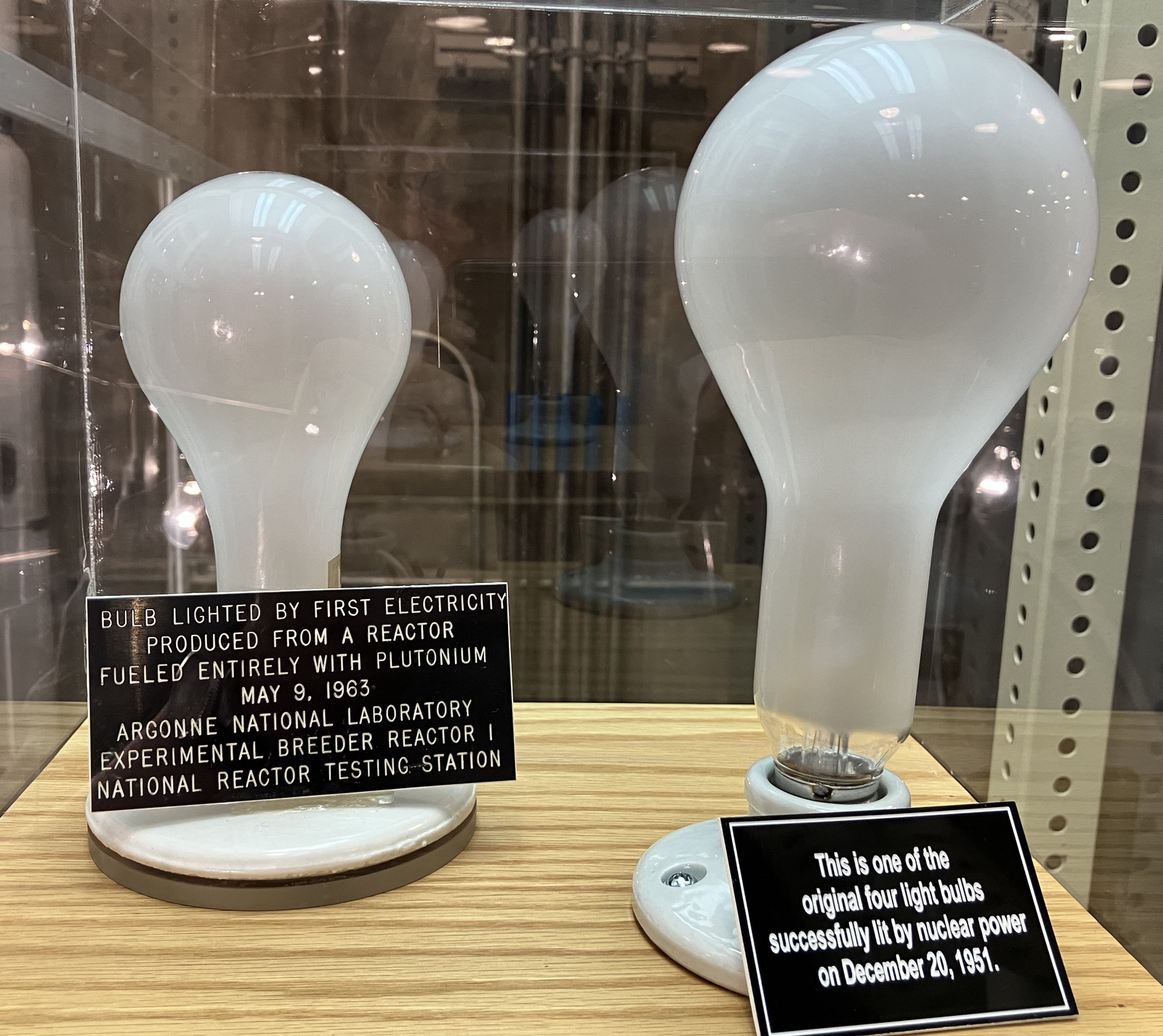
The Chalk Signatures
Despite not bothering to save the lightbulbs as anything special, there was some sentiment that, perhaps, this event (powering the building from nuclear power) might be something worth remembering. So, after doing the thing, someone got a ladder and made a memorial on the wall behind the turbo-generator. This has, later on, been protected by a good picture frame, but for 74 year old chalk-on-building-wall, it’s in very good condition! I just appreciate 1950s engineer handwriting, and it’s a thing I really ought learn.
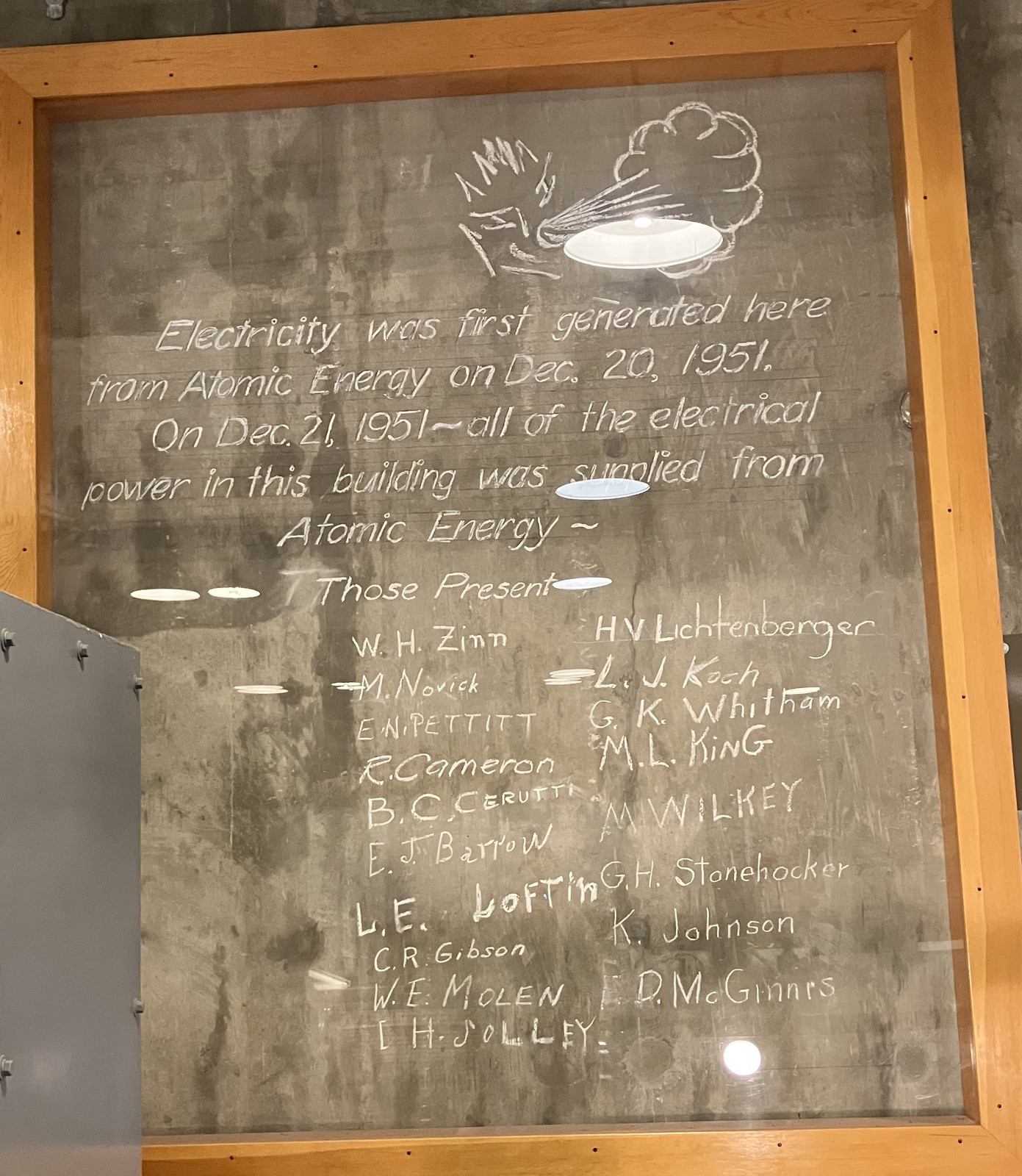
According to one of the audio recordings you can listen to, it seemed a bit bland, so someone added something appropriate up at the top that invoked a sense of nuclear, power, steam… that sort of thing. I suppose someone could feed this into an AI and get something impressive, but I’m not going to be the one to do it.

The Heat Exchangers
Continuing on the mechanical tour, a hole has been cut in a wall to allow a view of the heat exchangers. These are apparently still “mildly radioactive,” so not something you can get up close to. These transfer, in the multiple stages discussed above, heat from the reactor into a water loop that makes steam to run the turbine. The heat exchangers are of the “nested tube” variety, and if I recall properly, there’s a very thin layer of argon gas (or some other inert gas) between the tubes to help ensure that nothing radioactive escapes from one loop to another. I don’t know if this is a particularly efficient setup, but, as the point of this facility was to prove concepts, this also doesn’t mater in the slightest.
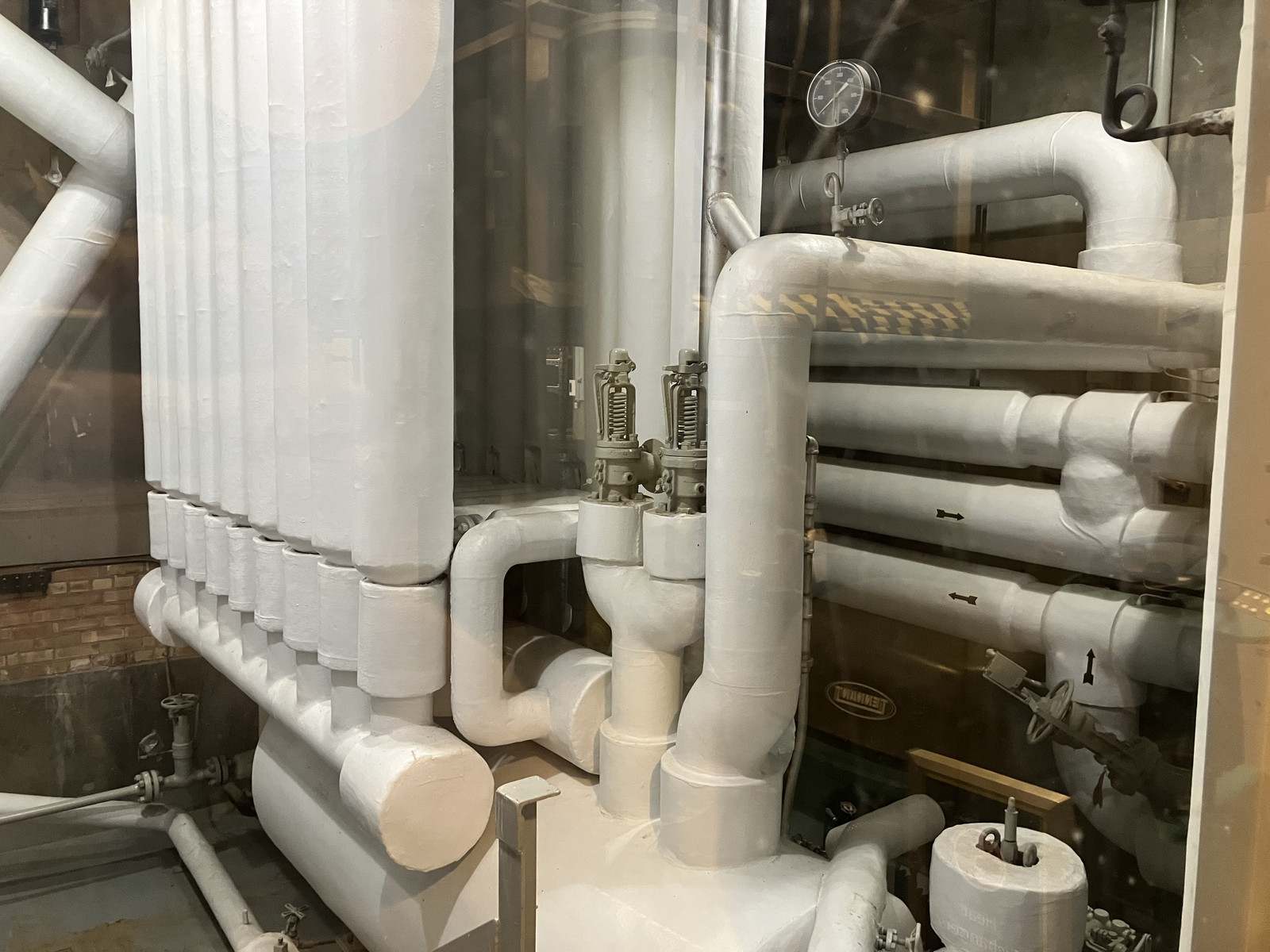
Notice how free floating this heat exchanger assembly is. Metal does expand as it gets hot, and this is something that needs to be handled in a system that deals with a wide temperature range. As far as i can tell, this assembly is supported to a fixed structure on every other tube, at the near end. Everything else is free to float and expand/contract as needed to keep stresses down. Given that the facility worked without problems for 12 years, it seems like a successful design!
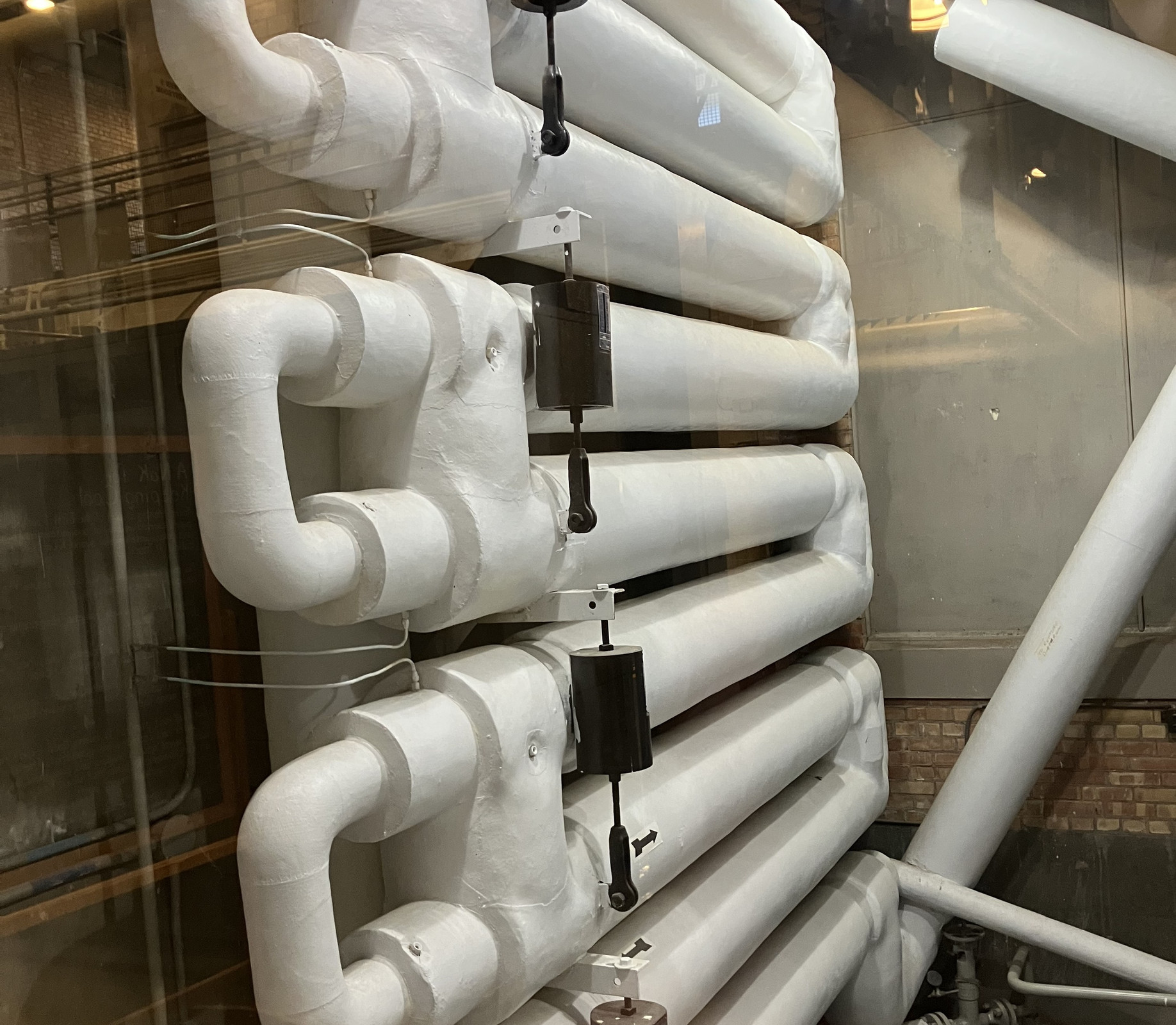
This is the piping under the turbine - the large flanges are directly under the turbine, and the steam pipes head up that way with gauges. I expect the sort of 1950s engineers who worked here didn’t need to be told what was and wasn’t hot, after learning how it worked. I… sort of wish I’d been around in that era. Or the early computer era of the 1980s. Things have gotten a lot less interesting since. No, I really don’t think figuring out how to A/B optimize engagement for a 2% increase in addicted viewing hours on YouTube to be at the scale of “Working out how to make fuel from waste, using the weird edge cases in nuclear physics.” Or “Sorting out how to fly Mach 3, indefinitely, in the upper atmosphere.” Or “Going to the moon, repeatedly.”
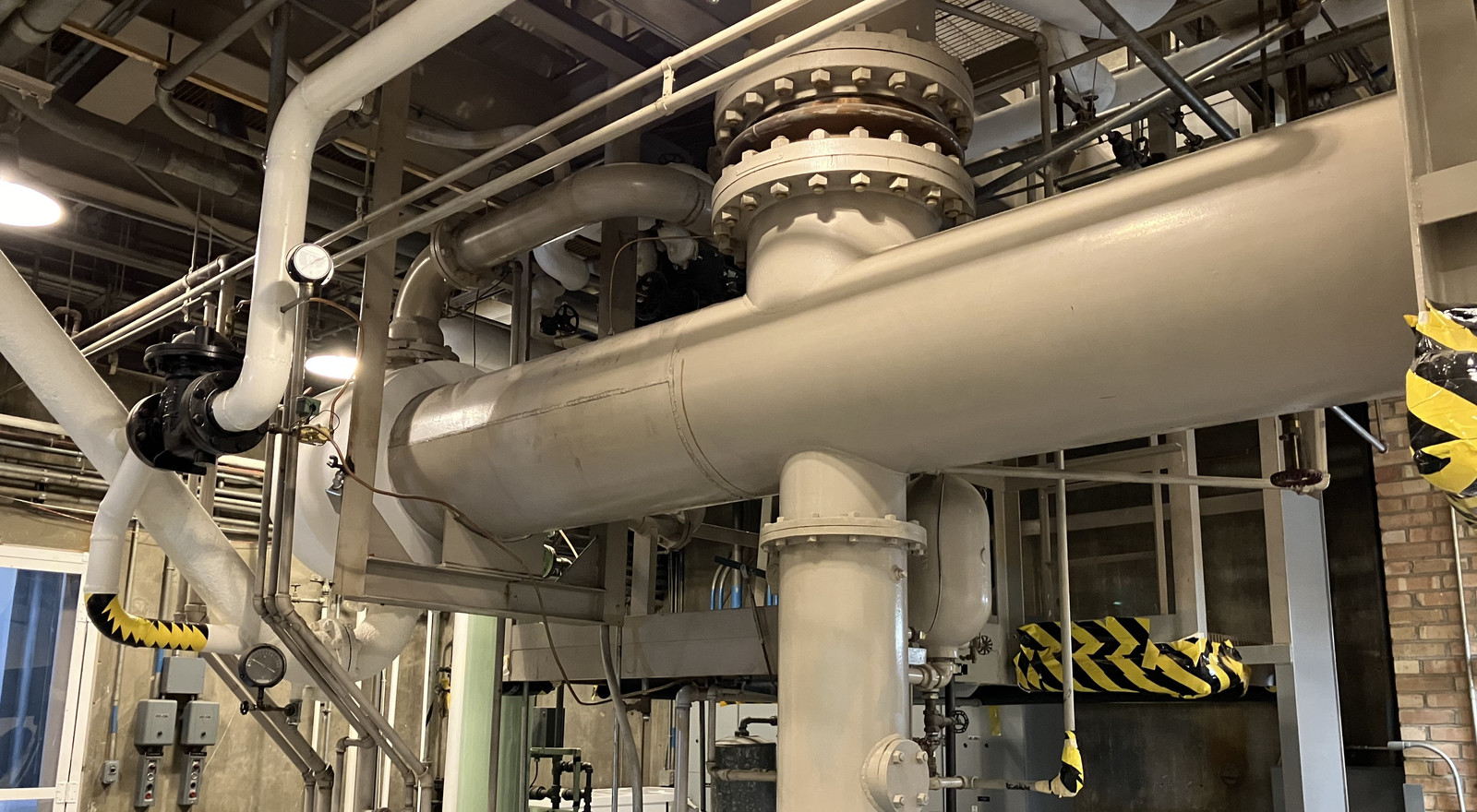
The Precious Metals Bank Vault
Built into an edge of the building is what, for all the world, looks like a bank vault - and, in fact, it is a bank vault. At the time the facility was built, uranium was considered a precious metal (I wouldn’t want to wear a ring of it, but it was not exactly plentiful in the 1950s) - and a nuclear reactor was going to have a lot of the stuff laying around. The reasonable thing to do is simply protect it in a vault! This was only used for the “fresh” fuel rods - once they’d been in the reactor, they were a lot more radioactive and were dealt with somewhat differently.
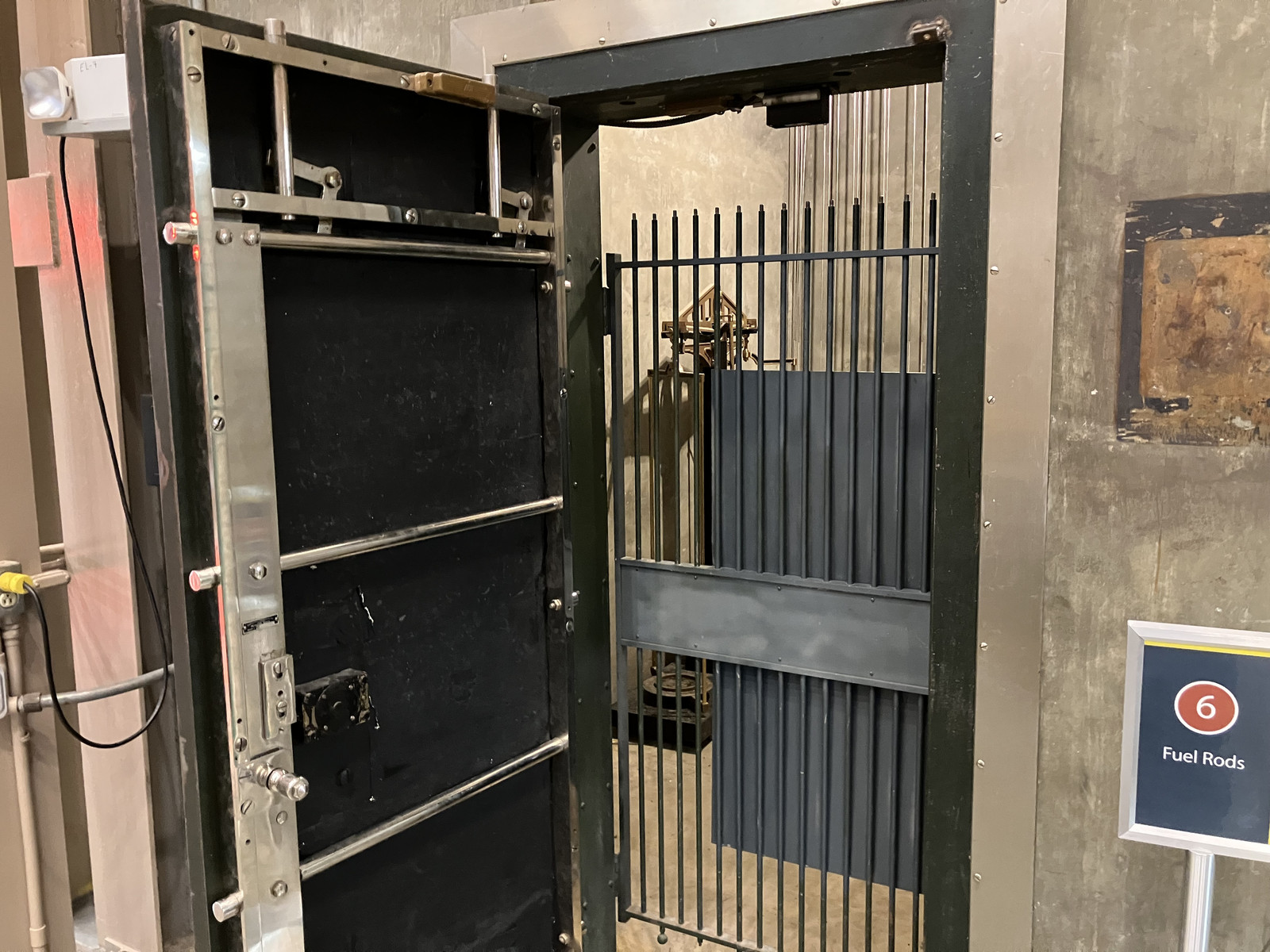
Rods were weighed in, rods were weighed out, and they’d better match or there were going to be investigations! In a world where you can just order uranium samples from United Nuclear, this seems bizarre to me, but it’s the way things were!
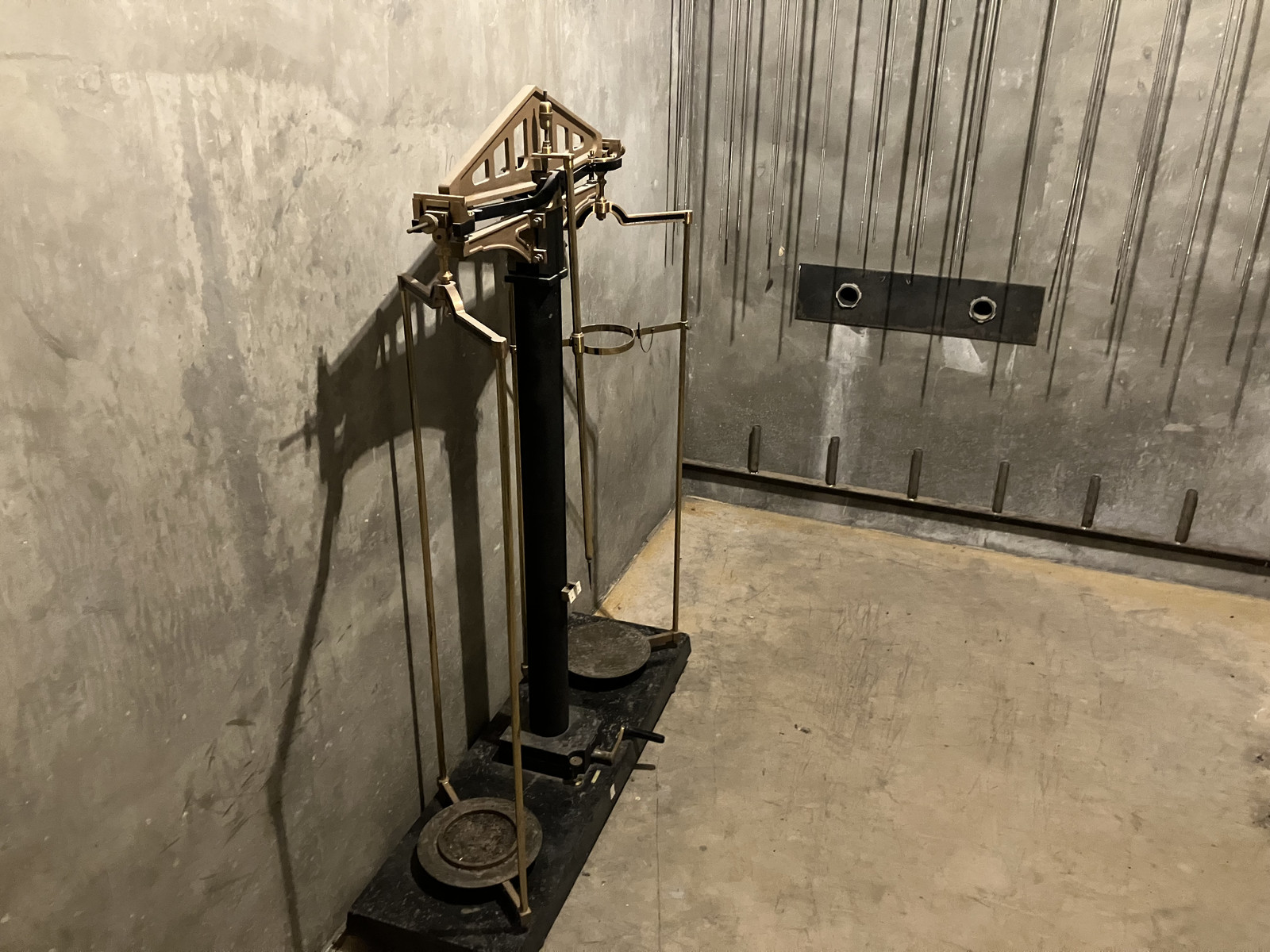
Handling the Fuel Rods
One thing you have to do with any nuclear reactor, often enough, is handle the fuel rods. They come in not terribly radioactive (U-235, or Pu-239, at least, aren’t horrible), and leave the reactor exceedingly hot. So, this was one of the fuel rod containers used to handle hot fuel rods. Remember, the hot section is at the bottom of the rods - so the handling vessel is designed around that.
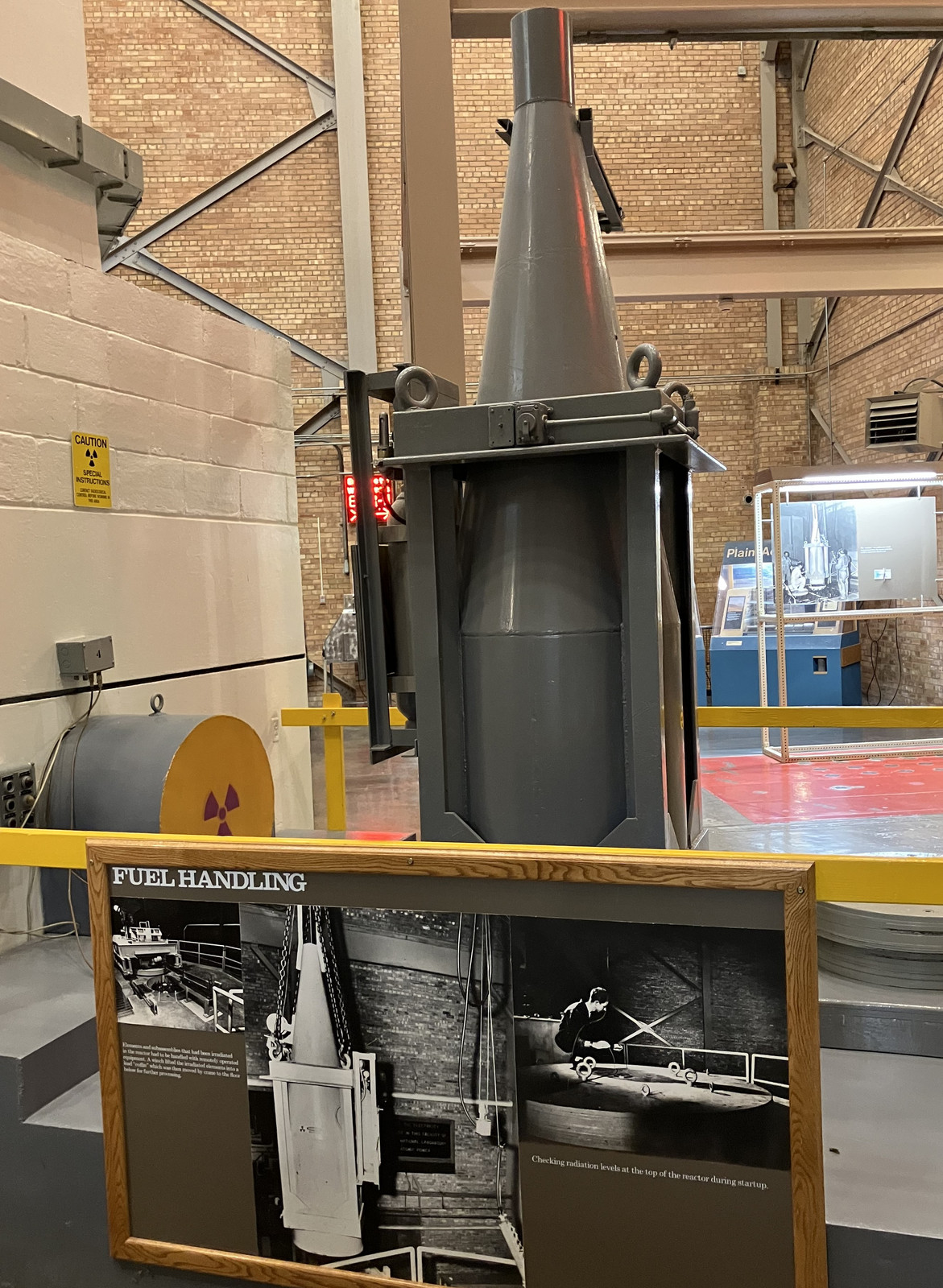
After coming out of the reactor, the rods had to chill out for a while before they were “cool” enough to do much with. First, they were washed down in the basement (I’ll get to that), and then they were stuck in tubes in the concrete floor until they’d calmed down. This was the “rod farm.”
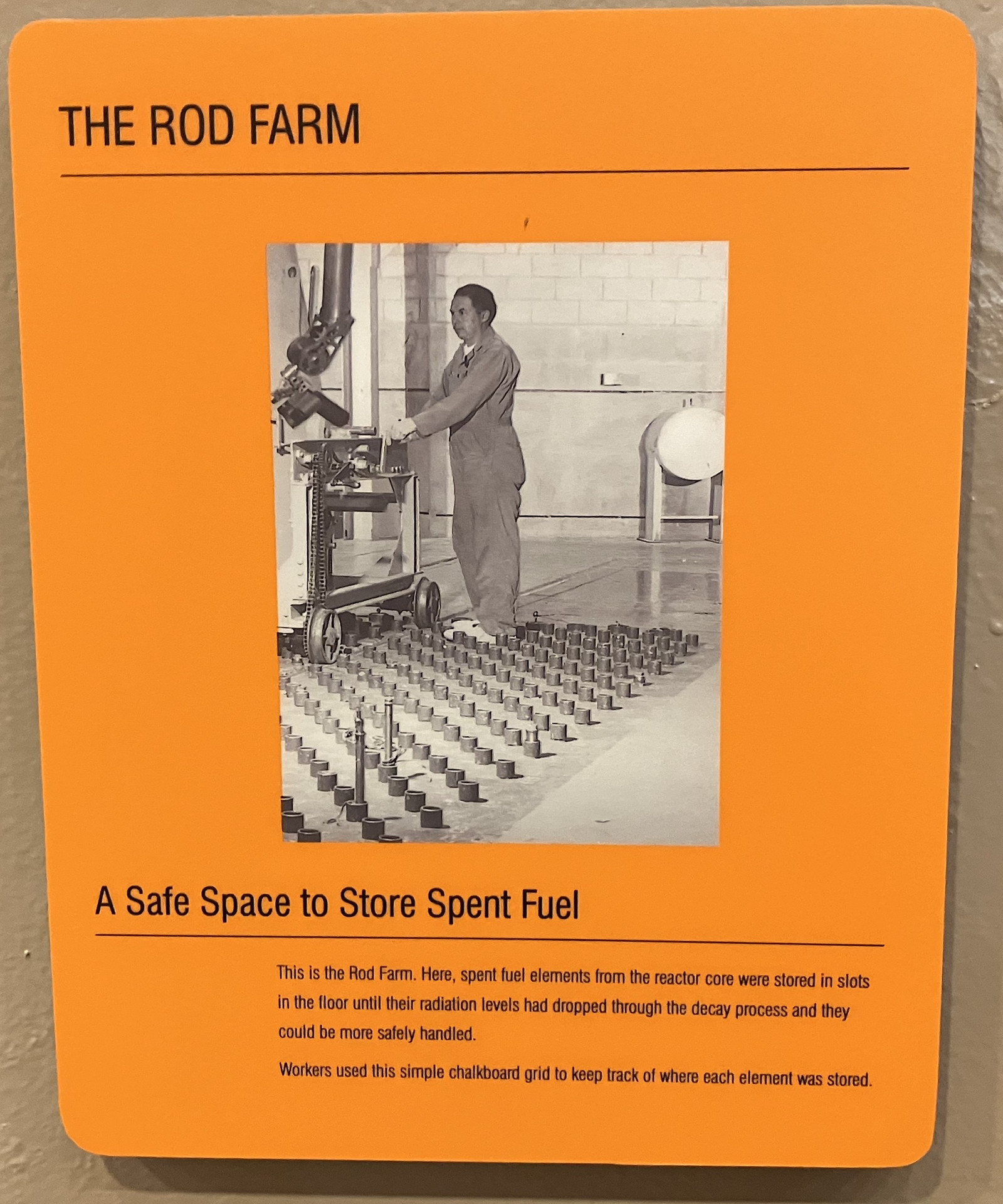
It’s just a bunch of holes in concrete, with some coverings, numbered. Each one fits a fuel rod so it can cool down in peace before being dealt with in a more reasonable manner.
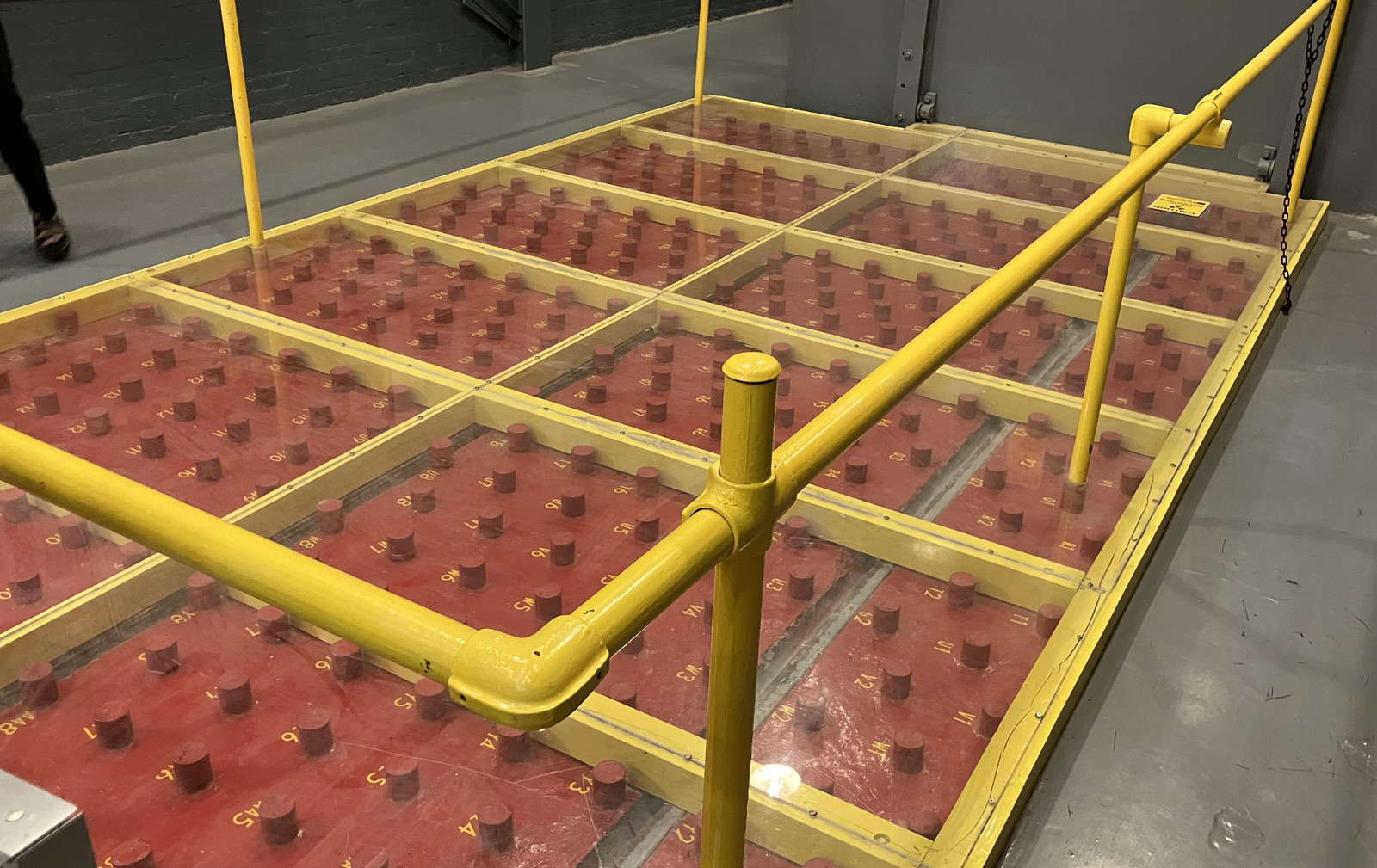
The Hot Cell
How do you deal with “hot radioactive things” in a sane manner? You use something called a “hot cell.” This is a chamber that allows you to see and manipulate radioactive things, safely enough. At EBR-I, the walls of the hot cell are 39” thick - and so are the windows, which requires some effort to make usable.
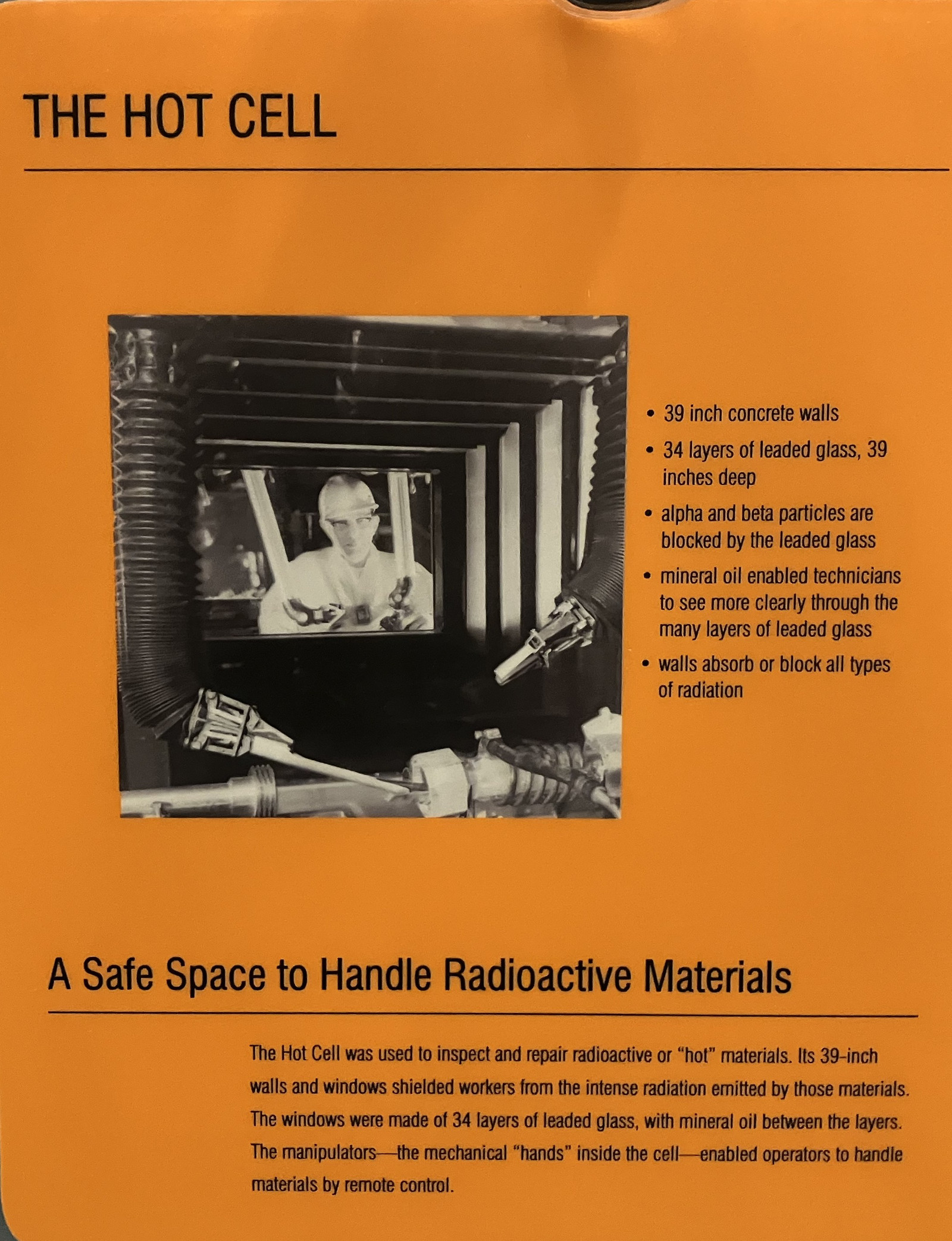
The windows are 34 layers of leaded glass, flooded with mineral oil between each layer. The result is a meter-thick window you can see, reasonably enough, through - though I’ve no idea how bright it actually is, in the hot cell. In the basement, a similar chamber with similar windows required quite a few high intensity sodium lights to make it workable. You can see, here, the reflection off each and every pane of glass from someone’s cell phone flashlight.
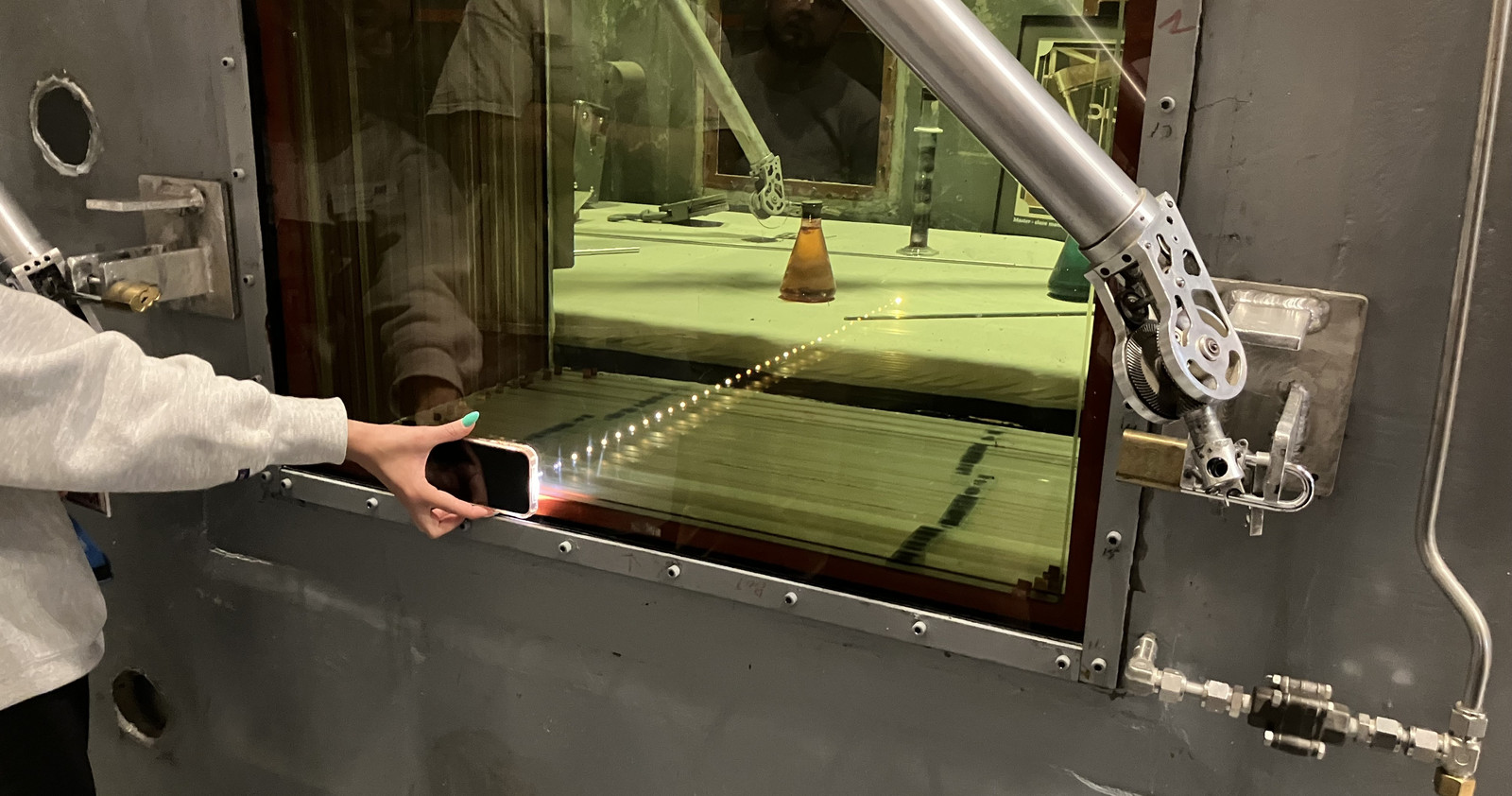
Looking through the window, things are impressively clear. You can see the layers of glass on the side, but it really doesn’t look like you’re looking through over a yard of glass. The color is a bit skewed towards green, but… eh, whatever. Workable!
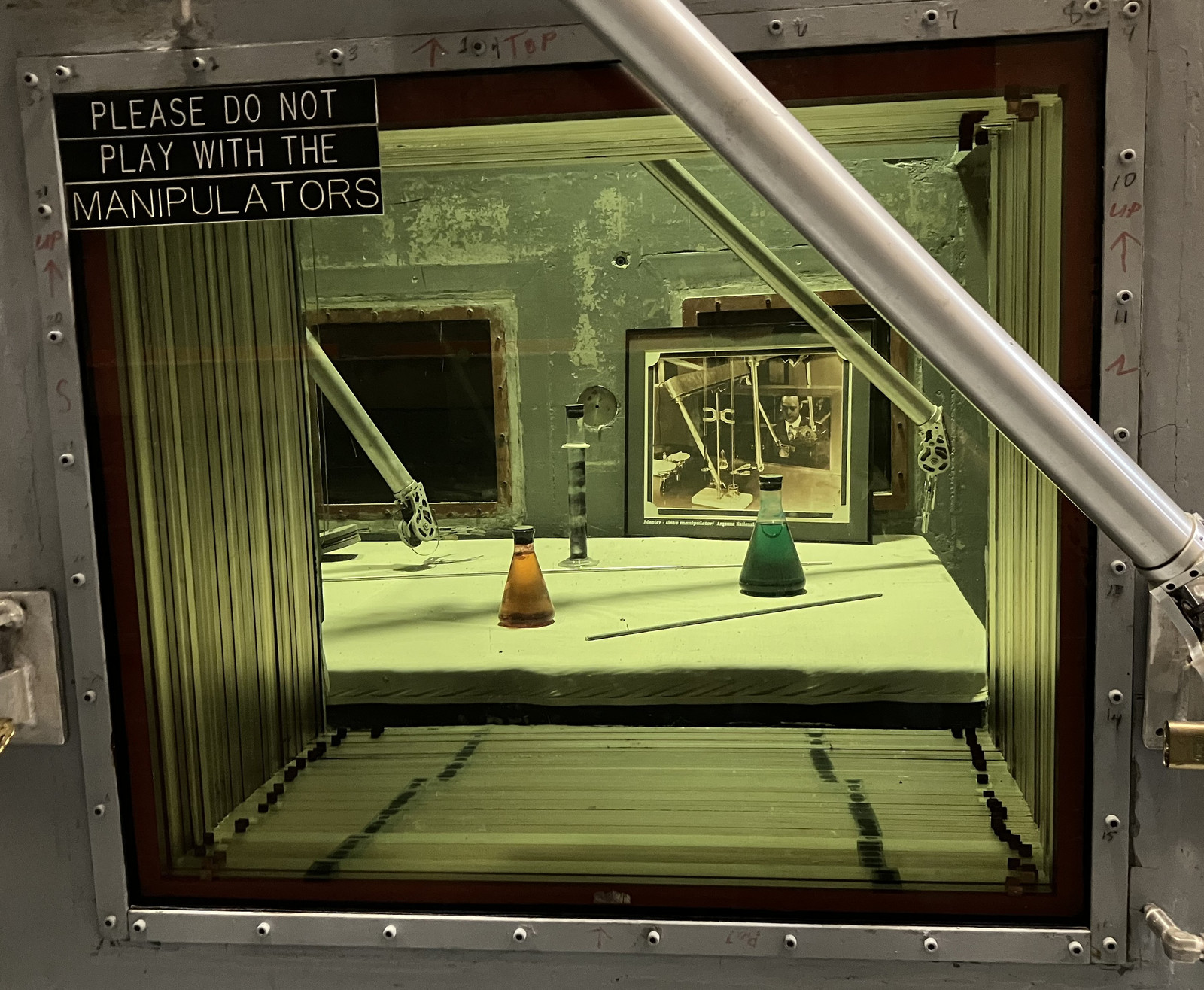
The other window, however, has leaked somewhat. The top part has no mineral oil between the panes, and while you can faintly make out the details of what’s inside (this photo fails to indicate that), it’s a hazy, foggy mess. The contrast between “air between panes” and “mineral oil between panes” is stark, and astounding. If you need to do a lot of layers of glass for whatever reason, mineral oil between the panes is the way to go! I have no idea why you’d need a 34-pane window other than radiation concerns, though. Remember, this was all before cheap cameras. You couldn’t just stuff a radiation-proof camera in the space and put a monitor outside!
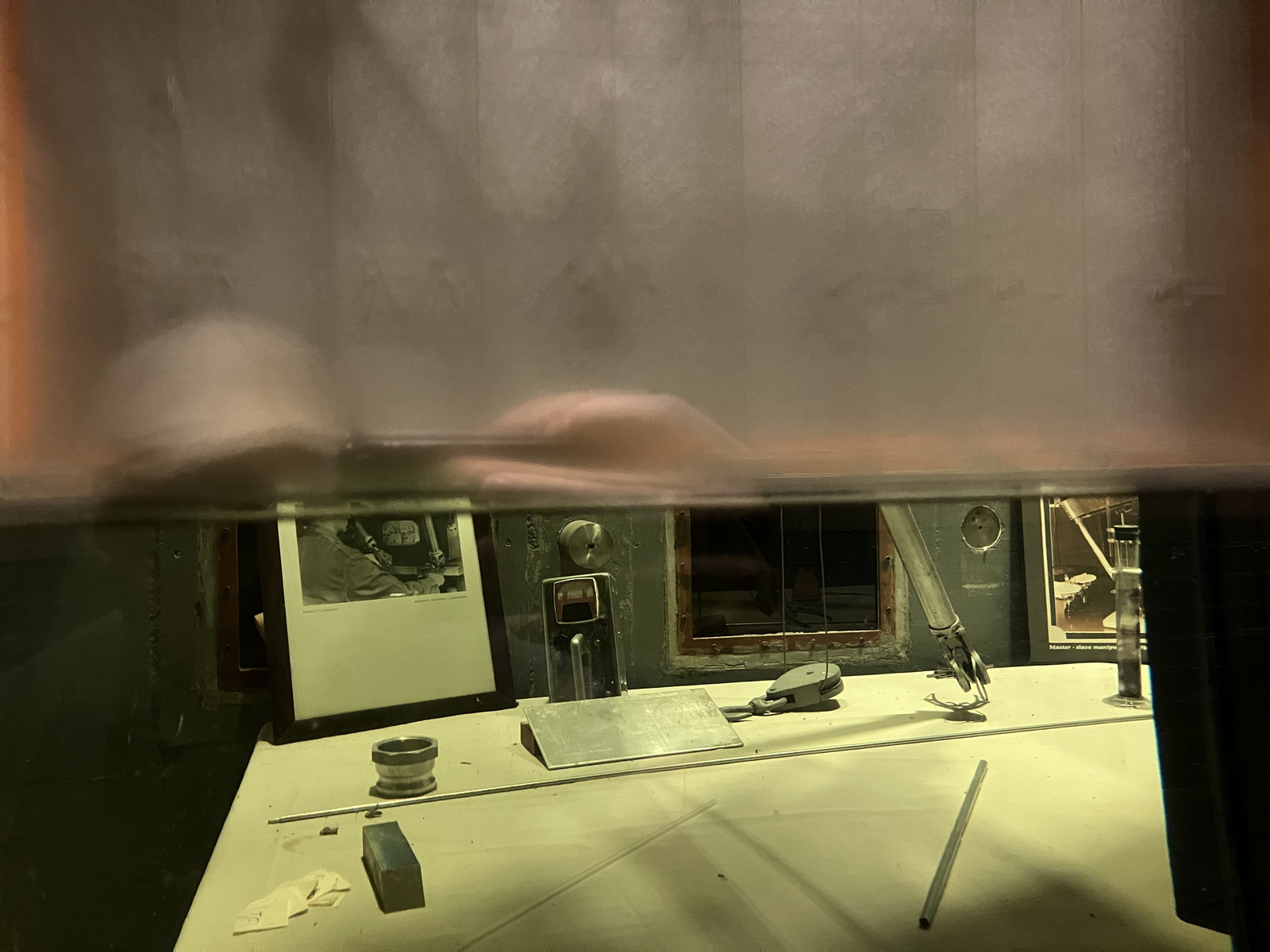
The manipulator arms were entirely mechanical, though there’s a motor drive mechanism somehow involved. They’re locked in place, with warnings about “Do Not Touch.” However they worked, they were capable of doing some impressive work within the hot cell. Someone on the tour that had caught up with me shared that, wherever he worked, the “test” for people with manipulator arms was being able to flip pages in a magazine, in the hot cell. Once you could do that, you were considered competent with them. I’m reminded of assorted demonstrations with heavy machinery I’ve seen or heard of - things like “being able to pin a sheet of paper between the excavator bucket and an egg without cracking the egg.” I’ve watched people work excavators and backhoes with this sort of skill, where it was clear they’d been working this machine for a very, very long time. It’s a thing of beauty, watching a digger being run by someone who knows, understands, and can talk to the machine. They know what it can do. They know what it can’t do - and won’t ask it to do those things. And while they’re using it, it never actually stops. The motion is just fluid, in all directions, as they use it as an extension of their body. A child digging in a sandbox doesn’t make separate, discrete actions - and neither does a backhoe, run by someone who can talk to the machine.
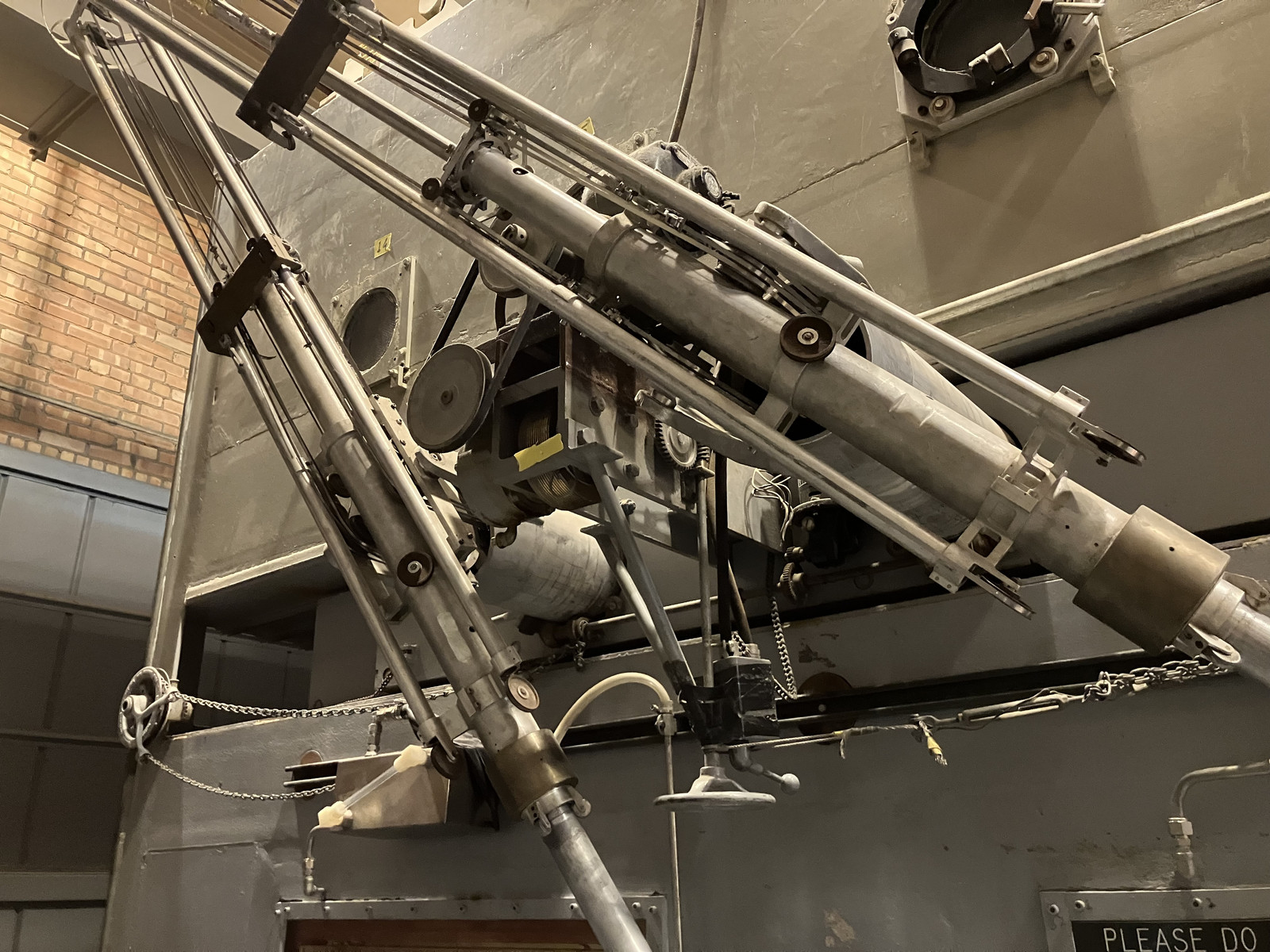
The Basement
While the tour doesn’t go down into the basement, you’re free to do so if you want, and of course I was going to head down there! The first thing that caught my eye was the “Fallout Shelter” sign, and I struggle to come up with something much more ironic than the basement of a building containing a working nuclear reactor being a fallout shelter. But, again, such was the 1950s. It sounds like a fascinating, and terrifying, era to live through.

If you’ve spent much time in 1950s nuclear era construction, it’s nothing terribly new. Concrete and steel, with exposed wiring, motors, and plumbing. These are controls for various other bits of machinery down here, faintly hidden behind a control panel. Caution: Do not touch spinning things with remaining hand!
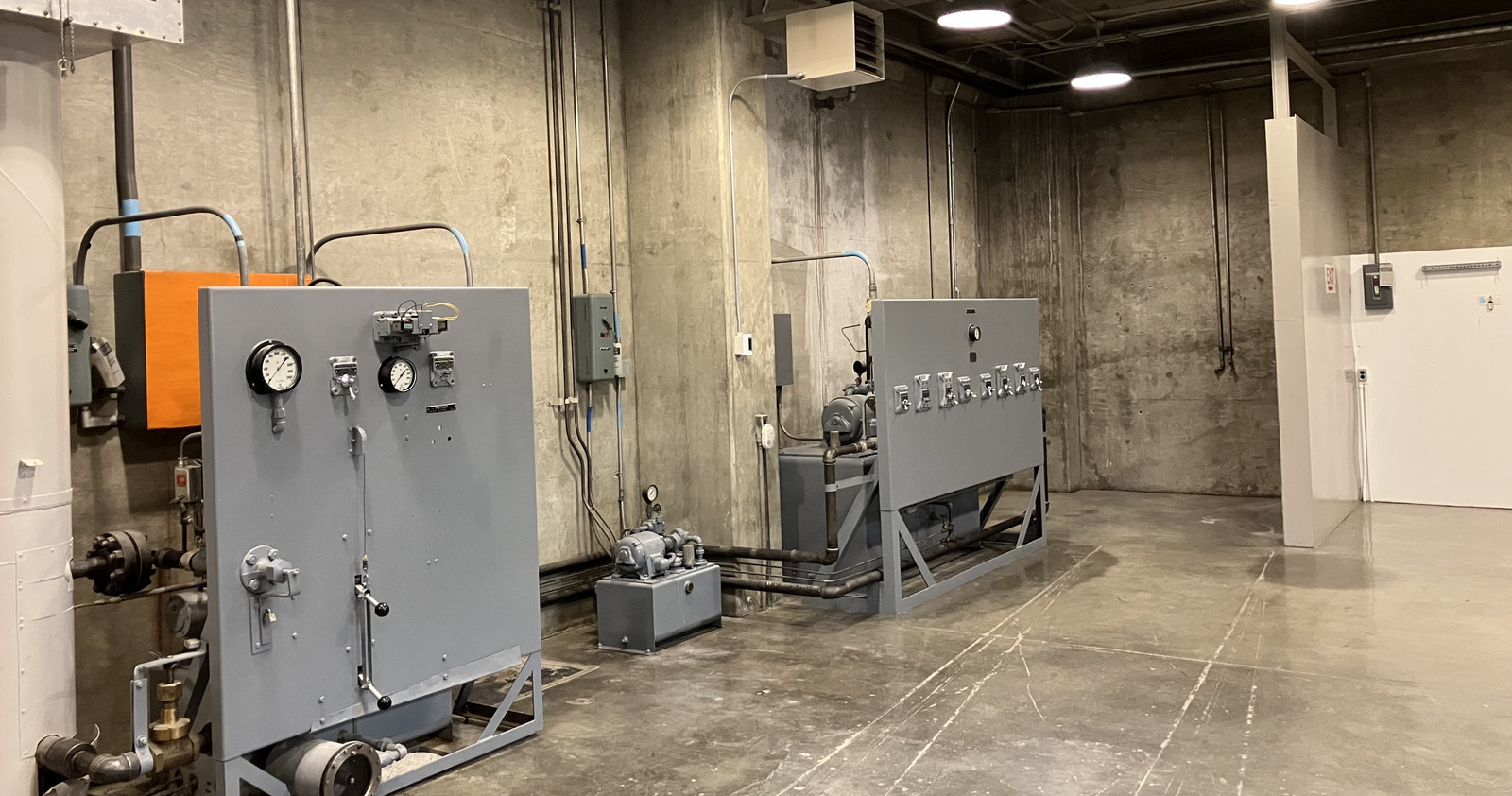
The “washroom” in the basement is not a bathroom….
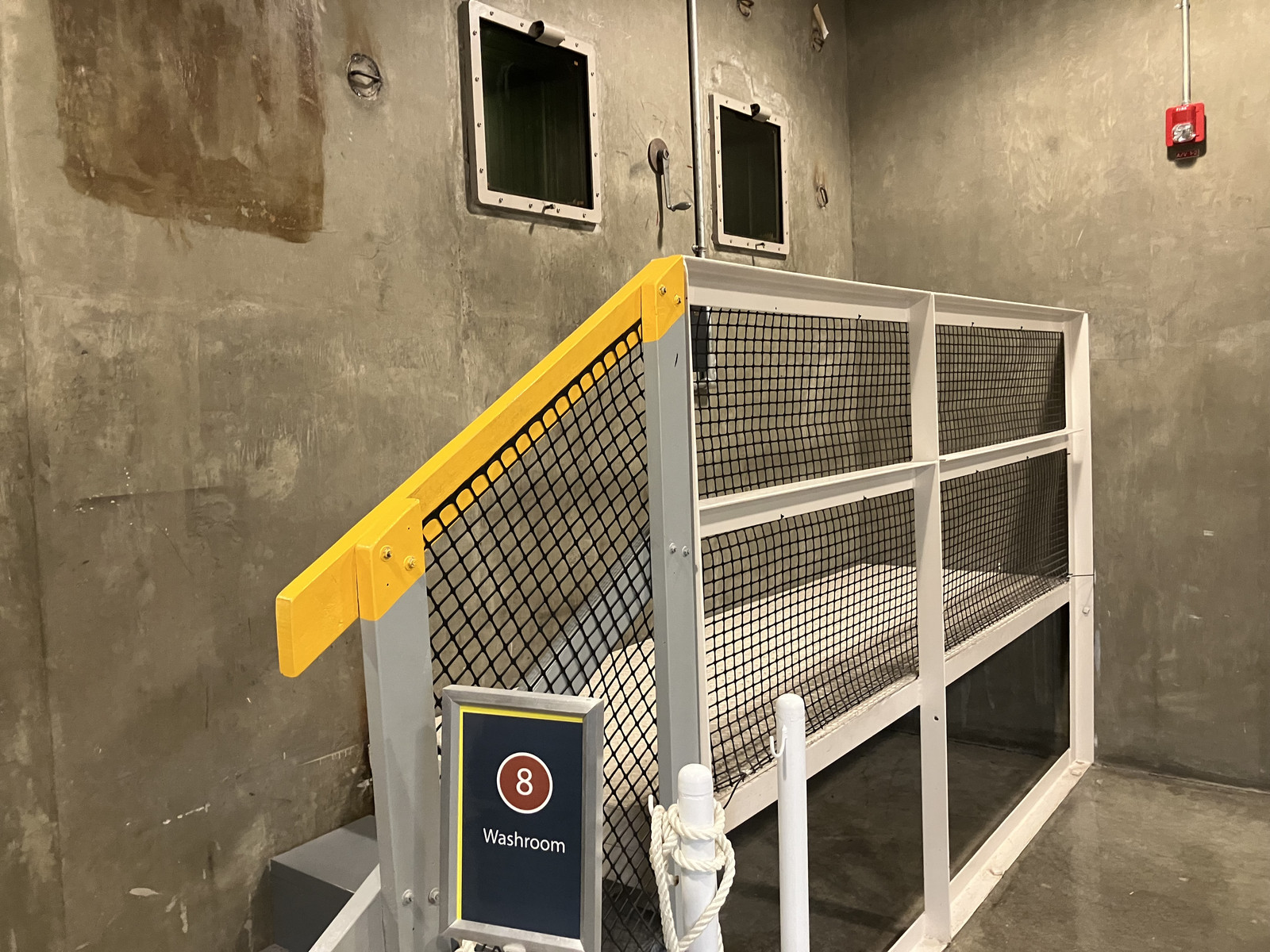
It is, instead, a chamber in which the fuel rods could be washed of their coolant. Remember that NaK interacts badly with “just about everything,” to include “air” and “water.” After a rod came out of the reactor, all the coolant had to be removed from it before you could put in the rod farm. The washroom accomplished this task. After a rod was inserted here (I’m not sure how it actually got down here), an acetone wash cycle removed the NaK from it. When that was done, the operator would start the water wash cycle. If sparks flew (literally!), they knew there was still NaK on the rod, and they’d run another acetone cycle until it was sufficiently cleaned up. This is another one of those “massively thick windows through a massively thick concrete wall” sort of viewing ports.
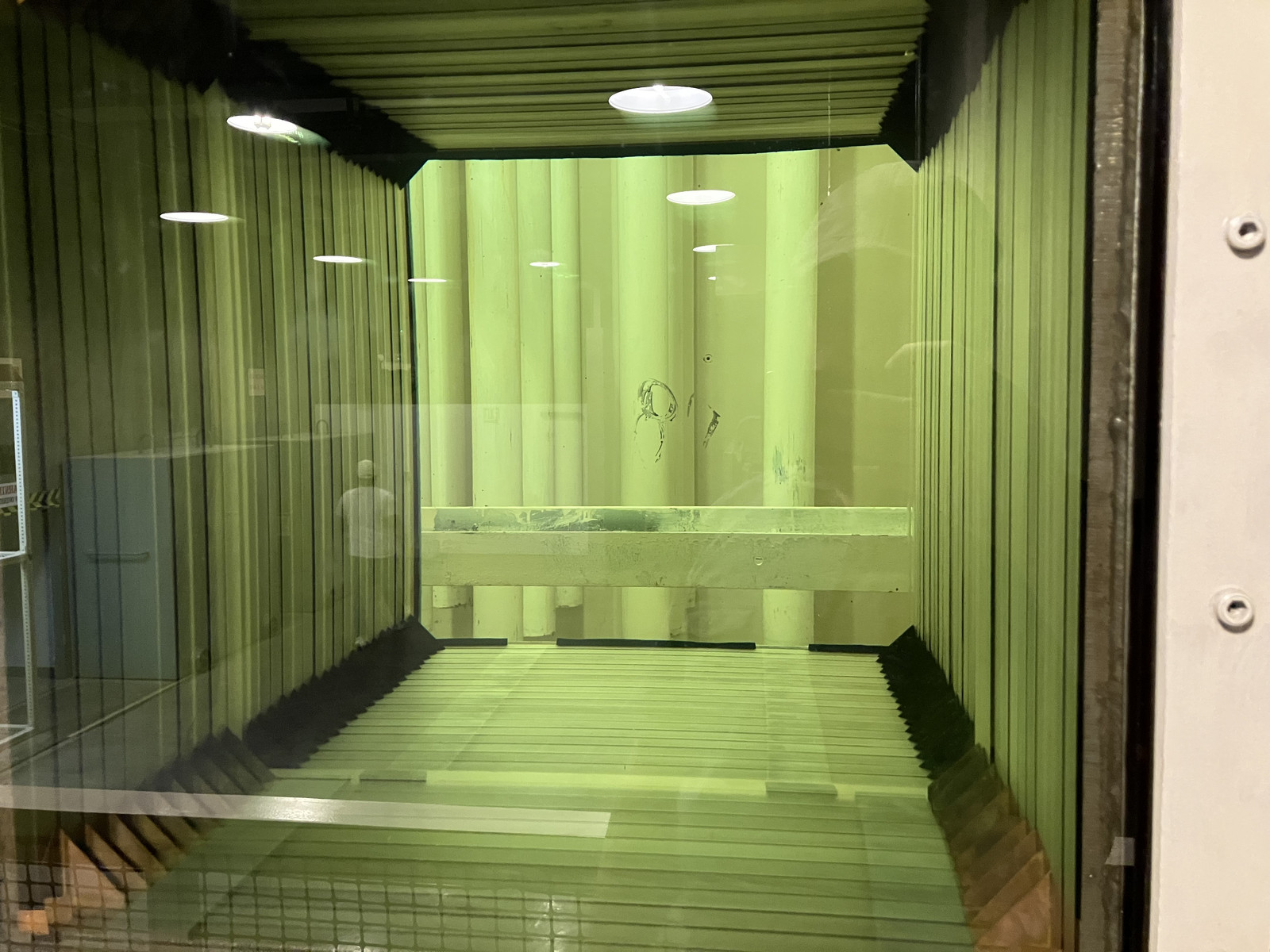
The Elevator and Blanket Repair Rooms
Under the core, several rooms handled the “elevator” (moving the breeding blanket up and down), and replacing chunks of this blanket, for reprocessing or repair. The doors to these rooms were simple enough: Massive metal (probably lead) blocks, on rails. These were blocked in place with wood and wedges, so I couldn’t figure out just how much effort these took to move, but I expect it was not a one man process. Someone could probably calculate how much each of these doors weighed, but it won’t be me.
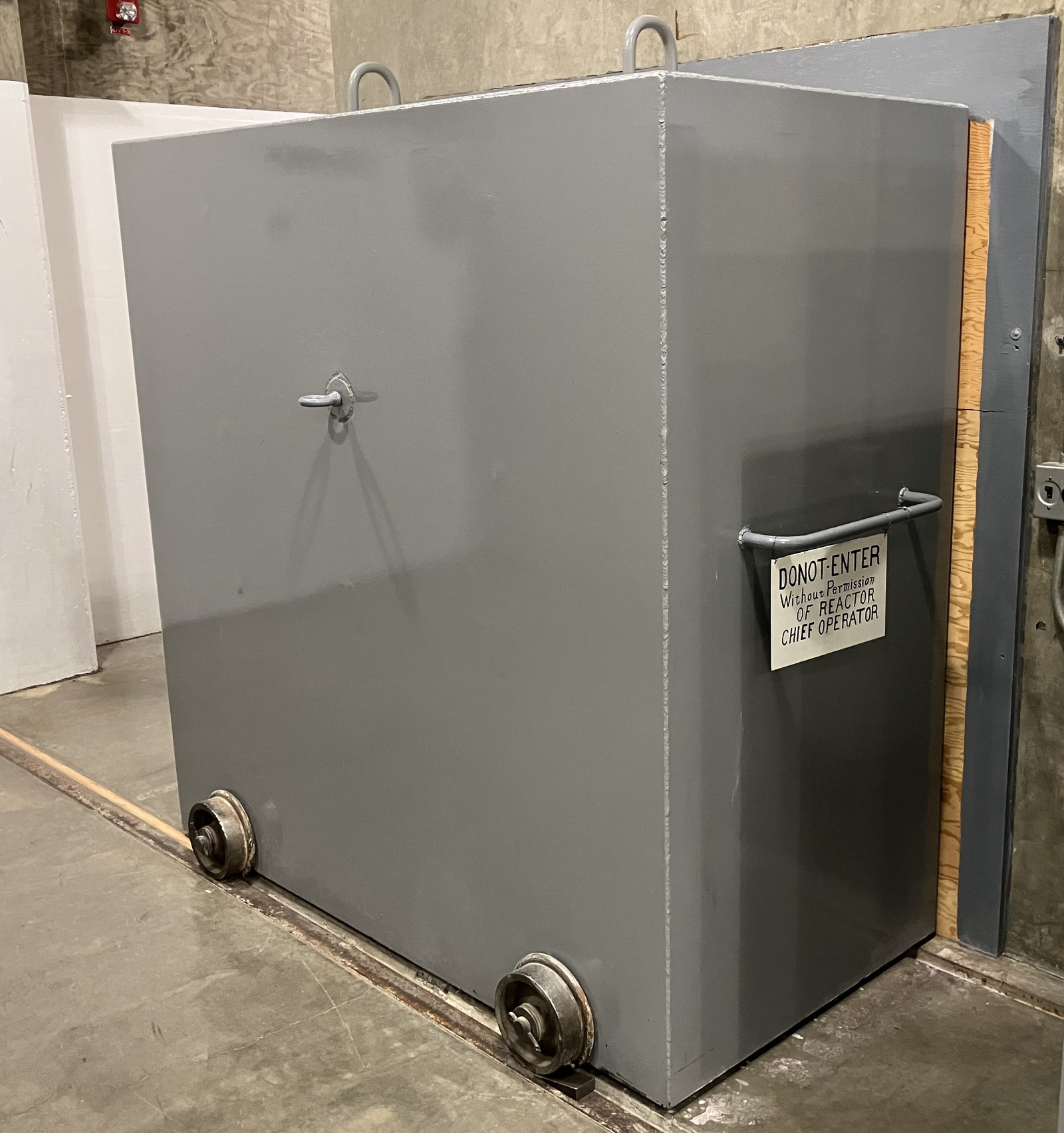
This is, as far as I can tell, the “elevator” for the breeder blanket. It lifts the blanket up around the core to start the reaction, and drops it away from the core to stop the reaction.
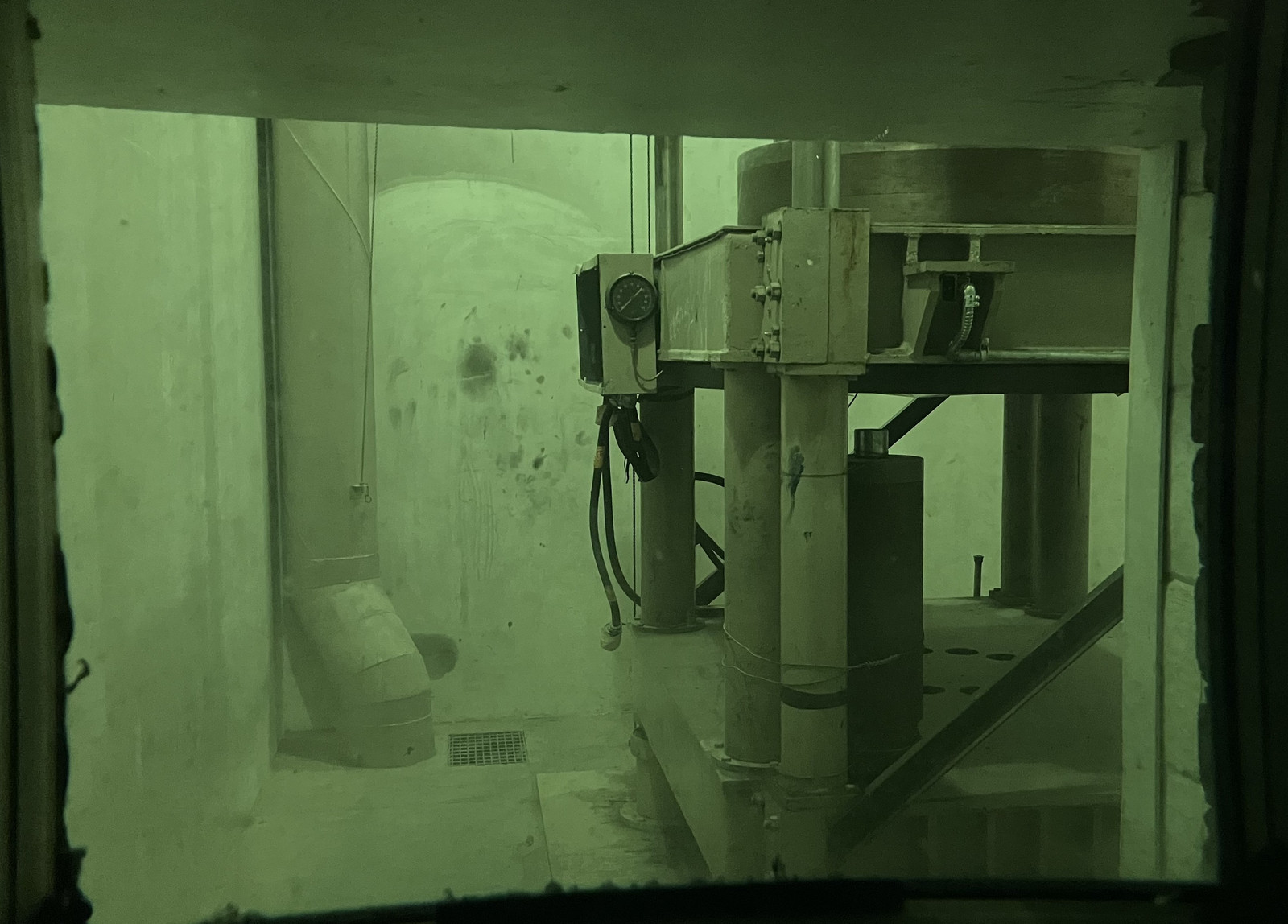
As much as the 1950s sounds fun, sometimes I’m not sure about the concept of “Moving the massive lead block out of the doorway so I can go work on the thing under the reactor.” It was probably fine… also, Science!
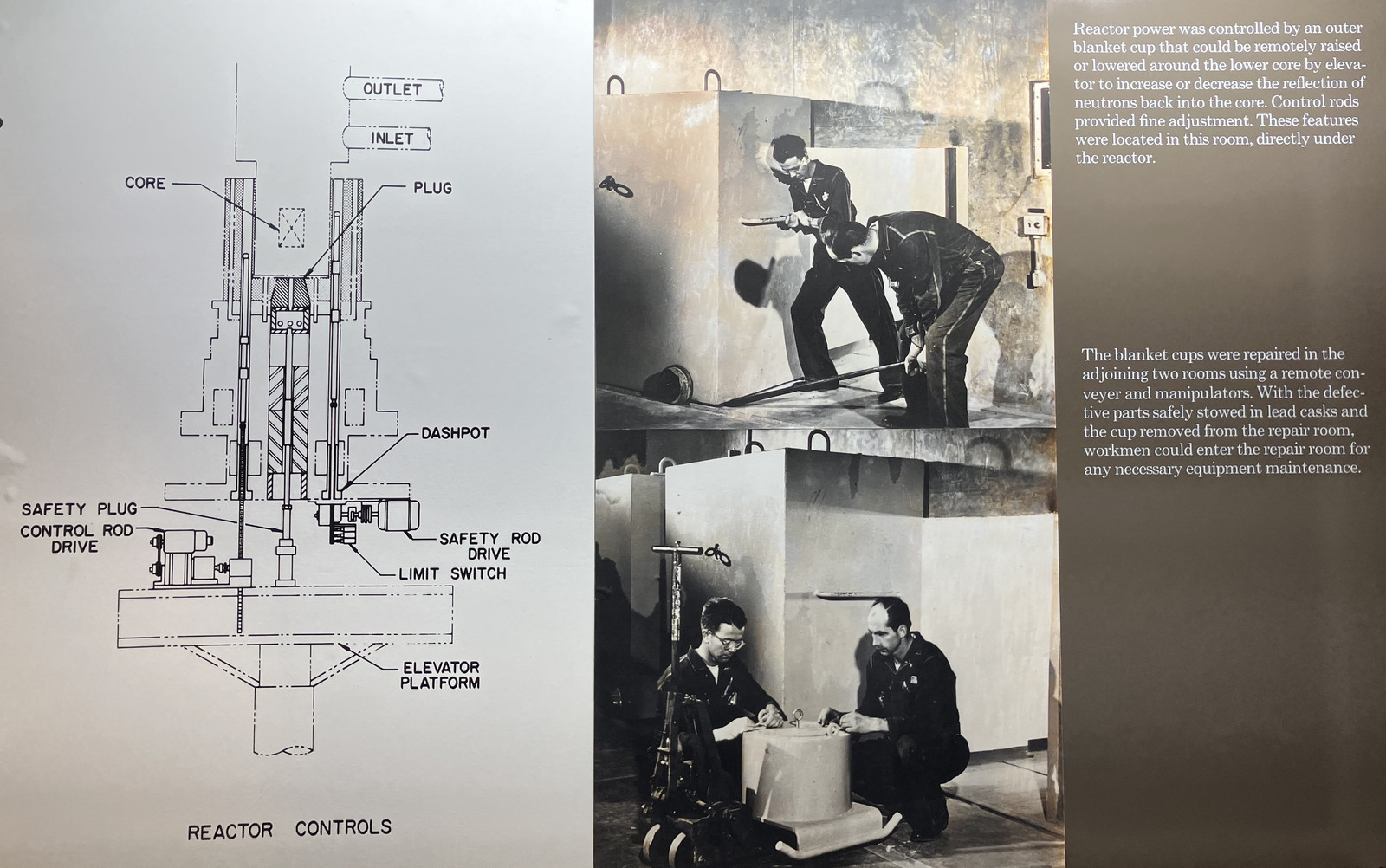
The Repair Rooms
While I’m a bit uncertain as to how the blanket actually got into the repair rooms, there are two rooms on either side of the core that serve to work on the breeder blanket. These rooms, somehow, allowed the engineers to replace each brick in the blanket if needed.
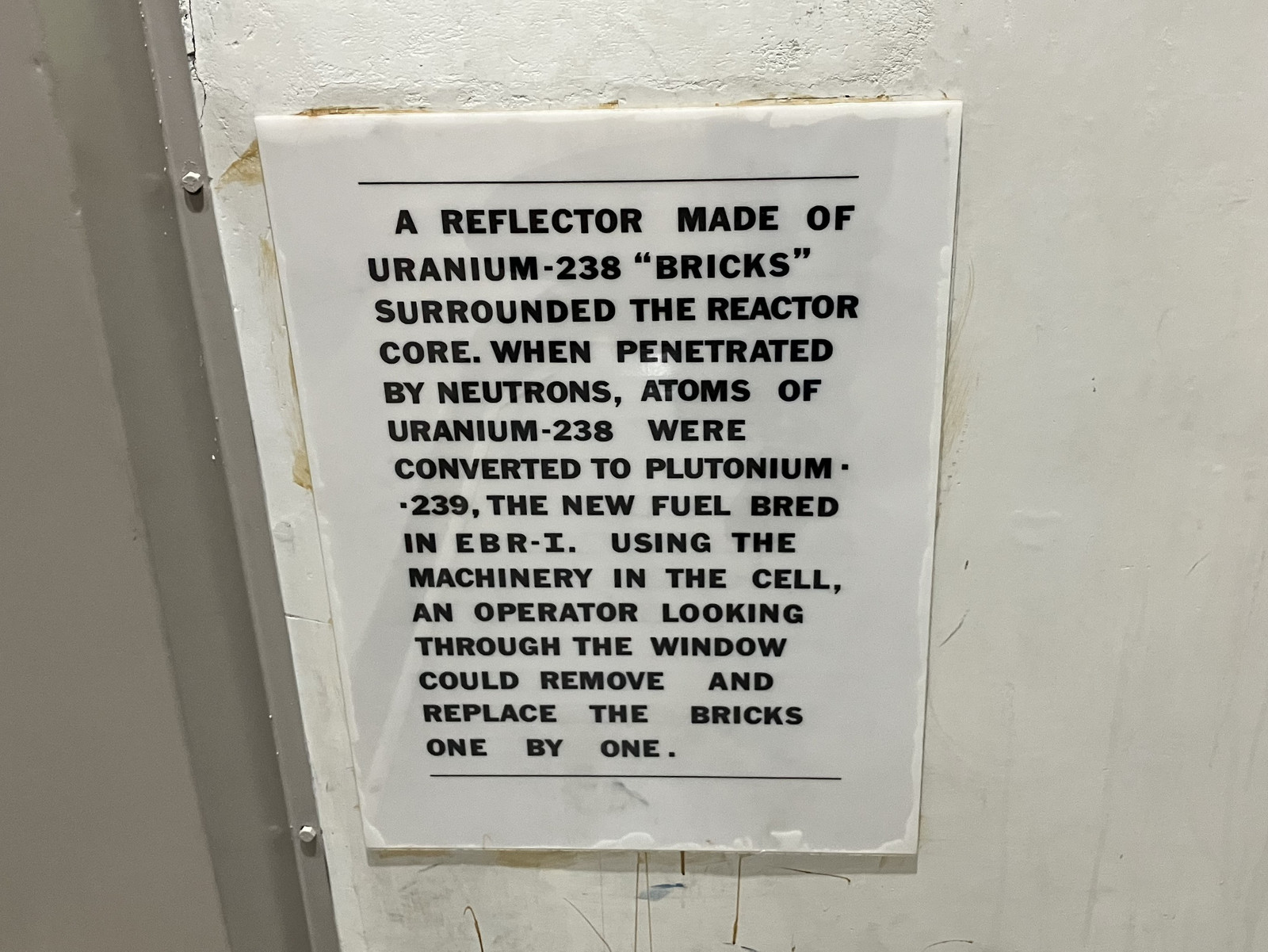
There is machinery designed to work on it! I really don’t have a good sense for how any of this stuff worked, though, and it wasn’t explained.
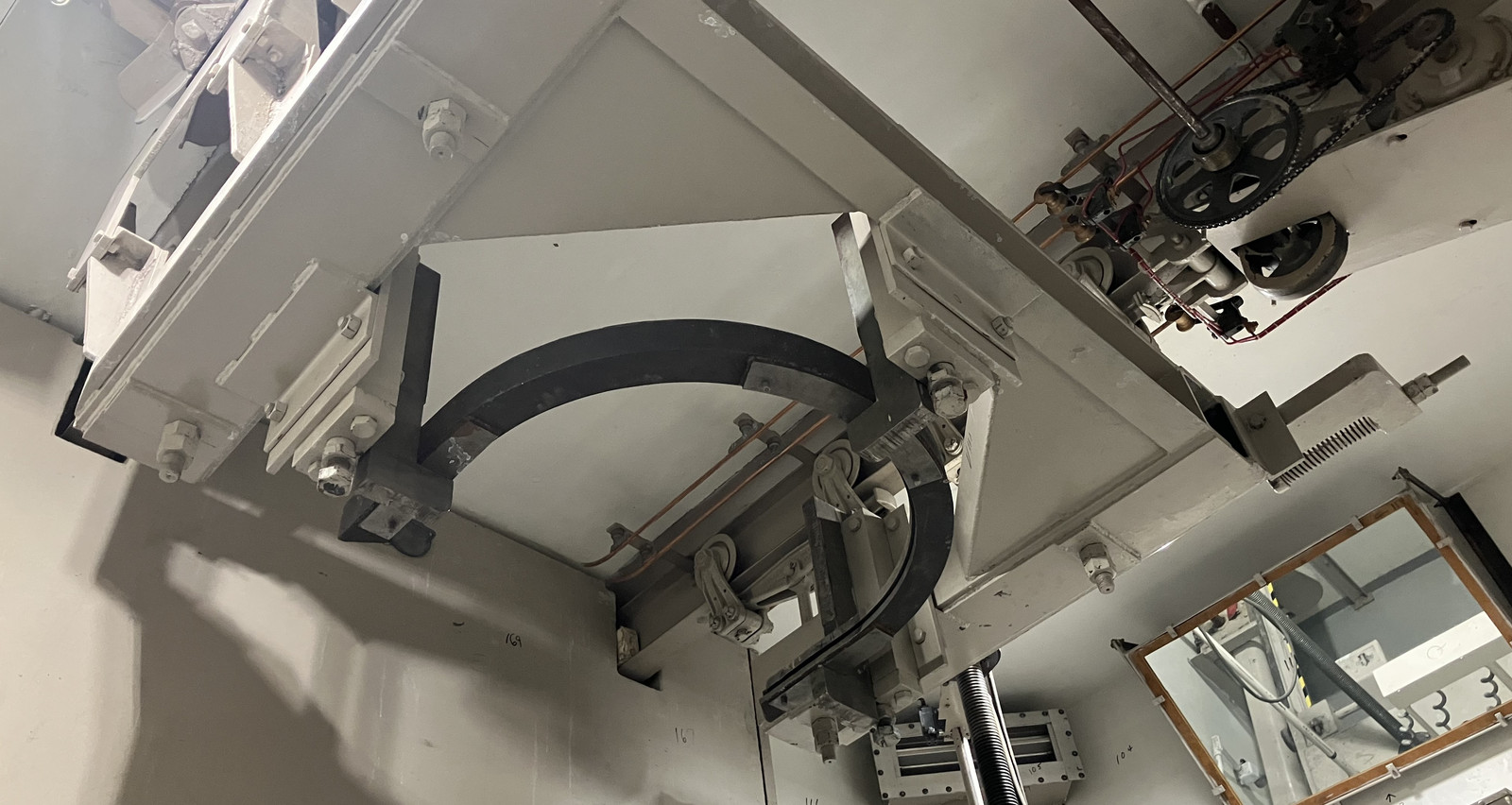
This is the “simple” control board for one of the blanket repair rooms - and while I’m sure the company has been sold half a dozen times since, I do like my Square D panels, even 75 years later!
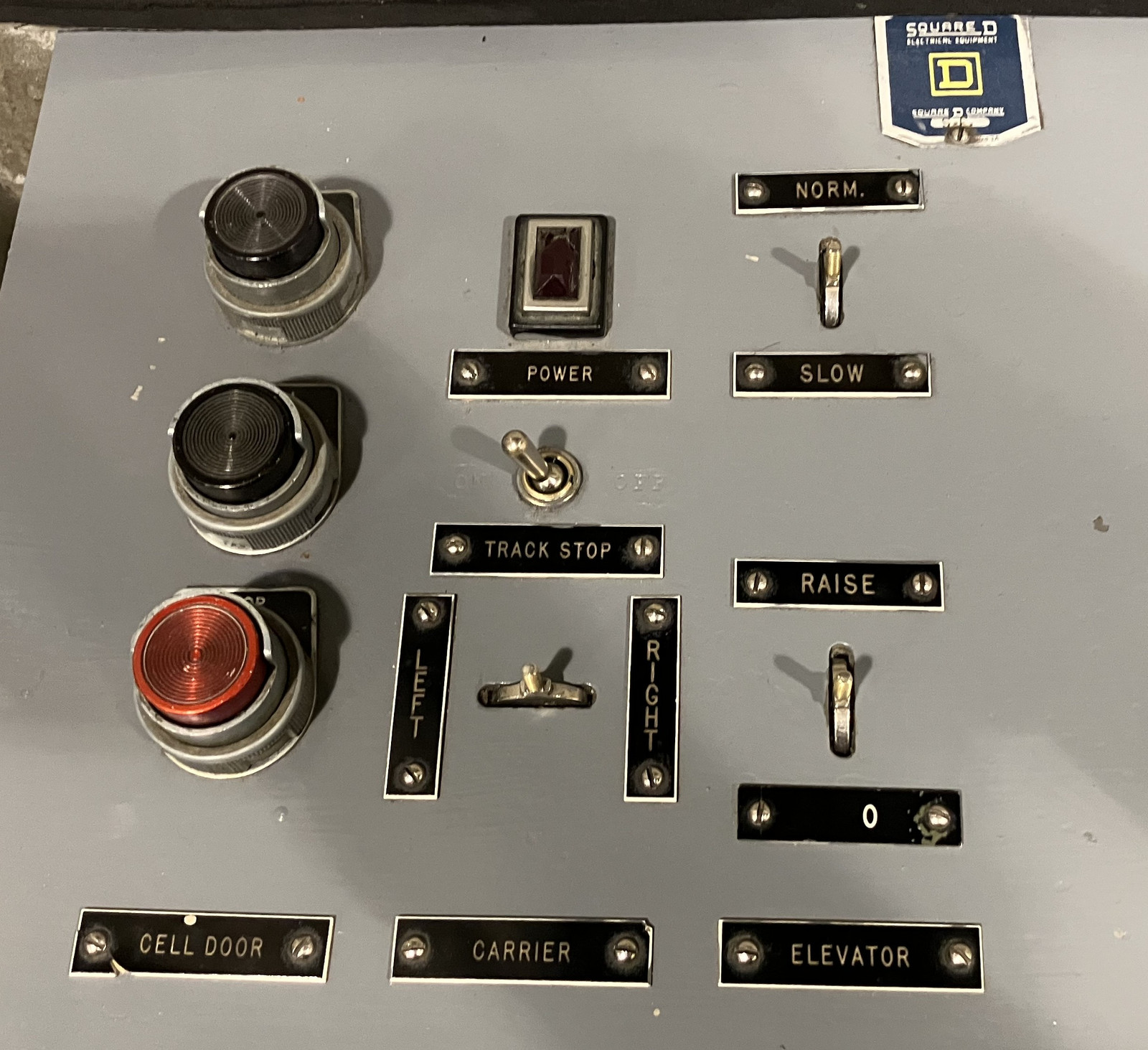
The more complex control board is for the other room, and this seems to be the board capable of more comprehensive repairs. No, I really don’t know what most of these actually control… but I’d love to find out, some day, if all this stuff is still operational!
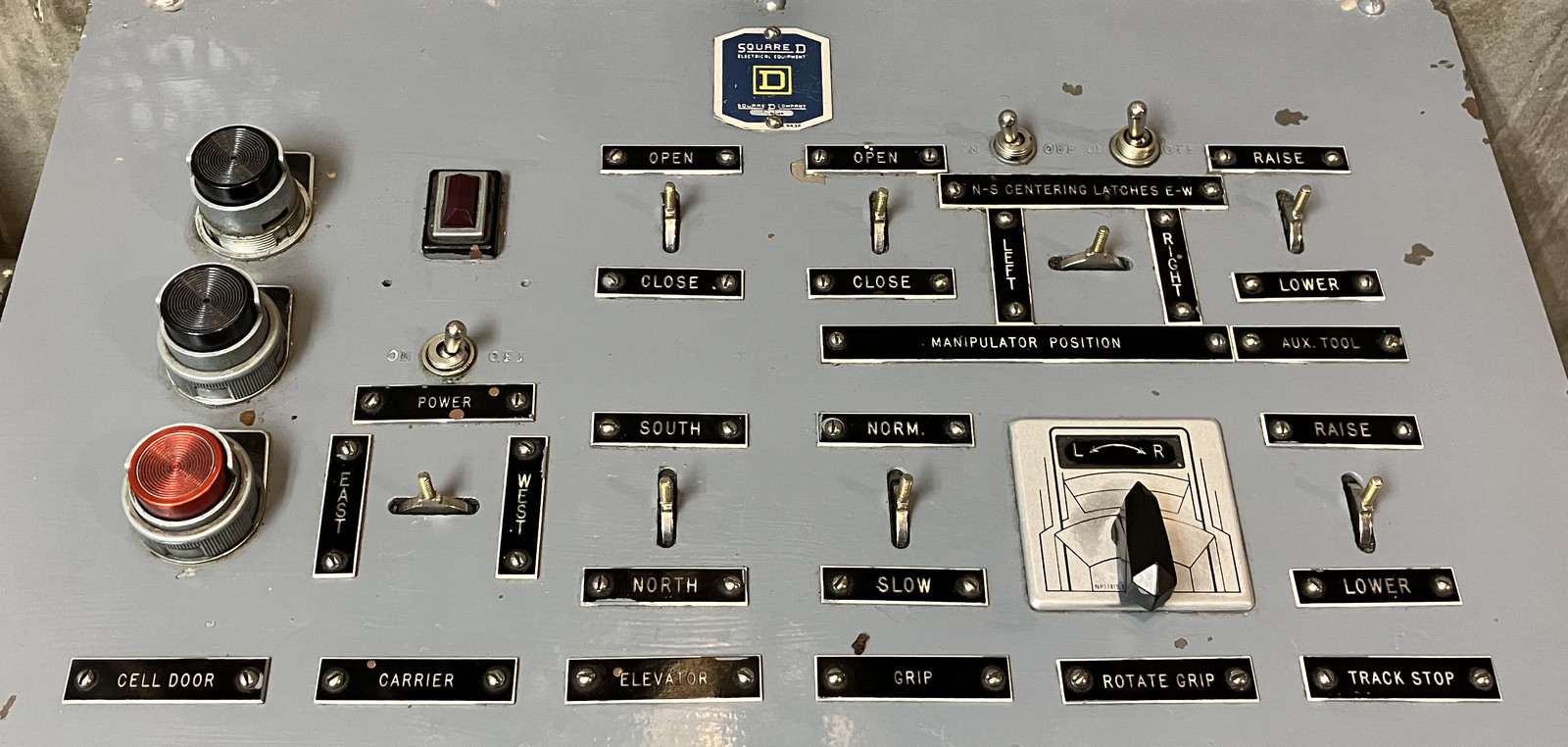
“Oh, what do you do for a living?” “Math.”
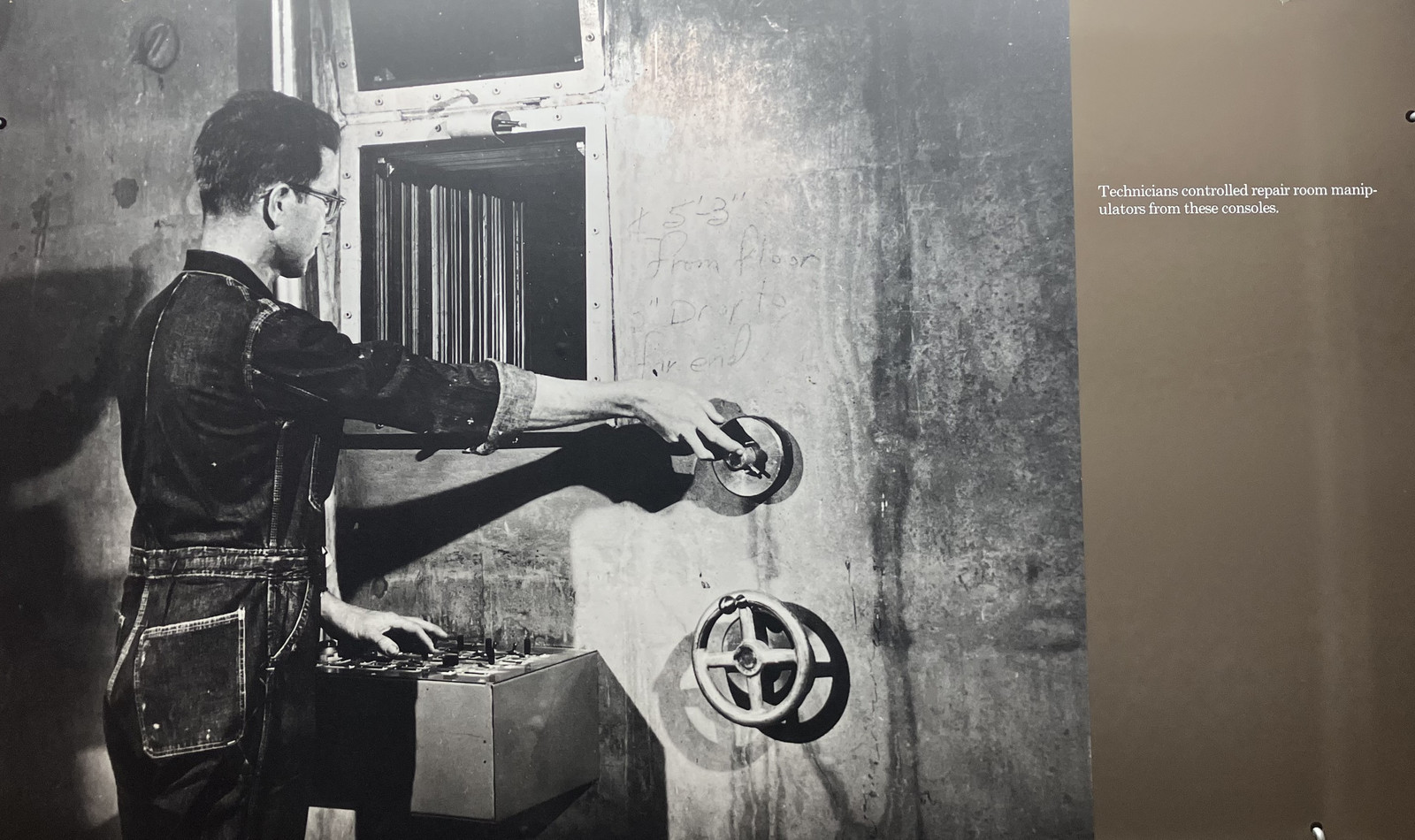
Finally, there is a glorious breaker panel down here! None of these wimpy half width breakers to be found! Each of these is a whole cabinet!
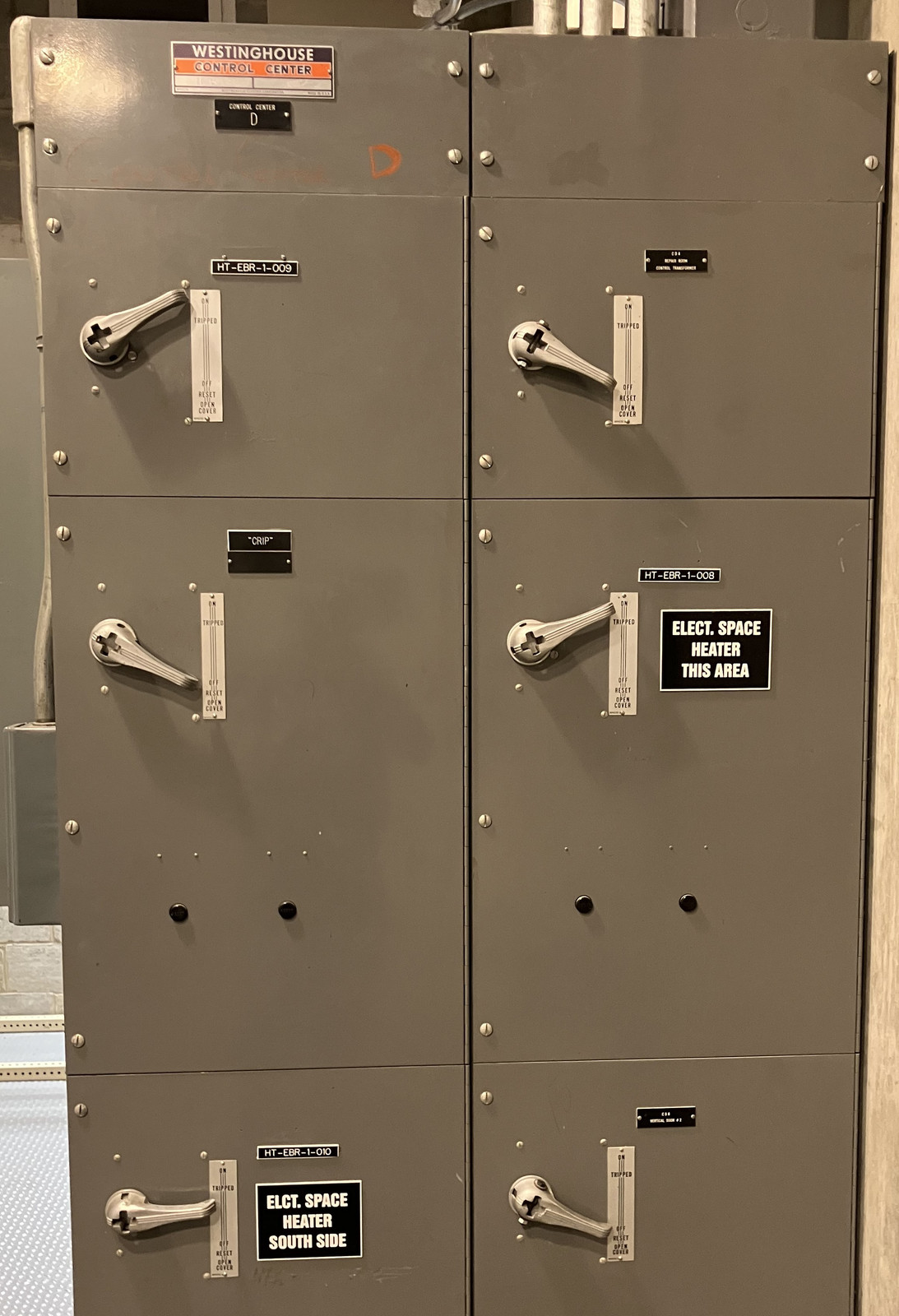
Some Other Systems
Over on one side of the first floor, there are another few fun systems laying around. There’s the argon gas system, which was, among other things, used to help isolate the heat exchanger loops from each other, and I believe also covered the coolant in the reactor (since NaK doesn’t get along with air, water, or much of anything else). It would seem that keeping pressure in those systems was really important. I also appreciate the “Evacuation Horn Relay” box, being on both normal end emergency power. It makes sense - when it’s time to get out, you really don’t want ambiguity!
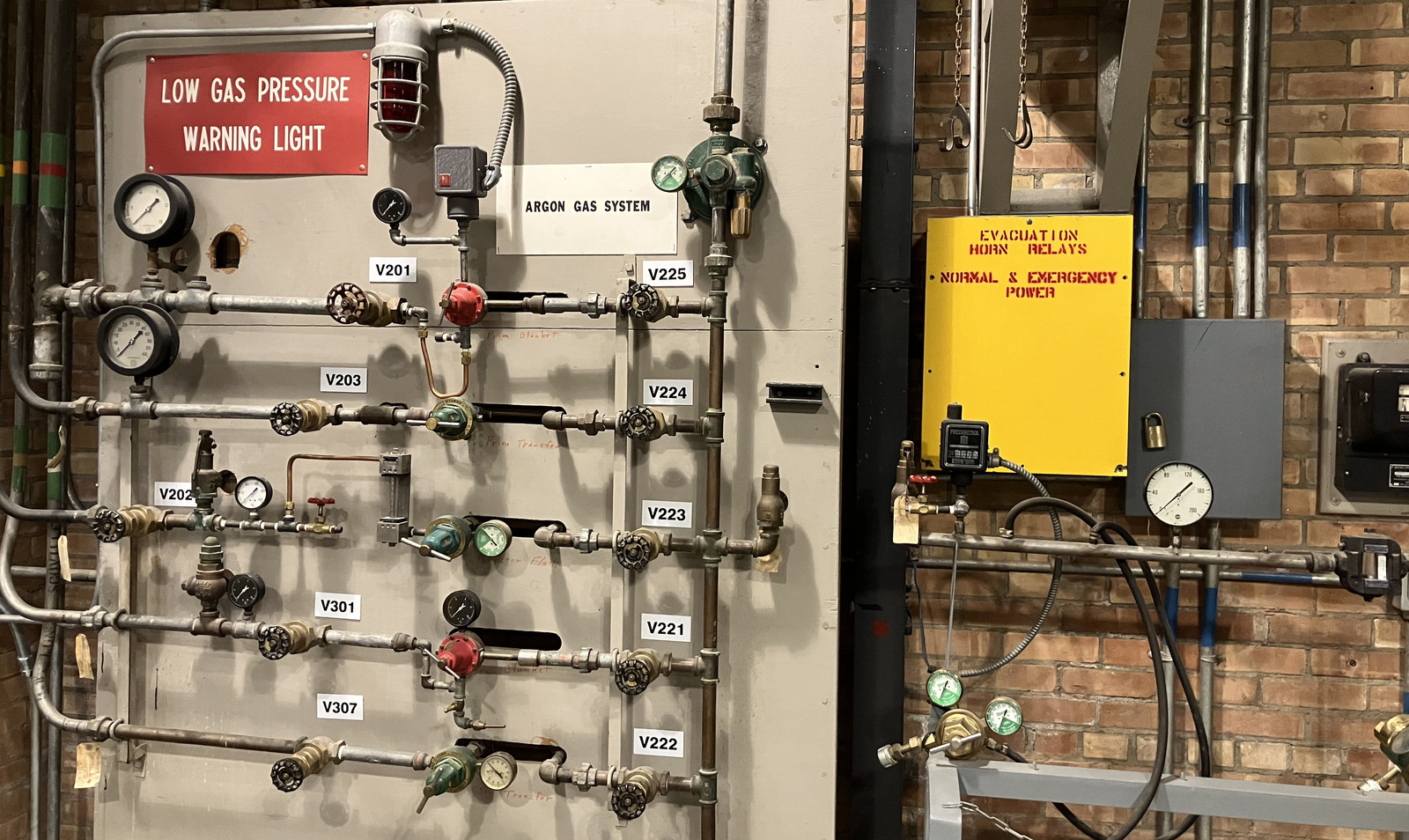
There is also a Buda-Lanova diesel attached to a generator, presumably as a backup generator to keep things powered if the grid went down. I have no idea how much it was used, but it’s a fun little beast!
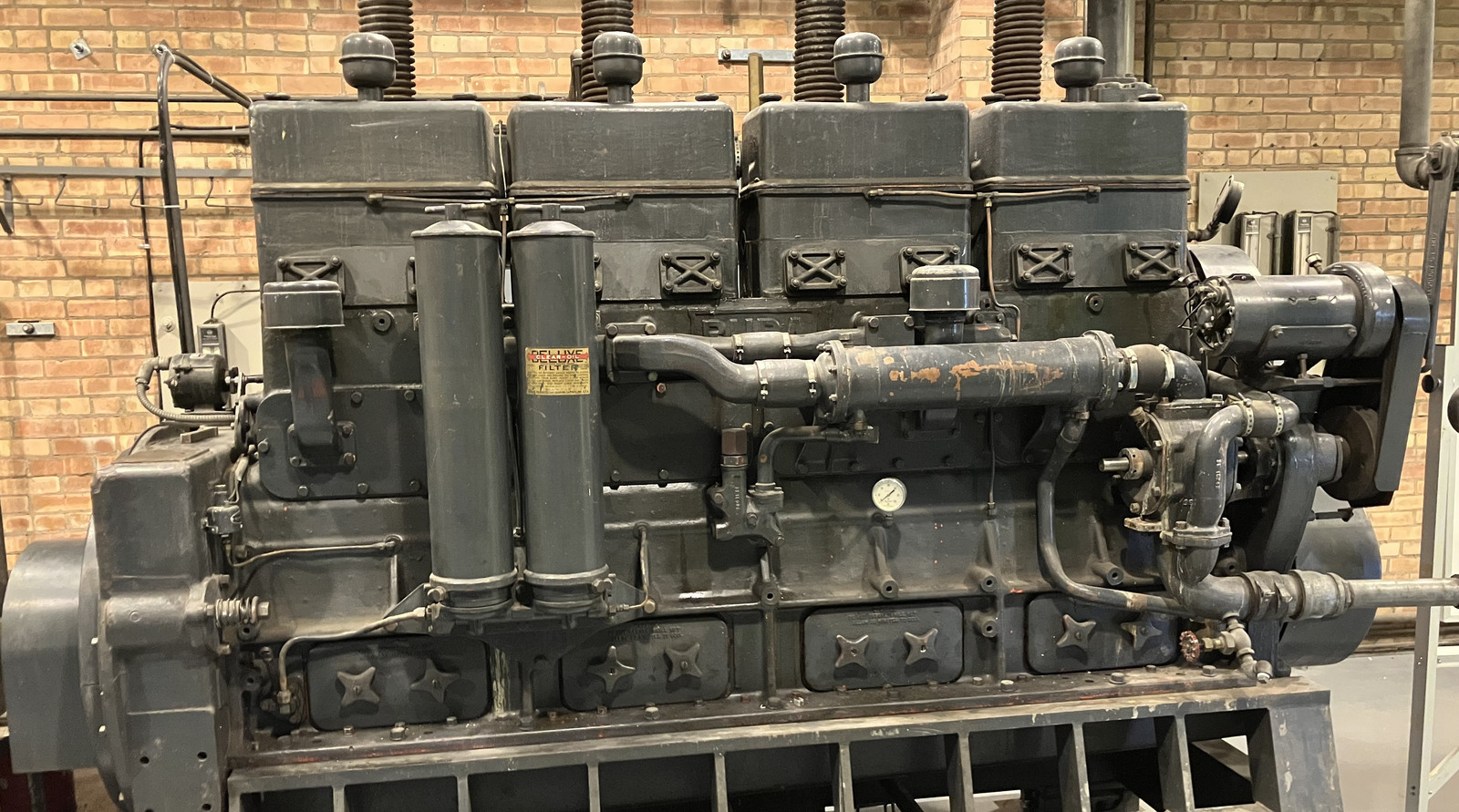
Based on the belt driven positive displacement supercharger on the front, I’ll assume this is a two stroke diesel, because that’s how those work - you just can’t do a sane two stroke diesel without forced induction.
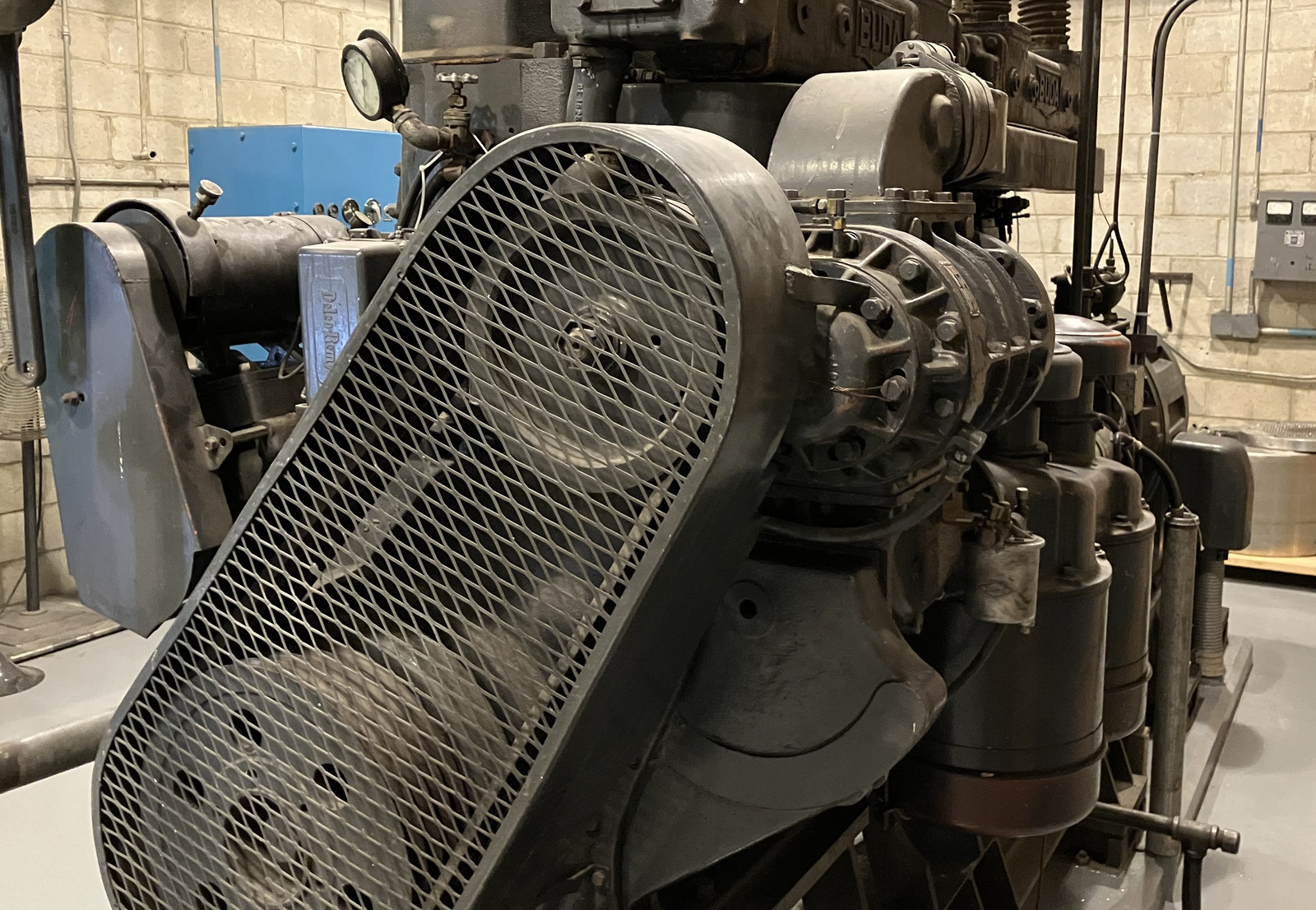
The engine is a Buda Diesel, 8DCS2505, with a 6 3/4” bore, and an 8 3/4” stroke, governed at 1200 RPM. I expect it’s quite loud!
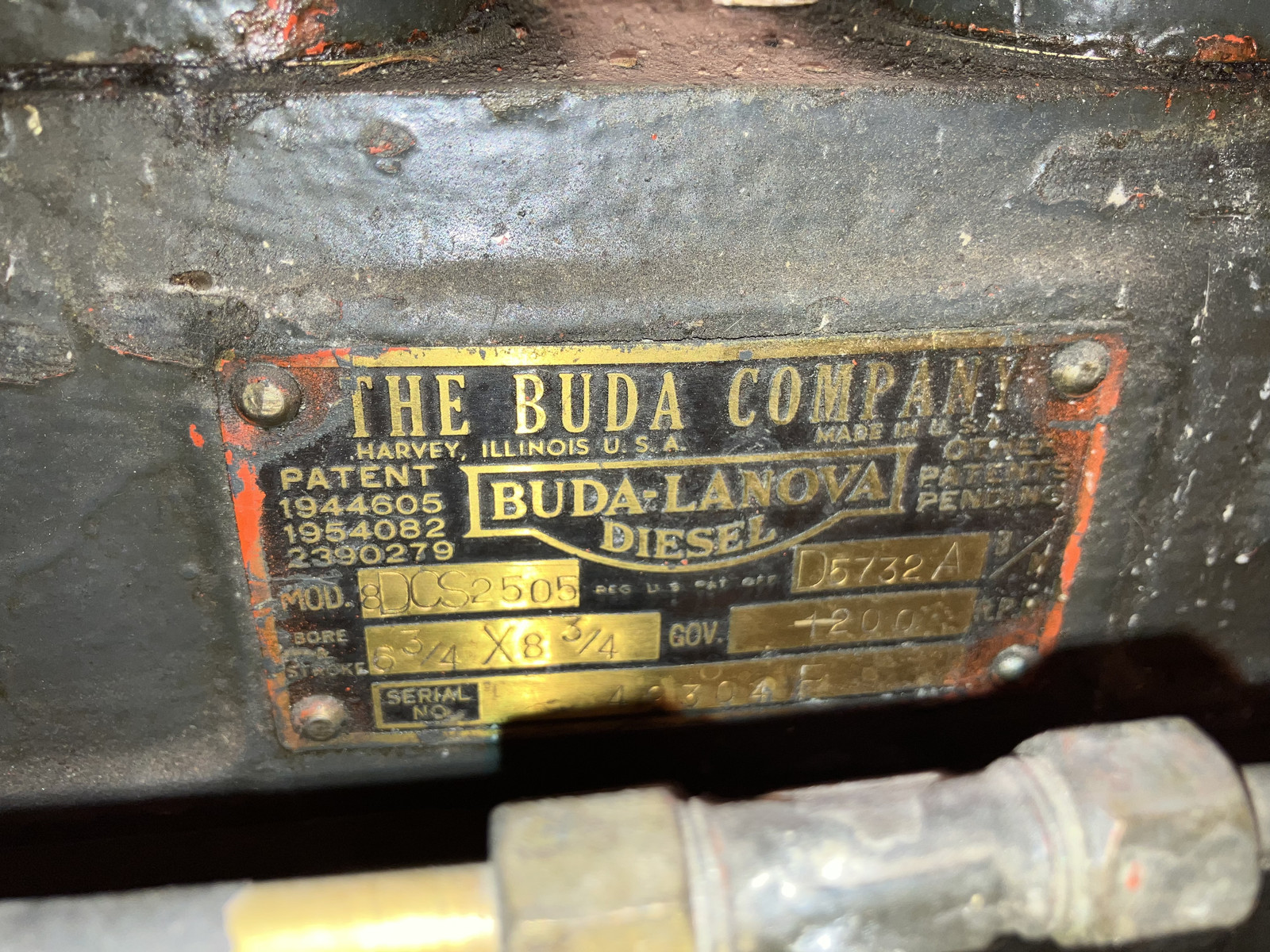
Three Mile Island Transport Vessels
As with any good museum building, there are some other exhibits in here as well. When Three Mile Island suffered their “nuclear oopsie,” or “nuclear whoopsiedoodle,” there was a good chunk of “stuff” that had to be moved. This is a test article from the design of a transport vessel (1/4 scale) that was designed to handle “everything that could happen during transport, and more.” This one is loaded with strain gauges to monitor what’s going on.
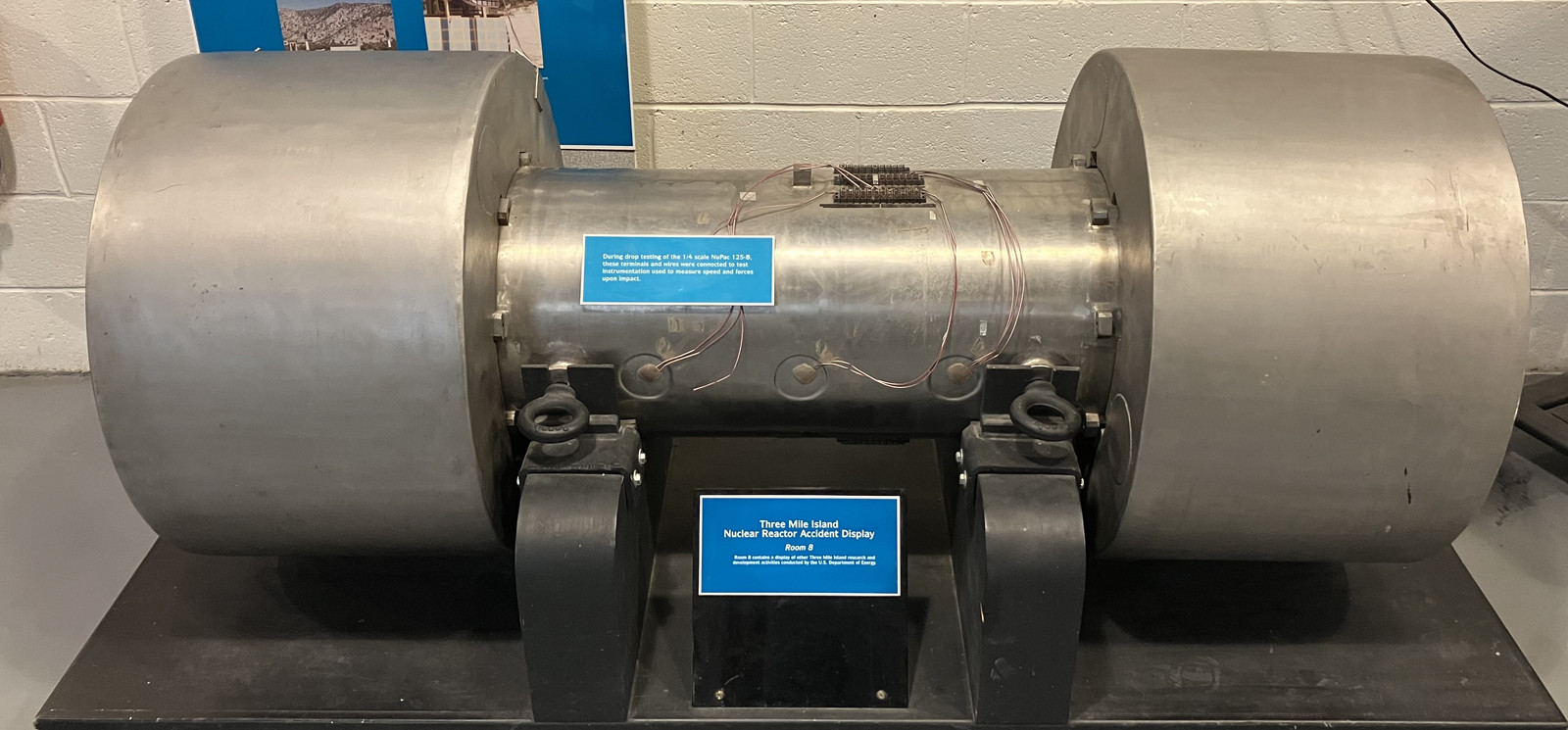
Before using these things, they subjected them to what would, now, be called the “Mythbusters Treatment.” Take a sample, and try to destroy it. It involved a lot of drops from 30’ onto hard surfaces, and if you look, you’ll notice that most of the impacts involve an already damaged test article. The goal was to ensure that no matter what happened, radioactive materials wouldn’t leak - and it seems to have been successful!
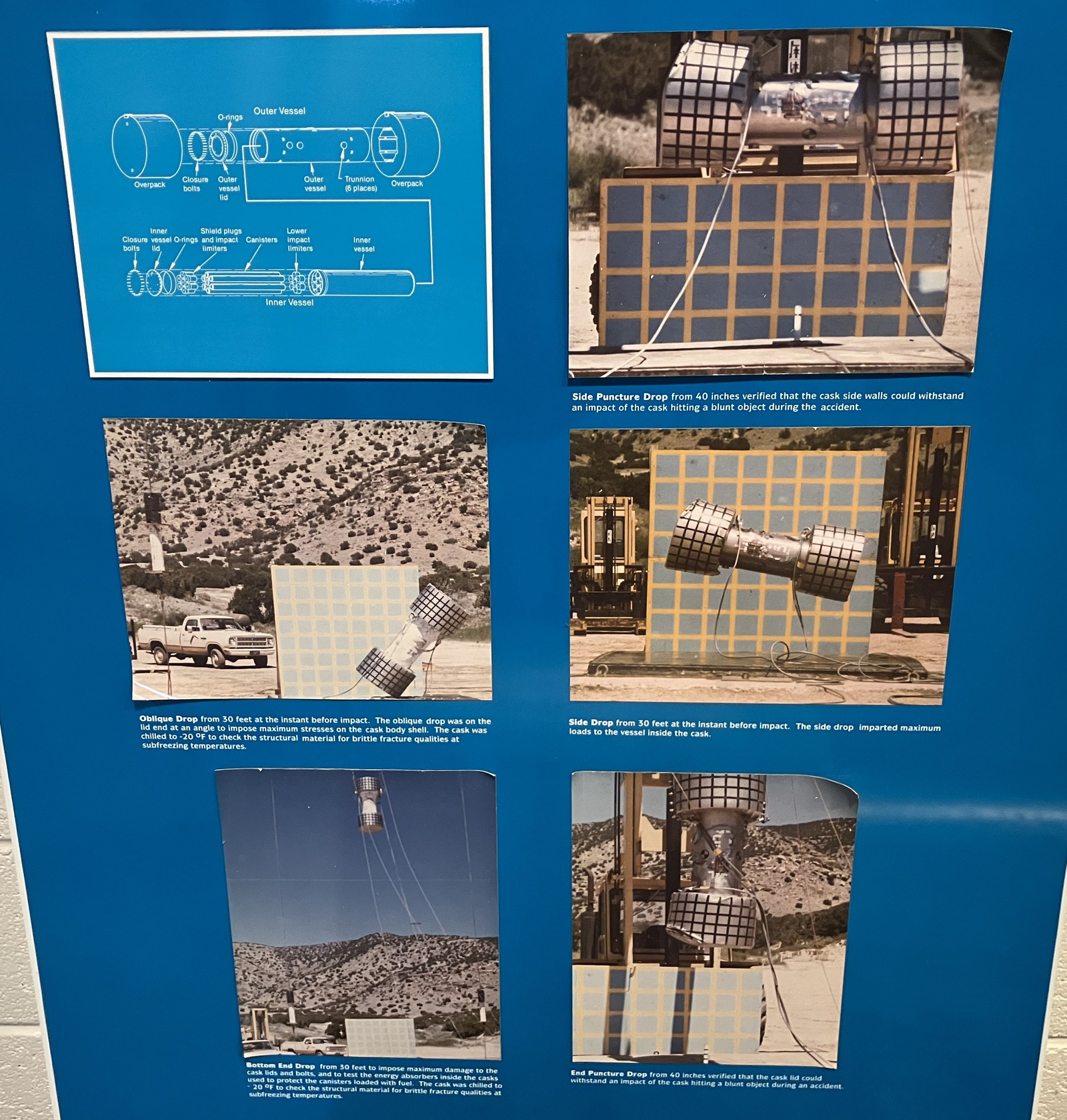
The Zero Power Reactor (ZPR-3)
Another exhibit in the corner is a replica of the Zero Power Reactor. This is a test unit in which samples can be subjected to radiation, without any serious power being involved.
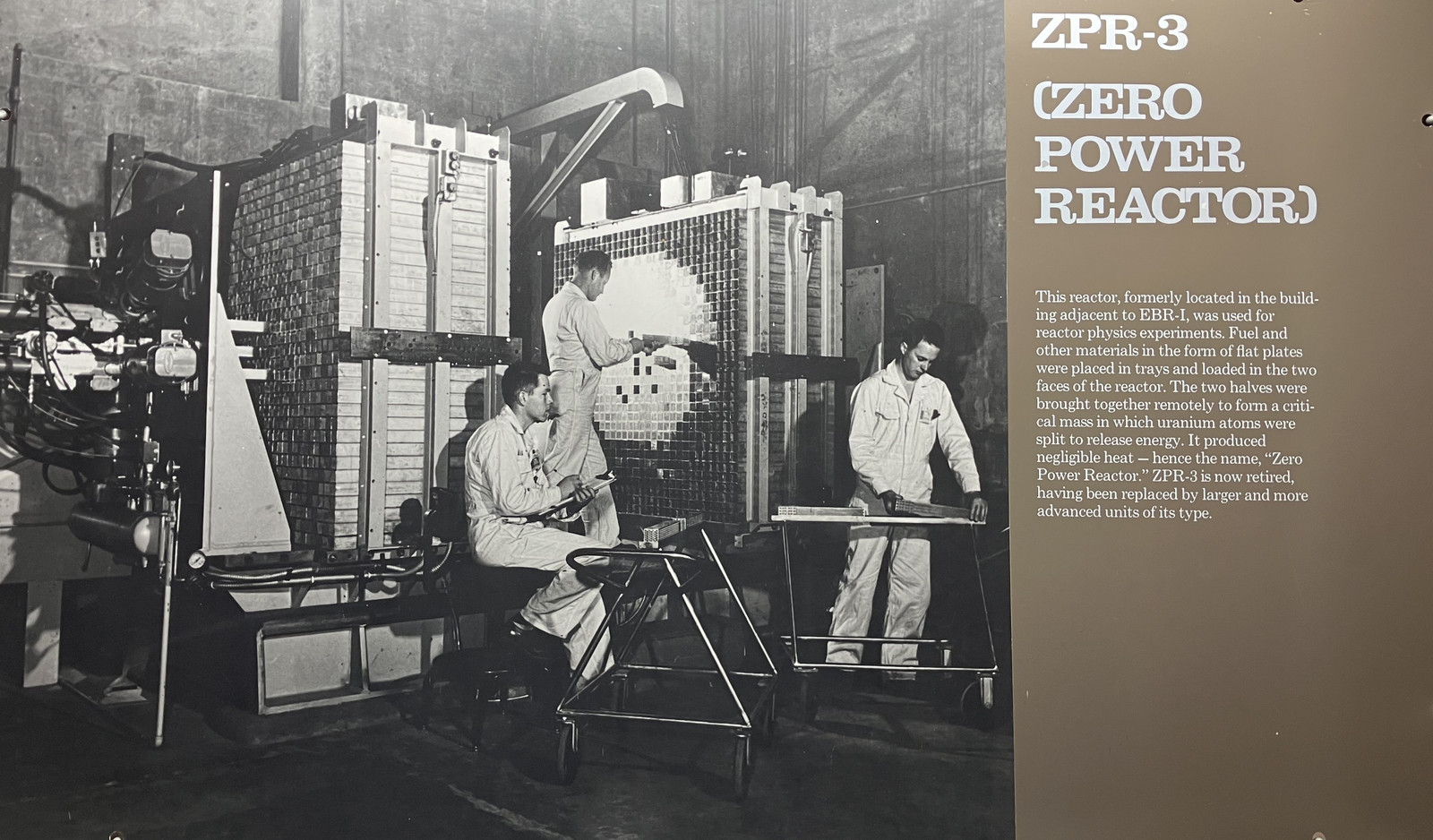
The reactor consists of two halves that can be brought together, forming a critical mass, with various test articles in between. I’m not actually sure what sort of experiments this would have been used for, but it’s a thing!
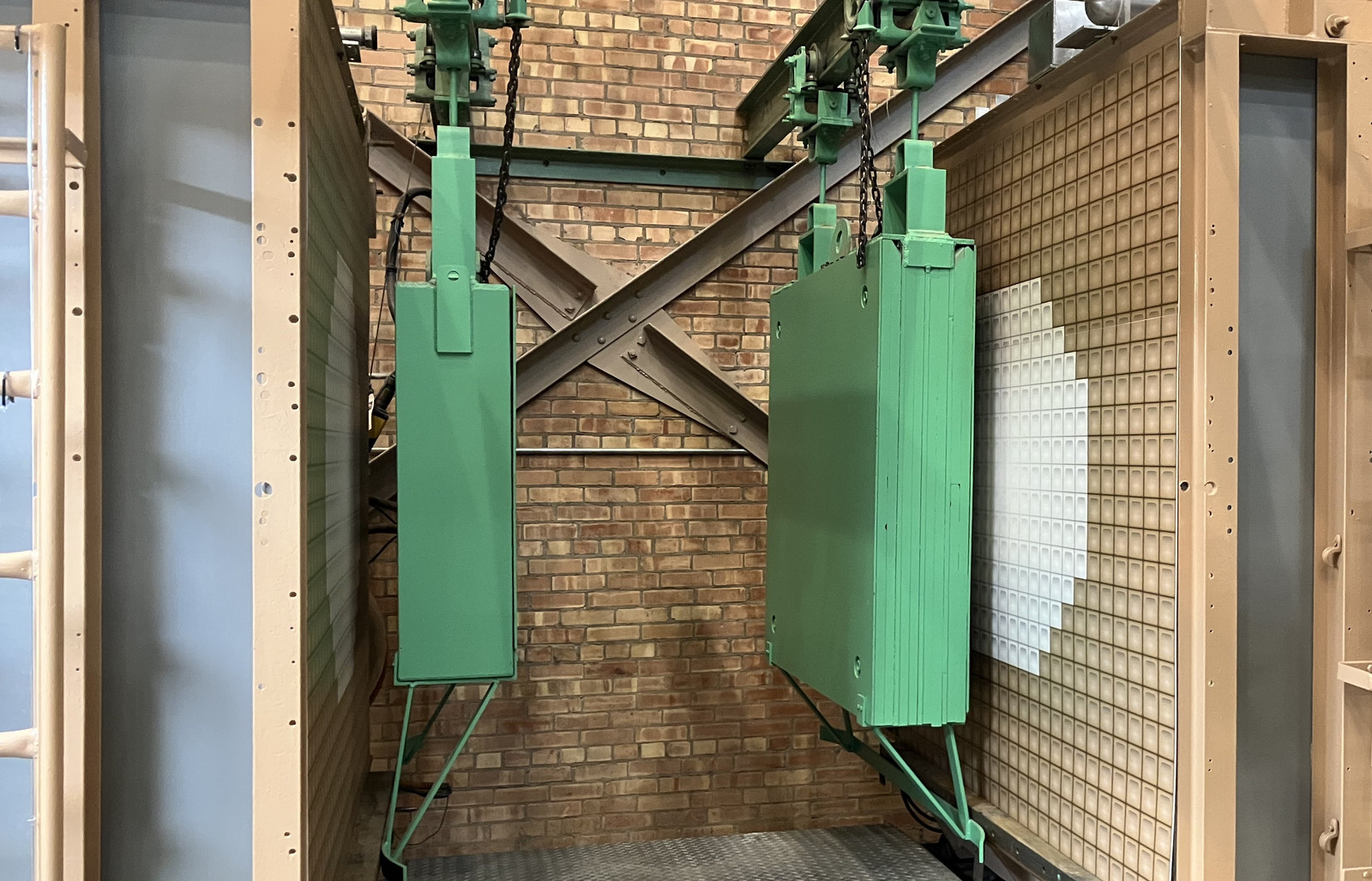
On the back of one of the ends, there’s a pile of linear actuators that can drive the face forward and backwards. It’s… irritatingly non-symmetrical, really. I’ve no idea why it’s five actuators, instead of four.
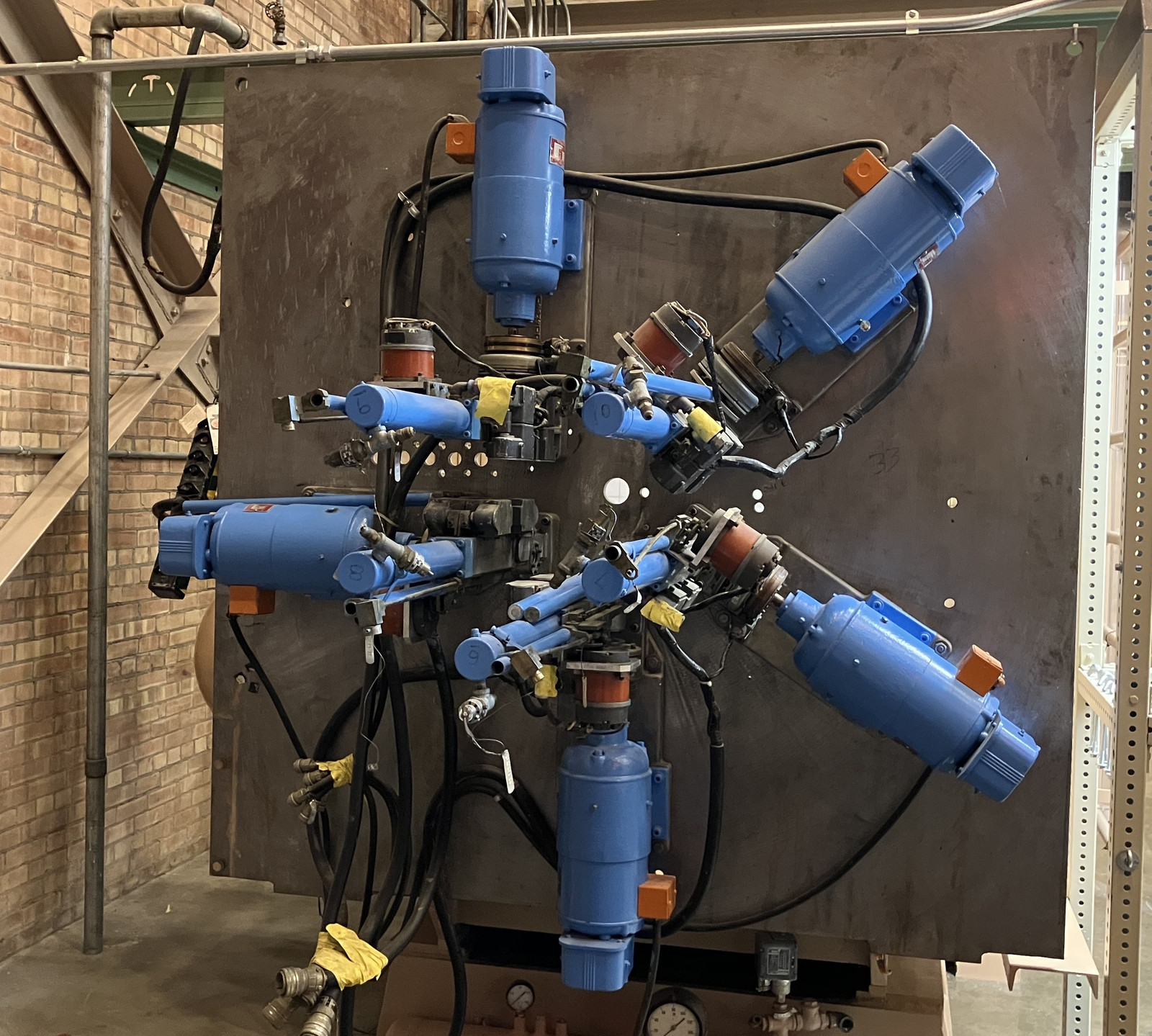
EBR-II Exhibit
Back in what I assume was once office space, there’s an exhibit on the EBR-II - a later version of EBR-I. EBR-II was a sodium cooled fast reactor with onsite fuel reprocessing, designed to demonstrate the safety and functionality of this sort of reactor design. EBR-II ran for 30 years, generated an awful lot of power, and demonstrated the safety of the fast metal cooled reactor design quite well - though, of course, we don’t use those now.
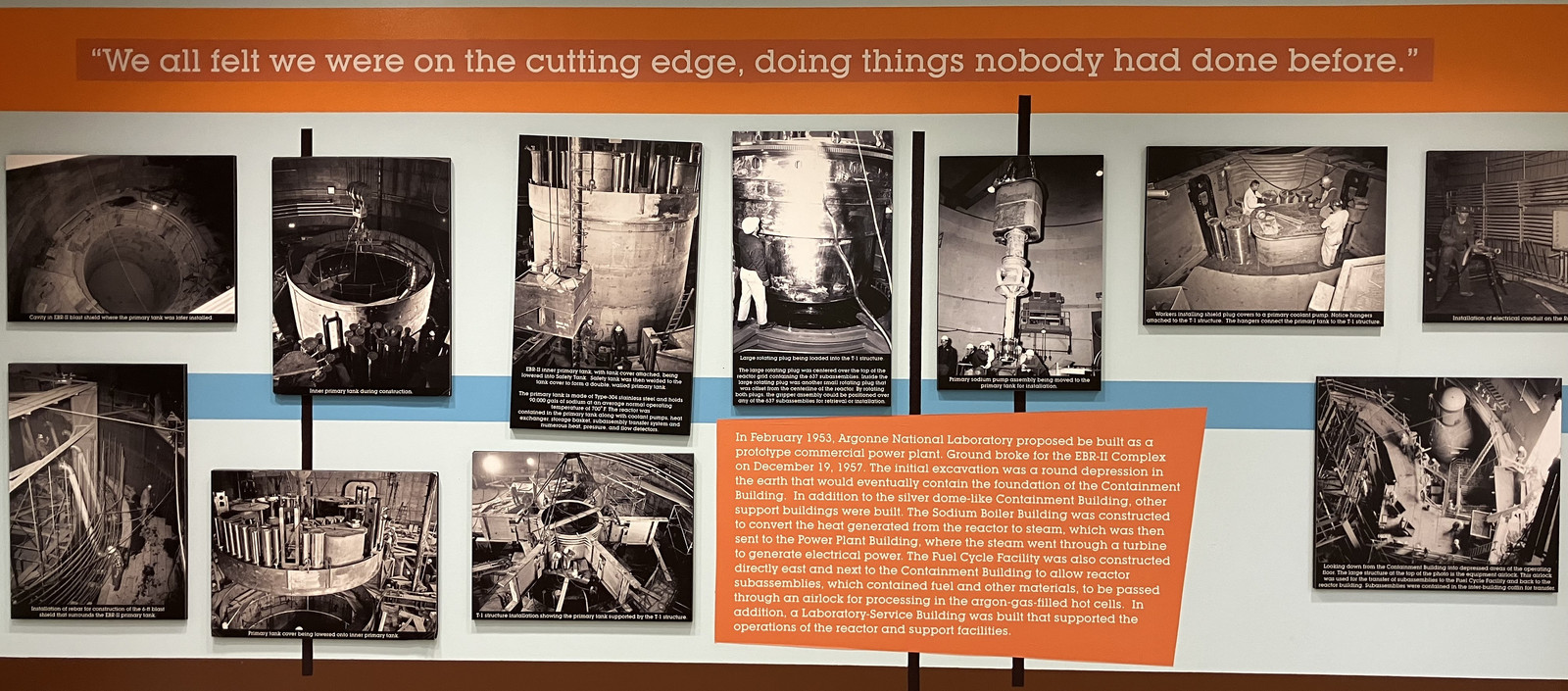
While not the “real control room” of EBR-I, they’ve got a decent looking replica control room, though it’s mostly intended to make the point that nuclear power is safe and reasonable.
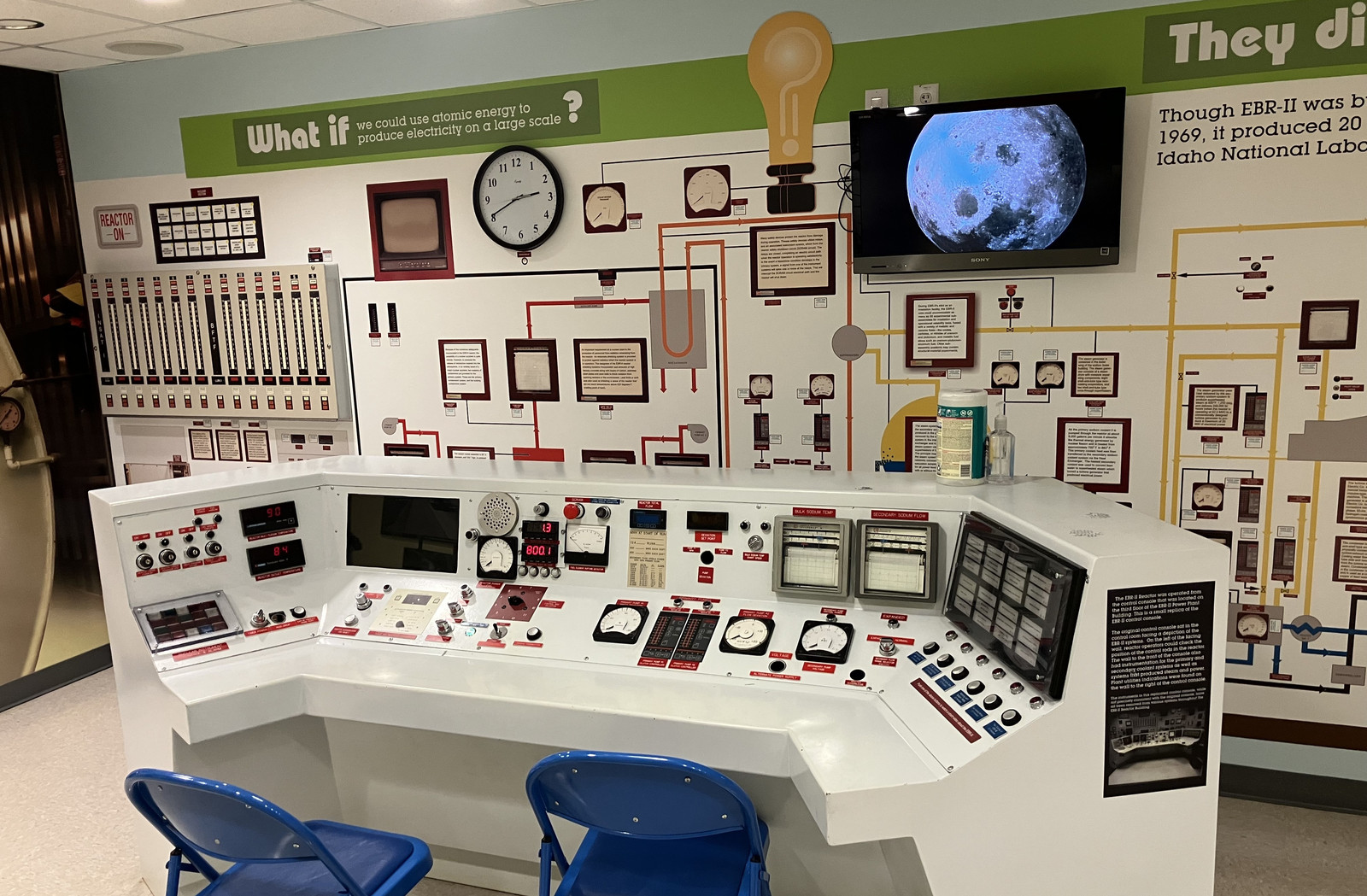
One of the major development questions with nuclear reactors was, “How do they handle weird events?” EBR-II, being experimental, was able to answer these questions: “Just fine.” They did multiple tests involving shutting down the reactor by stopping coolant flow, and the reactor handled it just fine, with no meltdowns, no leaks, and simply worked as designed. You really can’t ask more from a reactor than “cutting power to a safe, sustainable state” - and EBR-II handled that perfectly.
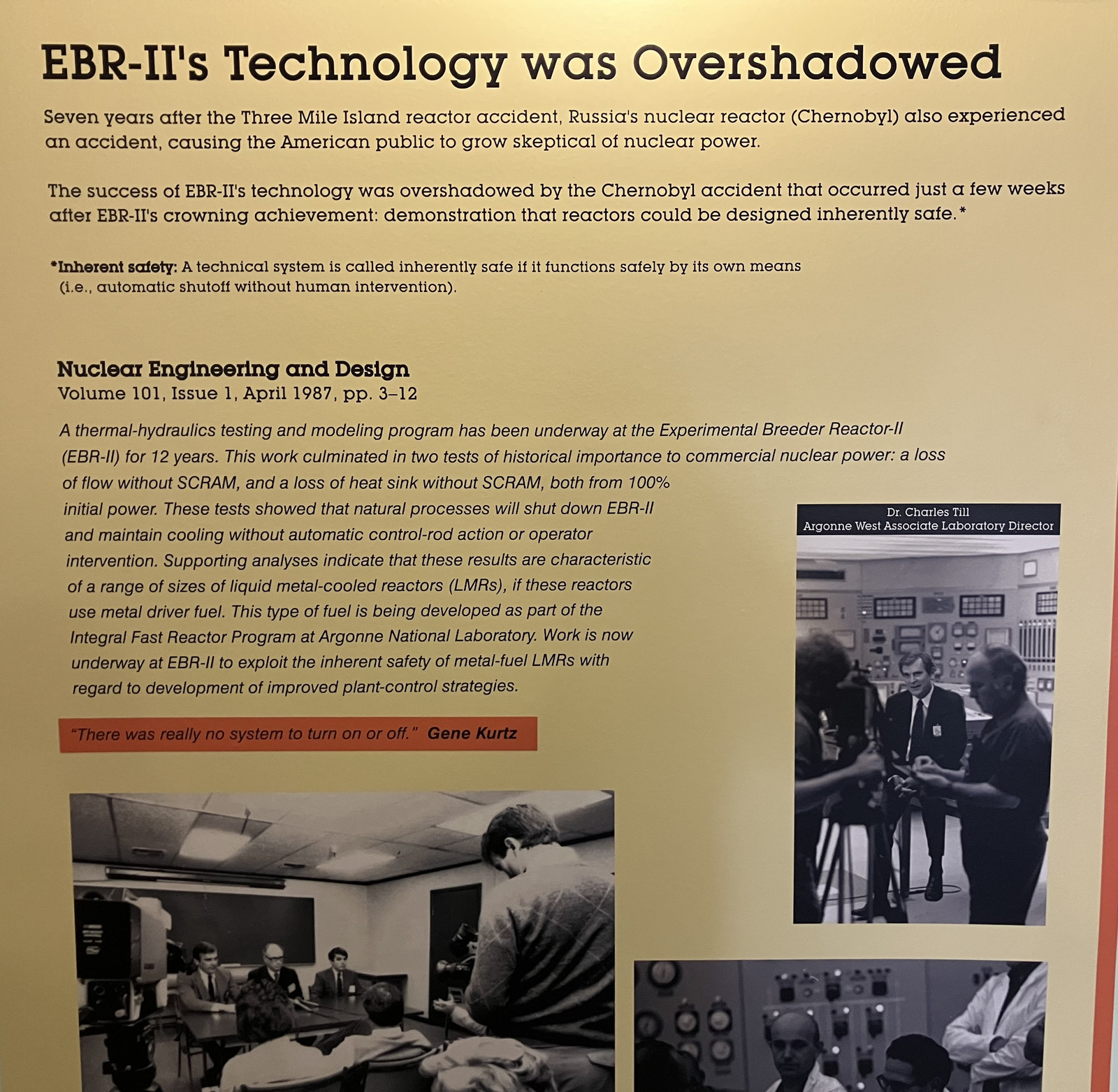
Another major advantage of “breeder reactor” designs is that they burn up most of their waste. They don’t leave the nasty middle-halflife materials that are such a pain to deal with in storage - they burn them up in operation. The waste from a breeder reactor is either exceedingly hot (short halflife material, which doesn’t require long to decay to a stable state), or “cold” (very long halflife, and therefore isn’t a major problem to deal with).

Some demonstration models of the EBR-II fuel rods are on display as well. The top assembly is an EBR-II driver fuel subassembly, with the middle rod being a blanket subassembly (containing U-238 to breed). The bottom rod is a complete fuel assembly, not sectioned. I am, unfortunately, unclear on what a “Control Rod Thimble” is, and why it might need to be removed.
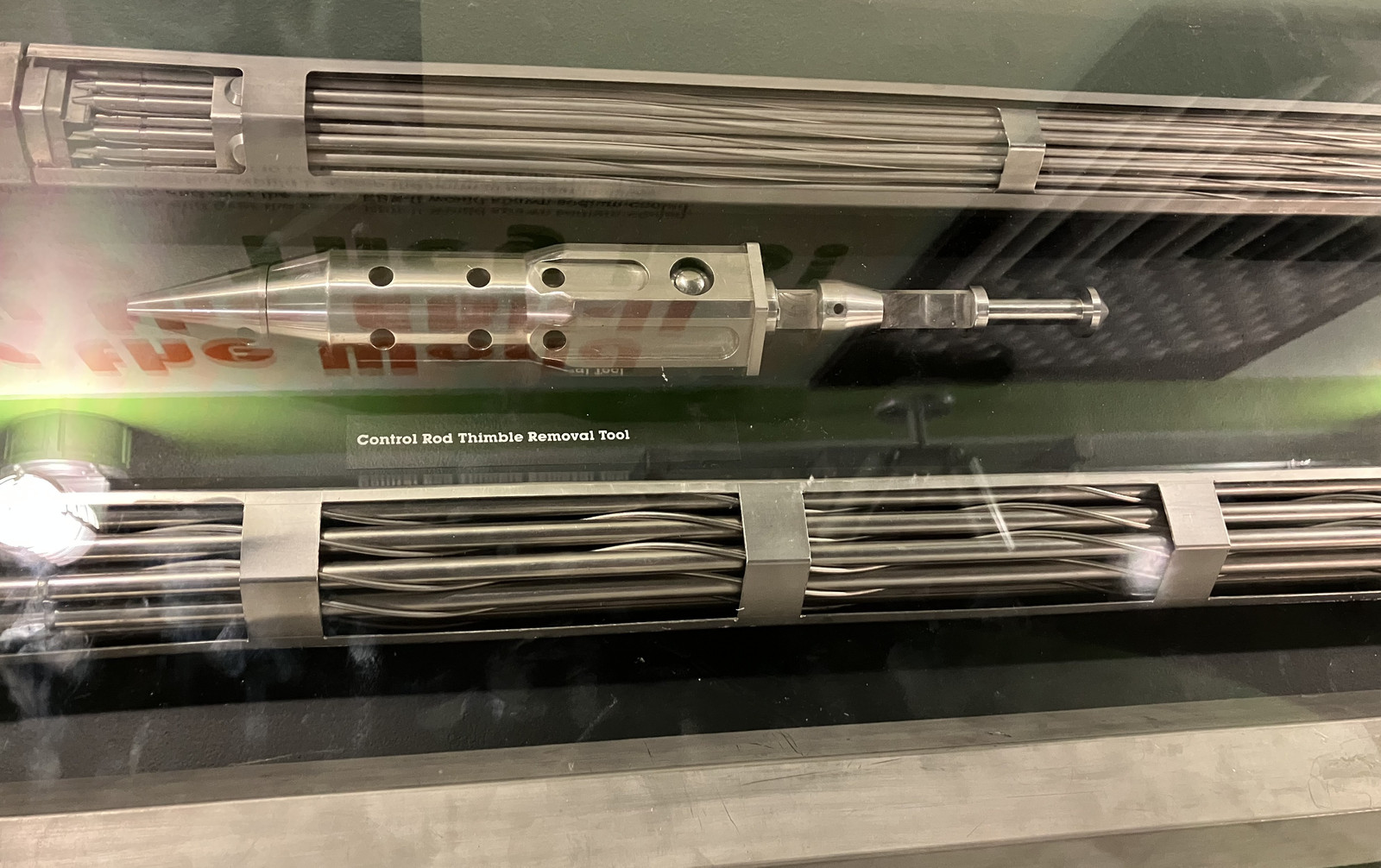
There are also some wonderful sequence control panels on display. They’re not well explained, but seem to consist of a set of steps for various processes, with labels for each stage. It seems to be an “automated checklist” sort of system, which I have to say, I like! Especially in the discrete light form!
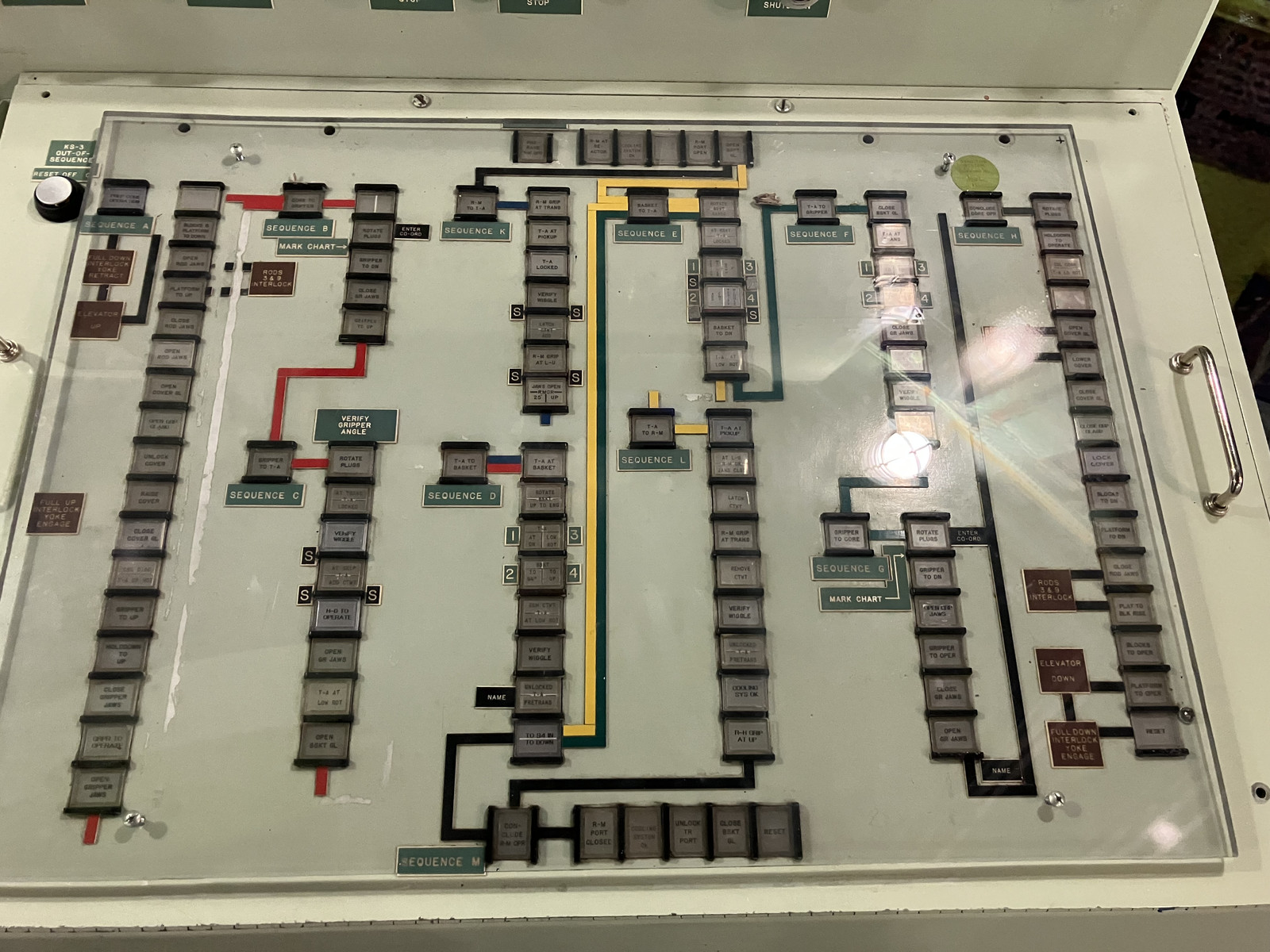
EBR-II also generated quite a bit of steam heat for the tech areas. If you’ve got a nuclear reactor, you may as well use the waste heat from the system to heat buildings! I’m reminded of a particularly strange mammoth from “The Way Things Work” books that generated a good bit of steam heat without much in the way of fuel consumption, though you didn’t want to be near the pellets coming out the back end…
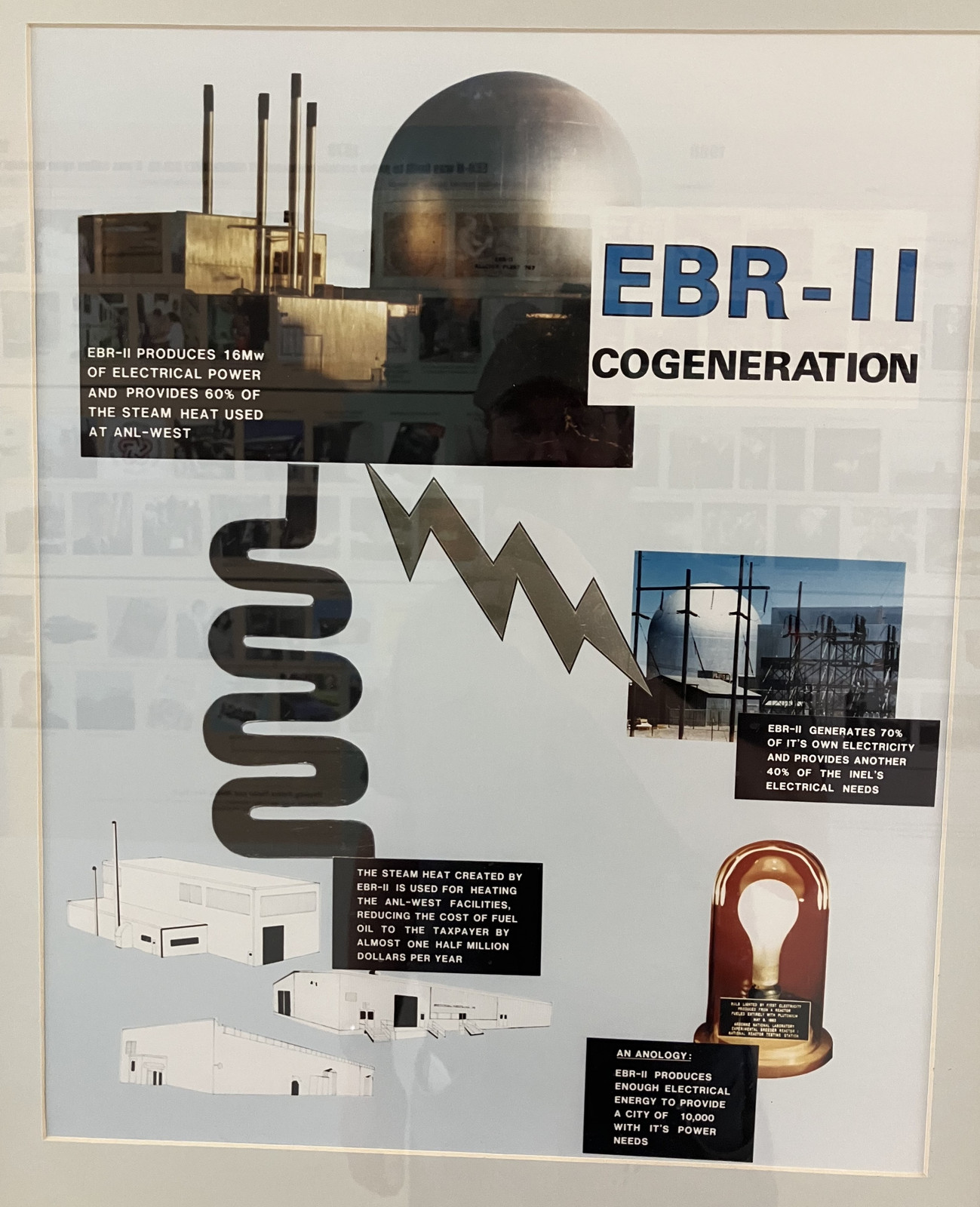
Go Visit EBR-I!
if you’re still reading, you know you want to go visit the place. It is a wonderful museum that I cannot suggest highly enough!
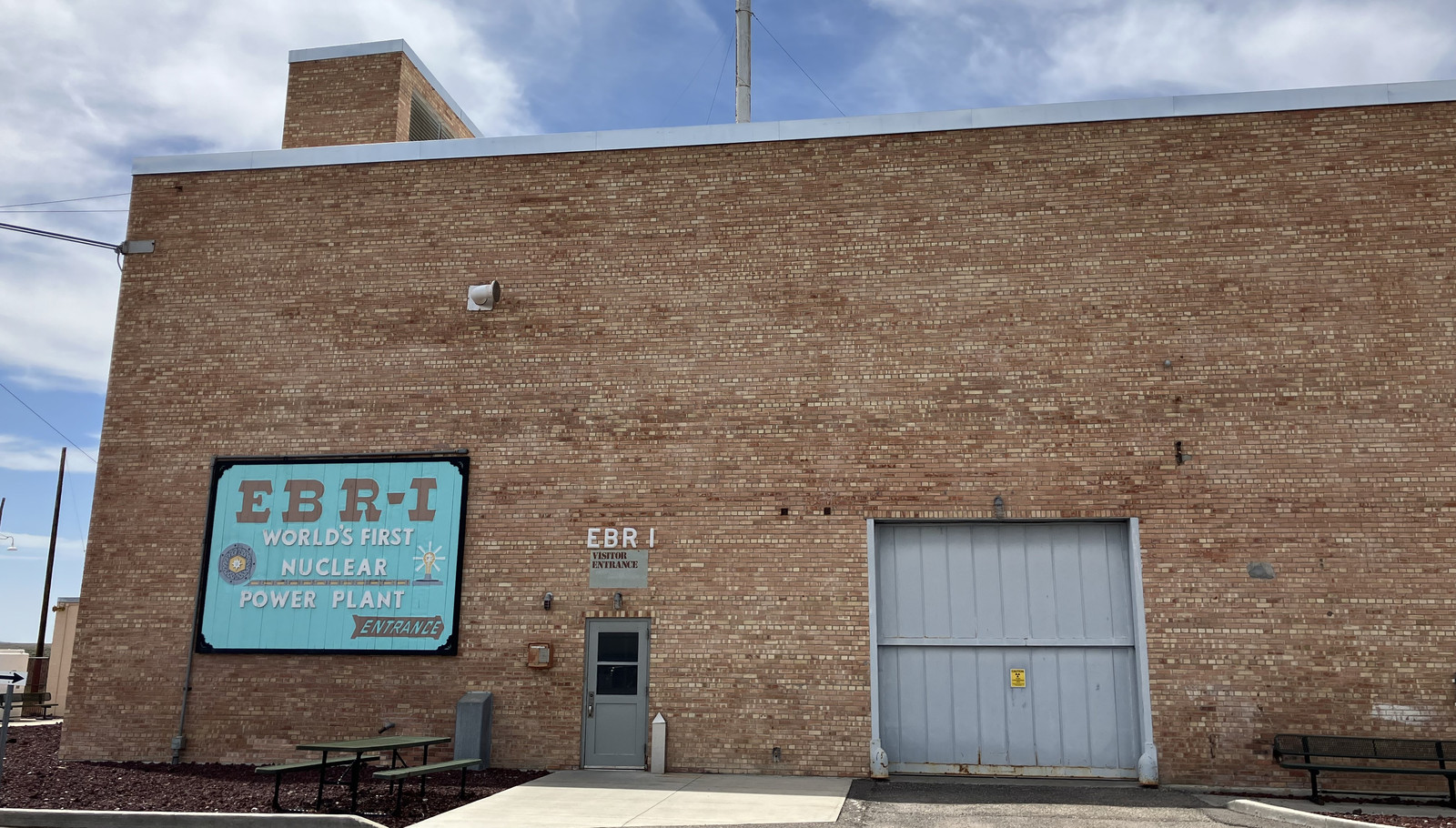
Thoughts on the VW i.Q.Drive.whatever System
I spent a while on Highway 20 playing with the VW I.Q.Drive.Adaptive.Whatever system that my rental car had installed. It’s adaptive cruise control, and some general variety of “mildly hands off lane keeping” system. I’ve not had a chance to play with this sort of thing before (other than a very brief chance to drive an older Tesla’s autopilot system, which I found absurdly aggressive about staying exactly where it wanted in the lane, and your opinion was ignored, even with obstacles along the side of the road). This system seems far better thought out as a “long distance assist” sort of system, and will generally guide the car along in the lane, following the road, but it doesn’t seem to have an excessively strong opinion about where in the lane you are. You’re free to guide it back and forth in the lane, and it won’t fight you beyond a desire to stay in the lane. If you head towards the edge of the road, it will nudge you back in a bit more aggressively, but you’re still the final say on the matter, and you must remain human in the loop. It starts complaining at you very quickly if it doesn’t sense any steering advice from the driver, and at 15 seconds it starts beeping loudly and flashing red alerts at you. I’m not sure what it does beyond that point, as I didn’t feel like experimenting quite that much.

This, combined with the adaptive cruise control (which will “follow the car in front of you, and slow to match them”), did seem a nice enough system to drive, though I’m not sure how much mental effort it saves versus just driving a car that tracks more or less straight. I had to be constantly “proving to the car I was still there” with steering inputs, and it felt like I was spending a lot of time glancing at the dash to see if the car was suitably happy with my latest set of inputs (versus showing the “Hey, you, steer somehow!” icon or alert). It certainly will help prevent inadvertent lane departures, but so will a lane departure warning system that requires the human be somewhat more in the loop. This system strikes me as the sort of “really hazardous middle ground” between “driver assist” systems (where the driver is doing all the work and they watch the driver), and a fully capable autonomous system (“Full self driving”). This is good enough that I can see it easily lulling drivers into a sense of complacency (“Oh, it’s fine…”), and just intermittently tapping the wheel, not really paying full attention to the road. It’s interesting, but I’m not sure I think it’s a great thing. More thoughts on automation below, though…
The Round Engine Roundup
When I got back to the airport, someone pointed out that the Round Engine Roundup was going on this weekend, and I might care to go wander the hanger for a bit. Well, with an invite like that, who could refuse? I love old radial engines, and they are responsible for some of the best looking airplanes around, in my opinion. I don’t care that a modern Cirrus or something is more efficient, these planes just look good.
Starting out, this is a beautiful 1944 Howard DGA-15. Old airplanes are still perfectly usable ways of getting around!
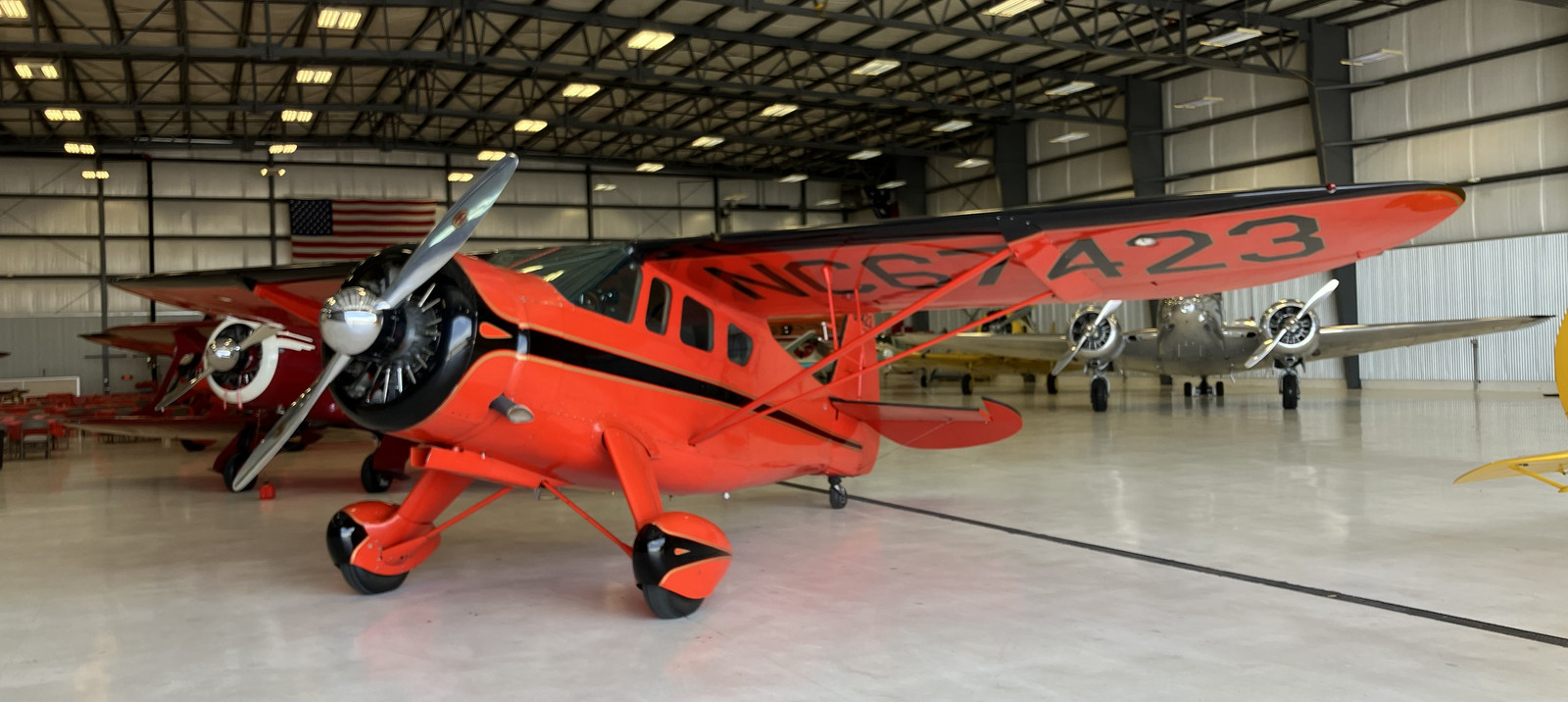
There were a lot of Beech Model 17 Staggerwings here - at least 8, possibly 9. Produced from 1932 to 1949, they’re unusual in that the lower wing is ahead of the upper wing - most biplanes are the opposite. They’re just pretty airplanes, and I’d love to fly one at some point.
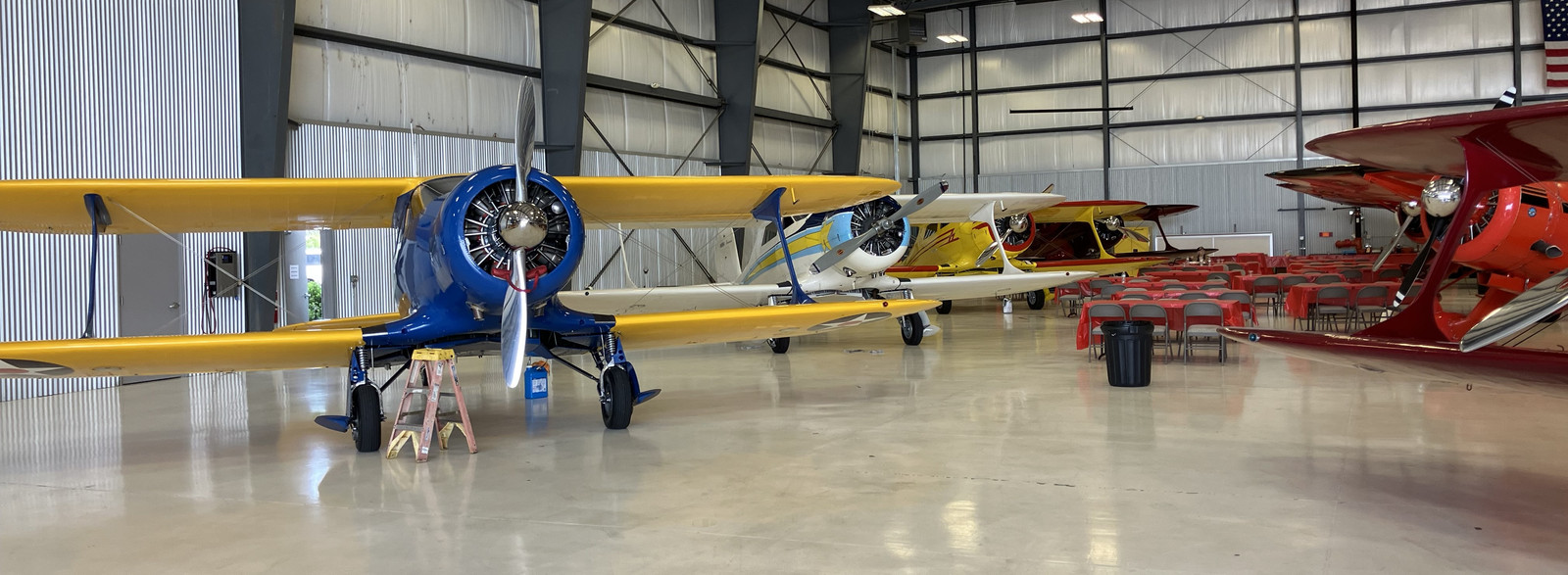
Would you like a DeHaviland Beaver on floats? I know at least one reader will!
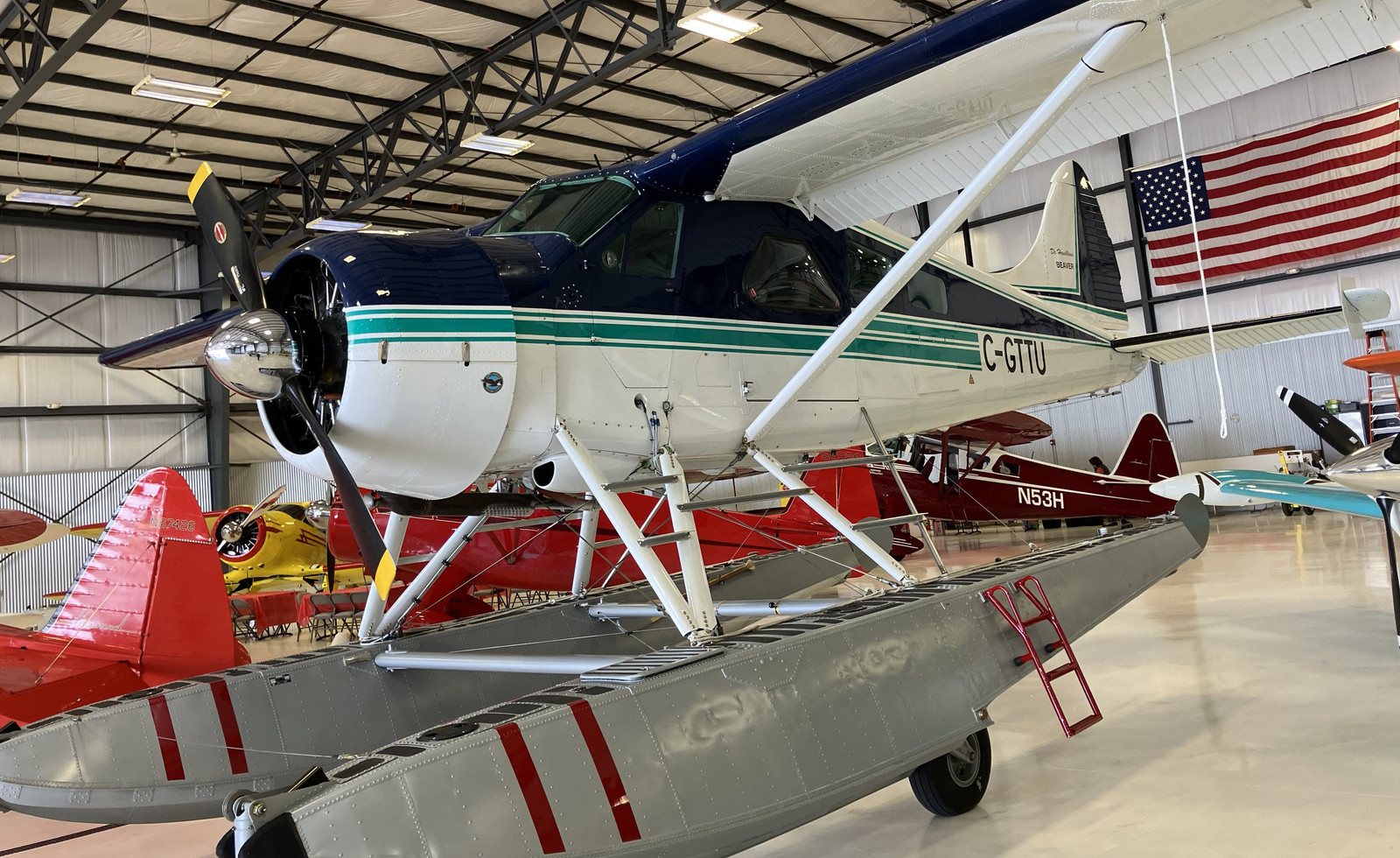
Do I want to maintain a polished aluminum airplane? Having other things in life to do beyond “polish aluminum,” I’m not sure I would want to own one. But when they’re polished up, wow do they look good! This is a Beechcraft Model 18, with a pair of 450HP R-985s.
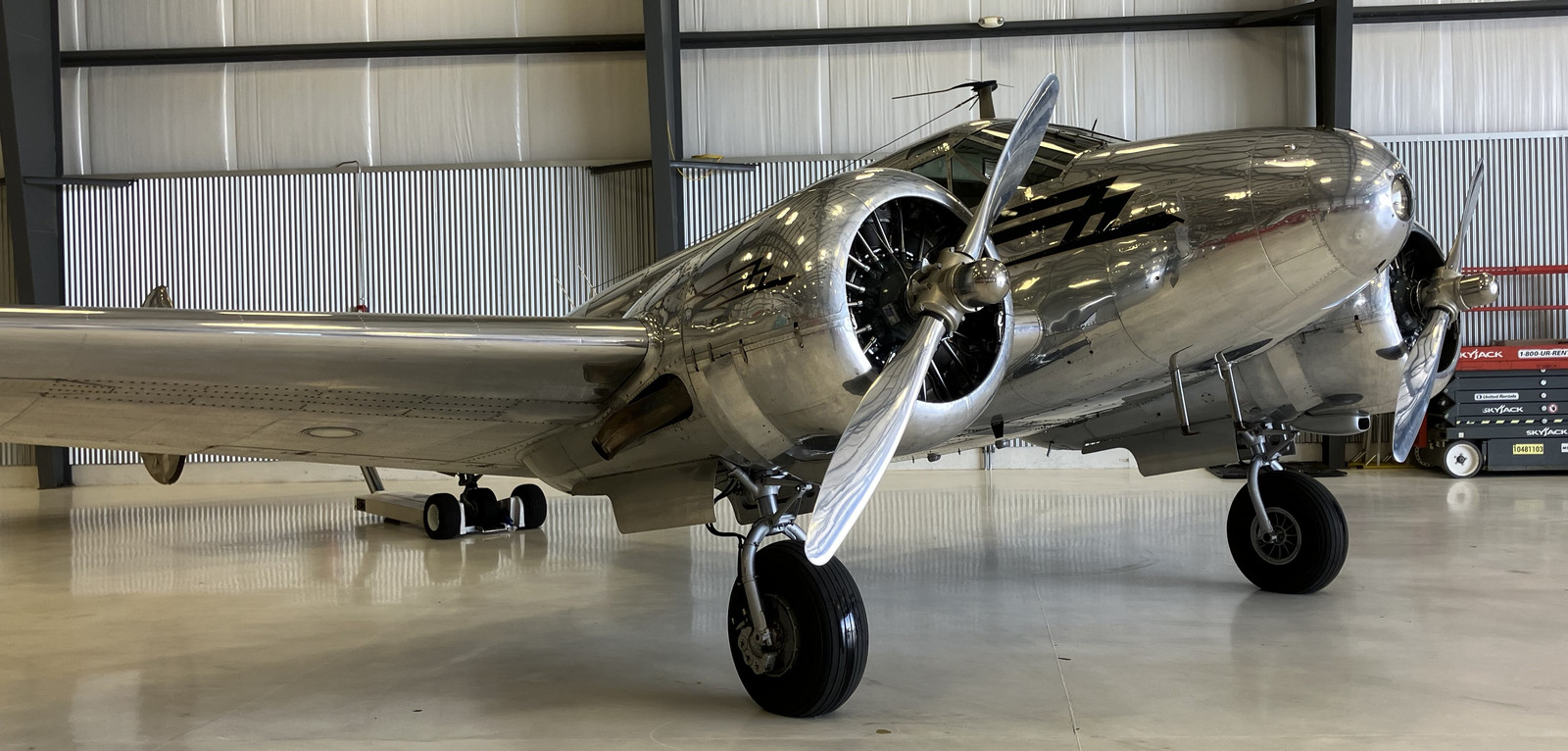
You, and all your friends, can travel in significant comfort. I’m not sure how many seats this one has, but the model ranges from 6 to 11 seats, depending on configuration.
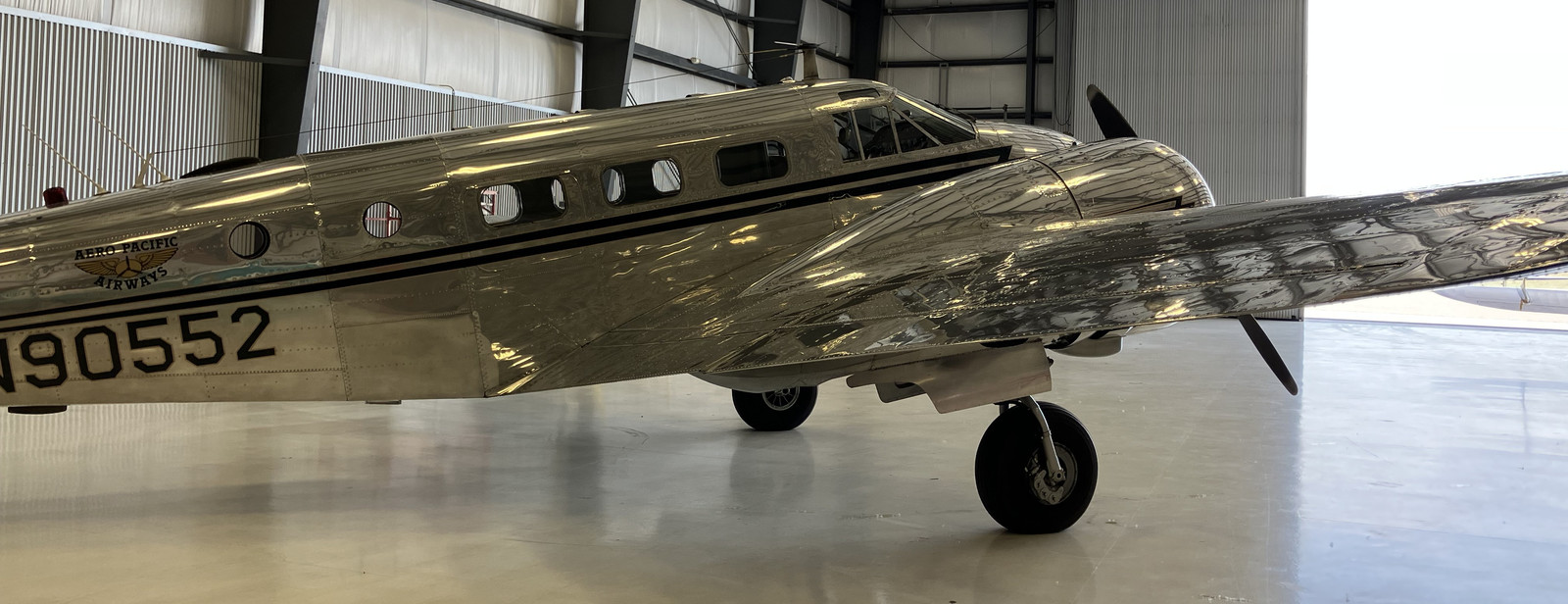
And then back to my Cessna, which… well, I’m not too picky about airplanes, because it flies, and I’m not tailwheel rated yet. I should fix that one of these years…
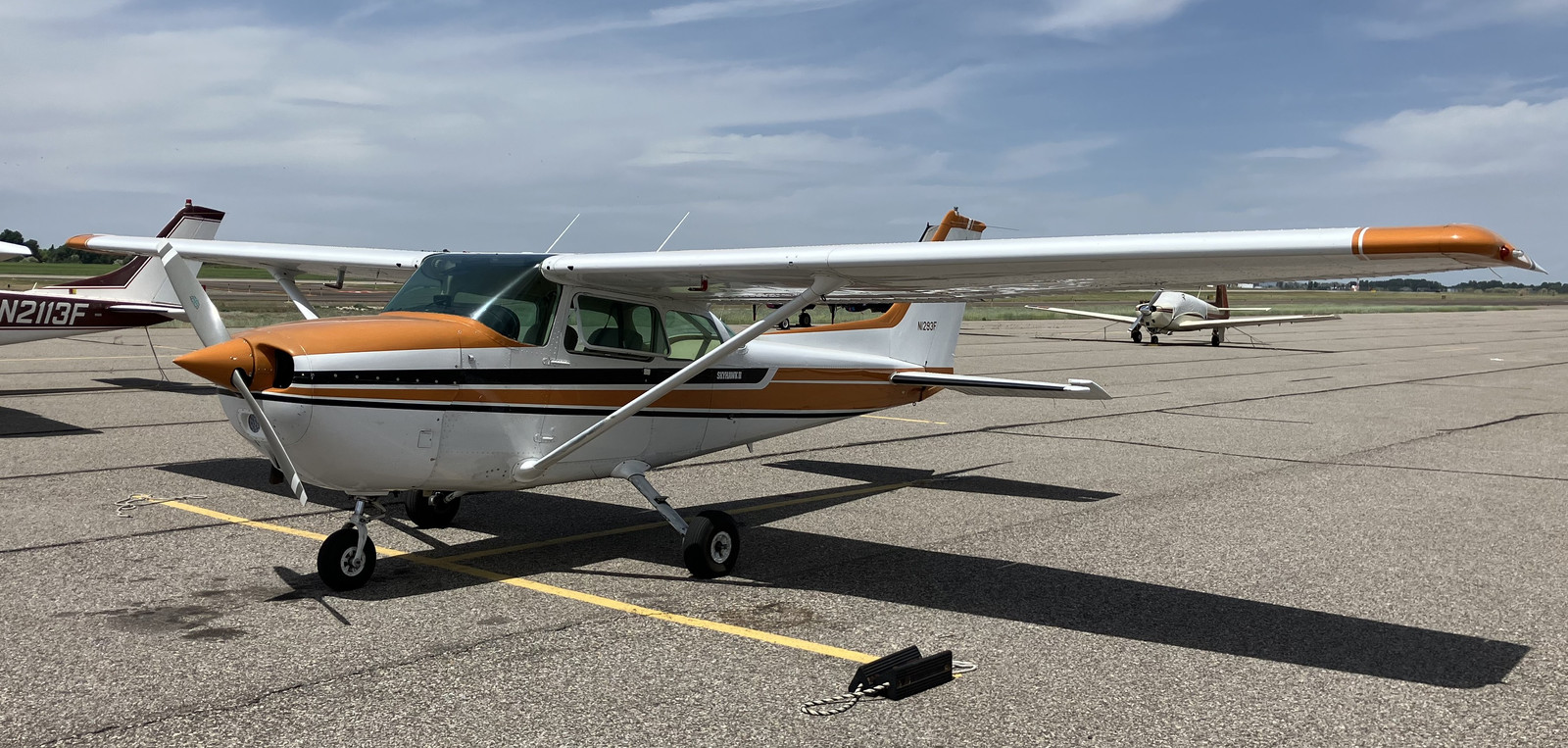
Flying Back: Headwinds and More!
Yes, that’s a commercial jet protected from me by a few lines on the pavement back there. Aviation is really cool, in so many ways, and one of them is that if you’re a pilot, you’re basically trusted to “not screw things up.” No, I probably couldn’t walk over to the jet without someone wondering what I was doing, but as far as the rest of the ramp area goes, pilots are generally trusted to not mess with things they shouldn’t.

I still don’t understand why people get so worked up over “crop circles.” They’re just rotary pivot fields… ;)
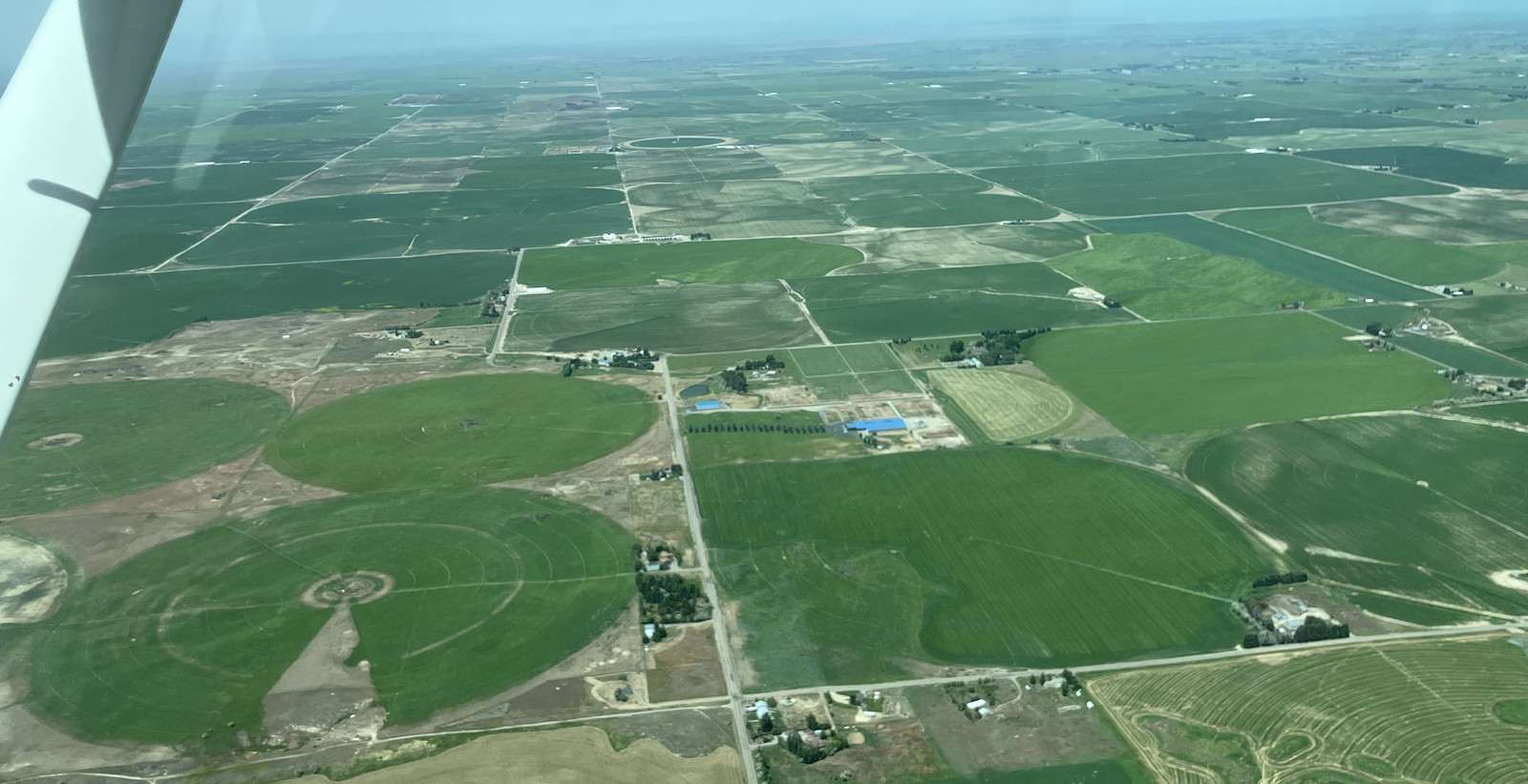
This is “Atomic City.” The runway is crushed volcanic cinders, and the crossing runway appears rather overgrown. I’m sure it gets a little bit of use, but I’m not inclined to land there without some really good reason.
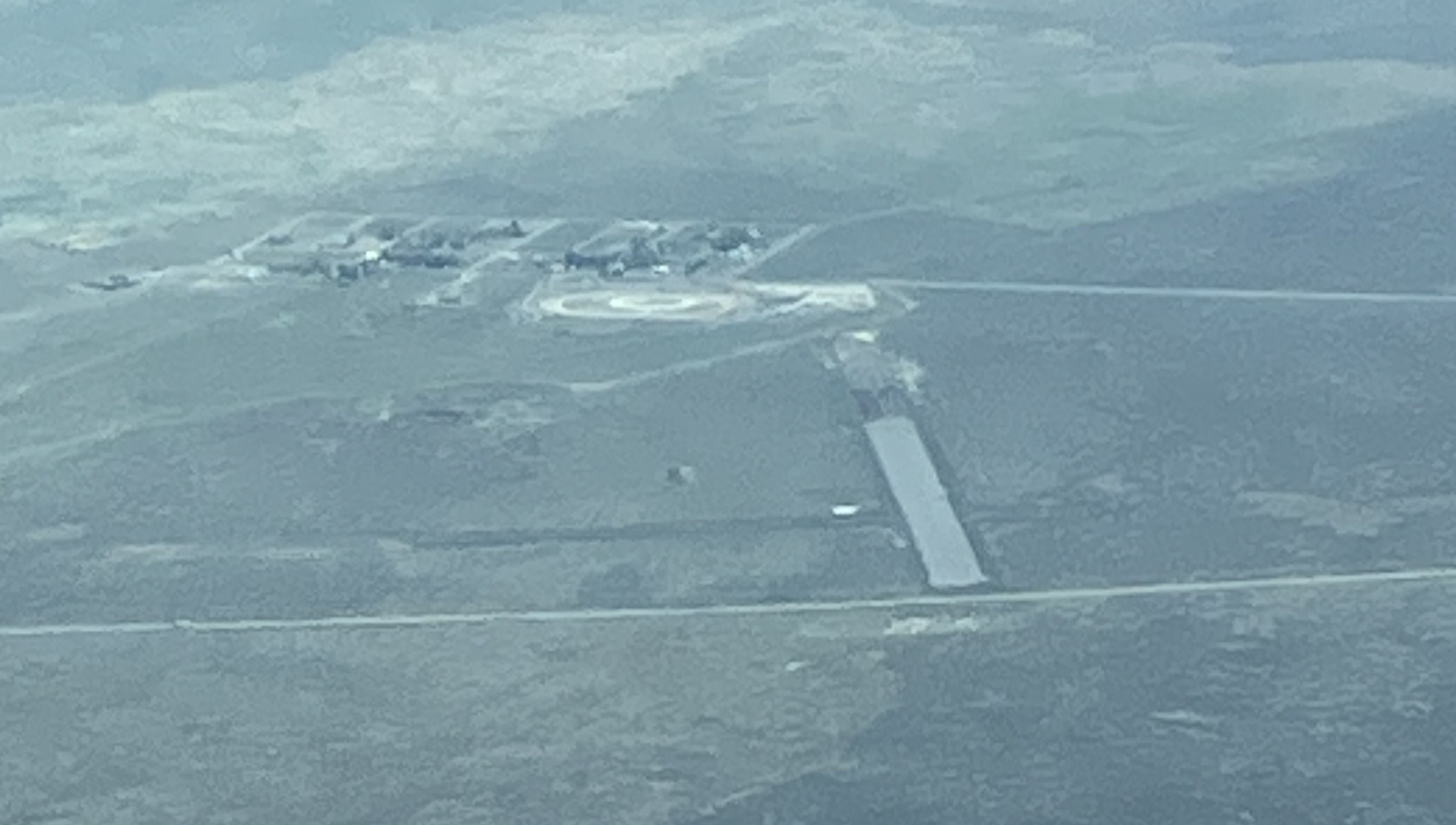
I do enjoy the art of “traveling via autopilot.” It’s only very recently that I’ve had access to planes with something one could call a “competent autopilot.” They’ve historically been “not present,” “marked INOP,” or “not actually working in some fun to discover way or another.” The T-Craft autopilots work, and work well. They’re integrated with the G5 displays, the GPS nav, and they’re very much a case of “Set them up properly, understand how to get them into the mode you want, and they do what you asked.” In terms of traveling distances with an airplane, this is wonderful. I was getting pounded around by some thermals and turbulence, and I didn’t have to do anything - the autopilot kept me on course, at altitude, and… I can just sit back and monitor the systems. When it’s smooth or mostly smooth, there’s literally nothing to do but sit back and watch the miles go by!
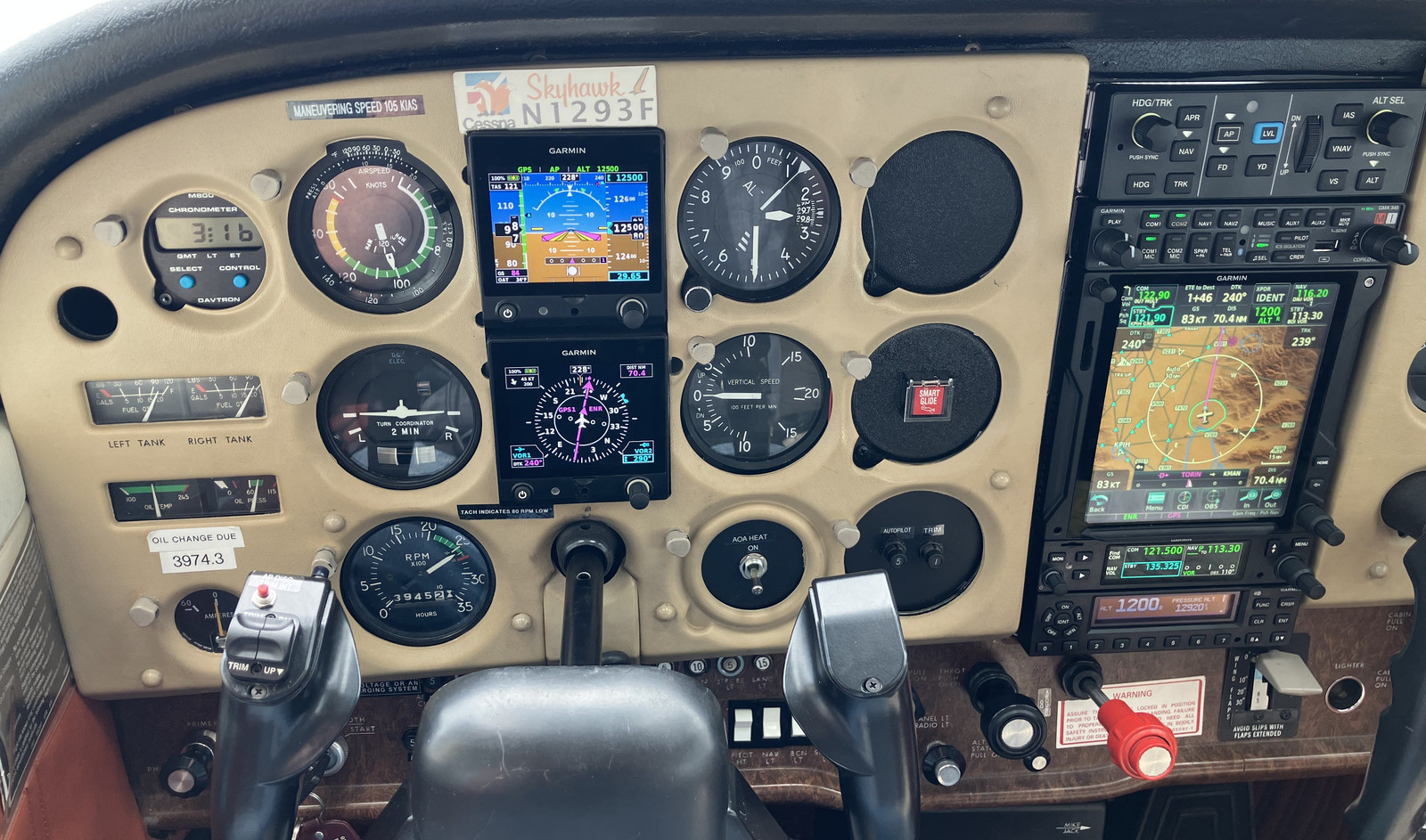
Or… not go by, mostly. I was seeing 150+kt ground speed most of the way out. I was seeing half of that going back for long periods of time. My initial plan was 10,500, but after climbing there, the turbulence remained very unpleasant, so I decided to try for 12,500. It took some time to get there, and the ride was smoother, but the winds were somewhat worse. Pick your poison. Given that the winds at 10,500 weren’t substantially less, I decided that a longer, marginally smoother ride might be nice, so I hung out up there and just… twiddled my thumbs, mostly. I had no shortage of time.
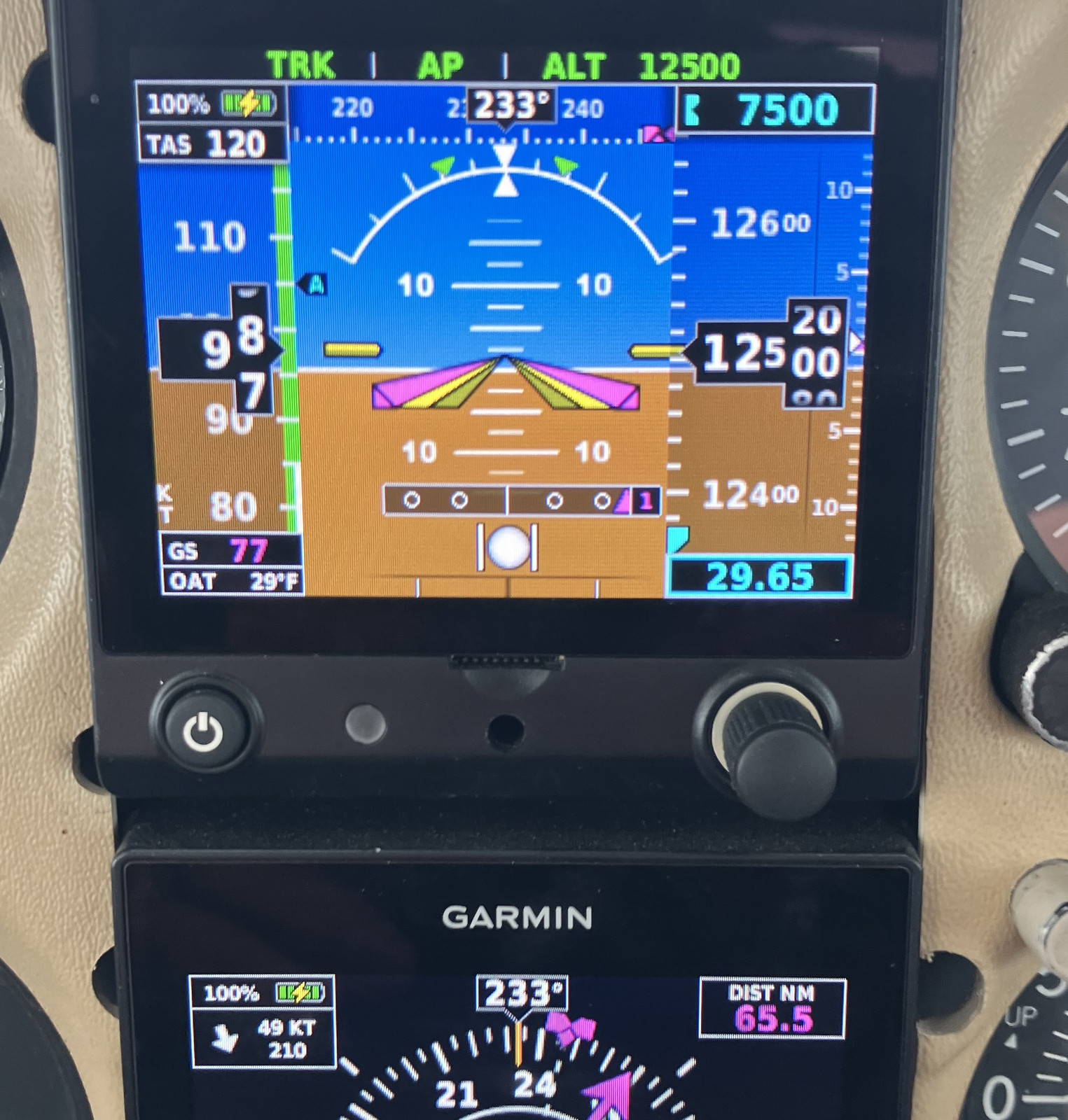
I even had time to get my iPad paired with the comm panel and got some music going! There’s no way I would have bothered sorting that out, in flight, without the autopilot. It’s not great, but it’s certainly better than just the engine drone. I spent a bit playing with the nav system too, trying out a few things to route me the way I wanted to go, not the direct route, and mostly worked it out. The autopilot is nice, but like any other system, it will happily do what you told it, not what you meant it to do.

Around the time you see clouds below you, it’s a good bet that things will be getting more interesting soon, and they certainly did. I had anticipated getting in before the cold front came through. Given the winds, that didn’t happen (and the front arrived somewhat sooner than I’d expected). I’ll just say, “Try to avoid this sort of thing.”

The last hour or so was certainly some of the most memorable flying I’ve done, and not in a good way - I’m glad I didn’t have any passengers, because there’s a very good chance they would have been using the barf bags. It wasn’t ever unsafe, but it was exceedingly uncomfortable flying, turbulence-wise. The skies went rapidly from “a thin cloud layer at 14k ft” to reporting “overcast at 7000, scattered at 5000,” and that was about right. I had to duck down fairly quickly to get below the cloud layer rolling in, which wasn’t too bad, though it was a good bit rougher down below. Unfortunately, the cold front was, well, cold. I’d been cruising around the freezing point up at 12,500, and after ducking down, the freezing point was around 7000 - which was fine, until I started seeing hints of rain. Freezing point, rain, airplane… nope. This was the first time I’ve ever used the pitot heat “in anger” (where I thought it might be actually needed), and I rapidly descended to warmer air, where the rain wouldn’t be a problem (not that it continued for more than brief periods). Unfortunately, the air down at 4000 feet or so was just violent. You can see the trail of dirt being blown off a field here - that’s not smoke, that’s dirt, and I assure you, the air up a bit higher was no nicer. It was nice to have the autopilot - though I hand flew things for a while as well, because at a certain point, the autopilot fighting everything just makes things worse. I was very much just keeping the airplane pointed in the general direction I wanted to go, and I decided that slowing down a bit would be a good idea, too - so I spent a while flying at Va (or the +/- 10 knots around it, in reality). This is a speed calculated such that the wing will stall before it overstresses the airframe, so it’s a good idea when getting pounded around. I don’t think I was ever anywhere near the airframe limits, but I certainly had some “Woaaaah…” low-G moments, and the reverse.
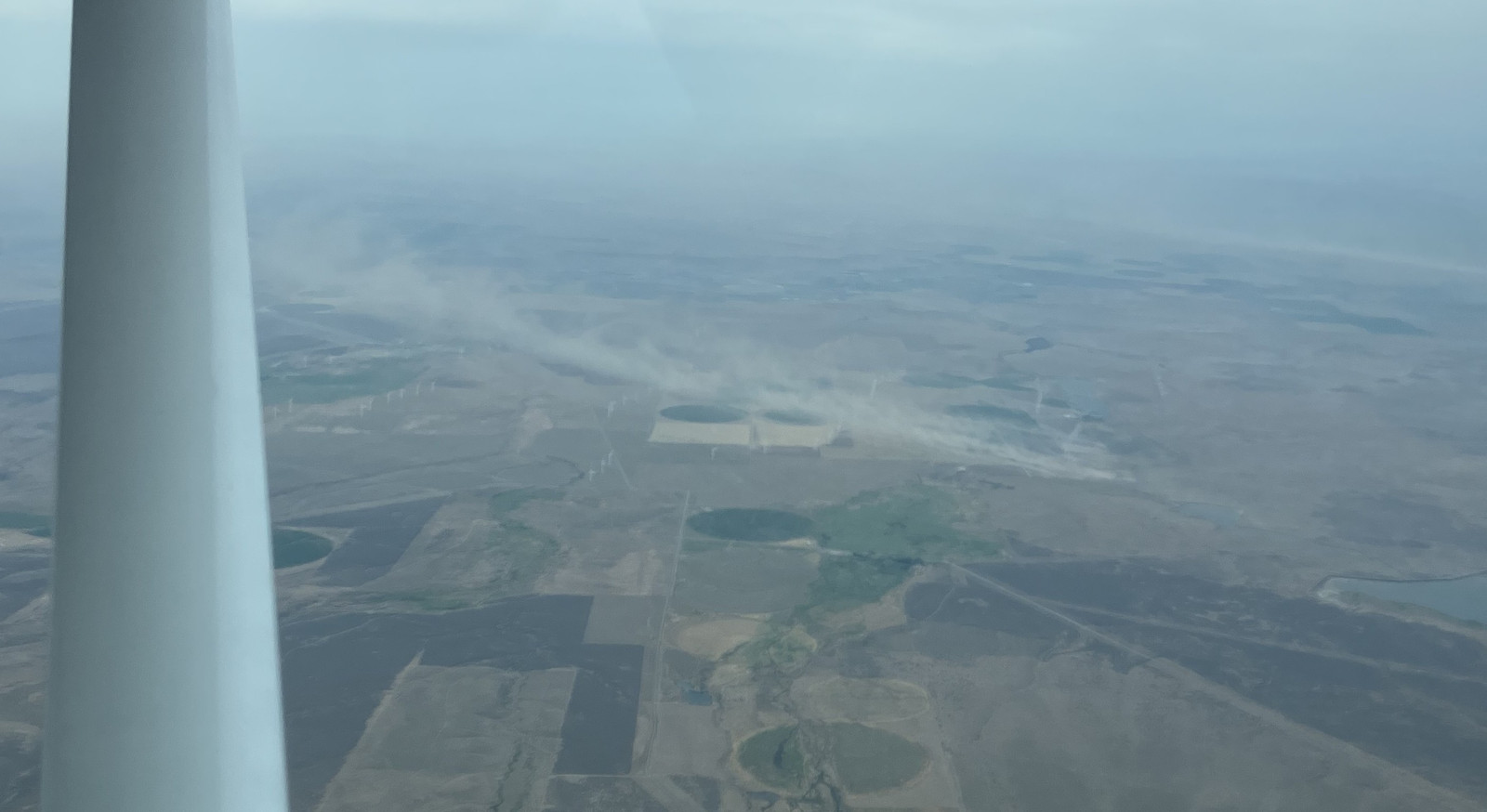
And, another 10 miles later, things smoothed out, and I had no trouble at all landing into a steady 8kt quartering crosswind. If you don’t like the weather, wait!
Thoughts on Automation
Having spent a day or so playing with “more automation than I’m used to,” I continue to have some very real concerns about the amount of automation we’re putting in our vehicles and our society. Automation is helpful, but only up to a point - and then it becomes quite hazardous, until it’s legitimately good enough to do everything. We see this problem in aviation, though I expect to see it more in driving in the years to come as well. The problem comes when someone (or a few someones, in a flight crew) are so dependent on the automation that they don’t remember how to function without it, or have no confidence in their ability to do so. That various European airlines (practically speaking) only train their pilots on automation is certainly not helping things.
As I see it, you really shouldn’t use automation until you understand how to do the task regularly without it - and you then need to practice that task, without it, enough that you can keep the skills fresh. If an airplane starts doing really weird things while on autopilot, the right thing to do is to disconnect the autopilot and fly the airplane. This requires pilots with recent enough hand flying skills to actually hand fly the airplane, though, and these skills appear to be lacking in a range of accident reports over the years. We’ll see what the root cause of the recent 787 crash is, but it wouldn’t surprise me if it turns out to be some weird corner case of automation doing weird things, and the pilots handling it poorly. Apparently there are some corner cases in which a mis-set value somewhere in the cockpit can cause a dual engine rollback that would feel a lot like an engine failure - though on a Boeing, this will cause the thrust levers to retreat to idle as well. In small airplanes, practice is to keep one hand on the throttle when it’s not doing something else at low altitude, so you can catch something like “the friction knob being wrong causing the throttle to vibrate towards idle.”
The other problem with automation is that the issues caused by it don’t become apparent until the next wave of users learn with it. Early adopters of an automation technology (autopilots, self driving cars, whatever…) tend to be people who have a long experience doing the tasks without it, so have a better feel for when it’s likely to be doing something stupid. Pilots who flew with early autopilots didn’t trust them, because they tended to act up regularly. But also, the pilots had flown without them, so if it went haywire, well, fine, smack the disconnect button and carry on. The same sort of thing is true with the early Tesla autopilots - the cars were largely owned by middle aged wealthy men who had many decades of driving experience without the automation. They were able to recognize, consciously or otherwise, if something was getting complex, and handle the situation reasonably. Someone growing up with autopilot, lane holding, whatever, isn’t going to develop those same skills, so won’t have the fallback skills to rely on.
Of course, now, with AI, we have all the tech companies trying to automate our reading, writing, and thinking for us. The early wave of people using the systems are people who knew how to do all these things without the AI tools - but look at what we’re already seeing in terms of “academic abuse” of the tools. I’ve got friends who teach in college, who have students who clearly haven’t done an ounce of work in the class, but just rely on AI to give them plausible sounding answers. This isn’t learning, and doesn’t build the foundations of knowledge you can later build from - so you won’t even know when the AI answers are driving you into a cliff, until you hit it.
I am not optimistic about AI in its various forms. I expect it to be the final death blow to that which the tech companies have been assaulting as much as they can for a decade now - the ability to focus. To think. To learn. To reason. It’s bad enough to provide the constant distractions that prevent people from being able to focus or learn, but now they’re pushing, as hard as possible, “Hey, those things you don’t know how to do? No problem, our tools will do them for you!” This is as human-toxic a mentality as I’ve ever seen on display, but… well, The Machine Stops from 1909 is a pretty good look at what happens when the automation fails and nobody remembers how to fix it anymore.
Let’s not automate away our ability to think.
And That’s All, Folks!
With this post, I’ve pushed my blog over a million words. By my math, which I’m sure is off by some amount, I’m at 1,002,956 words, and 2778 images, give or take, in the past 10 years of publishing. I’ve done that in long posts, I’ve done that in short posts, I’ve done that publishing weekly, I’ve done that publishing far less than weekly. But, at this point in my life, for a variety of reasons, I need to be done with the blog for a while - and with the internet, in general. I’m not at all okay with the way it’s going, and I need to sort a range of things out myself, so I’m going to consider this post my capstone, and call it quits. I have, for years, tried to restrain my posts to more reasonable lengths. Consider this post “Going out in style!”
I expect the blog will remain online for some while, though it may suffer unexpected outages. I’ve put the attached discussion forum into a read only maintenance mode, and I’ve somewhat dramatically reduced the resources I’m throwing at my online projects and hobbies. I’ll see how well things hold up, and things will likely get poked if needed, but I think everything is settled in so that I don’t have to worry about it for a while.
The promises of the internet I grew up with have gone whistling past, in the mad rush to addict users to everything, to fight other tech companies for the most addictive apps, to collect the most data, and now, to feed any and all human generated content to the gaping maw of the AI engines for “training.” I’ve, out of curiosity, run an “AI trap nonsense generator,” with a robots.txt file that simply says, “All automated crawlers, stay out.” So, 1.5 million page scrapes later, I think the point has been made. I know I’m feeding that, and I’m tired of it. With the exception of specifically marked AI text in a post of mine exploring early ChatGPT, everything I’ve written has been written by me, a human, with no AI assistance. So, I shall go pursue those routes in a much more aggressively offline way.
I may be back. I may not. I really, really don’t know right now, but I’ll certainly update the blog if I decide to write on the internet again.
So long, and thanks for all the fish!
Comments
Comments are handled on my Discourse forum - you'll need to create an account there to post comments.If you've found this post useful, insightful, or informative, why not support me on Ko-fi? And if you'd like to be notified of new posts (I post every two weeks), you can follow my blog via email! Of course, if you like RSS, I support that too.
